« August 2006 | Main | October 2006 »
September 30, 2006
submidialogy#2

4 days of studies and debates about theories and practices of brazilian digital media
"what we really want, actually, is that the ideas become dangerous again."
The first Submidialogy conference, that took place in Campinas, Sao Paulo, in October 2005, was derived of cooperation between India, Netherlands and diverse Brazilian groups. It was a joining of independent projects, the third sector, governmental, artistic and experimental to an international network of collaborators, searching above all to bring these different experiences to the acknowledgment. This year, it becomes an open festival, with lectures, production laboratories, fm radio broadcast, television, the Internet and the delicious chat with cachaça among @ll submiditics.
Submidialogy will aggregate talks, production and collaborative learning, as well as music, free radio, vj and independent media. These are some of the typical “tastes” that could be appreciated - without moderation - during the second edition of the conference.
Another characteristic of this festival is to investigate the social, cultural and political possibilities of the digital media, besides fomenting the dialogue (in)existent between theory - the scope of ideas, and the practices - the scope of actions.
As much subject as much format are still under construction, but are suspended in the convergence among culture, communication, resistance, re-signification, media, technology, art and tactics. In the construction page and by the dicussion list, you can take part of it. We invite you to help to organize this subversion and thus to share our ideas in different contexts and times, aiming future perspective, exchange of experiences, concepts, critical production and, mainly, fun.
If you wish to take part of this mess, sign up to the discussion list! Don’t get shy in forwarding this invitation to other people that would be possible interested.
When: October 12, 13, 14 and 15th 2006.
Where:Mercado da Ribeira - Centro Luiz Freire - Casa do Turista / Olinda -Pernambuco
For more info visit Submidialogia
Posted by luis at 02:27 PM | Comments (0)
September 29, 2006
Gustavo Romano
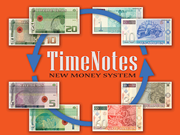
Time Notes
Time Notes :: EXCHANGE OFFICE :: Orchard Road, Singapore :: The action starts with a stand in Orchard Road (in front of the major Shopping Mall of the city) where two persons ask the passing people what do they think about the new Time Notes money system, and invite them to exchange a bill with something that they think it is worth.
"Gustavo Romano employs actions, videos and Internet projects in order to subvert and dismantle a naturalized perception of everyday occurrences. As opposed to the modern pretension that the time and space we inhabit is unique and homogeneous, Romano forays into multiple, fragmented instances of time-space. His works record displacements achieved by way of optical devices (telescopes, satellite views, microscopes, x-rays or night vision), distortions of duration (by manipulating video or electronic recordings) and diverse forms of dislocating genres. In his works, the natural habit of seeing things in a single way in broken. Such is the case in pieces such as Lighting Piece , an ephemeral match that burns endlessly with an eternal flame, or in Pequeños mundos privados (Small Private Worlds), a specular proposal that—just as in La Reproduction Interdit by Magritte—,deconstructs space—Chinese boxes—as well as time—and in this circular proposition, where is the beginning and where is the end? Where is the limit between the reflection and what is being reflected?
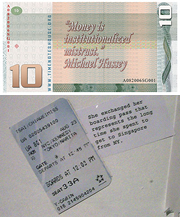
As George Simmel pointed out in the early 20th Century, all economic exchange should be understood as a form of social interaction. Others would coincide as well, from Bronislaw Malinowski (with his theory of exchange), to Marcel Mauss (in his Essai sur le don), and Claude Lévi Strauss, for whom the actions of give and take and their reciprocal nature are present in the collective unconscious of all human society. Time bills emerges from a terrain that is nourished as much by this Sociology of Exchange or Economic Anthropology as it is by a tradition of artists' interventions involving bills (from Pop to Fluxus, in particular). The work—which functions within a public space that here, is simultaneously an art space and a political space—, consists of soliciting a “commercial” exchange from passersby: What would they give in return for a bill by an artist? What are these bills worth? Their exchange value? Their use value? Their accumulation value? Are they art transformed into merchandise? Money, the bastion of modern society, symbolizes a spirit of rationality, calculability and measurability. Nevertheless, history has registered very different mechanisms for exchange. The potlatch , in North America, used to take place in the form of a ceremonial celebration, New Guinea's Kula Ring used to include magic rituals, and Hell Bank Notes are considered a monetary currency for the next life, offered up as a way of venerating ancestors, etc., etc. Furthermore, in Time Notes , the nomenclature of the bills does not refer to an abstract value but to units of time; is time money? Is it a Faustian pact to buy time—eternal life?—in exchange for something—the soul? In the face of money's ostensible impersonal value and abstract homogenization, Romano reveals a manner in which idiosyncrasies, desire and belief can persevere behind every note." -- BELEN GACHE
Posted by jo at 05:08 PM | Comments (0)
[iDC] Questioning Two Experiences with Situated Technology
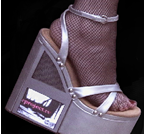
Emancipatory Technologies for the 'Marginalized'
On Sep 28, 2006, at 11:34 PM, Matthew Waxman wrote:
In what ways might situated technologies be used as a tool for activating not only the context of user-oriented perspectives but the contexts of non-user-oriented (such as service and 'marginalized') perspectives? And how might situated technologies and architectural form (both together) be able to mix or remix these different perspectives on context?
Great question, and something I've been thinking of for a while as well. I have no answers or relevant projects, but a few more ideas and questions.
(And perhaps others have touched on these points in earlier posts; like Anne I think I've likely missed relevant discussions.)
I've been wondering about the potential (and whether it even exists or not) for some of these situated and/or networked technologies being used for emancipatory situations for those 'marginalized'. Perhaps an example of what I'm thinking about. Take someone who works in a migratory situation. They may come to the US for a few months to work and then return to their families further south. [1] What options do they have for contact with their families and distant communities during these months away? Do many have cell phones? I don't know; but echoing a discussion from earlier in the summer [2], is it possible to use massively distributed transmission of messages over ad-hoc networks to get information to those who are far away geographically? Bypassing the existing infrastructure to create a transitory one that better reflects the person's needs and desires.
On another front, and related to some experiences I've had in co-curating technological fashion shows [3], what ways can we use wearable computing to focus on the needs and desires of the marginalized? Can we use miniaturization technologies to create a system of surveillance that protects the worker? That in a subversive way records illegal, dangerous, or derogatory conditions for presentation to the authorities? Perhaps we can think beyond creating garments that simply "light up in response to x from the wearer". With that said, projects such as the No-Contact Jacket by Adam Whiton and Yolita Nugent [4], the Porcupine Dress by Meejin Yoon [5], and the Aphrodite Project developed at eyebeam [6] are great examples of the potential use of this technology outside of an artistic or responsive context.
Yet what worries me even as I write this is that my suggestions don't begin to question the _situation_ itself. What is the use of ad-hoc networks to send messages if the person is still subservient to an oppressive system? Who cares if we can create the ability to record illegal actions of a land-owner if the reporting of said actions causes the worker to be harmed even further? I don't have an answer to that, and perhaps technology does not either, and perhaps even deeper, we shouldn't be asking or demanding of our technology to do all of these things. We all know situations will not drastically improve overnight, and maybe the development of stopgap measures that attempt to improve an aspect of undesirable circumstances is one thing to do while _in parallel_ we (and others) work to question, deconstruct, and reconstruct.
Finally, and to contradict my previous paragraph, perhaps there are ways to be _proactive_ instead of reactive with our development. It's a question I ask myself often, and if I had something to offer I would, but I'd be curious about others' thoughts.
nick knouf
[1] But as a recent NY Times article points out, because of immigration concerns, there is an increasing decrease in the number of workers coming to the US. (Unfortunately the article is now 'locked', but this is the URL: http://select.nytimes.com/gst/abstract.html?res=F30D17FF35550C718EDDA00894DE404482)
[2] http://mailman.thing.net/pipermail/idc/2006-July/000599.html
[3] http://seamless.sigtronica.org
[4] http://old.siggraph.org/s2006/unravel/Projects/6/
[5] http://www.bookofjoe.com/2005/05/selfdefense_dre.html
iDC -- mailing list of the Institute for Distributed Creativity:: iDC[at]bbs.thing.net :: http://mailman.thing.net/cgi-bin/mailman/listinfo/idc
List Archive: http://mailman.thing.net/pipermail/idc/
Posted by jo at 04:48 PM | Comments (0)
Kostas Daflos

Bodysmaze/Cibo _05
In Kostas Daflos' last visual art work Bodysmaze/ Cibo _05 which consists a performance machine for the production of virtual spaces, the specific site of the interactive installation reinforces the tangible urban public space. The human action is being captured by a web camera, which activates a programmed robot -unit and produces a thermoelectric, -liquid nebula environment, as an interface, which is the medium for the projection and the intermediary in the communication of our visual experience with the technological platform of the personal computer. In his former visual artworks as in Cipo _03 (and here), and its genuine descendant muscle- skeleton Cipo _04, he focused his research on visual plasticity, video-installations and interactive real environments, co-existing automatic intelligence' robotic objects with human beings and communicating via web cameras . His artworks expand the real space in the World Wide Web.
Architect - National Technical University of Athens (N.T.U.A.), School of Architecture, Sculptor -National Athens School of Fine Arts (A.S.F.A). Postgraduate Degree in «Digital Forms of Art», National Athens School of Fine Arts (A.S.F.A.), in collaboration with the Department of Computer & Information Science, Polytechnic School of Patras University.
He is a PHD Candidate at the N.T.U.A., School of Architecture. He focused his research on visual plasticity, video-installations and interactive real environments, where automatic intelligence’ robotic objects co-exist with human beings and communicate via web cameras. His artworks expand the real space in the World Wide Web.
Since 1997 he has participated: in several research programs, in conferences, in national and international architectural competitions with awards, national and international exhibitions. The areas of expertise include human computer interaction, computer mediated environments, new media, and interactive multimedia installations. His interest is to create a new class of “connected objects”. He is an author of a number of essays on contemporary architecture, arts and communications. He curates and participates in web sites with a personal theoretical and visual art work www.transitionalathens.com, www.apothecae.com. He teaches Visual Arts and Digital
Representations at the Polytechnic School of Patras University, Department of Architecture.
Posted by jo at 01:06 PM | Comments (0)
boycott "festival Émergences" - la Villette /Paris

Call
Date: Wed, 27 Sep 2006 14:13:54 +0200 (CEST)
From: fougeras nathalie
Subject: [spectre] Appel : boycotte festival "Emergences" la Villette-Paris/Call: boycotts "festival Emergences"
English translation:
Several women wanted to intervene on a mailing list on numerical arts concerning this abuse representation where only men, (with share 2 or 3 collectives but which one does not know if there are women within them) expose in this event that is the Festival "Emergences" which takes place from the 28 to September 30 in the Villette.
This configuration was noticed and a discussion initiated by a woman on this list to question this obvious catch of party of nonrepresentation of the woman. Few men reacted politically and socially by giving an opinion against this failure of the art and in particular of the numerical art of classification per kind. As much to say that silence - and very ambiguous reaction of the other men - completely guarantee this case of figure and classification of art by kind!
Meanwhile, we were sent malls in deprived and parallel to continue the discussion. We received by private malls of the returns of people, for example, in the field of the music who speak about a "configuration" rather close to that to numerical art.
Doesn't art thus put ahead an intelligent thought...? Inevitably do not ask to reason on the social one?! While at the same time it is a question of thinking of it not only "the technological" but "sensitive" medium perhaps too!!
What thus remains "to be applied" by this equality "required" (for example by the completely applicable quotas and with completely serious files artistic) in order to re-examine "quality" and the "nature" of the works presented and exposed on the public place for more otherness "between us".
Because for the moment we rather see a manner of avoiding "carefully" the mixture, the "not-co-education" which becomes an increasing fear on the public place and in this field (it can be connected with the fear of being mixed to its neighbor, with the immigrant, etc.)
We thus boycott this festival "Emergences" since the women are not represented there and that the indifference reigns in full day.
Posted by jo at 12:51 PM | Comments (0)
The Copy and Paste Show
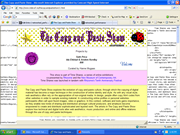
A Virtual Gallery in Brooklyn
Projects by Seth Price, Ida Ekblad & Anders Nordby and 808 :: Curated by Hanne Mugaas :: The Copy and Paste Show explores the evolution of copy-and-paste culture, through which the copying of digital material has become a major technique in the construction of online identity and style. As with any visual style, web aesthetics often rely on the appropriation of non-original media. In design, people often copy html codes from other websites in order to sample existing material. In constructing online profiles or personal websites, participants often call upon found images, video or graphics. In this context, software and tools gains importance, as they enable new kinds of sharing and distribution amongst cultural producers, and amateurs become empowered to create and distribute sophisticated and layered work. The artists in The Copy and Paste Show explore how technical and digital tools alter web aesthetics, music production, and online and offline relations through the use of copy and paste techniques.
This show is part of Time Shares, a series of online exhibitions co-presented by Rhizome and the New Museum of Contemporary Art. Time Shares was launched in tandem with Rhizome's Tenth Anniversary Festival.
Posted by jo at 12:43 PM | Comments (0)
Scape 2006 Biennial of Art in Public Space

/don't misbehave!/
Scape 2006 Biennial of Art in Public Space /don't misbehave!/ in New Zealand presents 4 new media based artworks:
The group SIMPEL contributes Paper Cup Telephone Network (PCTN). Do you remember stringing two cups together and talking with your friend? Well, the PCTN is the same, but imagine people around the world whose cups are all tied together, so that everyone can speak to anyone, any time, for free. The PCTN uses a combination of string and internet technologies to create a free and open communication system similar to Antonio Meucci's (the inventor of the telephone) vision for the telephone, a social network where everyone speaks to everyone. This project is by the new media art group SIMPEL. SIMPEL is Matthew Biederman (CA), Aleksandar Erkalovic (HR), Lotte Meijer (NL), and Adam Hyde (NZ). Forecourt of Christchurch Art Gallery and south quad of Arts Centre.
Auckland based media artist Sean Kerr installs Neighbourhood Watch. Neighbourhood Watch consists of a number of peering eyes which create an inquisitive neighbourhood in the central urban area of Christchurch, unsettling and interrupting the locals in the surrounding environment. These animated eyes are goggling out of windows, observing the ever-changing scenery of Christchurch ’s streets, and participating in public commentary. Worcester Boulevard.
Swiss artist Johannes Gees will make you see The Christchurch Menetekel. The work is a collaborative, interactive laser text installation inspired by the story of King Belshazzar’s feast, from the biblical Book of Daniel. Taking its cue from the flaming Hand of God and its mysterious warning in the story, Menetekel writes messages on walls in laser light and invites the public to text their own contributions and responses back. The artwork addresses the public’s relationship with religion and its meaning in contemporary art and society. 30 Sept 7pm–12am, 1 - 4 Oct 8 pm - 12 am, Cathedral Square.
Auckland based collective et al. presents /untitled/, 2006. An installation in which multi-media components including synthesised voice and video projection and an internet feed from Google Earth are situated in a fenced and empty enclosure. Apparently integral to the GE imagery are 5 animated units which move over an area of the Middle East . The Google Earth link was first used by et al. as a component in the /fundamental practice/ Institute of Modern Art , Brisbane 2006. Christchurch Art Gallery.
A discussion panel entitled “Beyond spectacle: media art in public space” will look at the strategies and the effect of media art practice in public space. On the panel with Susanne Jaschko are Johannes Gees, Sean Kerr and Matthew Biederman. Sunday Oct 1, 4 pm, Christchurch Art Gallery.
* Scape 2006 Biennial of Art in Public Space /don't misbehave!/ *
* Sept 30 - Nov 12, 2006 *
* Christchurch, New Zealand*
susanne jaschko
curator Scape 2006 Biennal
Posted by jo at 12:43 PM | Comments (0)
CREATIVE THINKING FOR INTERACTIVE TV

FIRST CALL
11th European Interaction Design Workshop CREATIVE THINKING FOR INTERACTIVE TV by Dr. Anxo Cereijo Roibás, University of Brighton :: October 5-8, 2006, Istanbul Kadir Has University.
This winter, one of the most prestigious interaction design workshops, IDWS, is looking for 14 talented design students (7 Turkish nationals and 7 non-Turkish nationals). This time, IDWS will host Spanish Researcher Anxo Cereijo Roibás who specializes in Interactive TV application. The workshop will explore suitable methodologies and techniques to design new scenarios defined by intersections between handhelds and other devices (e.g. iTV). It will also analyze crucial issues in the design of applications and interactive content in these contexts.
Application deadline: November 30, 2006 (Application fee is not required) For more details concerning scope, background of participants, accommodation, workshop fees, etc., please see: http://web.idws.info
IDWS winter workshops are part of the ERASMUS IP project 2006-2008 and has sponsored by Istanbul Cervantes Institute and British HCI Group.
contact: application[at]idws.info
Oguzhan Ozcan
Curator
Posted by jo at 12:36 PM | Comments (0)
The Brooklyn Apartment
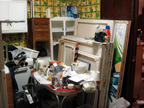
A Virtual Gallery in Brooklyn
We have a different approach to selling art. We don't make it easy and we don't want to make it straightforward. Instead, we want shopping for our art to be a unique experience in during which the viewer can experience the allure and reality (sometimes grimy reality) of North Brooklyn living.
The Brooklyn Apartment is a virtual tour of my apartment and my friend's apartment. We have art hanging up on the walls of our bedrooms, bathrooms, and kitchens. Sometimes the art is hidden and it requires curiosity to be found. We also include of our environment to make the viewer feel immersed in our environment.
We hope you stop by the Poland-Korea Relations site. The link above will take you to the art page which opens the gallery window. Enjoy. Hope you like what you see.
Posted by jo at 12:35 PM | Comments (0)
Bit by Bit, Cell by Cell
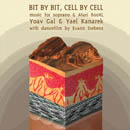
Release Party
Join us to celebrate the release of Bit by Bit, Cell by Cell , the latest World of Awe project. The music CD is a collaboration between composer Yoav Gal, dancefilmmaker Evann Siebens and Yael Kanarek. In World of Awe a traveler searches for a lost treasure in a parallel world called Sunset/Sunrise. Bit by Bit, Cell by Cell sets texts from the treasure hunt to soprano and Atari, with a dancefilm shot on 6th street in Manhattan.
October 5, Eyebeam, NYC :: 7:00 Drinks :: 7:30 Introduction by Innova Director, Philip Blackburn :: 7:35 Performance by composer Yoav Gal, sopranos Heather Green and Sarah Rivkin, and dancer Evann Siebens. Drinks courtesy of bitforms gallery. The CD is available for sale at the Eyebeam bookstore and Innova website. CD design by Mushon Zer-Aviv
"[...] this is a "postmodern opera", and features a performance of the opening track Portal as a Quicktime movie in addition to the eleven songs. The musical backing and interludes are all performed on an Atari 800XL. Soprano Sarah Rivkin's voice is layered into choirs of operatic/angelic voices. The Atari 800XL sections have a thick antiquated/timeless quality, sometimes sounding like a seriously deranged harpsichord. Quite lovely, listenable, and beautifully packaged as well." — George Parsons, Dream Magazine #7
worldofawe.net
eyebeam.org
bitforms.com
innova.mu
yoavgal.com
Posted by jo at 12:31 PM | Comments (0)
PORTA2030
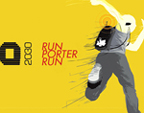
BRING BACK THE NETWORK, BRING THE FOOD
Please join us Wednesday 4th October 2006, 7pm @ Regent Studios, Unit 73A, 8 Andrews Road, London E8 4QN for an evening with PORTA2030 and Broadway Market PORTA-PORTERS public review with John Jordan, Ann Light, Gini Simpson moderated by Marina Vishmidt. :: TALK network reality :: PLAY network vision :: for Broadway Market and beyond. There is food to consume and network to share. Come with your doubts, thoughts and affirmation.
In April 2006 media arts group TAKE2030 initiated a week-long networked performative exercise PORTA2030 with 10 porta-porters on Broadway Market. Staged within the connected wifi zone on Broadway Market, the porta-porters, each assigned with a wifi networking porta-pack, take part in a collective communicative scenario.
For this public review session, TAKE2030 brings together the PORTA-PORTERS to reflect back on the April event with the launch of its DVD. We also invite network media researchers and activists to join us for a cross-over discussion on community and performative media practice. We hope to address the realization of PORTA2030's responsive network vision by means of network public art exercise. Furthermore, we question how can the PORTA-net be self-sustainable public network for Broadway Market and beyond toward year 2030.
Posted by jo at 12:21 PM | Comments (0)
Leanardo Electronic Almanac
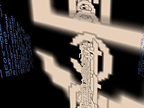
Special Issue on Digital Poetry
LEA just released an extensive new issue on Digital Poetry. While I’ve just taken a quick look, it appears to be a terrific collection of essays on contemporary digital poetry, in addition to featuring several compelling works in the gallery. The issue edited by Tim Peterson includes essays by Loss Pequeo Glazier, John Cayley with Dimitri Lemmerman, Lori Emerson, Phillippe Bootz, Manuel Portela, Stephanie Strickland, Mez, Maria Engberg, and Matthias Hilner, in addition to works in the gallery by Jason Nelson, Aya Karpinska and Daniel Howe, mEIKAL aND and CamillE BacoS, and Nadine Hilbert and Gast Bouschet. The correlation between the essayists, authors and works reviewed in this issue of LEA and the contributors to the forthcoming Electronic Literature Collection, Volume One suggests to me that the two free publications will make a great pair for teaching. All of the essays in this edition of LEA are available both in HTML and downloadable PDFs. [blogged by Scott on Grand Text Auto]
Posted by jo at 11:48 AM | Comments (0)
The Spychip Under Your Skin
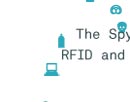
RFID and the Tagged exhibition by Space Media Arts
The Spychip Under Your Skin by Armin Medosch: Commissioned by [ space.media.arts ] to accompany the Tagged exhibition, Armin Medosch writes about RFID, first introducing the technology and its context. Briefly introducing Bruce Sterling's ideas about 'shaping things' Medosch adds to this some of my his reflections about the contentious notion of techno-social 'progress'. Based on this contextual analysis the text formulates some of the challenges and possibilities for artists who work with technology in general and the routes chosen by the selected artists in the Tagged exhibition. [PDF]
Introduction: What Is RFID? Depending on whom you speak to, it can be a rather mundane thing. RFID tags are used in warehouse logistics management, where they are integral to a new system for identifying objects and replace the scannable bar code which has performed this task for the past several decades. RFID is also the key technology which enables an 'internet of things' within a framework of 'ubiquitous computing' (Ubicomp). Minimally, RFID tags link the physical world with the informational world. The process consists of attaching machine-readable information to objects. Maximally, this, some would say, is a new step in the co-evolution of the technological with the social. Its implications seem to mandate a serious engagement with the motives behind these latest developments.
The potential of this move to a next layer of the informationalisation of the world does raise concerns about privacy or the notion of an all-encompassing society of control. Concomitantly, it facilitates new paths of exploration for artists in a range of areas, from commercial interactive product design to art movements such as locative media and new types of performative and interactive-narrative work. According to science-fiction writer and media theorist Bruce Sterling, the spread of RFID technology gives rise to a new type of object, the SPIME. The word is a neologism invented by Bruce Sterling, describing objects which can be tracked in SPACE and TIME. Sterling predicts that a society relying on an infrastructure of SPIMES would have achieved a fundamental change in the relationship of the forces of production. I will expand on this subject later, but only so much here: additional awareness about an object's full life-cycle prompted by use of RFIDs would enable environmental and sustainability considerations to play a greater part in the resource allocation decisions of societies.
Space Media Arts have decided to devote their Tagged series of events to the complex of issues surrounding RFID. Following an open call and a jury-led selection process, Space Media Arts have selected four artists/projects and one sound performance to be presented at the Triangle exhibition space and in public spaces in the locality. In this text I will first introduce the technology and its context. I will also briefly introduce Bruce Sterling's ideas about 'shaping things'1 and add to this some of my own reflections about the contentious notion of techno-social 'progress'. Based on this contextual analysis I will formulate some of the challenges and possibilities for artists who work with technology in general and the routes chosen by the selected artists.
Gloves, Dr.Watson
Radio Frequency IDentification, RFID for short, relies on RFID tags to identify objects digitally and a support infrastructure necessary to read and process the information. An RFID tag consists of an antenna and a chip. Passive tags are made of a small coil and an even tinier chip both wrapped by some adhesive material like paper or film which gets attached to cartons or pallets. When a reader device is in close proximity2, the antenna is activated by the frequency it transmits and the chip sends a message. Usually this message would consist of the Electronic Product Code (EPC), "a unique numbering scheme for every object in the world".3 RFID tags of this type have been falling in prices and are said to now cost as little as 3 pence a piece when ordered in large volumes. More complex RFID tags are capable of storing more information and some have their own power supplies. Those semi-active and active RFID tags are used for access control schemes and car keys, but also the tagging of animals, machines and humans.4
Some histories of RFID technology trace it back to the invention of radar. 'Real' RFID, in the way we know it now, however, was first introduced on a relatively narrow scale with the tagging of cattle in the 1980s. It was only considered for more widespread use in the 1990s and its roll-out has begun in the last few years. As with most available technologies, the development of RFID is fuelled by both military and commercial interest in its applications. Despite the centrality of the United States Department of Defence (USDoD) to RFID R&D, the growth potential for commercial supply chain management may in the long term be more influential in global infrastructural change.
The main beneficiaries of RFID are going to be very big organisations which orchestrate the production and consumption of large quantities of goods, such as supermarkets - Wal-Mart has been another driving force behind the introduction of RFID besides the US Department of Defence. For the customer, the benefits are said to arrive in the form of the reduction of already cheap prices because the whole process can be managed more efficiently. This emphasis on economic expediency cloaks less publicity-friendly consequences for both labour and consumers, a traditional ruse of big corporations and governments seeking to evade the social cost of restructuring or the introduction of new technology. When people are in a generally disempowered state, they have no choice but to vote with their wallet. However, such 'trickle-down effects'5 have more often than not favoured the corporation at the expense of the worker and consumer.
Open Doors And Open Wallets With RFID
RFID has raised concerns about the protection of privacy from the very beginning. However, many of the discussions around privacy foreground a limited notion of the protection of privacy of individuals and tend to ignore the larger political economy within which it is embedded. In internet forums about RFID and privacy you can encounter stories such as the one that Wal-Mart might spy on you once you have accidentally swallowed the RFID on your breakfast cereal packaging. This type of criticism is just too easily dismissed. Wal-Mart have no intrinsic interest in their customers. Indeed, even CEOs of RFID supplier companies can shrug off similar suggestions with a laugh.6
If we proceed on the premise that sooner or later everything that exists will have a virtual badge attached to itself with information that can be machine-read, this raises much larger questions than the fear of private individuals being spied upon. It could be noted in passing that increasing automated information storage and retrieval can lead to increasing centralization of power, money and control in the hands of very few with an interest in upholding the political status quo - more on this below. Despite those larger issues, let's have a look at RFID's implications for personal information security.
Many RFID schemes have very leaky security. They transmit information unencrypted via radio frequencies.7 The information can not only be received by those devices which are meant to read them but also by 'rogue readers' operated by organised criminals or spooks. Public discussion about RFID mainly focuses on supply chain management. However, at the time of writing, the use of RFID is more common in keys, ID-cards and schemes such as the Oyster Card, where London commuters receive a smart card with RFID which gives them access to cheaper fares. Most Oyster Cards are registered with a central database run by Transport for London (TfL). This means that TfL has a record of journeys by individuals. On top of that the smart card chip inside the Oyster Card also records journeys. The cards themselves as well as the database infrastructure are potential points of abuse.
Privacy geeks are already putting aluminium foil around their London Oyster Card.8 A similar scheme, the Octopus Card, introduced in Hong Kong 10 years earlier has been extended towards a digital purse which could be used in grocery stores. It is no accident that such a scheme could be tested first in an 'efficient regime' as the whole world intends to become one.9 If newspaper reports are to be believed, the information trail left by Oyster Cards is already playing a role in divorce cases. Police are increasingly asking for Oyster Card records from TfL in criminal inquiries.10 In the UK, it seems, there is widespread agreement that the dangers of introducing a surveillance infrastructure such as CCTV are outweighed by the benefits of those systems.
The problem with relying on those systems is that they give a false sense of security. The number of web-pages about RFID hacks is myriad. There are open source tools working with conventional reader hardware such as RF Dump (http://www.rf-dump.org/) and RFIDIOt (http://rfidiot.org/). There are manuals about how to turn your mobile phone into a 'skimmer', a device to read magnetic stripe cards.11 There are academic papers about how to break very widely used RFID schemes (http://www.rfidanalysis.org/). The only reason why we don't hear more about RFID crime is that for criminals there is still much fertile ground in the exploitation of older and still more widespread technologies such as cheque accounts and credit cards.
Identity theft has already been described as the crime with the biggest growth potential. Supposedly 'secure' concepts for passports and ID cards include RFID capability which exposes unencrypted data contained on your passport or ID card, making these forms of identification readable from a distance. The new British biometric passport has already been hacked.12 The white hat hacker13 who exposed the flaw claims to have used equipment which cost no more than 200 dollars. A bit of Do-It-Yourself and you can copy the content of an Oyster Card or the biometric information on a new passport. While the authorities are busy telling us that these biometric technologies promote our safety, all the evidence is that it is the committed fraudster or terrorist who will travel with greater safety - while millions of ordinary people will be in line for more harassment, inconvenience and identity fraud.
Electronic Borders
Some people can enjoy their alienation more than others: there is a website for RFID freaks who get their tags implanted.14 Prof Kevin Warwick at Reading University had got his subliminal RFID tag already in 1998, an amazing scientific stunt I had the mixed pleasure of personally attending along with many other dumbstruck representatives of world media. It demonstrated the benefits of being greeted with 'good morning Prof Warwick' by a computer-generated voice on entering the building. This was not only another proof of the overheated attention economy in science but demonstrated the slim appeal of most Ubicomp propositions. I mean, who would really want to live in Mr. Gates' house? And of course there are other issues with RFID implants, besides their propensity to wander around under your skin. The infamous Mafia fraud attack15 on biometric identification implies the use of dismembered limbs and organs to hack secure systems, completely changing the meaning of the term 'brute force attack'16 in debates about security.
However, the real danger is the two-faced nature of the technology. RFID gives the holder of a key access to an area, but it also makes the presence of a person in that restricted area subject to monitoring. Thus, RFID can be used to control bodies in space. Companies and public institutions do it by issuing RFID keys. The technology is being applied already in prisoner probation schemes with a view to extending RFID tagging to asylum seekers. Whereas those RFID schemes are mandatory for the 'user', other schemes introduce the very same technologies with a promise of more convenience.17 As internet users know only too well, password management increasingly becomes a burden. Add to his bank cards, an NHS card, PIN numbers, etc., and the authentication quagmire expands. Now, the IT industry is about to gift us with a new product, called 'identity services'. For large corporations authentication and authorisation concerns increase exponentially regarding security issues both in real space access to buildings) and computer systems. It becomes praxis to outsource the management of identity and access codes within their institution to a security IT company.
For privileged individuals this means getting through the security gates of airports more quickly and moving through a 'seamless' environment of managed 'secure' identity. The same technology could also be used to monitor people who are lined up for deportation. Ironically, the frequent business flyer and the would-be 'immigrant' are both part of the 'avant-garde' of RFID deployment. Willingly or not, they are subjected to a new regime where the electronic world holds significant sway over the real world. As spaces are structured by informational layers, access codes increasingly regulate our ability to move or to obtain goods and services. The ordinary individual has a weakening position in this technological armament race. Those who feel this zost strongly are immigrants or generally people 'sans papiers', whose mobility and security is suspended by lack of official documentation. In other words, without some plastic with biometric information stored and checked via RFID, a person soon will not really exist. Rather than only being an encroachment on one's privacy, RFID can become an issue of simple biopolitics - meaning survival.
Avoiding Totalizing Vision18
However, when it comes to topics such as surveillance regimes a writer's imagination is often inclined to jump ahead of developments on the ground. Interestingly, proponents and opponents of this or that new technology will often make the same mistake of buying too much into the propaganda about the technology. How many times have we heard praises of the benefits inherent to a technology which is in fact still very experimental? Some of the scenarios to sell new technologies to the public are so overused that they expose themselves as past futures.19 In a similar way, the critique of the control society is based on assumptions about totalitarian tendencies immanent to a technology leaping far ahead of the actual state of deployment.20 In fact, those things rarely ever work as well as advertised.21 If the vision is too totalizing, critique fails to hit the spot where it could actually have any impact.
In order to prevent this type of shadow boxing I would like to expand the scope of this article. Let's briefly look at the history of technology and its social critique. How and why do new technologies come into existence? What are the reasons for their being and what are the unintended consequences? Can we find certain structures in the relationship between society and technology? When it comes to those 'structures', language is a minefield22 that needs clearing. But the best effort of purification will run into recursive loops. Therefore my methodological-ideological disclaimer: there is no objectivity, we always need to consider the multiplied contingencies of the subject of inquiry and of ourselves as people, as subjects of history. This radical relativity is not to be mixed up with dis-engaged Relativism. The forces that shape the evolution of society and technology are observable and concrete.
Technology and Social Relationships
Since Marx we know that new technologies are not neutral but expressions of social relationships. The factory owner leverages new machinery against the human workforce. Scientific management and Fordism have brought this to perfection, shaping a society which consists of workers, who perform very simple repetitive tasks dictated by a machine, the capitalist owner class and a new intermediate class of scientists, engineers and other types of specialist labour necessary to invent, implement and maintain the new systems of production. Fordism was and still is the leading industrial paradigm. Technology embodies social relationships. The particular types of technology we have are the legacy of 250 years of capitalism and industrialism. A key aspect of this development of technology is a quantitative one: it is driven by an insatiable hunger for numbers. As price dictates measure, the 'need' for quantification is always growing and we have become very efficient in making things more measurable.
This obsession with numbers made the invention of the computer almost a necessity. WWII-era increases in funding for scientific, military and industrial purposes accelerated the process of computational development, driven by the need for automated information key to all these areas. Managing large top-down bureaucratic organisations through central IT infrastructures such as data bases - the principles of Fordism transferred into a machine - is a legacy still at work today, for example in systems such as MS Office. The second world war created a climate that 'inspired' the rapid prototyping of new technologies. A 'science' probably most influential in this regard is operational analysis: statistical methods of evaluating the effect of bombing campaigns or artillery barrages. Operational analysis became an important part of management theory after the war. Such organisational technologies gave an operational and material boost to digital rationalisation.
The second world war engaged a quantitatively more intense movement of people, goods and weapons than ever previously in the industrial era. There were lessons to be learned from this by the inter-disciplinary teams of scientists, engineers, military planners and commanders in the United States, the most advanced industrial society of the time. The links between people and equipment tied together through an electronic communication infrastructure inspired cybernetic theory which imagined society as systems of command and control. It was recognized that the rapid progress in many scientific areas during the war was achieved as a result of research spend and restructuring in techno-scientific workplaces. With the Cold War as a pretext, government funded research budgets remained high. Techno-scientific invention became organised as a methodically structured venture funded by the state and carried out in sometimes private research labs, sometimes public universities - a system which by the 1950s led to the critique of the military-industrial complex with its secrecy and institutional paranoia. Key elements of today's ICT infrastructure were invented or initiated in the period of the early to late 1960s, from the operating system Unix to the internet. The system of co-ordinated esearch involving government and big business was copied by many countries and led to the emergence of Big Science or technoscience.
Augmented Reality or Embodied Virtuality
Practically from the start the computer acquired an imaginary symbolic significance that owed little to the actual status of the technology. Alan Turing thought that computers could successfully pass an intelligent test which relied on the successful simulation of a human being in written communication. Von Neumann thought about self-replicating machines which, at long last, would produce a connectionist understanding of the brain and evolve new disciplines such as Artificial Life. Vannevar Bush and J.C.R. Licklider saw possibilities of using computers as universal libraries.23 The models of information and cybernetic theory enabled information to be conceived as a context-free entity existing independently of its material carrier. In the long run, this led to a technoscientific re-evaluation of what it means to be human, what it means to be alive. The computer was fetishised as an artificial intelligence, a vision soon to be ridiculed but nevertheless supported with billions of research dollars over decades. During the 1980s, Reagan's Star Wars project prompted another technology boost, while 'personal computing' started to happen. Now things which had existed on paper only, such as neural networks, could be simulated on home PCs. All those developments together led to a confusion or mixing up of image and reality. Sherry Turkle speaks of a 'walk through the looking glass'. Technoscience did no longer create 'models' or 'images' of reality but took its models as reality or life itself. For technoscience, life is essentially information replicating itself, consciousness a distributed computer system and the universe an immensely complex parallel computer. This is not the stuff of science fiction but the working assumption for research centres such as MIT's centre for bits and atoms (http://cba.mit.edu/) where Ubicomp and RFID are being pushed forward.
The new paradigm of 'bottom-up' thinking in a networked world began to raise its many heads in the 1980s. In this era the concept of 'ubiquitous computing', Ubicomp for short, was proposed by Mark Weiser at Xerox Parc. His idea is a sort of reversed version of immersive virtual reality, where people can experience a 3D world simulated by a computer. Instead, computers should become part of the world, so that reality is 'augmented' by an informational layer. Computers, rather than being highly visible 'objects', should become embedded in the environment, which people would only consciously use as needed but otherwise could ignore. There is a certain humanism to these ideas. Weiser wanted to use those possibilities to create a 'calm technology' that worked in the background without dominating our lives.
Ubicomp has landed
Unfortunately, maybe, we are not getting this type of Ubicomp. Maybe there was a point in time when Ubicomp could be imagined as one coherent technology. However, today we see Ubicomp coming from all directions and in all shapes. Chips have already pervaded our life-world in cars, mobiles, keys and cards. All sorts of objects have already become virtualized for various reasons. What saves us from the embrace of the complete surveillance society is that those systems have not yet grown together for various reasons, be they ones of technical implementation or public concern. The ruling paradigm, however, demands economic growth at any cost, which makes Ubicomp feel like an alien invasion pushed down the consumer's throat by a blue-faced Intel Men. The main forces behind technological progress remain steadfastly in place - the military, the needs of capital for increased efficiency, rationalisation and quantifiability of everything. This variant of progress has also generated a huge leap in 'data trash', i.e. the entropy of the surveillance trail of data kept about everything and everyone, fed by the 'natural' growth in surveillance and control techniques.
However, there have also been some substantial changes made possible through the individualisation of ownership of the forces of production and new ways of working collaboratively and managing 'intellectual property' in a commons. That means that the threat of more commodity fetishism and reification is countered, to some degree, by the democratisation of access to means of communication.
Socializing Technologies
As Bruce Sterling proposes in his pamphlet Shaping Things, such a democratisation of the shaping of our techno-social future is already under way. The internet has unleashed the collective mind power of the multitude. In the future the whole world might act in ways similar to communities such as slashdot.org.24 The character of 'things' or objects would fundamentally change, Sterling claims, because rather than leading isolated and separated existences, things would be linked to the social world in various ways.
"It's mentally easier to divide humans and objects than to understand them as a comprehensive and interdependent system: people are alive, objects are inert, people can think, objects just lie there. But this taxonomical division blinds us to the ways and means by which objects do, change, and it obscures the areas of intervention where design can reshape things. Effective intervention takes place not in the human, not in the object, but in the realm of the techno-social". (Sterling 2005, pages 8-9)
Not completely unlike what Bruno Latour says about the relationship between humans and non-humans,25 Sterling is convinced that the relationship we have with objects defines the phase of techno-culture we are going through. As Fordism made products for consumers, we are now in the era of gizmos owned by end-users, which prepares us for the next step, the era of SPIMES.
"SPIMES are manufactured objects whose informational support is so overwhelmingly extensive and rich that they are regarded as material instantiations of an immaterial system. SPIMES begin and end as data. [...] Eminently data-mineable, SPIMES are the protagonists of a historical process".26 (Sterling 2005, 11)
According to Sterling the era of SPIMES began with RFID, in 2004, when the USDoD demanded that its suppliers use RFID. Only through RFID tags can objects become represented through the trail of information and impart better criteria for certainty to speculation about them. The spread of SPIMES, in this vision, would eventually save the world by triggering a new type of production in a post-Fordist paradigm. By tying together the virtual and the real aspects of the same objects, we would have to consider their whole life-span and interaction with the social on all layers. This would force us to recognize that the wasteful regime which we have now cannot continue. SPIMES, because they are "information melded with sustainability", are "little metahistory generators" which continually allow the world to re-invent itself.
Besides some slippage into too much proselytising for more efficient use of technology (for instance when he fantasizes about 3D printers), Sterling seems to be quite fascinated by the idea of having an interface for everything. "We need to invent a general-purpose cultural interface to time" (p. 42) and "... I need an interface for capitalism itself" (p. 94), which is, by the way, the only time Sterling uses the 'dirty c word'. Maybe as an American, it is difficult for him to acknowledge that his whole way of thinking is a modernisation of Marxism without calling it that, with a bit of McLuhan mixed in. Like Marx, Sterling thinks that the base and superstructure are not separated but intricately linked - his 'techno-social' - and that the relationships of the forces of production (and consumption, we might add) determine history. This is not a teleological view , as the eventual outcome remains open, but in the sense that the dynamics that characterizes 'progress' (or at least some type of development, a sequence of events in time) are over-determined by the forces of production. His 'sequence', from artefact to product, to Gizmo, SPIME and eventually biots is a classically modern model of one era - defined by its modes of production and consumption, i.e. political economy - following another, whereby the old does not go away but is absorbed and kept within the new paradigm. He even has nice graphs to make this point.27
The Wranglers
As Sterling rightly recognizes in his crypto-Marxist theory (and as Marx did before him)28 highly industrialized societies have all produced their own versions of a type of human being known as geeks, nerds, anoraks, tinkerers, experimentalists, hackers . . . and the internet has opened the floodgates of communication between them. On the net it is easy to find an expert or a community of experts on everything. This 'collective intelligence' has frightened the platinum out of corporate PR's dentistry. Consumers or users are analysing products, the conduct of corporations in the countries where they produce, the usefulness and reliability of documentation and just about any aspect of a 'commodity' which used to be under the full informational control of the manufacturer. As customers became 'users', instead of complaints they feed back valuable debugging information to companies.
Things Wrangled
As crowds of wranglers wrangle informational control from manufacturers, PR departments and spin doctors, they eventually do not only exert their influence in the informational sphere but also change the shape of things to come. As communities get involved, getting their hands dirty with bending the use of manufactured goods to their needs, the course of technological development changes too. As 'the street' finds its own use for things, information technologies of military origins are turned into socialized, pacified beings. Computers, the internet, wireless and mobile technologies eventually all go down that route, being wrangled away, or liberated from capitalist control, by FLOSS developers and WiFi community network activists.29 Products of the complexity of a jet engine are now produced by free-wheeling communities of developers who reinvent the future in their spare time. What was the exclusive domain of large industrial conglomerates becomes opened up to collaborative inquiry with Open Source. While older layers largely continue as they did, this happens at least in the technologically most advanced sectors where a reconfiguration of the relationship of the forces of productions is under way. What remains to be seen is if the principles governing open source software development can really be successfully transferred to other areas in society.30
Language is the Glue
An interesting observation, worthy of a short parenthesis, is the fact that language31 plays such an important role in the creation of the internet of things. RFID is based on an open standard enabling businesses to integrate their processes.32 For the layers of the physical object and the information sphere to grow together, 'language' is needed. Physical Markup Language (PML) is only one of a range of Markup Languages aimed at describing the physical world, products, sensory data
(http://www.unidata.ucar.edu/software/netcdf/software.html) or even financial products (http://www.fpml.org/services/index.html). Based on the meta-language XML, those semantic web applications cover 'the real' with webs of hierarchies, categories and relations. This 'logical layer'33 introduced by the computer spreads with the help of radio waves from computer to the world and back. From Product Markup Language to Transducer Markup Language and even Human Markup Language34 every thing and every body is getting tagged.
The XML based Markup schemes make us aware that RFID is indeed part of a bigger picture. A whole system needs to be in place to make sense of the remotely transmitted IDs, from tag production, via a numbering and naming schemes that constitute almost another internet in their complexity, to the physical infrastructure of readers, network connections, databases and forklifts. The lifespan of a tag and its readability decide which further options are open beyond the point of sale. The object can be tracked and identified till it ends up on an electronic scrapheap. On one hand the 'internet of things' (including living things such as plants, animals, humans?) has the potential to concentrate ever more power in the hands of the ruling classes and technocracies. On the other hand the history trail which the object leaves on the worlds' data banks is increasingly opened up to collective interrogation. For Bruce Sterling, this is the source of a paradigm shift for a culture that deals differently with technology. But it is also the more cautious academics who are talking about 'shifting socio-technical arrangements'. 35 Ubicomp and RFID fit perfectly with the priorities of certain directions in science studies which base their epistemology on networks of relations rather than fixed entities and binary oppositions.36
The Praxis of Art and Technology
For a number of decades now we have seen artists engaging with technical artefacts and systems. Artists working in this area have responded to rationalisation and productivism by providing visions of utopian freedoms achieved through using electronic media and networks.37 Other artists have articulated a critique of the one-dimensionality of the technocratic society and have warned about Orwellian sides of the technology. The encroachment of echnology into every aspect of our lives does not only raise luddite rage and romanticised resistance to modernity, but also the inside critique of the mole: the parasitic and opportunistic exploitation of holes in the system38 and resistance in a sort of survivalist DIY spirit. One of the first theorists of this new type of art which engaged with 'systems', Jack Burnham, claimed that artists' role was to make themselves redundant as artists by intervening into those decisions which shape our techno-social future.39 The roots of his ideas can be traced back to the avant-garde of high-modernity and in particular socialist writers such as Brecht, Benjamin and later Enzensberger. Not 'everybody is an artist' but a truly just society can only be one where everybody potentially can be an artist and where the people can truly express themselves and the class structure of elite and 'the masses' is abolished. Artists who work in this direction engage with the social relationships embodied in technology, instead of dealing with aesthetics and formal innovation only. They make us aware that things are not merely dead objects, but how they relate to the social world, and how they facilitate certain relationships (of dominance, usually). They are bringing technology out of the Cold War closet, where it was a matter for technocrats and engineers only40 and let us have insights into its suppressed collective imaginary. The raising of awareness is a first step towards creating new and more egalitarian models of social production to be embodied in current and future technologies.
Current artistic practice with new technologies also shares an interesting overlap with science studies and critical theory. As artists engage with the techno-social, and not simply technology, the theoretical texts of Marcuse, Latour, Haraway, Sterling et al, are being referenced. As I say elsewhere, artists working with technology do science studies' dirty work.41 Latour, for instance, repeatedly stresses the links and networks of relationships between humans and non-humans; artists investigate and create such links on a practical and concrete level. Each work can be seen as an experimental set-up designed to verify particular aspects of such systemic relationships - perhaps to use 'verify' not in a strictly scientific sense of experiment and evaluation but at least to indicate a practical and concrete instantiation of particular sets of relationships between humans and objects in space and time. Contrary to the designers Sterling talks to in his pamphlet, artists in this process do not need to work under a productivist or utilitarian agenda, but can afford to be critical, negative, nihilistic or ironic. In the following section I will present some recent approaches in this regard.
The Tagged exhibition
The artists participating in the Tagged exhibition were sent a small questionnaire which asked them about their work and their thoughts about RFID and the development of techno-culture. One common thread present in their answers is that their engagement with RFID technology is critical, whereby only the intensity and the flavour of the critique varies, from playful and poetic to outspoken and more aggressively negative.
iTag by Louis-Philippe Demers and Philippe Jean is intended to be an "ironic statement about all kinds of electronic 'pollution'". The project involves creating a portable device that reads RFID tags of products in a supermarket and generates ambient Muzak.42 Louis-Philippe Demers says he wants to "fight fire with fire". As the participant in this work walks through a store with a device reading ID tags, different Muzak gets played back by the handheld device. The intention is not to create an aesthetically uplifting experience but on the contrary, the artist would happily take into account if people felt "a certain discomfort from the tags that are 'watching you'".
Louis-Philippe Demers is strongly critical of the increase in surveillance technologies driven by "neo-liberalist agendas of better and faster product delivery". He attacks "myths spread by security agencies" and "the propaganda of a better technological world". He hopes to be able to challenge people's perceptions by making them aware of the 'electro-smog' surrounding them. But, as Demers has found out, item level tagging in retail stores is not (yet) as widespread as assumed. So, for the nightmarish walk through the shopping mall to become true, the artists will probably have to collaborate with a supermarket.
Origins and Lemons by Mute-Dialogue (Yasser Rashid and Yara El-Sherbini) also engages with objects, but with objects from the more informal economy of markets in London's East End. In the gallery space they will arrange objects sourced from markets like a market stall. By passing objects over the reader, exhibition visitors are presented an audiovisual narration about the history and context of the objects. Like the previous artists, they want to create awareness about a technology "that is seeping into everyday life almost unnoticed." By understanding how this technology is framed in society they hope to wrangle some new meanings from it.
The artists try to avoid being too placative and use a more suggestive aesthetic language exploring "the origin, local and global, of objects" which they hope to relate to " the complex issues related to the tracking of movements and people." It remains to be seen if Origins and Lemons will be able to let us see more than just the obvious and will, as the artists hope, "tap into questions such as how does the tracking of people deemed as the most risk to society, such as asylum seekers, effect our perception of these people."
boredomresearch are presenting a research and development project, RealSnailMail. The installation version of the project will be shown in 2007/08 while at Space Media Arts the results of the r&d process will be exhibited. (The material will also be made available here: http://www.RealSnailMail.net)
The artists, who in their other work engage with Artificial Intelligence and Artificial Life metaphors and explore 'online ecologies', are interested in using "RFID tags to superimpose a narrative onto inanimate objects in a way that explored our tendency to endow objects with meaning and sentiment". Their first idea was to suggest "the possibility of inserting implantable RFID chips into oysters for them to be turned into pearls." But they encountered a variety of problems with this idea and switched to water snails.
Taking the phrase 'snail mail' - used by Internet people to describe old fashioned postal services - literal, real snails are used to transport messages. Via a 'Real Snail Mail' website users can write an email which "travels at the speed of light" to the server where it is entered into a queue. Using RFID the messages are then transmitted to snails which inhabit a little pond. If a snail makes it to the other end of the pond where a reader is installed it's message gets picked up and becomes an email message again, and will eventually be delivered. A high number of messages can be expected to get lost - which is called 'packet loss' in internet tech-language. The artists present a playful critique of what they claim is our culture's 'obsession with immediacy'.
"As artists we are more interested in time. We make things that occupy time, that compute in time, that change over time. To experience these things you have to sacrifice time. Time that could have been spent achieving, pursuing or succeeding in some other preoccupation."
While most people will be mystified about RFID technology anyway, boredomresearch use this element of mystification in such a way that false but imaginative beliefs are encouraged. Technology's promise of increased efficiency and acceleration is turned up-side down with the RealSnailMail project.
Arphield recordings by Paula Roush (http://odeo.com/channel/85358/view) is a
reminder that sound art projects have a very positive track record in often being the first to realize the suppressed social imaginary of new technologies. Asking people to come to a certain tube station at a certain time and scanning their Oyster cards for 30 seconds each as well as playing back recorded Oyster card beeps, she aims at creating an "endless symphony of sound surveillance and compliance".
Roush refers to the practice of "sousveillance and a more general understanding of the arphid surveillance/equiveillance of public space and transport." To explain what she means by 'sousveillance' she refers to the work of Steve Mann who has been walking around wearing a live CCTV camera for years.43 In her opinion "the emerging field of personal sousveillance - the capture, processing, storage, retrieval, and transmission of an activity from the perspective of a participant in the activity" has been too strongly focused on the visual. At the Tagged exhibition she will present arphield sound recordings and invite people to join her for a performance at a nearby tube station, probably
Bethnal Green tube.
Having 'performed' the project already a few times, Roush discovered that "people were already engaging in impromptu sound performances. My documentation led me to discern varied patterns and even participatory scores, with mass arphid soundscapes punctuated by silences, glitches and cracks in the system, all warped up in a circadian rhythm of work-rush hours".
(The project remains open to contributions for people to download and upload their own 'arphield recordings' by opening an account at the odeo.com website.)
The SWAMPOId project by evoLhypergrapHyCx is a development of the Antisystemic Library, adding RFID functionality to the Distributed Library Project (DLP) at a Space Media Arts Gallery node. Also involved is the University of Openess Library where the DLP has been developed in Limehouse. The Distributed Library Project (http://dlp.theps.net) is based on a website where people can enter books which they are willing to lend. They also enter information about their physical location. Every borrower of books is potentially lender too and people can find out about other people with similar interests who live in their proximity. In my own perception, the DLP implementation in the UK was also influenced by ideas about open and collaborative mapping and the sharing of knowledge.44 For the Space exhibition the Antisystemic Library will experiment with the usage of RFID tags in their system. Unlike the other artists, evoLhypergrapHyCx has not answered the questions in my small questionnaire one by one, but has written a sharp manifesto about the Sane White Adult Male Propertied Official Identity (SWAMPOID):
"'We' are entering a period when human transactions are being industrialised, even the industrialisation of identity itself. What television did for the imagination, RFID can do for identity." (evoLhypergrapHyCx, 2006. SWAMPOID. The full manifesto can be found at http://uo.dczn.net/index.php/SWAMPOID).
It seems that a strong commonality between the artists is that they see their task in raising awareness. As society is sleepwalking into another technological paradigm change artists hope to raise a discussion by engaging the public with their RFID artworks. Some of the participating artists hope that the technology can also be 'reclaimed' in a certain sense, that artists can think up uses which were not intended by the manufacturer and thereby create new imaginative spaces. Mute-Dialogue for instance stress that this type of open engagement is hardly possible in the commercial and creative industries. According to them artists can "inform new ways of thinking" about existing technologies and offer "interactions and experiences that are unique." Mute-Dialogue think that RFID - rather than just being utilized for the tracking of commercial products - could also be thought of "as social networking tool" or be used for interactive dance performances. But not all the artists share this optimism about an 'alternative use of technology'. Louis-Philippe Demers challenges the notion that artists somehow magically bring 'difference', and evoLhypergrapHyCx openly confronted the 'aestheticisation of politics' as a 'staple of fascist ideology' in an earlier version of the SWAMPOID manifesto.
RFID (proposed to be pronounced 'arphid') may be the technology, but the social practice of 'tagging' and its implications are the real theme of the exhibition. It needs to be recognized that there is not one coherent field of media art today but works and approaches coming from very different backgrounds, some being informed by debates about art and science whereas others are more openly politically motivated. Although the visual field tends to be very predominant, sound art has created its own history of engaging with (anti)social technologies. The fact that different approaches are brought to the theme is in itself important and should help to highlight what contemporary praxis in art and technology really is about - not the technologies as such (as ill-informed critiques of those practices claim) but the various two-way links between the social and the technological, between things and humans.
As this text is written weeks before the exhibition this would appear to impede making any qualitative statement. Although art utilizing new technologies often appears to be strongly concept driven, a good exhibition still works through the senses and creates unintended consequences in the mind of the 'reader' of a work. In this spirit I hope to have given some context to the works without imposing any preconceived meanings.
Bibliography
Richard Barbrook, 2006. The Class of the New. London: Mute Print on Demand publication.
Jack Burnham, 2005. "Systems Esthetics". (First published in Artforum, September 1968) in Open Systems: Rethinking Art c.1970. Donna De Salvo,
edt. London: Tate Publishing.
Paul N. Edwards, 1996. Closed Worlds, Computers And The Politics of Discourse in Cold War America. Boston and London: MIT Press.
Anne Galloway, 2003. Resonances and Everyday Life: Ubiquitous Computing and the City (draft). [online]. Available from:
http://www.purselipsquarejaw.org/mobile/cult_studies_draft.html, last accessed August 2006.
N. Katherine Hayles, 1999. How we became posthuman: Virtual Bodies in Cybernetics, Literature and Informatics. Chicago and London: The University of Chicago Press.
Bruno Latour, 1999. Pandora's Hope. Essays on the Reality of Science Studies. Boston and London: Harvard University Press.
Armin Medosch, 2006a. 'Meshing in the Future - the Free Configuration of Everybody and Everything with Hive Networks' in Media Mutandis, a Node.London Reader. Marina Vishmidt, edt.. London: Node.London.
Armin Medosch, 2006b. 'Waves - Introduction'. in Electromagnetic Waves as Material and Medium for Art. Exhibition Catalogue, Armin Medosch and Rasa
Smite, edts. Riga: RIXC.
Felix Stalder, 2006. 'On the Differences between Open Source and Open Culture'. In: Media Mutandis, a Node.London Reader. Marina Vishmidt, edt.. London: Node.London.
Bruce Sterling, 2005. Shaping Things. Boston: MIT Press.
Sherry Turkle, 1995. Life on the Screen: Identity in the Age of the Internet. Paperback Edition 1997 London: Phoenix Paperback.
Paul Virilio, 1994. The Vision Machine. Translated by Julie Rose. London: BFI Publishing.
1 cf. Bruce Sterling, 2005. Shaping Things.
Boston: MIT Press
2 Distances vary between a few centimeters and
10 meters and more, depending on antenna design
and which radio frequency is being used
3 RFID relies on an information infrastructure
almost like another internet; for more
information see the Automated ID webpages -
available online from:
http://xml.coverpages.org/pml-ons.html, last
accessed August 2006.
4 "Passive RFID tags have no internal power
supply. The minute electrical current induced in
the antenna by the incoming radio frequency
signal provides just enough power for the CMOS
integrated circuit (IC) in the tag to power up
and transmit a response. Most passive tags signal
by backscattering the carrier signal from the
reader". Wikipedia 2006 [online] Available from
http://en.wikipedia.org/wiki/RFID last accessed
August 30 2006.
5 A neo-liberal argument which claims that
first capitalists need to create wealth so that
it can 'trickle down' to the masses.
6 "In the PR world the war is won or lost by
how things are branded. The debate over RFID is
no different. Katherine has cleverly referred to
RFID tags as spychips. Who wouldn't be opposed to
"spychips?" I prefer the term: consumer-value
tags. This is a much more accurate term, not only
because the RFID won't enable spying, but more
importantly because it enables significant
consumer value. [...] Perhaps I should mention
that I am a card-carrying consumer value tag
user. I have lots of CVT's on me. My cell phone.
My RFID key to my office building. My Metro Card
to ride on the subway. My Mobil speed pass. By
the way, if anyone has a rogue scanner, feel free
to scan me and extract any info you need". Rob
Atkinson, 2006. 'RFID: There's Nothing to Fear
Except Fear Itself': Opening Remarks at the 16th
Annual Computers, Freedom and Privacy Conference
May 4, 2006, Washington, DC. Available online
from:
http://www.innovationpolicy.org/pdf/rfid.pdf,
last accessed August 2006.
7 On top of that, many schemes us the ISM band
(Industrial, Scientific and Medical) a licence
exempt part of the radio spectrum which can be
used by anyone without special permission. It is
therefore not illegal to possess hardware which
operates in that spectrum.
8 Anonymous, 2006. 'Foiling the Oyster Card'
[online] Available from
http://www.spy.org.uk/spyblog/2004/02/foiling_the_
oyster_card.html, last accessed August 2006.
9 'Efficient regimes' are here referring to non-
democratic societies exemplified by the regimes
of city states such as Hong Kong and Singapore
which endorse capitalism but not liberal
democracy.
10 The Guardian, Monday March 13, 2006, 'Oyster
Data Use Rises in Crime Clampdown'. Available
online from:
http://www.guardian.co.uk/uk_news/story/0,,1729999
,00.html, last accessed August 2006.
11 Luis Padilla Visdómine, 2006. 'Turning Your
Mobile Into a Magnetic Stripe Reader'. [online]
Available from
http://www.gae.ucm.es/~padilla/extrawork/mobilesou
ndtrack.html, last accessed August 2006.
12 The Guardian, August 7 2006. 'Hackers crack
new biometric passports'. [online] Available
from:
http://technology.guardian.co.uk/news/story/0,,183
8751,00.html, last accessed August 2006.
13 White hat hackers are security experts
working for companies who make it their business
to expose flaws and offer solutions, as opposed
to 'black hats' who work completely in secrecy.
14 'Just Got My Implants', from the "Tagged"
RFID implant forums. Online forum posting.
Available from
http://tagged.kaos.gen.nz/showthread.php?t=22,
last accessed August 2006.
15 Mafia Fraud Attack is a type of man-in-the-
middle attack against secure systems using
cryptography. For more information see for
instance: http://www.answers.com/topic/man-in-the-
middle-attack-1
16 In IT security a 'brute force attack' is an
attempt at breaking a password by simply
calculating all possible permutations of
characters.
17 What is really 'convenient in this regard is
that the industry sells 'solutions' for problems
which it has created itself.
18 cf Paul Virilio, 1994. The Vision Machine.
19 'Past futures' are ideas from the past about
technological futures which have not and will not
materialize but still have an influence on our
imaginations.
20 Enemies will fear consequences which are as
virtual as the technology itself. Critics in the
Foucalt-Deleuze line of critique of the society
of control are often those who buy most
wholeheartedly into a technological 'vision'
which is, fortunately, still far away from
becoming a reality.
21 Trials with CCTV and face recognition have
been running for years in Newham, east London.
Despite not identifying a single criminal the
trial has been expanded for a another period.
22 As indeed the use of the word 'structure'
implies a structuralist or post-structuralist
position, which I actually do not share. I use
the word in its everyday meaning.
23 This entire paragraph is informed by critical
readings of AI, cybernetics and information
theory by authors such as Sherry Turkle (1995)
and N.Katherine Hayles (1999), in particular the
notion that information becomes context free as a
precondition for it to become fetishized. This
enables technoscience to create an image of the
world based on its own ontological assumptions ,
i.e. the universe as a hugely complex parallel
computer. It is easy to see the 'cultural
fallacy' at work in those assumptions. Computers,
the leading technology of our times, are used to
explain the world. A couple of centuries ago the
universe was running like a 'clockwork'.
24 slashdot.org, is a community site for
computer geeks which offers extensive commenting
and rating functions. Every posting on the site
is followed by a huge trail of analysis and
comment by readers, comments which are also rated
by the community according to their accuracy or
relevancy, thereby creating a very effective
system of harnessing the expertise of a large
community.
25 According to Latour the categorical
separation between subject and object which we
have inherited from early Greek philosophy is a
deeply flawed concept. He proposes instead a
different model which is based on transitions
between things (non-humans) and the social world
(humans) thereby abolishing the subject-object
dichotomy. cf. Latour 1999.
26 Interestingly, according to this 'vision'
things, and not humans are 'the protagonists of
a historical process'. The agency which is
accorded to products is denied humans.
Technoscientific progress phases out ordinary
people as a significant factor in shaping history
whereas it privileges a new digital elite.
Sterling shares this viewpoint with many techno-
visionaries of the late 20th and early 21st
century. Many thanks to Marina Vishmidt for
emphasising this aspect.
27 cf. The Human Engagement With Objects. Figure
2, page 51, and The Mirrored S-Curve of
Technological Adaptation. Figure 3, page 59,
design by Lorraine Wild in Sterling (2005).
28 cf. Richard Barbrook's 2006 Class of the New.
29 Even Ubicomp now is opened up to experiments
through projects such as HIVE Networks. cf
Medosch 2006a.
30 Some writers have put forward good reasons
for doubts that 'open source principles' can be
so easily transferred to other areas, one major
reason being that bits are more easily
reproducible than atoms. cf. Felix Stalder 2006
31 Language is not only the glue but also a
suitable point of intervention. Artists such as
Wilfred Hou Je Bek have playfully engaged with
marking up taxonomies or folksonomies of places.
Tagging or annotating places, and creating
community-based maps was the dernier cri of net
art app. 2003. Meanwhile annotating places and
inventing folksonomies has become a new mass
culture on the net with Google Maps, Del.ici.us
and Flickr.
32 "The Auto-ID Center's vision is to
revolutionise the way we make, buy, and sell
products by merging bits (computers) and atoms
(humans) together for optimal mutual
communication. Everything will be connected in a
dynamic, automated supply chain that joins
businesses and consumers together to benefit
global commerce and the environment. The Auto-ID
Center opened at the Massachusetts Institute of
Technology, USA in October 1999; a second lab
opened at Cambridge University, UK in 2000. The
Center is developing a standard system to
identify objects using RFID [Radio Frequency
Identification]. RFID tags are built into objects
like food, clothes, drugs or auto-parts, and
read' by devices in the environment, e.g., in
shelves, floors, doors... The Center has over 30
sponsors including Procter & Gamble, Gillette,
International Paper, Sun Microsystems, Philip
Morris Group, USPS, Phillips, Unilever, Wal-Mart
and Tesco...Field Testing started October 2001;
prototype hardware will be tested 2002.
Specifications and business cases could be
published 2003. Commercial availability is not
likely until 2004-5 earliest". ... Auto-ID Center
Research overview. Available from:
http://xml.coverpages.org/pml-ons.html, last
accessed August 2006
33 The tendency of the 'logical layer' to
dominate the world could easily be referenced to
the privileged concept of the 'logos' in Western
philosophy.
34 Such a project does indeed exist. However, at
the time of writing the website
http://www.humanmarkup.org was not available.
35 "Put differently, any given ubiquitous
technology may be understood to comprise its
contexts of research, development, manufacture,
sale, implementation, use and eventual disposal.
Shifting socio-technical arrangements are
negotiated in particular space-times, and it
becomes impossible to reduce Ubicomp to discrete
(stable) objects of computation". Anne Galloway,
2003. 'Resonances and Everyday Life: Ubiquitous
Computing and the City (draft)', online article.
Available from:
http://www.purselipsquarejaw.org/mobile/cult_studi
es_draft.html, last accessed August 2006.
36 "Easily envisioned as part of Latour's (1999)
'proliferation of hybrids,' ubiquitous computing
is the archetypal hybrid and mobile technology at
work within a society of control. Latour (1999:
214) claims that we live and act as a 'collective
of humans and non-humans' in which an
increasingly large number of humans are mixed
with an increasingly large number of nonhumans,
to the point that, today, the whole planet is
engaged in the making of politics, law, and soon,
I suspect, morality ... The nasty problem we now
have to deal with is that, unfortunately, we do
not have a definition of politics that can answer
the specifications of this nonmodern history".
Galloway 2003, quoting Latour, 1999.
37 I am referring to early media art, including
satellite transmissions in the 1970s, by artists
such as Nam June Paik (Global Groove, 1974) and
Douglas Davies, 1977 cf. Medosch 2006b and Media
Art Net 2006 [online] Available from
http://www.medienkunstnetz.de/works/last-9-
minutes/ last accessed August 30 2006.
38 A good example for a 'parasitic' and highly
ironic strategy was Heath Bunting's project
'Vunerability' where he used electronic tags to
create false alarms on entering a store, not when
leaving it. cf Irational.org 1996 - 2006 [online]
Available from
http://www.irational.org/heath/pleasur/postcard.ht
ml last accessed August 30 2006. An echo of this
type of work can be found in Paula Roush's
project for the Tagged exhibition, Arphield
Recordings, where she asks people to play back
the beep from Oyster Card-reading machines on
London tube stations (see further down in this
text).
39 cf. Burnham 1968/2005.
40 This is not just a thing of the past. A
recent CNNarticle: "Scientists at the GE
complex, a landscaped, gated campus of
laboratories and offices spread out over 525
acres and home to 1,900 scientists and staff, and
others in the industry hope to use various
technologies to reduce false alarms, cut manpower
used on mundane tasks and give first-responders
better tools to assess threats. The country's
growing security needs also provide an
opportunity to boost business. [...] Since 2002,
GE has spent $4 billion buying smaller businesses
to take a bigger share of the $160 billion global
security industry, a market that includes
everything from building security to narcotics
detection. The company expects $2 billion in
revenue from its security businesses this year.
That should rise to $2.8 billion in 2009, said
Louis Parker, chief executive of GE's security
unit. [...] "Ever since the Department of
Homeland Security was put into place, our
business has gone up," said James McConnell of
Acoustech. The three-person company takes in
$500,000 in revenue a year". CNN, 2006, online
article. Available from:
http://www.cnn.com/2006/TECH/08/07/terrorism.techn
ology.ap/index.html, last accessed August 2006.
Compare also Edwards, 1996. Closed Worlds.
41 In a forthcoming text about AmbientTV.NET. In
many ways, this article is a preview of the
longer piece on AmbientTV.NET.
42 The word Muzak has become synonymous with
'easy listening' music played in shopping malls.
It is also the trading name of Muzak Holdings
LLC, a US American company, founded in 1934.
43 'Sousveillance', in the words of Steve Mann,
is inverse surveillance, whereas 'equiveillance'
describes the balance between surveillance and
sousveillance. cf Steve Mann 2006 [online]
Available from http://wearcam.org/ last accessed
August 30 2006.
44 I was never an active participant but an
early subscriber (as user) to the DLP system; my
reflections derive from that experience and may
be more or less incidental to the project. In
2003 The University of Openess held a
Cartographic Congress. At about the same time the
Locative Media concept was developed at a
workshop in Latvia.
via iDC -- mailing list of the Institute for Distributed Creativity (distributedcreativity.org) iDC@bbs.thing.net http://mailman.thing.net/cgi-bin/mailman/listinfo/idc
List Archive:
http://mailman.thing.net/pipermail/idc/
Posted by jo at 11:22 AM | Comments (0)
Perimeters, Boundaries, and Borders
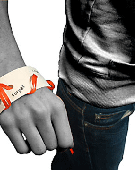
Prototyping the Perimeters
Artists, architects, designers, and other practitioners are constantly fashioning new forms and challenging disciplinary boundaries as they employ techniques such as rapid prototyping and generative processes. In the exhibition Perimeters, Boundaries, and Borders, at Lancaster, UK's Citylab, organizers Fast-uk and Folly explore the range of objects, buildings, and products being conceptualized with the aid of digital technologies. Aoife Ludlow's 'Remember to Forget?' is a series of jewelry designs that envisioned accessories incorporating RFID tags that allow the wearer to record information and emotions associated with those special items that we put on daily. Tavs Jorgensen uses a data glove in his 'Motion in Form' project. After gesturing around an object, data collected by the glove is given physical shape using CNC (Computer Numerical Control) milling, creating representations of the movements in materials such as glass or ceramics. Addressing traces of a different sort is Cylcone.soc, a data mapping piece by Gavin Bailey and Tom Corby. These works and many more examples from the frontiers of art and design are on view until October 21st." Rhizome News.
Posted by jo at 10:59 AM | Comments (0)
Ping Pong Placard

Paris-Taipeh-Kyoto
September 29 - October 1, 2006 :: Paris, France; Taipeh, Taiwan and Kyoto, Japan
The Paris-Taipeh-Kyoto Ping Pong Placard will take place this week end in an appartment of Paris and in other locations in Taipeh and Kyoto. The Placard consist of a series of one-hour performances & live acts being streamed (through Internet) and performed between Paris, Taipeh and Kyoto. There will also be some events and actions requiring or not requiring physical displacement.
You can find the updated information here. You are warmly welcome to this event, which I hope you will enjoy. If you cannot make it to Paris, Taipeh, Kyoto or Bruxelles, you may either want to check out the other "Listening Placard" (see about page linked below of the FAQ) or create one Listening Room yourself. You can also join us on IRC through the placard website.
Thanks a lot to all the people who started the whole thing, helped throughout, participated, shared the fun, played or are going to play, maintained the positive energy and the creative spirit, forwarded or are going to forward this invitation to whoever might be interested, they know who they are.
See you there.
Philippe
http://xlrmx.org
Placard 2006: Placard is an international electronic music headphone festival featuring many artists from different places, experimenting with sound and music. You can check out more info at the about page. The Paris-Taipeh-Kyoto Ping Pong placard will be held from September 29, 2006 to Oct 1 2006 in Paris, France; Taipeh, Taiwan and Kyoto, Japan. It's free and you can apply to play there.
Posted by jo at 10:57 AM | Comments (0)
Mediaterra 7th International Art + Technology Festival

GAMING REALITIES
GAMING REALITIES
4-8.10.2006 / ATHENS / GREECE
@ Technopolis, Pireos 100, Gazi
What role do videogames play in our lives today? As the boundaries between the virtual and the real blur more and more in the new gaming worlds we have come to inhabit, new conditions arise.
With the theme Gaming Realities, medi@terra 06 aims to explore the different dimensions and developments in the gaming fields and the impact they have on the different fields of society today. This year's Festival and International Conference set up to explore the diverse ideas, narratives, and ideologies involved in the video games.
Videogames express and reflect today's world, its aesthetics and technologies, give rise to new identities and new mentalities. Medi@terra Festival has invited individuals who have realised the importance and dimensions which this field has acquired, asking them to deposit their viewpoints and experiences with regard to the connections of the game to society, the identity and psychology of the player, the space and narration of the game, new technologies and conceptions and possibilities for the computer game to comprise the key art of 21st century.
'Gaming Realities: the Challenge of Digital Culture' is a three days International Conference [6-8 October, Athens] organised by Fournos Centre for the Digital Culture.
57 papers will be presented in the following thematic units:
Gaming Situation: Game-Player-Society
[Gaming Society / Identity and Psychology of the Player / Game Politics]
Gaming Environments
[Game in Urban Space / Gaming New Narratives / Gaming Technologies / Immersion in Game]
Game Art
[Game Art and Culture / Game as art]
Keynote speakers include:
Adrian David Cheok, Director of Mixed Reality Lab, NTU Singapore, Associate Professor in the Schools of Electrical and Computer Engineering
Celia Pearce, Assistant Professor, School of Literature, Communication & Culture, Ivan Allen College, Georgia Institute of Technology
Chris Crawford, Game Designer (Atari), Author 'The Art of Computer Game Design'
Eric Zimmerman, Game Designer, CEO, Gamelab
Espen Aarseth, Associate Professor and Principal Researcher Center for Computer Games Research, IT University of Copenhagen, Co-founder and Editor-in-chief
Gamestudies
Frans Mayra, Director of Research, Hypermedia laboratory, University of Tampere, President of DIGRA
Gonzalo Frasca, IT University of Copenhagen, Editor www.ludology.org, Co-editor of www.gamestudies and www.watercolergames.org
Julian Dibbell, Contributing Editor Wired Magazine, Author 'My tiny life: Crime
and Passion in a Virtual World'
Julian Oliver, Free-software developer, composer, media-theorist, Founder of
www.selectparks.net
Kristian Lukic, writer, artist, cultural and game researcher, Founder of
Eastwood, Real Time Strategy Group
Manthos Santorineos, artist, Artistic Director of medi@terra festival, Assistant
Professor Athens School of Fine Arts
Margarete Jahrmann, Professor for media arts & game arts, University of Arts and Design, Department of New Media Switzerland
Matt Adams, member of the Blast Theory
Micheal Mateas, Faculty Member University of California, Santa Cruz, Creator of
FACADE
Tom & Vicky Arundel, Creators of the Darwinia, Introversion Software
Xavier Lardy, Storyboarder, game designer, founder of www.machinima.fr
The conference will follow an exhibition of Game installations / Political games
/ Game mods / Text adventures / Game multiplayer environments / Machinimas / Sound based games
Exhibition: Alter Gaming
4-8 October, Athens, Greece
Exhibition Opening: October 4, 20.30
30 game projects by independent creators and artists from the international
field that work on the new media and explore the possibilities given by the
videogaming platforms. Different 'unseen' sides of today's gaming realm
are proposed with games characterised for their interdisciplinary character,
the socio-political messages they convey, the technical and aesthetic
innovations they introduce and the subversion of game standards imposed by the gaming industry.
Featuring games by
Christoph Anthes / Blast Theory / Benjamin Chang / Dimi Christopoulos / Devart / Eastwood Group / Sylvia Eckermann / Gerald Nestler / Christof Cargnelli / Oliver Irschitz / Fiambrera / David Gauthier / Henri Marino / Laurie Prevot / Jean Batiste Spieser / Troy Innocent / Introversion Software / The Ludic Society / The mamayans / Michael Mateas & Andrew Stern / Panagiotis Koutlemanis / Dimitris Dinieas / Axel Stockburger / Persuasive Games / Molleindustria / Nick Montfort / Personal Cinema / Persuasive Games / ATI / Prof. Marie-Helene Tramus / Cedric Plessier / Orna Portugaly / Daphna Talithman / Sharon Younger / Serious Games Interactive / Axel Stockburger / Tale of Tales / Julian Oliver / Steven Pickles / sheismartha / Alexandros Plakidas Dasios / University of the Aegean / Mathias Fuchs + Oliver Farshi
Machinimas La petite Anthologie de Machinimas
A compilation by Xavier Lardy (founder of machinima.fr) presenting some of the
most interesting machinima works created in the last years. A collaboration of
Paris Cinema, the Forum des Images and Machinima.fr that premiered in Paris
last July.
Including projects by:
Ethan Vogt / Bernie Burns / Dave Lloyd and Matt Kelland / Pierce Portocarrero /
Hugh Hancock / Ezra Ferguson and Terran Gregory / Katherine Anna Kang / Paul Marino / Friedrich Kirschner / G Hoffmann / Alex Chan
PLUS!
Special Sound performances + parties by the Videogame Orchestra
Mathias Fuchs + Oliver Farshi that mix old video game tunes with contemporary electronic sounds offering a different unique navigation in a audiovisual environment
More information and details
www.mediaterra.org
or contact us
info@mediaterra.org
tel +302106460748
FAX +302106470069
Organised by Fournos, Center for Digital Culture
With the collaboration and support of Hellenic Ministry of Culture, General
Secretariat of Youth, British Council, American Embassy, French Institute of
Athens, Embassy of Switzerland, Embassy of Austria, Technopolis, AKTO
Sponsors: Sony Playstation, Sony, FNAC
Internet Sponsor: Forthnet
Media Sponsors: Computer Games, Game Pro, Ozon magazine, MAD TV, Rock Fm, Games
Radio, Highlights, Ozon, Start, Videorama, Cultureguide.gr
Posted by luis at 10:23 AM | Comments (0)
Rhizome Tenth Anniversary Festival

August 2006 to February 2007
Rhizome celebrates Tenth Anniversary with Festival in New York and online.
From August 2006 through February 2007, Rhizome will present a number of innovative exhibits, performances, discussions, and online projects throughout New York and elsewhere, in celebration of ten years of leadership in the new media arts field. This ambitious slate of programs will honor the vibrancy, diversity, and strength of this growing field and will provide an opportunity to connect with new media art both online and offline.
Rhizome was initiated in 1996 as an online platform for the global new media art community. At that time, the organization’s focus was primarily upon Internet art. Ten years later, Rhizome retains this focus and has also grown to support a wide range of art that engage emerging technologies—including sound art, locative media, digital video, software art, and modifications of video games. As the Internet and other computing technologies have come to play a more prevalent role in culture, Rhizome has supported artists’ expanded involvement with these tools and materials. The anniversary festival provides a touchstone moment to celebrate new media art and look forward to further advancements in the field.
FESTIVAL HIGHLIGHTS include collaborations with a number of organizations committed to supporting new media, including Rhizome’s affiliate, the New Museum of Contemporary Art, and also the Solomon R. Guggenheim Museum, The Kitchen, the Vera List Center, ISEA, and Foxy Production.
Rhizome and the New Museum will co-present Time Shares, a series of nine Internet-based exhibitions on themes ranging from globalization to pop culture to site-specific works in the popular online game space, Second Life. An exhibition of the eleven compelling Internet-based art works commissioned by Rhizome in 06-07 will also be included.
This Fall, The Kitchen will host a night of Internet-related performances, the Vera List Center will host a discussion about open source issues, and the Guggenheim will be the venue for two media activists’ performative lectures. In February, an exhibition at Foxy Production gallery will look at the relationship between nature and technology. The international group of artists included in these programs includes some of today’s most engaged practitioners, such as Young Hae Chang/ Heavy Industries (Hong Kong), Olia Lialina (Moscow), JODI.org (Rotterdam), Jacob Ciocci (Pittsburgh), the Yes Men (Glasgow/ Paris), Ze Frank (NY), Ricardo Miranda Zuniga (Mexico City/ NY), and the Raqs Media Collective (Delhi).
Considering Rhizome’s origin as an email list, Rhizome has always been a catalyst for discourse. During the festival, Rhizome and the New Museum of Contemporary Art will continue to collaborate on a new series of book releases, entitled Celebrating New Media Scholarship, three of which have already drawn very large audiences. Additionally, an online collaborative writing project, entitled Keylines, will provide a site for active discussion of issues relevant to new media and culture at large, including the environment, feminism, protest, and art historical questions. The site launches this week, with specially-commissioned essays by Raqs Media Collective, Bruce Sterling, David Ross, Lynn Hershman, and others.
For a full schedule, images, or more information, visit the website.
festival[at]rhizome.org
T: 212-219-1222 ext. 208
Rhizome would like to thank the National Endowment for the Arts (NEA), the New York State Council for the Arts (NYSCA), the Department of Cultural Affairs (DCA), College Art Association and the Experimental Television Center and for their generous support of the Festival.
Posted by jo at 07:39 AM | Comments (0)
September 28, 2006
META[CC]
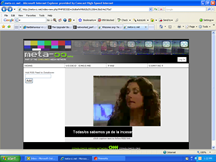
for The Politically Impaired
META[CC] -- by CONGLOMCO MEDIA NET -- seeks to create an open forum for real time discussion, commentary, and cross-refrencing of electronic news and televised media. By combining strategies employed in web-based discussion forums, blogs , tele-text subtitling, on-demand video streaming, and search engines, the open captioning format employed by META[CC] will allow users to gain multiple perspectives and resources engaging current events. The system we are developing is adaptable for use with any cable or broadcast television network.
We hope that you will take a moment from your viewing time to add the RSS feed of a blog you find noteworthy; the META[CC] search engine is apolitical and influenced only by the news and information sources supplied by viewers. We apologize, but at this time podcasts and vlogs are not supported.
Posted by jo at 01:26 PM | Comments (0)
Simultaneita: Ars HyperMedia Almanac
![]()
Call for Papers and Artworks
Ars HyperMedia, Call for papers and artworks, the submission deadline is November 20, 2006. Simultaneita new media arts magazine is pleased to announce this call for submissions for a special project. Yearly full-color printed "Ars HyperMedia Almanac" on digital culture / media arts. The publication will feature various sections, to be formed through articles, texts, interviews and images. Keywords: -- net / web art -- digital art -- hacker art / hacktivism / artivism -- architecture / design -- dance / theatre -- sound / sonic art / electronic music -- electronic literature -- festivals / art centers / galleries -- curating and preserving new media art -- cross-media -- cinema / animation / comics.
Articles may be 2,000 words in length.
What kind of artworks are we looking for? Digital art, graphic works, illustrations, digital photos, sketches, drawings, video, CD or DVD, graphic novels are accepted. File format: photoshop tiff, jpg 300 dpi.
For more information:
info[at]simultaneita.net
Simultaneita
Via Isole Curzolane 18 / E
00139 Roma - Italy
About Simultaneita
"Simultaneita new media arts magazine" is an online journal and periodically printed with international contributors: it's a publication with an explicit futurist attitude, largely aimed at today cultural topics and special reference to art-technology relationship; it features in-depth essays, unpublished materials, reviews, notes and articles on new media arts, digital culture, architecture, music, cinema. Established in 1997 as a printed magazine, Simultaneita' is a direct follow-on from the monthly "Futurismo-Oggi" (1969-1993). A magazine to promote the strength and diversity of new media arts scene and the Futurist legacy: the mission is to be an outlet with a resolutely international orientation for the reflection, knowledge, research and diffusion of these new artistic forms, without wanting to pigeon-hole digital art and its characteristic fluidity.
The magazine was in Sevilla as media partner for "Art Futura '98 the second skin" the new media & digital art festival, "Loop '00" International Video Art festival (Barcelona 2003), ³hack.it.art Hacktivism in the Context of Art and Media in Italy² (Berlin 2005), "Wayleave" art & architecture magazine exhibition (Rome 2005) and "fmx" International Conference on Animation, Effects, Realtime and Content (Stuttgart 2006). Simultaneita was media partner to the 2006 edition of the Inter-Society for Electronic Arts (ISEA) Symposium / ZeroOne San Jose: A Global Festival of Art on the Edge.
Posted by jo at 12:47 PM | Comments (0)
TAGGED
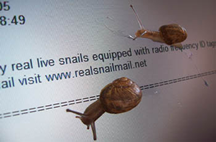
New RFID Works
TAGGED :: Five new works by artists working with RFID technology as part an ongoing project produced by [ space.media.arts ] :: Opening Reception: 6 October, 6 - 9pm; continuing until 21 October :: With a performance by Paula Roush.
Electronic tagging technologies are increasingly impacting society and are set to shape the future. Standing for Radio Frequency Identification, RFID tags use radio waves and can potentially function without your knowledge, with widespread adoption across many commercial and public industries.
In this exhibition, the artist collaborative Louis-Philippe Demers and Philippe Jean are working with local shop Hollywood Convenience electronically tagging their grocery items to produce the artwork iTag. Using a portable music device, available to pick up from the exhibition, shoppers can listen to music generated from the grocery aisles.
RealSnailMail is a project in development by boredomresearch, using RFID technology to enable real snails to carry and deliver electronic messages on their own time, despite growing expectations of instant communication.
Mute-Dialogue (Yasser Rashid and Yara El-Sherbini) have created the interactive installation, Origins and Lemons. Arranged as an East End market stall the installation invites you to pick up RFID-tagged items and scan them to receive clues as to their history and origin.
In SWAPOId, evoLhypergrapHyCx (C6) implement RFID technology in the Antisystemic Distributed Library Project, an alternative library of shared books, videos, and music with venues in community centres and bedrooms worldwide, and through this acting as but one site of resistance against a de-humanising, de-dimensional agenda.
Arphield Recordings by Paula Roush records the sound of citizens scanning their Oyster cards in London Underground stations, and outputs them in live performance, installation and public intervention.
A new essay by Armin Medosch, The Spychip Under Your Skin, accompanies this exhibition and will be published on a new [ space.media.arts ] website: http://www.spacemedia.org.uk.
FOR MORE INFORMATION
Email: exhibitions[at]spacestudios.org.uk
Web: http://www.spacemedia.org.uk
Telephone: 0208 525 4339
Press inquiries: claire[at]spacemedia.org.uk
TRAVEL
Bus: 26 & 48 from Liverpool Street
106 & 254 from Bethnal Green
55 from Old Street
Tube: Bethnal Green
Train: Hackney Central Silverlink
EXHIBITION OPENING TIMES
Wednesday - Saturday.1 - 6pm
FREE ADMISSION FULLY ACCESSIBLE
Posted by jo at 08:42 AM | Comments (0)
September 27, 2006
Jonah Bokaer
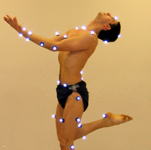
Dancing Up a Storm of Radical Doubt
Dancing Up a Storm of Radical Doubt by Jonah Bokaer: Flashing as dismissive an attitude toward status quo as Merce Cunningham—whose company he dances for—Brooklyn-based dancer Jonah Bokaer and the artists’ collective Chez Bushwick have recently initiated a nomadic experimental dance laboratory called AMBUSH. Each monthly installment of the program occupies a different loft space in Brooklyn’s Bushwick neighborhood. An outgrowth of Chez Bushwick’s remarkably successful SHTUDIO SHOW, AMBUSH is identified by the collective as “an ambulatory new program of dance, performance, and related forms.” NYFA Current asked Bokaer, Chez Bushwick’s manager and founder, to explain the evolution of the collective, their propensity for rigorous interviews of critics and curators, and how no reviews are allowed. [continue reading at NYFA]
Posted by jo at 07:13 PM | Comments (0)
Blast Theory at FIRST PLAY BERLIN
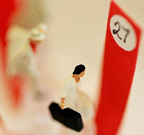
Premiere of Day of the Figurines
Blast Theory at FIRST PLAY BERLIN - opens tomorrow: 28.9.06
Day of the Figurines: Be the first to experience Day Of The Figurines - a virtual city where events are dictated by text message. A gig by Scandinavian death metallists. An invasion by a Middle Eastern army. A church fete. Send and receive. React and Interact.
Trampoline are delighted to host the world premiere of renowned British media art group Blast Theory’s new mobile phone game for up to 1000 players. Day Of The Figurines will be on show for 24 days in the Berlin venue Hebbel am Ufer theatre, HAU2, launching on September 28th at 6pm.
Day Of The Figurines is a mass participation artwork using mobile phones that is part board game and part secret society. Set in a fictional English town that is littered, dark and underpinned with steady decay - the game unfolds over 24 days, each day representing an hour in the life of the town. Players choose a figurine to represent them and participate using their mobile phones. Interacting via text messages players receive updates from the town, missions and dilemmas. They can chat to other players who are near them using text messages as events unfold day by day.
Day Of The Figurines is the world’s first MUD (Multi User Domain) for mobile phones and was developed as part of the European research project IPerG (Integrated Project on Pervasive Gaming) and in collaboration with Mixed Reality Lab, University of Nottingham. Following FIRST PLAY BERLIN, Day Of The Figurines will visit the National Museum of Singapore in December 2006 and tour the UK in 2007. For more information about multi-award winning, Bafta-nominated Blast Theory go to www.blasttheory.co.uk
First Play Berlin: Day Of The Figurines kick starts a month of digital art in and around Hebbel am Ufer. FIRST PLAY BERLIN features innovative work questioning the concept of performance and interactive art. Dominated by an artistic process absorbed in understanding location and pervasiveness, the work demonstrates the complexity of our globally connected reality. FIRST PLAY BERLIN is funded by the German Federal Cultural Foundation, British Council, Hebbel am Ufer and Radiator Festival for New Technology Art. For more information about FIRST PLAY BERLIN and Trampoline – the international platform for new media art - go to www.trampoline-berlin.de
Posted by jo at 06:49 PM | Comments (0)
Independent Photography

Artist's Commission, Woolwich
Independent Photography is looking for an artist working with film or digital media to undertake a participatory arts project involving a range of residents from the Walpole Estate in Woolwich. The project aims to engage and bring together estate residents of different generations and diverse cultural backgrounds to explore a sense of place and questions of belonging. Seeking to elicit perceptions of individual and community identity from a variety of perspectives, the brief is open as to whether the commissioned artist will work with a group of residents on an integrated project or with individual residents on discreet activities which come together in the commission's conclusion.
This artist's commission is for new work that can address and explore the following aims: - inspire and intrigue through the use of contemporary media arts and socially engaged practice - activate a level of participation from the diversity of communities on the estate - explore issues relevant to these communities regarding the estate on which they live and how the proposed regeneration of Woolwich town centre will affect them - investigate these issues within personal as well as wider social, environmental, and cultural contexts
We are offering a £4,500 commission for a socially engaged project that explores the above aims and can be undertaken over the period October 2006 - January 2007, culminating in some form of outcome, whether event, exhibition, and/or distributed products.
The project is managed by Independent Photography and funded by the SRB6 Health Benefits Programme.
Artist profile: The commission seeks an artist experienced in engaging with members of the public and the complexities that this involves. Independent Photography is keen to develop contemporary participative and public art practice, through the use of visual, audio, or audiovisual media.
The commission seeks to offer an investigative and engaging opportunity to an artist working in site specific practice. Work that allows meaningful participation by members of the community is central to its aims, as is the opportunity for innovative approaches to this challenge. Location Walpole Estate is situated in the Woolwich Common Ward of the London Borough of Greenwich. It is one of four council estates in this culturally diverse Ward, south of Woolwich town centre and adjacent to Woolwich Common, where the high proportion of BME residents includes significant Indian, West African and Somali communities.
The area suffers from multiple deprivation including high unemployment, low incomes, higher than average numbers of single parent families, low educational attainments and higher than average crime rates. Using the Government's measure of deprivation, the Index of Deprivation 2004, Greenwich is the 41st most deprived borough in England and Wales and the Woolwich Common Ward has areas in the 10% most deprived in England.
The Estate is privately managed by the Walpole Estate Management Board, and as well as a Youth Club there are a number of community organisations based on the estate including a crèche and a Somali teaching project, both of which include members from beyond the estate itself.
Woolwich is undergoing significant regeneration, which will have a dramatic effect on the town centre and its transport links, as well as on housing provision. The DLR will open in Woolwich in 2009, providing a link to London City Airport, and a new rapid transit linking Woolwich with Abbey Wood, North Greenwich and Greenwich town centre will be in operation by 2008. Plans for the Woolwich town centre include 2 major supermarkets, 250,000 sq foot of retail and over 1,000 new homes. The Council has agreed to remodel three estates which comprise over 1000 council homes in the area as part of its decent homes strategy, and if current plans go ahead, Walpole Estate will be the only housing estate left in the Woolwich Common Ward.
Project Management: The overall management of the commission is the responsibility of Independent Photography's Artistic Director, Isabel Lilly. The co-ordination and day-to-day running of the project will be conducted by Rohini Malik Okon, Project Co-ordinator, who will be the artist's point of contact and support throughout the commission.
Budget: This commission offers a budget of £4,500. Please provide a budget proposal as part of your application. The budget should cover artist's fee, materials/additional equipment, and final event/exhibition costs including marketing. IP will provide full administrative and marketing support to the project.
Timescale: The commission is intended to take place between October 2006 and January 2007.
Artists are invited to submit a timescale as part of their proposal, which should include: an initial period of research to get to know the area and its residents; time for the delivery of the project with participants; and post production time to deliver the finished outcome. Copyright Copyright of any work produced as part of the commission will be the property of the Artist. The Artist would grant IP the right to reproduce any work created during the Commission as necessary by photography, lithography, print film, videotape, CD, mini disc, DAT, or audio cassette for publicity or promotional purposes connected with the Commission.
Application Procedure: Artists are invited to submit the following as an application for the above.
commission:
1. Commission proposal, to include:
- Conceptual approach
- Project Description
- Detail of community participation / engagement
- Budget outline
- Timescale
- Potential outcome(s)
2. Current CV
3. Samples of recent work
(These can be printed material, audio, video, digital media, URL's)
Application deadline: 5pm, Monday 2nd October
Shortlisted applicants will be invited to interview at IP on: Friday 6th October
Please send application either by email or by post to:
Isabel Lilly / Rohini Malik Okon
Independent Photography
Rothbury Hall
Azof Street
London SE10 0EF
isabel[at]independentphotography.org.uk
rohini[at]independentphotography.org.uk
Rohini Malik Okon
Project & Events Co-ordinator
Independent Photography
Rothbury Hall, Azof Street, London SE10 0EF
T: 020 8858 2825 F: 020 8858 2025
Posted by jo at 06:37 PM | Comments (0)
GLOWLAB.10
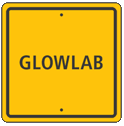
september :: october 2006
Welcome to Issue 10, featuring projects from Conflux 2006 that investigate social and political spaces within Brooklyn through performance-based intervention, mobile broadcast, historic reenactment and collaborative exploration.
It was a pleasure seeing many familiar and new faces at Conflux this year. The festival took place September 14–17 in Williamsburg and featured projects by over 80 artists from around the world who offered guided and un-guided tours [some of them smelly], street games, workshops, mobile broadcasts, multimedia presentations and more. Despite a little rain, we built and planted and cycled and recycled. Needless to say, the neighborhood was thoroughly explored. More photos and posts are on our site here and on Flickr here. If you have Conflux photos, post 'em and tag 'em: conflux2006.
We're jumping straight back into planning for Conflux 2007 so keep an eye out for a call for participation before the end of the year…
Artistic Souvenirs from Brooklyn by Suvi Aarnio :: Artistic Souvenirs from Brooklyn aims at exploring the intimate sights of Brooklyn together with the residents of the area by creating a small-scale touristic phenomenon around everyday life during the Conflux Festival.
The Smelling Committee by Caitlin Berrigan :: Inspired by the olfactory bravado of the original Smelling Committee, we will lead an historical simulacrum of the 1891 adventure that will invite reflection upon the ephemeral, odiferous fabric of Brooklyn neighborhoods.
Scout: The City in Audio by Emily Conrad, Jeffrey Galusha, Todd Holoubek :: An untamed exploration of New York City through audio via handful of active cell phones set free to roam the city. Their findings are then broadcast live over the FM dial.
Public Parking Revisited: The Storage of Utopia by Ryan Griffis :: This text is an incomplete statement on the history of parking lots in the United States.
24 Hour Roadtrip by Kurt Braunohler, Calvin Johnson and Scott Gabriel Knowles :: A day long journey through the five boroughs of New York City. The 24 Hour Roadtrip is a variation on the conventional great American road trip, but using public transportation instead of a car, and making stops at roadside attractions unique to NYC.
The Former Resident Project by Rachelle Viader Knowles :: Explores the city through the narratives of the no-longer resident, people whose lives have been shaped by their experiences of places they no longer inhabit.
Free Press by Sal Randolph :: Free Press [your book here]. You are invited to contribute to the creation of a worldwide open-access Free Press. Send your manifestos, psychogeographies, theories, and anything else to be published as Free Press books.
St. Agnieska, Patroness of the Waterfront by Kimberly Simpson :: A performance-based pilgrimage to local shrines erected to commemorate the appearance of St. Agnieska, a patron saint who calls attention to toxic hotspots along the waterfront and the work being done by resident activists.
The Pansy Project by Paul Harfleet :: Paul Harfleet explores the origin, processes and development of The Pansy Project, a performative artwork that comments on the experience of verbal homophobic abuse on city streets by planting pansies where abuse occurs.
Have a Seat: Public Seating in an Unused Space by Caroline Woolard :: Public seating is affixed to the posts of NO PARKING signs so that anyone can rest without removing themselves from the reality of urban bustle.
Posted by jo at 12:48 PM | Comments (0)
Seiko Mikami
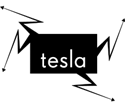
On the Continuum of Perception and Interfaces
http://www.tesla-berlin.de">TESLA salon - art/science 2 :: Thu. 28 Sept., 20:30 h (conversation in English) :: TESLA, Klosterstr. 68, Berlin-Mitte :: Seiko Mikami - On the Continuum of Perception and Interfaces: The renowned Japanese artist Seiko Mikami talks about her work and presents a preview of her latest project which she is working on during a year-long residency in Berlin.
All projects by Seiko Mikami involve human perception. Perception is highly significant, yet also a very complex and wide subject area. Moreover, we still don't understand our body and its functions very well. In order to approach these issues, Mikami decided to disassemble the individual senses: seeing, hearing, the sense of touch, gravity, etc., advancing eachsense separately through different interfaces. The point of each project is to create an 'interface' set to one sense of perception by elaborating a particular sensory mechanism. Mikami's entire project is motivated by the conviction that something like what we call 'interface' in the context of computer technology, already exists within us. Mikami's projects make the audience experience their own state of perceptions. The interfaces designed for her projects function as extensions of what we already have--a network that mediates our subjectivity, that synthesizes what we perceive and the world that is perceived.
Mikami explores the 'in-between' or 'inter-medium' of the information interchange, through perception, between the body and the surrounding space. She audifies and visualises what is not conventionally the object of those sense. Thus her key proposition is: "the eye is not merely a thing that sees and the ear is not merely a thing that hears; it is possible for the ear to see, for the nose to hear, and for the eye to touch."
Seiko Mikami (Japan) is an artist who teaches Information Art at Tama Art University, Tokyo. Most of her works are interactive media art installations incorporating human perception, including the eye tracking project "Molecular Informatics" at Canon ARTLAB (Tokyo 1996), about the acoustic sense and the living body sound at NTT InterCommunication Center's permanent collection (Tokyo 1997), "Gravicells" on the theme of gravity called the 6th consciousness in Yamaguchi Center for Arts and Media (Japan 2004, in collaboration with Sota Ichikawa). She has participated in festivals and exhibitions all over the world, incl. DEAF, Ars Electronica, and transmediale (2002, 2005). Her latest work, first shown in the "Desire of Codes" show at Kulturhuset (Stockholm, Sweden, 2006), will be presented at TESLA during transmediale.07. Her work was published in "Seiko Mikami - Art Works" at Diputacion Provincial De Malaga, Spain (2004). - Mikami is currently on a sabbatical and based in Berlin as a fellow at the University of the Arts. From December till February 2007 she will be an artist in residence at TESLA.
The information list of transmediale international media art festival berlin :: transmediale: http://www.transmediale.de
list-info: http://mailman.transmediale.in-berlin.de/mailman/listinfo/newsletter
Posted by jo at 12:23 PM | Comments (0)
BIENNIAL OF THE YEAR 3000
![]()
ARTISTS AND CITIZENS TAKE POWER
FROM 5 OCTOBER TO 15 DECEMBER 2006, FRED FOREST INVITES ALL ARTISTS TO PARTICIPATE IN THE BIENNIAL OF THE YEAR 3000, A BIENNIAL IN WHICH ARTISTS AND CITIZENS TAKE POWER AND EXERCISE THEIR RIGHTS TO THE FREEDOM OF SPEECH AND THE FREEDOM OF IMAGE. YOUR PRESENCE, EITHER THROUGH IMAGES, WORDS OR BOTH, WILL BE HIGHLY SIGNIFICANT.
ACTIVELY PASS ALONG THIS PROPOSITION THROUGH ALL YOUR PERSONAL NETWORKS.
THE SUCCESS OF THIS INITIATIVE WILL ALSO BE YOUR SUCCESS AND WILL DEMONSTRATE THE CAPACITIES OF ARTISTS TO SELF-ORGANIZE AGAINST DIFFERENT CULTURAL POWERS AND THE EXISTING INDUSTRY, USING THE TOOLS OF DIGITAL COMMUNICATION AND THE INTERNET.
CONTRIBUTIONS WILL BE DISPLAYED IN A LOOP ON THE MAC IN IBIRAPUERA PARK AND UPDATED PERIODICALLY. THANK YOU FOR YOUR PARTICIPATION
BIENNIAL OF THE YEAR 3000
A BIENNIAL IN WHICH ARTISTS AND CITIZENS TAKE POWER AND EXERCISE THEIR RIGHT TO THE FREEDOM OF SPEECH AND IMAGE
The French artist, Fred Forest, Docteur d'Etat from the Sorbonne, who organized the controversial Biennial, the "Biennial of the year 2000", in 1975, under the military regime, with the support of Walter Zanini, then director of MAC--has done it again in 2006! Thirty years later, he is organizing a "Biennial of the year 3000", with the participation of Brazilian and foreign artists.
In 1973, representative artists such as, Amelia Toledo, Anesia Pacheco Chaves, Armando Canuto, Cesar Loureiro, Conrado Silva, Euclides Sandoval, Fabio Magalhães, Gilberto Moirimitto, Luiz Augusto de Aruda, Luiz Carlos Homem da Costa, Regina Celia Canel, Sergio Fuiza, participated in his Biennial.
This year Fred Forest is organizing the Biennial of the year 3000 in São Paulo from 7 October to 13 December 2006. A Biennial that breaks free from the official Biennial, because it is a digital, planetary, participatory biennial, a biennial without selection and consequently, truly democratic.
Fred Forest has always played an important role as a pioneer. In 1973, he was already involved in the creation and performance of street art, participatory art, protest art, and social art. Over thirty years later, these art forms constitute an important part of today's artistic practices given the slowness of cultural institutions to assimilate innovation. This "Biennial of the year 3000" will happen in the same places as the "Biennial of the year 2000": in the Mac USP, Ibirapuera Park.
It will affirm with strength and independence that art does not stay tied to past concepts.
It will demonstrate that in an age where the Internet is helping to abolish the concepts of time and space, and where the aesthetics of communication invades all symbolic and social dimensions, art does that remain stagnant.
The making of art is first done with our senses, and our senses are not created from obsolete concepts when the world transforms itself in real-time under our very eyes.
Annick Bureaud (annick[at]nunc.com)
tel/fax : 33/ (0)143 20 92 23
mobile : 33/ (0)6 86 77 65 76
Leonardo/Olats : http://www.olats.org
Posted by jo at 12:05 PM | Comments (0)
New Media Poetics
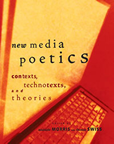
Poetry Composed, Disseminated, and Read on Computers
New Media Poetics edited by Adalaide Morris and Thomas Swiss :: New media poetry--poetry composed, disseminated, and read on computers--exists in various configurations, from electronic documents that can be navigated and/or rearranged by their "users" to kinetic, visual, and sound materials through online journals and archives like UbuWeb, PennSound, and the Electronic Poetry Center. Unlike mainstream print poetry, which assumes a bounded, coherent, and self-conscious speaker, new media poetry assumes a synergy between human beings and intelligent machines. The essays and artist statements in this volume explore this synergy's continuities and breaks with past poetic practices and its profound implications for the future.
By adding new media poetry to the study of hypertext narrative, interactive fiction, computer games, and other digital art forms, New Media Poetics extends our understanding of the computer as an expressive medium, showcases works that are visually arresting, aurally charged, and dynamic, and traces the lineage of new media poetry through print and sound poetics, procedural writing, gestural abstraction and conceptual art, and activist communities formed by emergent poetics.
Contributors:: Giselle Beiguelman, John Cayley, Alan Filreis, Loss Pequeño Glazier, Alan Golding, Kenneth Goldsmith, N. Katherine Hayles, Cynthia Lawson, Jennifer Ley, Talan Memmott, Adalaide Morris, Carrie Noland, Marjorie Perloff, William Poundstone, Martin Spinelli, Stephanie Strickland, Brian Kim Stefans, Barrett Watten, Darren Wershler-Henry
Adalaide Morris is John C. Gerber Professor of English at the University of Iowa, where Thomas Swiss is Professor of English and Rhetoric of Inquiry.
Thomas Swiss is Professor of English and Rhetoric of Inquiry at the University of Iowa.
June 2006
The MIT Press
A Leonardo Book
ISBN 0-262-13463-2. 416 pp., 92 illus.
Posted by jo at 11:49 AM | Comments (0)
September 26, 2006
Robin Rhode:
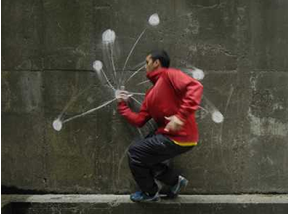
Art in Motion
South African artist Robin Rhode has produced new and exciting work for Africa Lives, co-commissioned by the visual arts and culture group 'Africa 05' and the BBC. View 'Yoyo' below, plus 'Jug' and 'Anchor' online. [BBC] [via]
Posted by jo at 05:50 PM | Comments (0)
Urban Tapestries
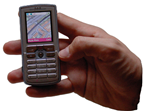
Scavenging Media for Guerilla Public Authoring
During the summer we have been working on a 'scavenging' approach for public authoring that would not depend on having access to custom systems or services (such as Urban Tapestries). Our idea is that it should require no central resources but enable people to stitch together knowledge, experiences and information using free online resources – a kind of Guerilla Public Authoring.
Our concept of scavenging is to break down the core components of public authoring and devise a methodology for linking them together and sharing them. The method will be one that requires little or no expert knowledge to set up and which can be adapted to the local conditions depending on what resources are available to the community.
In the next few months we will be testing and refining strategies and tactics for guerilla public authoring with some of the communities we are working with. Our aim is to create and publish a 'handbook' or guide on scavenging for guerilla public authoring.
Update: David Wilcox has blogged a further exchange on scavenging over at
Designing for Civil Society. [posted by Giles Lane on Urban Tapestries | Social Tapestries]
Posted by jo at 05:27 PM | Comments (0)
Blind Camera

The camera that takes others' photos
Well, well, i have to thank Julian for the scoop! Sascha Pohflepp is a new media artist based in Berlin. He also writes on this blog and rumours had it that his graduation project at the University of the Art in Berlin was kind of awesome.
His Blind Camera captures a moment at the press of a button. However, the device doesn't have any optical part. The camera memorizes only the time of the picture and immediately searches the net for other photos that have been taken in the same moment. Essentially, it is a camera that only takes photos that were created by someone who pressed a button somewhere else at that very time as its own button was pressed.
After a few minutes or hours, depending on how soon someone else shares their photo on the web, an image will appear on the screen. In a way, it belongs half to the person who had pressed the button and still remembers that moment. Because of that connection, the photos are never dismissed as random, no matter how enigmatic they may be. Video.
Brilliant stuff, Sascha! I'm sure i'll still want to take my own pictures but i'd love to have another one that allows me to do on the spot what i can't help doing when i upload my images on flickr: snooping around to check the photgraphies of other users who attended the same event as me or know the same person or happen to be in town that day. Also by Sascha: Fixr and Eavesdripping. [blogged by Regine on we-make-money-not-art]
Posted by jo at 05:18 PM | Comments (0)
Four Eyed Monsters
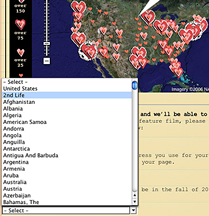
NATIONAL RECOGNITION FOR SECOND LIFE
I'm perhaps the last SL blogger to pump this charge, but if we can at least get a scruffy pair of indy filmmakers to acknowledge Second Life as a country, might as well keep the blogswarm going. Here's the deal: Four Eyed Monsters is a cool-looking quasi-documentary from a hipster couple who've turned their relationship into a feature film. In true Web 2.0 fashion, they're planning a tour of the movie across the US and the globe, but to get them to come to your town (or country), you need to put in a request. (Over 150 requests, and they put your place on the tour.) True to form, the Electric Sheep's SNOOPYBrown Zamboni engaged the filmmakers and got them to add Second Life as a country on the request page. So there we are, in between the US and Afghanistan-- which is, when you think about it, probably the best place for Second Life to be. With enough requests, the filmmakers will bring their tour to SL. (Here's Mr. Brown's original write-up on the campaign. And props to Akela Talamasca of SL Insider for the screen grab.) [blogged by Wagner James Au on New World Notes]
Posted by jo at 05:02 PM | Comments (0)
PROTESTOR:

the best thing to happen to activism since oppression itself
Protester™ is a free platform for developing, tracking, and valuating real-world social applications. Protester™'s project incubator allows activists to propose actions, meet and collaborate with others, and measure the success or failure of their work. Protester is designed for those who understand the need for creative approaches to the world's social justice issues.
How is real social progress achieved? How can social actors tell if they are making any progress? While value-creation remains simple for the economist, the artist is plagued with smoke and mirrors. Worse yet, the rise and fall of economies is at best a poor indicator of the happiness of society's cultural producers. For those people caught in the vague uncharted territory outside of business politics, art, dissent, community, or terror; there are clearly other standards. Is culture for everyone? It turns out that the gap between the "haves" and "have-nots" is just as great whether we're talking about economic capital, or "cultural" capital. Yet, the concept of Cultural Capital; - a quantitative measure of cultural value - has not been sufficiently explored as tool for evaluating the activism industry.
By logging in to Protester, activists access tools which enable them to see real time results of their political action. There's no reason to sit on the couch in frustration, watching carefully crafted messages twisted into knots by the media. By adding projects to the Incubator, networking with users, and maturing their Social Applications, Protesters gain skills and develop projects while growing their Cultural Capital. Watered-down legislation constructed by the nonprofit industrial complex becomes irrelevant in the face of the DIY direct action of Protester. Time spent bickering with other activists or groveling for foundation money can be maximized by cultivating a much more renewable resource: Cultural Capital.
Projects, matured in the Incubator, may graduate into fully realized Social Applications. These apps are valuated in part by our new RTMARK Cultural Capital Index. To help encourage creative apps, we have created a tool to identify Intangible, or foreseeable future events that present an opportunity for a viral critique or clever reaction. We have also created a marketplace for the exchange of futures - speculative wagers of the future value of an app. Buying and selling futures allows activists to grow their Cultural Capital while indicating support or predicted success for a particular Social Application™. In the process, Protesters can send messages to other users, add collaborators, and discuss private projects. Activists see their social network grow in less time than it takes to make a maltov cocktail!
Our progressive ecosystem allows the development of knowledge products for dismantling corporate memes and detourning conventional ideologies. Protester is the best thing to happen to activism since oppression itself. [via artificialeyes.tv reBlog]
Posted by jo at 04:54 PM | Comments (0)
Networked Digital Storytelling:
![]()
Call for Participation
Networked Digital Storytelling: Call for Course Participation :: Time: November 6, 2006 – January 18, 2007 - 15 ECTS points :: Place: K3 School of Arts & Communication, Malmo University, Sweden.
Networked Digital Storytelling is a course that critically explores the artistic possibilities of new networked media such as videoblogs, social media, mashups and locative media. Participants in the course use these technologies in a series of workshops built around the theme of mediating and telling stories about the city.
During the workshops there will be guest lectures by artists, social media workers, bloggers, and theorists. Regular teachers are Kristoffer Gansing, PhD student specialising in alternative media, and Tina Giannopoulos, cultural producer and architect. The course ends in a common presentation in the form of an exhibition, installation or urban intervention.
How to apply: If you read Swedish fill out the following form:
The course code is: 00334
More info can be found at: http://www.mah.se/efteranmalan (in Swedish only). If you don’t read Swedish, send an e-mail with a statement of interest to: kristoffer.gansing[at]k3.mah.se (and you will receive the necessary papers for applying)
Workshops & Curriculum
1: Networked Stories/Spatial Stories: Untold stories and places of Malmö. Google map mashups + video. With Bitlab Malmö, Surreal Scania. http://www.bitlabmalmo.net http://www.surrealscania.se.
2: Hybrid Spaces/Hybrid Media: In collaboration with tv-tv and the t-vlog project. Ends in a transmission at Copenhagen based tv-station tv-tv. http://www.t-vlog.net http://www.tv-tv.dk.
3: Social media: Going deeper into technologies of videoblogging, participatory culture and culture jamming. In between workshops there will be a regular theory class, with close analysis of texts and films. We read everything from 60’s expanded cinema gurus like Gene Youngblood to recent online theorists like Adrian Miles and Jill Walker. Full course syllabus is available at http://www.edu.mah.se/KK3219/syllabus (literature list is subject to change / update!)
Relevant links and References
http://www.networkedstorytelling.org
Blog by Kristoffer Gansing, with info about earlier workshops.
http://www.mah.se/K3
Malmo University, School of Arts & Communication site.
http://www.edu.mah.se/KK3219/syllabus
The full course syllabus.
http://webzone.k3.mah.se/projects/nds
The internal course page.
Posted by jo at 04:21 PM | Comments (0)
Center for Advanced Visual Studies
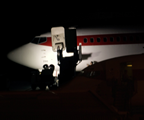
Terminal Air
Center for Advanced Visual Studies MIT’s School of Architecture and Planning :: 265 Massachusetts Ave, 3rd Floor, Cambridge MA 02139 :: 617 253 4415 :: Monday October 2, 7:00 pm. The Center for Advanced Visual Studies presents Terminal Air (Institute for Applied Autonomy and Trevor Paglen).
Tad Hirsch (Institute for Applied Autonomy) and experimental geographer Trevor Paglen will present early research for their new project, Terminal Air, an interactive installation that enables audiences to track a fleet of CIA-operated aircraft around the world. These airplanes, which were first uncovered by an international network of amateur aviation enthusiasts and later reported on by various investigative journalists, are known to be involved in "extraordinary rendition"—the practice of illegally transporting terrorism suspects to secret overseas military bases for torture and interrogation. Paglen will also talk about Torture Taxi: On the Trail of the CIA's Rendition Flights, which he co-wrote with journalist AC Thompson. Andrew Woods of Harvard Law School will also speak. Terminal Air is supported by 2006-2007 commission from Rhizome.org.
Trevor Paglen is an artist, writer, and experimental geographer working out of the Department of Geography at the University of California, Berkeley, where he is currently completing a PhD. His work involves deliberately blurring the lines between social science, contemporary art, and a host of even more obscure disciplines in order to construct unfamiliar, yet meticulously researched ways to interpret the world around us. His most recent projects take up secret military bases, the California prison system, and the CIA’s practice of “extraordinary rendition.” Paglen’s artwork has been shown at the Chicago Museum of Contemporary Art (2003), the California College of the Arts (2002), MASSMOCA (2006), Halle 14 - Stiftung Federkiel (2006), Diverse Works (2005), and numerous other arts venues, universities, conferences, and public spaces.
Tad Hirsch is a researcher and PhD candidate in the Smart Cities Group at MIT's Media Lab, where his work focuses on the intersections between art, activism, and technology. He is also a 2005-7 graduate affiliate at the Center for Advanced Visual Studies. He has worked with Intel's People and Practices Research Group, Motorola's Advanced Concepts Group and the Interaction Design Studio at Carnegie Mellon University, and has several years experience in the nonprofit sector. Tad is also a frequent collaborator with the Institute for Applied Autonomy, an award-winning arts collective that exhibits throughout the United States and Europe. He publishes and lectures widely on a variety of topics concerning social aspects of technology, and has received several prestigious commissions and awards. Tad holds degrees from Vassar College, Carnegie Mellon University and the Massachusetts Institute of Technology.
The Institute for Applied Autonomy (IAA) was founded in 1998 as a technological research and development organization dedicated to the cause of individual and collective self-determination. Their mission is to study the forces and structures which affect self-determination and to provide technologies which extend the autonomy of human activists.
The Center for Advanced Visual Studies is a fellowship program that commissions and produces new artworks and artistic research within the context of MIT. A laboratory for interdisciplinary art practice, the Center facilitates exchange between internationally known contemporary artists and MIT’s faculty, students, and staff through public programs, support for long-term art projects, and residencies for MIT students.
Call 617 253 4415 for more information or to get involved.
Thanks to the MIT Arts Council, the LEF Foundation, the Milton and Sally Avery Foundation, Rhizome.org, and the Loeb Fellowships at Harvard.
Meg Rotzel
Curatorial Associate
Center for Advanced Visual Studies
In the Office M,W,Th
Massachusetts Institute of Technology
265 Massachusetts Avenue
Cambridge, MA 02139
617.253.4415
Posted by jo at 01:29 PM | Comments (0)
vague terrain 04:
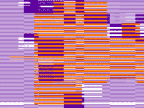
the body digital
vague terrain 04: the body digital is now live. The Fourth issue of the Toronto based digital arts quarterly is dedicated to surveying contemporary conceptions of the body in light of digital technology. This issue features work from: Andrea Polli, Andrew Bucksbarg, Chris Twomey, Ellen Waterman, Jenny Mason, Skyapnea, Suguro Goto, Susanna Hood, Testroom, and an interview with Stelarc conducted by David McCallum. Stay tuned for the launch of the vaguecast podcast in the coming weeks. -- greg smith & neil wiernik, editors/curators, http://www.vagueterrain.net.
Posted by jo at 12:53 PM | Comments (0)
ANAT Wearables Media Lab

reSkin
New facilitators confirmed for ANAT Wearables Media Lab January 15 - February 4, 2007 :: Australian National University, Canberra :: SUSAN COHN (Australia), NIKITA PASHENKOV (USA), CINNAMON LEE (Australia) and STEPHEN BARRASS (Australia) have been confirmed as facilitators for the reSkin Media Lab, to be held in Canberra, January 2007. They join the previously announced team of renowned media artists ELISE CO (USA), JOANNA BERZOWSKA (Canada) and ALISTAIR RIDDELL (Australia).
Facilitators will be working with artists to research, develop and rapid prototype sensor, time based and reactive clothing, jewellery, shoes, bags, personal environmental and device designs - anything wearable and technologically integrated. ANAT has a limited number of scholarships for participants and funding is also available through the state based arts funding bodies.
About reSkin: reSkin is an intensive three-week workshop focussing on wearable technology, embracing the skill-based practices of object, jewellery, fashion design and media art. The Lab will focus on research and development, experimentation, collaboration and project development.
How to Apply: reSkin is open to Australian and International artists and designers with at least 3 years of practice in the fields of jewellery and object design, textile design, fashion design, media arts, hybrid art and other related disciplines. Application guidelines including further details on the Lab, facilitators, and public outcomes can be downloaded from the reSkin website.
Applications close Monday 9th October.
SUSAN COHN is an internationally known goldsmith and designer who has exhibited extensively and is represented in all major Australian gallery collections. Her many accomplishments include being the first Australian to have a product manufactured by Alessi. In 2001-2003 the National Gallery of Australia celebrated her work with a touring survey exhibition.
Born in the former Soviet Union, NIKITA PASHENKOV has lived in the USA since 1991, where he earnt degrees from Princeton and MIT. He worked with the Aesthetics & Computations Group in the MIT Media Laboratory before moving to live in Tokyo for 2 years where he won the 2001 Tokyo TDC Award for Interactive Design. Nikita's work investigates the intersections between design, programming and electronics technology and has featured in exhibitions at MoMA (New York), Institute of Contemporary Art (London), Eyebeam (New York) and Ginza Gallery (Tokyo).
The work of metalsmith CINNAMON LEE focuses on the relationship between the body and object through interaction. She uses a range of traditional skills and new processes, most recently working with electric illumination and rapid prototyping.
STEPHEN BARRASS is Associate Professor in the School of Creative Communication and co-Director of the Sonic Communications Research Group at the University of Canberra. His artistic works include animated couches, haptic poems, edible soundscapes, virtual opshops, symphonic sculptures and a brain concert.
Further information:
Alexandra Gillespie
Project Manager reSkin
ANAT Media Arts Lab 2006
Email: alexandra[at]anat.org.au
Melinda Rackham
ANAT Executive Director
Tel: (08) 8231 9037
Email: melinda[at]anat.org.au
The ANAT New Media Lab 2006 reSkin is supported by the Visual Arts and Craft Strategy, an initiative of the Australian, State and Territory Governments. reSkin project partners are Australian National University School of Art, Centre for New Media Arts (ANU), Australian National Museum and Craft Australia.
Posted by jo at 12:24 PM | Comments (0)
Interactive Digital Cinema Workshop

Call for Participation
Call for Participation :: Interactive Digital Cinema Workshop :: ZKM, Karlsruhe :: October 19 October 25 2006.
Besides effecting production, distribution and projection technologies and procedures the rollout of digital cinema will enable interactive experiences in cinemas even without further major financial investments.
During this intense 5 day-workshop participants will explore the potential for new interactive film theatre experiences starting with a look back at early interactive cinema projects and building on advances in interactive technologies and media usage. (keywords: multi-user <> single location/several networked locations, live-gaming, VJing, machinima, group-interaction, live cinema, databased narratives, ad-hoc customization of content, live audience participation, expanded cinema, d-cinema-alternate content...)
Sagasnet workshops are aiming in the first place at professionals (developers, writers, producers, designers, programmers, artists, researchers...) coming from MEDIA member countries. Applicants coming from other countries please contact the sagasnet office for details.
Application forms: www.sagas.de
There is a limited budget for scholarships available.
Interactive Digital Cinema Workshop
Preliminary Timetable
Thursday, October 19 2006
Arrival
7.00 p.m. Meet & Greet
Friday, October 20 2006
9.15 a.m. Brunhild Bushoff (sagasnet)
Opening Speech
9.30 a.m. Greg Roach :: Introductionary Session Part 1: Identifying the opportunity.
How digital projection, next generation platforms and the growing pervasiveness of interactivity are combining to create a unique, new opportunity for filmmakers. What separates digital interactive cinema from games, interactive narrative or other forms of new media. The overview will then be followed by a detailed examination of Sony's failed InterFilm project. We'll also look at a brief overview of interactive cinema in general and examine the range of expectations audiences are likely to bring to the genre.
11.00 a.m. Chris Hales :: Kinoautomat Rediscovered
This presentation will explain and contextualise the world's first interactive film system, Kinoautomat, which ran for several hundred performances at the Expo'67 in Montreal. Created in Czechoslovakia as the brainchild of Raduz Cincera, the film¹s seminal interaction and narrative scheme has been much discussed in the academic literature - despite the fact that it had never been publicly performed since 1974. Interactive cinema was most certainly kick-started by the Kinoautomat, even though it predated the use of digital technology (it was shot on film and shown using synchronised projectors). Although Mr Cincera himself died a few years ago, I have conducted research in Prague in collaboration with his eldest daughter to author an interactive DVD using the original material of the film (which was actually entitled "A Man and his House") and have edited a book of 120 pages around the subject of Kinoautomat. Additionally, in February 2006 a Œlive¹ screening was produced at the National Film Theatre in London. The presentation will include a run-through of the DVD. www.kinoautomat.org
12.30 a.m. LUNCH
2.00 p.m. Greg Roach: Introductionary Session Part 2: Possible Modes of Interaction
How might the audience effect and alter the experience? Narrative forms, aesthetic variance and different ways to compute the results of audience choice. Media forms in interactive cinema: film, video and real-time 3D. The implications of media choices on both emotion and interaction. A detailed look at Volumetric Cinematography and it's implications for interactive cinema. Playback engines: from high-end PCs to XBox, xServe, HD DVD, Blu-Ray and PS3 - the choice of platform is more powerful and robust then ever before. How do you know which to choose? The problems of group interaction: input forms (gesture, sounds, buttons, etc), interface constraints, user feedback techniques, signal-to-noise. The tyranny of the majority. Basic production overview: how do you go about combining film making and computer software design?
4.00 p.m. Greg Roach: First Brainstorming Session with assignment for exercise
Saturday, October 21 2006
9.30 a.m. Greg Roach: Presentation and discussion of exercise results
11.00 a.m. Chris Hales
Interactive Film Performance, based on the experience of "Cause and Effect". Since 2002 I have been creating interactive movies specifically for "live" performance to large groups, and have taught numerous workshops from which additional films have been created. This hour-long show will present a variety of these films, each of which can be affected by the audience in a different way, for example audio frequency detection or the video-tracking of a bright light. Most of the films fit into the existing repertoire of "Cause and Effect", a collaboration between myself and Teijo Pellinen, which has performed almost thirty live shows at various venues and events in Europe and North America and from which important experience has been gained. www.causeandeffect.tk
12.30 a.m. LUNCH
2.00 p.m. . Friedrich Kirschner
Using Realtime Engines and Machinima for Audience Participation The Session will introduce the machinima approach of creating live performances with audience interaction - using game engines to produce realtime content that can react to audience participation in a wide variety of ways. Examples and demonstrations will illustrate basic approaches to use this new way of animated filmmaking in a performative context.
4.00 p.m. Greg Roach/ Tom Klinkowstein: Second Brainstorming Session followed by group work sessions
Sunday, October 22 2006
Horizon Projects Workshop
Horizon Projects are proposals for the future created to gain fresh perspective on current creative undertakings. This workshop employs the Horizon Projects premise as a tool to imagine new forms, locations and themes for the interactive cinema concepts already created to that point in the larger workshop.
9.15 a.m. Tom Klinkowstein: Introduction, teams formed, teams work ...
12:00 a.m. Tom Klinkowstein
Proposal presentations by teams from the perspective of the Future Frame of Reference, followed by discussion/ feedback from the other members of the workshop.
1:15 p.m. Lunch
2:15 p.m. Tom Klinkowstein: Proposal presentations continued ...
3.15 p.m. Tom Klinkowstein: Team work sessions
5.00 p.m. Tom Klinkowstein
Presentations with iterated proposals based on morning feedback and suggestions on how what is being proposed for the future might be adapted to current conditions. Wrap-up discussion.
Monday, October 23 2006
9.15 a.m. Greg Roach
Final team formation and reconsidering concepts on the basis of brainstorming and Horizon workshop results, Assignment for building a (paper) prototype Mentored group work session.
12.30 a.m. LUNCH
1.30 p.m. Greg Roach: Mentored group work session
3.00 p.m. Greg Roach: Testing and feed-back
Tuesday, October 24 2006
9.15 a.m. Greg Roach: Mentored group work session; Preparing for final concept presentation.
12.30 a.m. LUNCH
2.00 p.m. Greg Roach: Final concept presentation, discussion and overall evaluation
Wednesday, October 25 2006
Departure
BIOS
Christopher Hales: Artist and researcher specialising in interactive film and video, based in the Smartlab’ research centre of the University of East London. Taught many years in art/design with computers, and studied MA Interactive Multimedia at the Royal College of Art, London. His PhD "Rethinking the Interactive Movie" is due for completion in October 2006. His cdroms were selected at numerous film/multimedia festivals, and his touch-screen installation (showing a dozen or more films) was presented in Seoul, Helsinki, Warsaw, Nagoya, San Francisco and Sydney (amongst other places) and was included in the 2003 "Future Cinema" exhibition curated by the ZKM. He writes frequently about "interactive moving image", has taught over 80 short workshop courses on this subject in numerous institutions in Europe, and is a regular speaker at international events. Recent projects include "Cause and Effect", an experimental interactive cinema performance staged with Finnish colleagues, and a research project in Prague to rediscover the "Kinoautomat" from 1967 - the world's first interactive movie. www.kinoautomat.org www.causeandeffect.tk www.smartlab.uk.com
Friedrich Kirschner is a filmmaker, visual artist and board member of the Academy of Machinima Arts and Sciences. He recently worked as a senior researcher at the Ars Electronica Futurelab in Linz. He re-purposes computer games to create animated narratives and interactive performances. His award-winning work has been shown at various international animation festivals and exhibitions, including the ZKM Karlsruhe, the American Museum of the Moving Image, the Ottawa international Animation festival and the Künstlerhaus in Vienna. He also publishes machinimag, an online magazine focussing on the development of the emerging art form of machinima moviemaking. www.zeitbrand.net friedrich.kirschner[at]zeitbrand.net
Tom Klinkowstein is President and Creative Director of Media A, LLC, an internationally recognized design and consulting group with clients such as NASA, Reuters, the Ford Foundation, Jazz at Lincoln Center, Nissan and Japan Airlines. He has spoken to over 100 art, design, business, political and academic groups, including the United Nations Conference on the Information Society, the Smithsonian Institute's Cooper Hewett Museum of Art and Design, the McLuhan Program in Culture and Technology at the University of Toronto, the Industrial Design Centre at the Indian Institute of Technology in Mumbai and the Dutch Design Institute¹s, Doors of Perception conference. Klinkowstein previously was a professor at the West Brabant Art and Design College in the Netherlands and since 2000, an Associate Professor of New Media at Hofstra University on Long Island. He is also an Adjunct Professor at Pratt Institute of Art and Design in New York City. His work has been shown in art centers, museums and galleries throughout the world, including the Centre Pompidou in Paris and the Venice Biennale in Venice, Italy. Mr. Klinkowstein¹s work also can be found in the archive of the Foundation for the Conservation of Contemporary Art in The Netherlands.
Greg Roach, M.F.A., is the CEO and Artistic Director of HyperBole Studios, which he founded in 1990. For nearly fifteen years Roach has been recognized as a worldwide leader in the field of interactive film, video and storytelling. His company, HyperBole Studios, explores interactive multimedia as a new artistic and cinematic form. In 1990, Roach´s first effort was the creation of an online, interactive digizine - years ahead of the internet explosion. During the two years he published HyperBole magazine, he designed, wrote and produced the world's first interactive, multimedia novel. The Madness of Roland, one of the first non-reference CD-ROM's, which was published to great acclaim. While finishing work on Roland, Greg also wrote, produced and directed a short interactive film called The Wrong Side of Town, a work that the American Film Institute considers to be the "first interactive narrative film." With these two milestones under his belt, Greg began work on Quantum Gate, the industry's first full-length interactive movie, and the first product to use his newly conceived VirtualCinema technology. His first six years in business culminated when Fox approached him and asked him to helm the much sought after X-Files game. Upon its release The X-Files Game exceeded all expectations, premiering at number one in nearly every territory where it was released, and going on to sell over a million copies worldwide. Currently he is primarily focused on the DVD and wireless platforms. The ROM applications which he designed for "The Terminator 2: Extreme" DVD won an IRMA award for best DVD ROM. He is currently working on several DVD and wireless projects for major publishers. Recently, he presented a paper entitled "Imagine Places: Distributed Telepresence Installations for Creating Immersive Historical Reconstructions" at the UNESCO "World Heritage in the Digital Age" conference held in Alexandria, Egypt.
sagasnet
Bavariafilmplatz 7
D-82031 Muenchen-Gruenwald
tel: + 49 89 64 98 11 29 /30
fax: + 49 89 64 98 13 29/30
mobile: + 49 (0) 171 45 28 0 52
URL: http://www.sagasnet.de :: http://www.sagas.de
e-mail sagasnet[at]sagasnet.de :: sagas[at]sagas.de
Skype: brunhildbushoff
sagasnet is a non profit initiative to further interactive content creation in the frame of the MEDIA Programme TRAINING .
Posted by jo at 09:57 AM | Comments (0)
Marco Villani
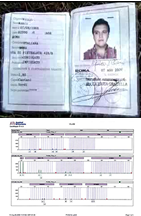
This is a net.art operation
Marco Villani's DNA has been analysed by the Forensic Science Laboratory of the University of Genova for identification purposes. Today, Villani will conduct a Net.art operation: he will put the results of his DNA profile online for people to download together with a text. Please e-mail him at info[at]marcovillani.net with your response; use "Dna on the net" in the subject line. Your comments will be posted on the site.
Also on the site is a video about the analysis of Villani's DNA with an interview to Doctor Simonetta Verdiani (on the site will be a little trailer).
This is an investigation into the concept of “Biopolitics” coined by the French philosopher Michel Foucault. It is a category which analyses the profound relationships that link the individual to power. This kind of link is based on a system of permanent reading of the subject in which science and technology converge. Every subject is a never-ending source of data which makes up an archive of knowledge through which it is possible to organise social behaviours. The topics range from demographics to psychology, psycho-attitudinal tests and medical tests.
HANGING ON A THREAD OF REALITY
Identity is the essence of a relationship, in which symbolic and biological systems and existential orbits tackling life’s complexities converge. The attractive pole around which these systems rotate is the subject, the termination declined according to the group of social-linguistic practices that form his or her ecological niche and take possession of the inner system. This process of appropriation is the place in which an individual is formed, in keeping with a social image. The desires that pulse in the body and the sadness that flows through it reside in the linguistic flows that are rooted within in his or her experience.
There’s no escape route towards an authenticity which isn’t an expression of the ability to decide, decided within the form of language. Strength works directly at primitive and unconscious level so that man perceives his inner qualities as natural as opposed to derived. But Self is a relationship. And it is from this characteristic that the possibility to communicate and receive communication germinates in bios, along with the possibility to be organised and dominated in keeping with the political ideas that man has expressed in the ages that have succeeded one another on the earth.
Biopolitics is the term used by Michel Foucault to describe this relationship. It indicates the dynamics through which the subject is possessed by the codes he or she has learned in order to observe the silence of things. These codes, added to the technical apparatus with which men surround themselves, are the shape taken on by collective behaviour.
The filing of the body and the analysis of the attitudes imprinted permanently on the individual by science, technique and jurisprudence, make up a technological device which allows the objectification of the subject in a complex combination of information, making social use possible.
This is possible because language acts as a code for the programming of behaviour and perception and its use by the subject as a model of cosmos does not fall within the scope of choice. It precedes choice in the same way that the fact that we are born with a body, two eyes, our own DNA and everything else precede choice. It isn’t possible to make a clear division between the biological level and linguistic level. There are numerous nuances that highlight how the linguistic aspect contains a biological residue and how the biological aspect contains a linguistic form. The Hopi tribes of New Mexico use a single term to describe blue and green together. This implies that their nervous perception identifies a single linguistic phenomenon, while our culture identifies two. In the same way, the Eskimos use twenty different words to say “white”.
Both of these dimensions are certain elements.
So is there a point of escape towards freedom? Towards choice?
This place is still the subject. The dimension of subjection to language and to the body as certain is realised within it, along with the possibility for criticism, which is born of the conjuncture with experience. It is here that language is exposed to the heterogeneous influence. And it is here that particles of entropy and desires collide with it, envelop it and cross it.
The inner dynamics of this process remain bio-linguistic, as there is no linguistic nudity. The reality we take possession of and which takes possession of us is, in any case, the result of a process of mediation implemented by a nervous system, whether it is linguistic, organic or both.
The profound structure that makes this kind of system possible is the fact that all things are part of a relationship. And this is the relationship between the already experienced aspect of language and the live experience of self, the original condition of the individual. A perpetual condition of crossing, of moving beyond, which is simply another way of staying put.
In this being constantly on the edge humanity becomes aware that it doesn’t have to realise any essence or substance or historical destiny. The apparatus that captivate it are always the ideological result of an historical conjuncture that carries individual and collective destinies within.
But destiny, seen from here, is a union of particles and, as such, has a place, a time and a body, which make it constantly up to date compared with all the magnetic flows which exercise their attraction upon it. This being up to date is the gap that blends the possibility of criticism and ethic experience.
Marco Villani, 2006
Posted by jo at 08:09 AM | Comments (0)
Temporary Travel Office

Irregular Update
The Temporary Travel Office irregular update:
1. The TTO was invited to present our 2004-5 audio tour of the Chicago Technology Park, a self-guided exploration of spatial eugenics in Chicago's Near West Side, in MAPQUEST, an exhibition at PS122 in Manhattan, NY.
Details: Exhibiton on view from September 16 – October 9, 2006 at PS122Gallery, NY. :: Works by: Lize Mogel and Dario Azzellini - Daniel Blochwitz - Cartographic Perspectives: Map Art - Center for Urban Pedagogy (with Eric Schuldenfrei, Marisa Yiu, and Rosten Woo- Ewen Chardronnet - The Friends of William Blake- Elise Gardella - Ryan Griffis/Temporary Travel Office - Ashley Hunt - Lasse Lau - Nadxieli Mannello - Carlos Motta- Sarah Ross - Gregory Sholette - curator Elena Sorokina.
Mapquest brings together work by artists, activists, writers and organizers, involved in experimentation with critical and dissident cartography. The exhibition examines various mapping strategies employed as response to specific social and political issues. Working not unlike investigative journalists, some participants conduct and map in-depth research of themes such as the functioning of private military contractors or recruitment centers. Others design maps as tools, featuring information that can be used to support for social action. In a similar vein they employ mapping strategies to produce alternative knowledge about networks of power and control in urban spaces.
The exhibition ran from September 17 through October 9, 2006 at PS122 Gallery, New York.
Acknowledgements to Benj Gerdes and Daniel Tucker.
2. For the Conflux 2006 conference/festival of psychogeography, the Travel Office led a Parking Public bus tour (actually, a 12 passenger van) through downtown Brooklyn during a rainy rush hour. Parking Public is an ongoing series of tours and investigations into the mechanics and politics of parking lots in the United States. Despite the negative conditions, the van was full. Sites included the Grant Ave. Municipal Parking Field in east Brooklyn, an Edison Properties surface lot, and the BAM Local Development Corporation's South Site (a former city owned parking lot now the future site of a Frank Gehry designed theater).
A text summarizing the research (titled: Public Parking Revisited: The Storage of Utopia), with some specific emphasis on Brooklyn is now available online as part of Glowlab's 10th issue of their regular publication. http://glowlab.com/lab2/issue.php?project_id=143&issue_name=13
3. COMING SOON! The Parking Public project will soon have a self-guided audio tour for each of the four completed locations (Downtown Los Angeles,CA; Hollywood, CA; Champaign, IL; Brooklyn, NY) and video document. http://temporarytraveloffice.net/hollywood/parking.html
Thanks for your attention.
Let us take you somewhere,
visit the Temporary Travel Office online http://www.temporarytraveloffice.net
Posted by jo at 08:01 AM | Comments (0)
September 25, 2006
Aya Natalia Karpinska
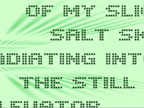
nobody knows but you + interview
nobody knows but you was written for Double-Cute Battle Mode, an application prototype for a VJ (video jockey) remix battle. DCBM allows two players to combine visuals and special effects in a playful competition for screen space. Using joysticks, players plug their imagination into their computer and share a creative space in an intuitive video-game style interaction. The piece was conceived as a way to ease text back into an image-dominated culture by treating it simultaneously as a visual special effect and as a poem.
The twenty-three verses appear on a plane in three-dimensional space. A cube shape displays additional visuals. Both the cube and the plane may be scaled and rotated, and the reader has control over which verse or image is displayed.
You may notice in the image at top left, or while watching the documentation video, a twelve-year-old girl plopped down in front of the installation. She played with the piece on and off for three hours. She began singing the words, making up melodies and turning certain verses into refrains. There is a clear lack of literature that responds to the intellectual and creative needs of young people today. I hope that interactive writing can help to fill that gap.
The original DCBM program was created with Carlos J. Gómez de Llarena.
- Aya Natalia Karpinska, Fall 2005
An Interview with Aya Karpinska on “mar puro” by Rita Raley, Iowa Review, v8 n3 September 2006
RR: How would you characterize your current work in three dimensional text and/or spatial poetry?
AK: This interview comes at an interesting time, when I am having serious doubts about pursuing spatial poetry, at least in the way I have approached it in the past. For one thing, a screen is a screen. It’s not space. The computer screen is a powerful interface, but I believe we are conforming to its demands as users, and not the other way around. I’m looking forward to exploring technology in physical spaces, where people are out and about living their lives. One technology that comes to mind is the mobile phone, which has already surpassed the computer as the digital device of choice for much of the world. Our spatial knowledge comes, of course, from physical space. Now we are out in space with a mini-computer in our pockets. But back to your questions…
RR: This is a general question, but would you be willing to speculate about the significance of the word or letter’s becoming three-dimensional? About what difference it might make for poetry, current paradigms of reading, our understanding of text? What do you find yourself able to achieve that was not possible with previous reading and writing technologies?
AK: With digital screen-based text, one thing that still intrigues me is overlapping. With mar puro and most of my other 3D poems, motion and interaction combine different parts of the text. You can create spontaneous relationships among the words, both as the author and as the reader. I could perhaps achieve a similar effect by printing on transparent sheets and instructing readers on how to move the sheets around, but that is cumbersome. The experience of the digital version is smoother.
As for an effect on current paradigms of reading… this is an important question. How are we going to engage younger audiences that grew up with video games and texting and surfing the Web? With a recent piece of mine, nobody knows but you, I wanted to answer that question by creating a space for readers to perform the text. I essentially placed text on the same level as image, and the reader can manipulate the size and position of each, like a VJ (video jockey). This is certainly not something I intend a reader to curl up with in bed – it’s designed for a club environment or similar social space. Mashing together multimedia and text can make the experience of reading more playful. In John R. Kelly’s concept of play, he emphasizes how we go about it, not just what we do. This is where interactivity comes in, the “how.”
Posted by jo at 07:13 PM | Comments (0)
WJ-s

Web Performances in Real Space
WJ-s web performances in real space in Maribor and Ljubljana, Slovenia :: September 26th - 30th 2006.
Satellite Night Fever :: live WJ-s performance by Davide Grassi, Aksioma: Traveling around the world does not start and does not end at home. In between there is a planet which is a window into the world. In 365 megabytes with software around the world.
RoboMarseillaise :: live WJ-s performance by Igor Stromajer, Intima Virtual Base: Historical facts are constructed fiction and fictive construction. History is written by winners, facts are written by artists.
# performances: Maribor: Gallery KiBela, Tuesday September 26th 2006 at 9 PM; Ljubljana: Cyberpipe, Friday, September 29th 2006 at 9 PM Admission free.
# open workshops: Maribor: Gallery KiBela, Wednesday, September 27th 2006 from 11 AM until 2 PM, Ljubljana: Cyberpipe, Saturday, September 30th 2006 from 11 AM until 2 PM, Practical artistic workshop on WJ-s software, lead by Anne Roquigny in collaboration with Stéphane Kyles. Admission free.
Concept: Anne Roquigny, new media curator, France
Programming WJ-s/oftware: Stéphane Kyles, artist / programmer, France Web performers in real space: Davide Grassi (Satellite Night Fever) and Igor Stromajer (RoboMarseillaise), Slovenia
Co-produced by Intima Virtual Base - Institute for Contemporary Arts Multimedia Center KIBLA, MAribor Aksioma - Institute for Contemporary Arts, Ljubljana.
Partner: Multimedia Center Cyberpipe / Kiberpipa, Ljubljana
Co-financed by The Ministry of Culture of the Republic of Slovenia, Municipality of Ljubljana and Institut Français Charles Nodier, Ljubljana.
# information in Slovenian language: http://www.wj-s.org/Maribor-Ljubljana
# information in English and French: http://www.wj-s.org
"WJ-s" is a software and a flexible, high speed connexion public device for web performances which allows actors of the Internet, webjockeys, sound and image artists, netartists, bloggers, graphic designers, flashers, programmers, curators, hacktivists, new media theorists, pioneers and web mutants... to play live with the full scope of contents available in the wideness of the web.
About the authors:
Davide Grassi is a media artist, performer and producer of Italian origins working and living in Ljubljana since 1995. His artistic work has a strong social connotation and is characterized by an inter-media approach. Grassi is the author of numerous videos, performances, installations, documentaries and media projects. Among them I Need Money to Be an Artist, Brainscore (with Darij Kreuh), Problemarket - the Problem Stock Exchange (with Igor Stromajer), machinaZOIS and DemoKino.
Igor Stromajer is an intimate mobile communicator. He researches tactical emotional states and traumatic low-tech strategies. He has shown his work at more than a hundred exhibitions in forty-two countries and received a number of awards. His works are included in the permanent collections of the Centre Georges Pompidou, Paris; the Museo Nacional Centro de Arte Reina Sofía, Madrid; Moderna galerija Ljubljana, Slovenia; Computerfinearts Gallery, New York and others.
Posted by jo at 05:44 PM | Comments (0)
Antoine Schmitt & Jean-Jacques Birgé
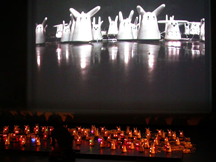
Nabaz'Mob: an opera
Atari is happy to present Nabaz'Mob: an opera for 100 communicating rabbits by Antoine Schmitt & Jean-Jacques Birgé featuring Nabaztag by violet.
Installation http://nabazmob.free.fr/ from September 27th to October 1st 2006 during Wired Magazine's nextfest at Atari Showroom Javits Center, HALL 3B, Chelsea, NY.
100 Nabaztag meet at Javits Center to all play together an opera specially composed by Antoine Schmitt and Jean-Jacques Birgé after an original idea by Guylaine Monnier. Inviting John Cage, Steve Reich, Conlon Nancarrow and György Ligeti, this musical and choreographic partition in three movements, transmitted via wi-fi, plays on the tension between the music ensemble communion and individual behavior to create a strong and involved showpiece.
Posted by jo at 05:30 PM | Comments (0)
ARCHITECTURE AND SITUATED TECHNOLOGIES
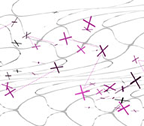
A 3-Day Symposium
The Center for Virtual Architecture at the University at Buffalo, the Institute for Distributed Creativity, and The Architectural League of New York present: ARCHITECTURE AND SITUATED TECHNOLOGIES :: October 19-21, 2006 @ The Urban Center & Eyebeam, New York City.
A 3-day symposium bringing together researchers and practitioners from art, architecture, technology and sociology to explore the emerging role of "situated" technologies in the design and inhabitation of the contemporary metapolis. Organized by Omar Khan, Trebor Scholz, and Mark Shepard :: Participants: Jonah Brucker-Cohen, Richard Coyne, Michael Fox, Anne Galloway, Charlie Gere, Usman Haque, Natalie Jeremijenko, Sheila Kennedy, Eric Paulos, Karmen Franinovic, Mette Ramsgard Thomsen, Kazys Varnelis :: Contact: Jessica Blaustein - blaustein[at]league.org
Since the late 1980s, computer scientists and engineers have been researching ways of embedding computational intelligence into the built environment. Looking beyond the model of personal computing, which placed the computer in the foreground of our attention, "ubiquitous" computing takes into account the social dimension of human environments and allows computers themselves to vanish into the background. No longer solely virtual, human interaction with computers becomes socially integrated and spatially contingent as everyday objects and spaces are linked through networked computing.
Today, researchers focus on how situational parameters inform the design of a wide range of mobile, wearable, networked, distributed and context-aware devices. Incorporating an awareness of cultural context, accrued social meanings, and the temporality of spatial experience, situated technologies privilege the local, context-specific and spatially contingent dimension of their use.
Despite the obvious implications for the built environment, architects have been largely absent from this discussion, and technologists have been limited to developing technologies that take existing architectural topographies as a given context to be augmented.
At the same time, to the extent that early adopters of these technologies have focused on commercial, military and law enforcement applications, we can expect to see new forms of consumption, warfare and control emerge.
This symposium seeks to occupy the imaginary of these emerging technologies and propose alternate trajectories for their development.
What opportunities and dilemmas does a world of networked "things" pose for architecture and urbanism? What distinguishes the emerging urban sociality enabled by mobile technologies and wireless networks? What post-optimal design strategies and tactics might we propose for an age of responsive environments, smart materials, embodied interactions, and participatory networks? How might this evolving relation between people and "things" alter the way we occupy, navigate, and inhabit the city? What is the status of the material object in a world privileging networked relations between "things"? How do distinctions between space and place change within these networked media ecologies? How do the social uses of these technologies, including (non-) affective giving, destabilize rationalized "use-case scenarios" designed around the generic consumer?
Through a combination of presentations, discussions, and performative design scenarios organized around the notion of "encounter" with the city, this symposium will explore how architecture might contribute to the development of situated technologies, and how a critical engagement with these technologies might extend architecture beyond itself.
+++
Architecture and Situated Technologies is a co-production of the Center for Virtual Architecture, The Institute for Distributed Creativity, and the Architectural League of New York, as part of the League's celebration of the 125th anniversary of its founding.
Architecture and Situated Technologies is supported by the J. Clawson Mills Fund of the Architectural League and is supported in part by the School of Architecture and Planning and the Department of Media Study at the University at Buffalo.
+++
The Center for Virtual Architecture at the University at Buffalo
The Center for Virtual Architecture' research is ocated at the intersection of architecture, new media and computational technologies. We are interested in the possibilities offered by computational systems for rethinking human interaction with (and within) the built environment. Our focus areas include learning environments, design environments, responsive architecture and locative media. Computational technology provides both a means and a medium for this research: an operative paradigm for conceptualizing relations between people, information, and the material fabric of everyday life.
The Institute for Distributed Creativity
The research of the Institute for Distributed Creativity (iDC) focuses on sociable media and media theory with an emphasis on social justice. Its mailing list is a vivid discoursive platform for the social implications of emerging forms of networked sociality. The iDC is an international network that combines collaborative research, events, and documentation.
The Architectural League of New York
The Architectural League of New York is an independent forum for the
presentation and discussion of creative and intellectual work in architecture, urbanism, and related design disciplines. Founded in 1881, the League promotes excellence and innovation in architecture and urbanism by furthering the education of architects and designers, and by communicating to a broad audience the importance of architecture in public life. Through an active schedule of programs, the League provides a venue for contemporary work and ideas, identifies and encourages the work of talented young architects, creates opportunities for exploring new approaches to problems in the built environment, and fosters a stimulating community for dialogue and debate. All of the League¹s work is shaped by its ongoing commitment to interdisciplinary, intergenerational, and international exchange, and by its concern for the quality of architecture and city form as critical components of a vital and dynamic culture.
Posted by jo at 05:22 PM | Comments (0)
Knowbotic Research
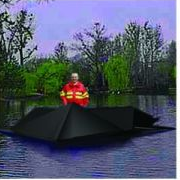
Room for Manoeuvre
Galerija Skuc, Ljubljana, October 5 - 27, 2006 :: Knowbotic Research - Room for Manoeuvre; four vehicles: white_sovereign, passion_cleaner, tiger_stealth, blackbenz :: Exhibition opening: Thursday, October 5, 2006, 20.00 h.
The exhibition 'Room for Manoeuvre' is the new solo-show of the artist group Knowbotic Research (KRcF), known for their advanced network and media works since the founding of the group in 1991. In a specially designed audio-visual installation including four video projections, 'Room for Manoeuvre' presents four of the 'vehicles' that Knowbotic Research have developed for their current projects, and places these vehicles in a series of hypothetical scenarios. The exhibition explores the meaning of codes and actions in public spaces. It proposes possibilities for acting through strategies of transcoding in these spaces of power, of scientific knowledge, of surveillance, and spaces of migration. Going beyond these possibilities, the show suggests to the audience that such 'vehicles' might in fact be used for other, self-designed strategic purposes.
The projects “naked bandit / here, not her / white bandit" (2004/05), “Passion 5" (2005), “be prepared! tiger!" (2006) and “BlackBenz Race" (2006-) use different vehicles to act as catalysts for such transcodings: in the first case it is an autonomous flying robot which produces technologically coded forms of sovereignty under the conditions of a (university) research laboratory; in the second case, a street cleaning machine clears up the petrified political passions of a May demonstration; the amateur-built stealth boat, invisible for radar, processes the intercultural translations between the US stealth bomber and the tactical speedboats of the Tamil Tigers; and in a car race, a caravan of black Mercedes cars traverses the translocal conditions of the Albanian space of migration. The term transcoding describes the translation of abstract facts and conditions which usually evade public representation, into temporary visibilities that can be dealt with. These facts cannot be described by simple representations in clearly defined, local contexts, but require networked scenarios within which they can be reflected and acted upon.
In the exhibition, some original vehicles (white_sovereign, tiger_stealth) are on display, as well as the 'Adaption KITs' with which normal vehicles can be transformed into passion_cleaners and blackbenz. The atmospheric and metaphorically rich short film loops. They are projected in four separate rooms of the gallery, each showing one of the vehicles in action, pointing to potential applications that they can be put to. Brochures and printed tableaus offer information about the vehicles in the form of manuals through which their usages can be further explored. A specially designed sound environment developed together with Roly Roos and Joana Aderi traverses the entire gallery and sends echoes and acoustic reverberations of the different projects through the exhibition space.
The text publication accompanying the exhibition includes essays by Andreas Broeckmann, Stefan Riekeles, Giaco Schiesser, Sabine Schmidt, Felix Stalder, Stefan Wagner, and Knowbotic Research.
Exhibition by Knowbotic Research (Christian Hübler, Alexander Tuchacek, Yvonne Wilhelm) in collaboration with Simon Jaquemet, Roly Roos, Joana Aderi, Peter Sandbichler, Yannick Fournier.
Curated by: Andreas Broeckmann and Stefan Riekeles (assistant)
Production: Skuc Gallery in cooperation with Knowbotic Research More about the group: http://www.krcf.org
Supported by Bundesamt für Kultur BAK - sitemapping, Pro Helvetia, Kunst Öffentlichkeit Zürich, 'PubliCity' - 29. Duisburger Akzente, Kulturforum der Österreichischen Botschaft Laibach.
The programme of Skuc Gallery is funded by the Ministry of Culture of the Republic of Slovenia and the Cultural Department of the City of Ljubljana.
Galerija Skuc - Stari trg 21 - 1000 Ljubljana - T: +386 1 251 65 40 -
http://www.galerija.skuc-drustvo.si
Posted by jo at 04:50 PM | Comments (0)
Robert Ladislas Derr

Two Trace Articles
Chance: a psychogeographical walk performance
by Robert Ladislas Derr, Trace, 17/Jan/2006.
On Thursday, November 10, 2005, beginning at 7:00 pm, I embarked on one of my psychogeographical walk performances. The piece, titled Chance, exhibited at OPENSOURCE (an alternative art space within Champaign-Urbana, Illinois), as part of their exhibition program: Mind in Matter: Constructions of the Built Environment.
For this performance gallery viewers determined the direction of my walk based upon the roll of a dice. Waiting outside the gallery, I received my first command to 'spin' via a two-way radio. The dice indicated that I move forward, backwards, right, left, spin, or stand in place. When 'spin' or 'stand in place' were the command, I completed each for one minute. The directional commands took me to the next intersection, where I awaited another command. The walk continued for thirty minutes.
Just as in past performances, I wore a mirrored suit to allow my presence on the street to be real and illusionary, but this time I had four video cameras attached to my person, recording simultaneously the front, rear, and side views of my journey. Using the city as a fluid canvas, I moved through the streets in silence, capturing the ephemeral characters that constructed the ambiance of place and time. The videos were on display in the gallery, shown split screen.
To accentuate the dichotomy of the mirrored suit, there were two walls of mirrors in the gallery that created the cartography of the performance. Each of the six commands was represented by thirty columns of six mirrors - thirty columns for the thirty minutes of the walk. The gallery viewer rolled the dice and my assistant radioed to me the direction I must move.
Then, according to the time frame of the walk, the assistant removed the number of mirrors that corresponded to the command from the column that corresponded to the number of minutes into the performance, then hung the mirrors on an opposing wall. One wall created the cartography of the walk in the positive and the other in the negative. When the gallery viewer stood between the two walls of mirrors (that had an oscillating presence of real/illusionary, physical/metaphysical, inside/outside, and visible/invisible) the dichotomy of the cartography of the performance was highlighted.
In my psychogeographical walk performances, I am interested in the chance interaction between pedestrians and myself. However, in Chance, not only was interaction with pedestrians emphasized, but also interaction with gallery viewers. This was crucial for my progression. I relied on the viewers to determine the direction of my walk, subverting the traditional social structure of the gallery system that prefers viewers to be quiet observers. Without the viewers, I would have remained stationary for thirty minutes
Through my self-induced spectacle walk performances, I try to raise awareness of the individual in society. The concept of community is formed on the foundation of the importance of the individual. A community is strengthened by its cultural diversity; each individual resident plays an important role in creating the fabric of a city. Moving through the streets in Champaign, IL by rational and irrational means, walking in silence through the crowd, letting my cameras record, I captured an unedited glimpse of an unfolding drama. Just as Henri Cartier-Bresson captured his decisive moments with the photograph, my video cameras recorded many decisive moments in the framework of linear time, capturing the banality of existence between these moments.
View Quicktime movie clip provided for trAce by Robert Ladislas Derr. Please be patient while movie loads.
Editor's Note: article written in collaboration with Lynn Foglesong-Derr.
Robert Ladislas Derr has exhibited his artwork at museums, galleries, and festivals throughout the United States and abroad. Derr’s artwork has been reviewed by such publications as The New York Times, trAce Online Writing Centre, and Block Magazine. He has lectured about his artwork at such institutions as the Victoria Independent Film & Video Festival, Pre/amble: Festival of Art and Psychogeography, and Society for Photographic Education. Derr has been a recipient of a number of grants, fellowships, and awards including an Individual Artist Fellowship from the Ohio Arts Council and stipend from the Lower Manhattan Cultural Council (New York, NY). Combining photography and new media, his installations are derived through public and intersubjective performances. It can be said that he often times puts himself literally in the center of a barrage of questions about life and making art. Derr received his MFA from the Rhode Island School of Design and BFA from the Art Academy of Cincinnati. He is an assistant professor and coordinator of the photography area in the Department of Art at The Ohio State University.
Links
Robert Ladislas Derr:
http://www.portfolios.com/rlderr
OPENSOURCE:
http://opensource.boxwith.com
Henri Cartier-Bresson:
http://www.henricartierbresson.org
trAce links
VOID: walking with Ulysses:
http://trace.ntu.ac.uk/Review/index.cfm?article=132
Data and Narrative: Location Aware Fiction:
http://trace.ntu.ac.uk/Opinion/index.cfm?article=83
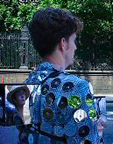
VOID: walking with Ulysses 1 by Susan Sakash, Trace, 23/Mar/2005.
A man, bedecked in a mirrored suit and wielding two video cameras strapped to his chest and back, moves in regulated sync with traffic signals and pedestrian flow through the city of Dublin. The mirrors place the man in a mobile aura of bouncing reflections. His gaze is fixated on the path in front of him; he does not make eye contact with the passersby who turn to stare after his receding figure. As his path abandons major tourist avenues, he is approached by a man who tries to engage him in conversation, saying that he is a reporter for a major Dublin newspaper. He is supposedly covering the Bloomsday activities and wants to know if this performance is part of the festival. The artist's gaze retains its focus on the intersection ahead. Mirrors do not speak back.
For four consecutive days in June of 2004, Robert Ladislas Derr engaged in VOID, a peripatetic performance, recording the dynamic movements of the city of Dublin via two video cameras mounted on his person. As Derr moved from the residential Mountjoy Square to McKenny bridge crossing the canal at Lower Mount Street, the cameras captured the reactions of fellow pedestrians as they alternated between observing and being observed. The video footage was subsequently shown later each day in a dual monitor installation at the Irish Film Institute in the Temple Bar Cultural Quarter of Dublin City Centre. Both the performative and documentary elements of VOID indicated Derr's desire to explore the conceptual duality of presence and absence, visibility and invisibility of the body's relationship to society.
VOID was one of 19 projects comprising the 2 week Wandering Rocks, Revolving Doors public art exhibition, part of the larger ReJoyce Dublin 2004 Festival celebrating the centenary of James Joyce's Ulysses. Each project evolved out of the artists' individual readings of Wandering Rocks, the 10th chapter of that book and one which is divided into 19 sections shaped by the actions and conversations of a number of minor characters as they wander through the streets of Dublin between the hours of 2:40 and 4:00pm on June 16, 1904. In recording these moments of minutiae, Joyce succeeded in creating a remarkable portrait of the city as it existed at the turn of the century.
Behind the conceptual underpinnings of the Wandering Rocks, Revolving Doors collective was my intention, as creative director and curator of the exhibition, to solicit public art works from an international network of artists that would propose new ways of interacting with Joyce and the city of Dublin in a fashion that still encouraged people to reflect on the movements and patterns of the city in both its historical and contemporary contexts. The event was situated somewhere outside the continuum that has seen the definition of public art move from the site-specific, static monuments of late modernism to the community-specific, socially engaged collaborations of the 90s. Built into Wandering Rocks, Revolving Doors conceptual framework was the idea that participating artists be relative strangers to the city of Dublin, familiar only with the city through Joyce's fictionalized descriptions. To respond to the city as depicted in Ulysses is to respond to a contemporary non-site, razed or buried beneath layers of urban regeneration.
Given the difficulty in defining a specific audience for this event and awareness on behalf of the artists that any attempts to create "community-specific" projects would be presumptive and inevitably isolate the very communities WrRd hoped to engage, artists adapted a variety of strategies. For VOID, Robert Ladislas Derr, whose video/performance pieces often echo the preoccupations of conceptual artists such as Vito Acconci and Lucas Samaras, sought to engage Guy Debord's "society of the spectacle." Rather than adopting the role of spectator, Derr attempted to become the spectacle himself. In Derr's own words:
Reflecting my surroundings, the mirrors created my void as I disappeared in the reflections from the city ... However, the reflections also created my presence ... the suit did more than emphasize my absence and presence, it made me a spectacle.
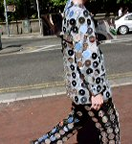
For Debord, the spectacle was "the autocratic reign of the market economy" and the colorful but empty gestures of those enlisted to divert attention from this accumulation of power. Correspondingly, Derr's suit of mirrors, dancing in the midday light, served to distract viewers from the subtly concealed video cameras he had installed inside mirrored boxes mounted from his shoulders. Like a media circus which reinforces the status quo it is meant to question, the actual spectacle of Derr's person is absent from the project's end product, namely the front and rear video footage recorded on his walks. Here, VOID becomes a subtle inversion of the domination of the spectacle: the ridiculous metaphor of the mirrored suit is but a means towards an end.
What is the end, then, that Derr had in mind? In pre and post event statements alike, Derr was preoccupied with the exploration of self through interaction and engagement with the other. He sought to render his own body as a kind of document of the city, exploring the patterns of habits and chance that lend shape to the specific life flow of a city. Again in Derr's words:
The walk becomes a study into psychogeography, where the geographic features of a city create similitude in daily life. The videos ... reflect my physical experience as I for example, step off the curb to cross the road at relatively the same time each day. My four-day repetitive walk mimics the routine of life.
Coinciding with the habitual patterns of city dwellers is the uncertainty of unanticipated encounters and discoveries: unknowns that add color and variety to our lives.
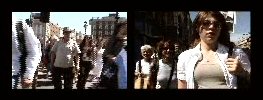
Derr's footage is testament to this interplay of repetition and surprise. As he travels the same route for four consecutive days at the same hour each day, the sights and basic patterns of the traffic may be similar but it is the particulars that demand attention. A man distractedly eating an apple at a traffic light, the impromptu dance performance of an overweight teen, a graphic oral display by a woman leaning out a pub - it is the "other" who replaces the artist as the director and actor of the unfolding drama. This celebration of minor characters, and the coincidence of habit and chance, emerge as central concerns for the artist, and were also omnipresent throughout Joyce's writing of Ulysses.
Derr's project, like many of the other participating components of WrRd, was careful to avoid responding to Joyce in a way that could be boiled down to mere mimicry of Ulysses. Specifically the path Derr chose to follow during VOID was not a literal retracing of any one character's travels during the Wandering Rocks chapter but rather a collection of movements and journeys. The parameters he set for himself before arriving in Dublin also allowed Derr's cameras to capture the contradictory elements of contemporary Dublin which lay subdued by the nostalgic, tourist-oriented, overtones of the ReJoyce Dublin festival. Rather, the footage poignantly evokes Guy Debord's call in his Introduction to Critique of Urban Geography for artists to observe:
... the sudden change of ambiance in a street within the space of a few meters; the evident division of a city into zones of distinct psychic atmospheres; the path of least resistance which is automatically followed in aimless strolls (and which has no relation to the physical contour of the ground); the appealing or repelling character of certain places.
It is interesting to note that, if we follow the ideological ambitions as set out by the psychogeographists, video art evolved as a reincarnation of their efforts to subvert spectacular displays of those in positions of power. Its affordability and accessibility as a recording device led video to be embraced by the early generation of video artists as a tool offering liberation via the imitation of society's habitual motions. The spectacle, they hoped, when turned back on itself, would implode.
At various stages throughout the development and realization of Derr's project, I was reminded of the ubiquitous presence of the closed circuit cameras that monitor public space throughout Dublin City Centre. Long a source of inspired indignation for multimedia artists, CCTVs' and their Big Brother associations, have proliferated in Dublin alongside the influx of capital and construction. Both CCTVs and the concealed cameras of VOID are to be viewed as tools of surveillance, their footage serving as archival documents. Closed circuit cameras are installed in static locations, meant to safeguard private property by recording the movements and actions of the unawares. While Derr's cameras were also recorders of the movements and actions of the unawares, their mobility canceled their effectiveness as agents of the spectacle.
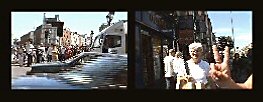
What differentiated Derr's surveillance technique from that of storeowners and city officials was that, in placing the cameras on his person, his surveillance of fellow pedestrians was no longer anonymous. Though the artist was physically absent on video, his authorial presence could always be intuited, evidenced in the faces and reactions of those recorded. Despite setting parameters, such as obeying all traffic symbols and refraining from conversation, to create the impression of objective documentation, Derr nevertheless produced a very human artwork.
Derr ended each day's performance of VOID on a small bridge crossing the lower canal. Solitary and stationary at last, the artist stood facing west, eyes still focused on the horizon. Meanwhile the footage captured, in its closing moments, images of the canal's mirrored surface. Though this scene retains its familiar composition, one is acutely aware that the water flowing beneath is, like the city it courses through, in a state of flux. The waters wink back at the cameras, recording their own ephemeral impressions at the edge of a historic city.
Since its realization and presentation in Dublin, VOID was recently exhibited in early February 2005 at Technology in the Life World at Open Space, Victoria, Canada, curated by Julie Andreyev as part of the Interactive Futures conference. Most recently, Derr was asked to exhibit and present VOID at the New School Graduate Faculty's conference on Words, Images, and The Framing of Social Reality in mid April.
VOID has influenced Derr's current video performance project American Sites. A multi-year research project, American Sites explores issues of place in the landscape, as a selected and constructed text. Wearing four cameras capturing four simultaneous views of the cardinal directions, Derr will investigate approximately thirteen geographic places across the US that experienced a significant event in U.S. history. Tracing the routes of Paul Revere's ride through Boston and President Kennedy's assassination in Dallas, Texas, American Sites will record and retrace past events infused with historic and personal memory. Like VOID, Derr's physical person will be visually absent, however the four-parameter views will still pick up the presence of his body in motion, thus creating and reinforcing the void.
View Quicktime movie clip provided for trAce by Robert Ladislas Derr. Please be patient while movie loads.
Susan Sakash is a curator and arts administrator fascinated by the ways in which humans create communities with fellow human beings as well as their animate and inanimate surroundings. Most recently, she was the Creative Director of the 'Wandering Rocks, Revolving Doors' public art exhibition in Dublin, Ireland (June 2004) and participated as organizer/artist in eXpuestos, a month long series of public art interventions in Panama City Panama (March 2004). Currently living in Boston, Massachusetts (USA), Susan is co-curator of public art programming at the Berwick Research Institute, an artist-run non-profit that provides alternative programming and exhibition space for artists who work outside the commercial world.
Links
Robert Ladislas Derr:
http://www.portfolios.com/rlderr
Archival documentation of Wandering Rocks, Revolving Doors:
www.newgroundcenter.org/WrRd
Guy-Ernest Debord, The Society of the Spectacle:
http://library.nothingness.org/articles/SI/en/pub_contents/4
Psychogeography:
http://www.psychogeography.org.uk/
Generative Psychogeography:
http://www.socialfiction.org/psychogeography/
Julie Andreyev:
http://www.eciad.ca/~jandreye/
trAce links
Data and Narrative: Location Aware Fiction:
http://trace.ntu.ac.uk/Opinion/index.cfm?article=83
Interactive Futures: New Stories, New Visions :
http://trace.ntu.ac.uk/Review/index.cfm?article=60
New Media Conferences: A Curator's View:
http://trace.ntu.ac.uk/Process/index.cfm?article=75
Posted by jo at 04:05 PM | Comments (0)
MR.xpo14 electroscape

What happens if ...
MediaRuimte is happy to invite you to MR.xpo14 electroscape - fabric | ch taking place from 29.09 until 14.10, Tuesday - Saturday 18h00 - 23h00.
What happens if two A.I. / chat bots talk together? electroscape 004 sets up a auto-logical and self reflexive environment (A.I. to A.I., PS2 to XBOX, self-spaces) where the user observes two game consoles interacting and playing with each other, and listens to their endless chat that held within this nearly auto-constructed space.
In addition, due to camera-tracking users enter the realm of the dicussion, which can be followed from distant location as well (call +4179-2893000 to listen). Their space is therefore not only static and material, located, but does exist in the 935MHz communication wave length where the bots will consider you as entering their space as well.
It seems that one has to understand technological property to understand the nature of contemporary spaces. Whom does this space belong?
Posted by jo at 04:05 PM | Comments (0)
FOLLY LAUNCHES F.CITY
![]()
FESTIVAL OF DIGITAL CULTURE
FOLLY LAUNCHES F.CITY – FESTIVAL OF DIGITAL CULTURE :: 29 September to 21 October. In Lancaster and online at www.folly.co.uk :: Private View - Thursday 28h September, 6.30pm, Venue: CityLab, 4-5, Dalton Square, Lancaster LA1 4PP, 01524 582114.
folly is launching f.city, a major festival of digital art and culture including exhibitions, events, performances, talks, screenings and podcasts from late September. The festival features Perimeters, Boundaries and Borders, an exhibition of work existing at the point of convergence between art, architecture and design.
Other events include the first major field trial Steve Symons’ GPS virtual sound environment Aura, the launch of two online works from boredomresearch and Adele Prince; a collective dance performance developed in partnership with Ludus Dance; a 3D films night and workshop with Julian Oliver; podcasts; music events and Open Source workshops.
More information is available at www.folly.co.uk
New SMS info service: If you send us your mobile number, we’ll make sure you hear about how you can get involved in the f.city events. Simply email your mobile number to E: enquiries[at]folly.co.uk
PERIMETERS, BOUNDARIES AND BORDERS SYMPOSIUM
The f.city exhibition presented by Fast-uk and folly, Perimeters, Boundaries and Borders presents practitioners that blur the conventional boundaries of sculpture, industrial design and architecture through the use of digital technology. The exhibition asks the question “What new types of objects and environments are being created by art and design professionals through the use of computer-aided design, data processing and manufacturing technologies?”
The Symposium, the afternoon of the private view, is an opportunity to hear those practitioners talk about their work and discuss how digital technologies have enabled a convergence of disciplines, creative practice and production techniques.
The symposium is free, but booking is essential.
To book, telephone 01524 388550 or email enquiries[at]folly.co.uk.
Venue: St. Martin's College, Lancaster Campus, Bowerham Road, Lancaster LA1 3JD, 01524 384384
Date: Thursday 28 September, 1 – 5pm
www.fastuk.org.uk
www.miriad.mmu.ac.uk
www.folly.co.uk
Supported by Fast-uk, MIRIAD and Arts Council England
Posted by jo at 01:08 PM | Comments (0)
Upstage
![]()
Three Events
1. UpStage Workshop at the Dunedin Fringe Festival - Wednesday 4 October
2. Familiar Features - Avatar Body Collision's current work in progress - Saturday 7 October
3. UpStage Presentation in Wellington - Thursday 12 October
If you're not in Dunedin or Wellington, don't worry - you can join us online for part of the workshop and for "Familiar Features". Read on for details ...
1. UpStage Workshop, 12.30-5.30pm (NZ time), Wednesday 4 October :: The workshop is part of the Blue Oyster Gallery's "Performance Art Series" within the Dunedin Fringe Festival. It is a hands-on workshop in which 12 participants will learn the basics of UpStage and create short performances. The performances will be shown in UpStage from 4pm (NZ time) on Wednesday 4 October. To join the performances online, go to http://upstage.org.nz:8084 at 4pm (NZ time). If you are in Dunedin and want to register for the workshop, contact Charlotte at Blue Oyter Gallery, boat[at]blueoyster.org.nz. The fee is koha/donation.
2. Familiar Features by Avatar Body Collision, 12.30pm (NZ time), Saturday 7 October :: Avatar Body Collision invites you to Put yourself in the Picture with our current work in progress, "Familiar Features", designed for both online and on-site audiences. Go to here for more information. The presentation is also part of the Blue Oyster Gallery's "Performance Art Series", and two colliders will participate in a panel discussion at the gallery on Sunday 8th.
3. UpStage Presentation @ MediaLab (Wellilngton), 6pm Thursday 12 October :: If you're in Wellington, please join the UpStage team and our partners to mark the beginning of "UpStage Phase 2" - the development of the software to its second release and community workshops to promote UpStage as an accessible platform for community content and projects. Please RSVP to Meremeraea Cowan, email meremaraea[at]medialab.co.nz or phone (04) 381 4468.
Helen Varley Jamieson: helen[at]creative-catalyst.com
http://www.creative-catalyst.com
http://www.avatarbodycollision.org
http://www.writerfind.com/hjamieson.htm
Posted by jo at 12:42 PM | Comments (0)
Paradiso presents

Ooglive: Artists Live Commentary on the News
"You're going to be told a lot of things. You get told things every day that don't happen. It doesn't seem to bother people. It's printed in the press. The world thinks all these things happen. They never happened. Everyone's so eager to get the story, before in fact the story's there. The world is constantly being fed things that haven't happened. All I can tell you is, It hasn't happened. But it's going to happen." Donald Rumsfeld—Feb. 28, 2003, Department of Defense briefing.
Paradiso presents "Ooglive" Artists Live Commentary on the News. At Picnic at night Friday 29 September, 2006 :: Westergasfabriek Amsterdam Starts 20:30 uur :: Door open 20.00 uur :: Price Picnic at night: € 17,50.
Ooglive is a live evening program in the Westergasfabriek in which audiovisual and performing artists comment on news in a direct and visual way. Ooglive is an evening divided in two parts about news, arts and media. In Ooglive the audience will experience the scale, urgency and diversity of the news, placing the audience in the middle of the news experience.
In Ooglive more then 35 well known artists from Holland and abroad will be presenting works most of which will be unique pieces made for this Ooglive, which can only be seen at this event. The first part of the program, 'The Interface', takes place on and around an interface, projected on a cinematic scale and inspired by the organized hysteria of 24 hour TV news channels where all media streams converge onto a single screen. The multiple possibilities of multi-media and live performance will be combined: from SMS to print media, from pre-recorded presentations to live feeds, from visual to performing artists. The interface will be developed by Joes Koppers , whose work has recently been exhibited at the Stedelijk Museum Amsterdam.
For the second part of the program, called 'The Newslounge' the audience will be invited to come to 'Zuiveringshal Oost,' In a bazaar like environment, Ooglive will present installations, performances and VJ's. Here Ooglive will join other acts which are part of the Picnic at Night event. Amongst others: Riciotti Ensemble and Pipslab. Along with enjoying the performances and installations, the audience can have a drink in the many lounge area's and dance to the beat of DJ Phill Horneman.
Ooglive, the Interface, presents audio-visual contributions by: Annie Abrahams, Jonathan Barnbrook, Persijn Broersen en Margit Lucács, Cut 'n Paste, Eddie D., Robert Hamelijnck and Nienke Terpsma (Fucking Good Art), Jonathan Harris, Han Hoogerbrugge, Jimpunk, Max Kisman, Jeroen Kooijmans, Yvonne Kroese, Nils Mühlenbruch, Jochem Niemandsverdriet, Richard Rogers, Robin Sloan, Doron Solomons, Theatre of War, Vandejong, Jody Zellen and Sylvie Zijlmans.
and live performance by: Sonja Dover, Yvonne Kroese, Jochem Niemandsverdriet, PJ Roggeband, Richard Rogers, Frank Starik, Theatre of War, Dick Tuinder and Peter de Wit. host: Bart Oomen
live music by: Han Buhrs and the POW ensemble
interface design: Joes Koppers en Bente van Bourgondiën
Ooglive, the Newslounge, presents installations by: Bass Beek, Cut'n Paste, Hogeschool voor de Kunsten Utrecht school of Visual Communications, Kesselskramer and Mauzz. Performance and installations by: The Geuzen, Kwasten met die Gasten en Lancel en Maat. VJ-ing by: SF&L and VJ-Moto. artistic director: Nanette Hoogslag production: Maarten Duinker, Paradiso
For more information about Ooglive and the participating artists, please check the website www.ooglive.com
Posted by jo at 12:24 PM | Comments (0)
No2Pho/notovo research project
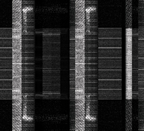
Happy New Ears (festival for New Music), Kortrijk (be)
notovo at Happy New Ears (festival for New Music), Kortrijk (be) :: The No2Pho/notovo research project: investigates the behaviour of language in its many appearances: textual, sonic and visual, as well as gestural or body language. How do these disparate elements relate to each other and how do they organize within a system which includes human and computer as a sender and a receiver [and vice versa].
The notovo-installation [article (PDF)]: as a generative sound installation NoToVo (noise to voice) plays with a connected set of elements. It is composed of dissonant synthetic voices, changing in real time from speech to sound. A physical network and a virtual network. People and voices. Wireless headphones and spatialized soundsources. People walk their traject through space. Their localisation and orientation is tracked. These data modulate the behaviour of realtime generated synthetic voices. As such, a conversation can be physically crossed and experienced according to the visitors' own position. Voices are layered and mixed by movements and trajects through space: the visitor becomes the performer.
No2Pho/notovo is developed by so-on (a collaboration between sukandar kartadinata, johannes taelman, edo paulus, billy bultheel and annemie maes). With the support of the VAF (Vlaams Audiovisueel Fonds).
http://so-on.be
http://okno.be/?id=954
http://happynewears.be
location: Happy New Ears festival, september 23rd --> oktober 8th
meetingpoint: busdascoop - kapucijnenstraat 10 - 8500 kortrijk
opening: saturday september 23rd from 2pm till 8.30pm
open: every monday, wednesday, friday and saturday from 2pm -> 8.30pm; sundays from 2pm -> 6pm
Posted by jo at 11:50 AM | Comments (0)
Dartmouth College

Senior Position in the Digital Humanities
Dartmouth College is pleased to announce the creation of a senior position in the Digital Humanities for a newly endowed Chair in innovative fields. The successful applicant should be committed to inter-disciplinary collaboration, technological innovation, and creating curricular links within the Humanities and across divisions. The position offers the opportunity to define a new area of research and teaching, building on Dartmouth’s existing strengths in the Humanities and Computing,
The field of research and teaching is open; we seek candidates with practical and/or theoretical expertise in one or several of the following disciplines in the Arts and the Humanities: visual arts, screen studies, new media, performance arts, music and sound, film, TV/Video, and literature. Expertise in computer hardware and/or software will be welcome but is not essential.
The role of the Chair in Digital Humanities is intended to be broad in scope, potentially incorporating current or future initiatives in cyber-culture and the creation, performance, and critical study of digital arts, including a consideration of the socio-political and theoretical implications of new artistic technologies. The endowment for this Chair provides additional funds for projects involving research and teaching in the Digital Humanities. The successful candidate will be located in a single Dartmouth department or program, or jointly appointed to one or more departments or programs. Considerable flexibility exists regarding joint appointments, which may cross departmental or even divisional boundaries.
One of the most diverse institutions of higher education in New England, Dartmouth College is an equal opportunity/ affirmative action employer and has a strong commitment to diversity. In that spirit, we are particularly interested in receiving applications from a broad spectrum of people, including women, persons of color, persons with disabilities, and veterans.
The Search Committee will begin reviewing applications after October 1, 2006. Applications will be considered until the position is filled.
Please send letter of application, CV, and the names of three references to:
Gerd Gemünden
Chair Search Committee in Digital Humanities
Dept. of German Studies
6084 Dartmouth Hall
Dartmouth College
Hanover, NH 03755 USA
Digital Humanities Chair Will Address Emerging Field
Through funding from the Sherman Fairchild Foundation, a longtime benefactor of the College, Dartmouth has created the new post of Digital Humanities Chair, one of two Distinguished Professorships in Emerging Fields in the Faculty of Arts and Sciences endowed by the foundation.
The Digital Humanities Chair, a senior-level appointment for which a national search is being conducted, was created to lead Dartmouth's efforts to integrate digital culture and innovation with the humanities across disciplinary and departmental lines. Professor of German Studies Gerd Gemünden, who chairs the search committee, explains, "The digital revolution affects all fields-how we learn, how we write. By creating the new chair, we are acknowledging the significance of the digital revolution."
Carol Folt, dean of the faculty of arts and sciences and professor of biological sciences, says the College was motivated by a need to integrate constantly evolving technology with its long-standing commitment to the humanities. "In creating the Digital Humanities Chair, the Dartmouth administration is seeking an academic of the highest caliber who can coalesce nascent efforts, build on core strengths ripe for advancement, effect major changes in curriculum and scholarly development, and influence global discourse," she says.
Gemünden says the position is open to scholars from a wide variety of disciplines and that the job will require the new chair to work across disciplines and help coalesce the digital humanities work already underway at Dartmouth. The new chair could be housed in almost any department, or possibly be a dual appointment. A second innovative faculty position is in development at Dartmouth as provided for by the Sherman Fairchild Foundation's grant.
Already, several other institutions of higher learning have begun exploring similar models of integrating digital and analog culture. The Center for New Media at the University of California, Berkeley, and the MIT Program in Media Arts and Sciences are serving as curricular means of exploring the relationship between the humanities and information technologies. Given the scale and ubiquity of the digital revolution, Dartmouth's new chair will work in a challenging field. As Gemünden notes, "The classes of 2008 and 2009 have never really lived without Google. That puts the burden of learning on us."
Posted by jo at 11:36 AM | Comments (0)
A Performance by Coco Fusco
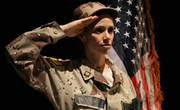
Women and Power in the New America
A ROOM OF ONE’S OWN: Women and Power in the New America, a performance by Coco Fusco :: Presented by PS 122 in conjunction with Creative Time :: September 28 - October 1 :: Thursday - Saturday 8:00 p.m. Saturday and Sunday 5:00 p.m. :: Tickets: $20, Students: $15 :: To purchase tickets call: 212 352 3103 or go to www.theatermania.com.
A ROOM OF ONE’S OWN is Fusco’s performance monologue about the expanding role of American women in the War on Terror. She speaks as a female graduate of interrogator training school. Using power-point and simulated live feed video from actual interrogations, Fusco gives a briefing about how a career in military intelligence offers great opportunities to emancipated women of the 21st century. Her performance explores how the current administration’s rationalizations of detention and prisoner abuse have led to a reconsideration of the possible legitimacy of torture. Fusco also raises questions about feminism in the 21st century and the ways that political conservatives have appropriated the language of women’s liberation.
Posted by jo at 11:28 AM | Comments (0)
BLACK TIME is not a BLACK BOX modernising a WHITE CUBE
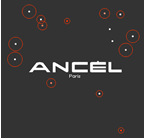
perfinstallation
Abstract preview: BLACK TIME is not a BLACK BOX modernising a WHITE CUBE :: Following the completion of a cycle of 5 communications for 5 continents at the end of 2005, "from Scenography to Planetary Network", via a wi-fi internet link from an aeroplane in flight between Shanghai and Munich, and on being invited by criticalsecret, we are now proposing a ‘perfinstallation’ during the inauguration of the 2006 Salon de la Revue in Paris. This show's name gives a nod to a contemporary play, but does not permit communication with the other. It simply tries to transform a mobile into a sort of awareness machine with an editorial line that is set where the Dream Machine stops. This show is made up of images gathered from the internet and a sound track, as a first revue for mobiles (as a 3gp file) transmitted only between 21:00 hrs and 22:00 hrs via the number ‘+33677804966’ (via Mms) from my mobile (Nokia 6233).
Thus, this creation-action is actually giving real expression to another ‘sound-image’ which the artist Laszlo Moholy-Nagy had already thought up in the last century. Nevertheless, from then on, technological performances set up an empty space in a post-mediatic universe that was not emerging but converging, which can still be freed of meaning simply by linking up with our lives, as experienced in plays by Dan Graham X or John Knight "Site displacement" 1969 during the mass media age. As part of setting up the transmission of a "Theater of Utopia" digitised animation, which will take place in honour of Claude-Nicolas Ledoux on the bicentenary of his death, on 19 November, we are going to test it on Friday 13 October, using a wi-fi link for a live streaming, from zero convergence, via the Internet and viewable on Internet-enabled mobiles, at this address rtsp://qts.zonepro.com/ancel/X (on your video player) before announcing the forthcoming "Black Time" in a podcast version for criticast.net. Contact Franck Ancel info[at]franck-ancel.com.
Posted by jo at 09:33 AM | Comments (0)
September 22, 2006
The Collision Project
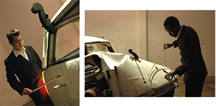
To ‘See’ that which the Eye Cannot
The Collision Project is the result of a collaborative exchange between artist / director Gerhard Marx and composer Clare Loveday, lecturers at the Wits School of Arts. It combines the visual and theatrical skills of Marx with the compositional exploration of Loveday to create a haunting work that is both concert performance, theatrical experience and installation work.
The Collision Project plays with the principles on which both classical and traditional string instruments function; in this case however, the vibration of strings are transferred into the body of a car wreck through cello and violin fragments grafted onto the car. The strings and musical intervention serves to animate through sound, and to explore in the manner that vibration and consequently hearing is used to ‘see’ that which the eye cannot; scientific vibration based practices to explore the geological structures buried in rock, the child not yet born (sonar), the tapping of train wheels to detect fractures, the car’s past embedded in the rusty folds of its current form. It is a collision between aesthetic disciplines, between makers and approaches. But it is the actual collision; the event in the body of the wreck itself, which Marx and Loveday aims to explore in this piece of ‘forensic music’, by drawing a voice from the hollow body of an abandoned car.
Performed by Vusi Ndebele, Sisekelo Pila and Barry Sherman.
THE SUBSTATION, Wits East Campus, Braamfontein
Thursday 21 to Friday 29 September 2006 at 19h00
Book at Computicket
Enquiries 011.717.1376
pisantic[at]theatre.wits.ac.za
Limited Seating Available
[blogged by nathaniel on nathanielstern.com]
Posted by jo at 06:51 PM | Comments (0)
CollecTic

Rediscover the Real World
The game CollecTic by Jonas Hielscher is developed for the Sony Playstation Portable (PSP) and uses existing wireless local area network (WLAN) access points as a main game element.
The game can be played anywhere, where WLAN access points can be found. In the game, the player has to move through the city to search for access points. The access points are visualized on the PSP as basic geometrical figures (triangle, circle, square) with a specific color and sound. Discovered access points can be collected and combined in a puzzle in order to earn points. In CollecTic, the player uses his PSP as a sensor device to discover the hidden infrastructure of wireless network coverage via auditive and visual feedback. By the game the player is stimulate to physically move around and explore his surroundings in a new and playful way.
CollecTic uses existing technology in a new way. It stimulates players to rediscover the real world and the hidden infrastructure of wireless network coverage, rather than creating virtual fantasy worlds as most digital games do. It is an approach to explore the real world and to make existing technology visible and possible to experience.
More information about CollecTic and the game itself (only for PSP firmware 1.5) can be found PixelSix. [blogged by julian on selectparks]
Posted by jo at 06:46 PM | Comments (0)
Heart Beats Dust by Jean Dupuy
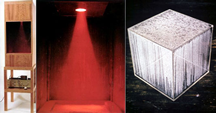
An E.A.T. Experiment
A colleague discussing research with me on friday told me of an early electronic / electrical work which clearly indicates the direction art would start to pursue over the next thirty years and fits nicely into my area of research. The work, mentioned in the publication Digital Currents by Margot Lovejoy, entitled Heart Beats Dust (above left and centre) by Jean Dupuy is a work I had never seen by an artist I had never heard of and strangely seems to be omitted from any other history of media art I am aware of (or the few conceptual art histories I have covered so far). It makes you wonder about who writes these histories and how they decide to include some works and not others.
Heart Beats Dust consists of:
a black rectangular box, a window at eye level opens onto a 24′ cube which houses the sculpture. The form is created by thrusting dust up into a cone of light. The dust is Lithol Rubine, a brilliant red pigment chosen for its ability to remain suspended in air for long periods. The thrust is achieved by amplified heart-beats from an attached stethoscope or a continuous loop tape recording of heartbeats played on a speaker mounted directly under a tightly stretched rubber membrane upon which the dust sits. (medienkunstnetz.de)
There is work reminiscent of Hearts Beats Dust particularly conceptual work such as Hans Haacke’s Condensation Cube (1963-65, above right) in that it too uses a basic medium (water) to show processes in action (condensation cycles) however nothing which cleverly brings technology and art, electronics and visualisation of the invisible together as cleverly.
Heart Beats Dust was the winning entry in a competition for collaborations between artists and engineers entitled E.A.T. (Experiments in Art and Technology) which also anticipated major initiates by organisations such as Xerox with their PAIR program and HP Labs with their Creative Residencies. [blogged by Garrett Lynch on Network Research]
Posted by jo at 05:04 PM | Comments (0)
Upgrade! Tel Aviv + Jerusalem
![]()
Yair Reshef + Tsila Hassine
Upgrade! Tel Aviv + Jerusalem :: gathering at 20:00, Tuesday 26th, 2006, @ Daila, Shlomtsion Hamalka st. 4, Jerusalem, free entrance.
Yair Reshef: The perfect Mousetrap :: Ultimately, we experience every interactive system as a risky game. Interactivity always implies the use of energy to initiate and manifest a relationship of call and response. This relationship is bordering on the abusive: the user, the victim, is put by the abuser in an uncertain situation, never fully sure what kind of reactions his actions will yield. Interactive systems never outrun the dangerous, but the danger is downplayed by the user basic trust in the benign intentions of the abuser. The contribution of the victim to his own downfall has been part of warfare from the very beginning and is widely used in guerrilla tactics. It is the very essence of The Booby-trap. But this use of other's energy and motivation can also be applied for navigation and exploration of the system.
Tsila Hassine: The Internet: Who's afraid of too much information? :: In this talk, Tsila Hassine will present three works that tackle some of the crucial issues involved in living in the networked galaxy. These works suggest ways of critically engaging with the Internet's visible matter, and attempt to reveal its dark matter. Through Shmoogle, Ctrl-F Reader and the Historiography Tracer, Tsila conveys her unique approach to the ways the Net can be used and abused.
Tsila Hassine is a media artist/designer whose works deal with the effects of media technology on our culture and daily life. She has recently earned an MFA degree from the Piet Zwart Institute's Media Design program, and currently holds a research residency at the design department of the Jan Van Eyck Academie.
Posted by jo at 04:09 PM | Comments (0)
Breaking the Game

THE VIRTUAL WORLDS OF WORKSPACE UNLIMITED
On the periphery of a multi-billion dollar global computer gaming industry exists an emerging group of impassioned artists, architects, filmmakers, and game enthusiasts who mine, recycle, and modify off-the-shelf videogames and multiplayer virtual worlds with unexpected and sometimes extraordinary results. Conflating the practices of consuming and producing in sometimes-uneasy ways, they exploit the tools, software code, graphics, and even the programming errors of the most popular videogames to fashion new cinematic forms (Machinima), soundscapes, interactive performances, talk show formats, and art installations. Breaking the Game: The Virtual Worlds of Workspace Unlimited [PDF] :: Text by Wayne Ashley, screen Captures and Photos by Thomas Soetens and Kora Van den Bulcke.
You can also check out the results of a first-iteration telematic symposium Wayne Ashley curated and co-organized with Workspace Unlimited called Breaking the Game. The symposium opened up the art of game modification to the contingencies of everyday life, where interactive technologies increasingly mediate physical spaces and human movements in very complex and dynamic ways. The symposium themes were: Hybridity, Overclocking the City and The Virtual as Interface to Self and Society. I asked participants to consider gaming and other virtual technologies in relationship to building and designing cities, navigating and experiencing urban life, constructing identities, and creating and maintaining social interaction. The symposium encouraged debate and discussion through multiple formats including text, desktop video conferencing, Skype, images, and animation. Several informal sessions took place inside of Second Life where participants gave tours and discussed their projects inside the 3D multi-user world.
Posted by jo at 03:46 PM | Comments (0)
Regine Debatty

Interview of Tom Igoe + Tad Hirsch's Tripwire
I subscribe to the feed of several del.icio.us tags such as tangible_computing, physical_computing and you know how this works, if a webpage or a person is regarded as particularly interesting resource, they get tagged again and again, that's how i get to read the name of Tom Igoe every week. Igoe is Area Head for physical computing classes at Interactive Telecommunications Program, New York University. His courses invite students to explore ways to allow digital technologies to sense and respond to a wider range of human physical expression and i've blogged dozens of projects that come right from his courses. Tom Igoe's background is in theatre, and his work today centers on physical interaction related to live performance and public space. Along with Dan O’Sullivan, he co-authored “Physical Computing: Sensing and Controlling the Physical World with Computers.” His own projects include an internet-aware player piano; a clock that reads emails (my favourite); and a series of interactive dioramas, created in collaboration with M.R. Petit. He has consulted for The American Museum of the Moving Image, EAR Studio, Diller + Scofidio Architects, Eos Orchestra, etc.
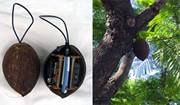
[...] As far as physical computing artwork that's impressed me lately, there's one piece that I really liked, featured at ISEA this year: Tad Hirsch's Tripwire. He basically made sound sensing coconuts that he hung in the trees in San Jose, and each time the noise levels from planes exceeded the acceptable maximum, the coconuts called the city's noise abatement complaint line. He's done a number of really smart activist works like this that use humor tactically. The other thing that impressed me about this piece was that it was the one from the festival that made the most earnest attempt to try to address a real problem of the city hosting the festival. Many of the other pieces could have been done in any city, but this one attempted to give something back to the citizens of San Jose, by drawing the attention of the city bureaucracy to something it tends to ignore. I thought that was very gracious of him. [read the full interview at we-make-money-not-art]
Posted by jo at 02:26 PM | Comments (0)
Freestyle SoundKit

Stickers on the Souls of your Shoes
Freestyle SoundKit was another piece i liked at the Conflux festival. It's the latest project by Jessica Thompson whom you might remember for other projects such as the Walking Machine and the Soundbike, a bike that uses motion-based generators to broadcast the sound of laughter as you pedal through the city.
Freestyle SoundKit generates and broadcasts electronic video game-like beats as you move around. You fix a yellow sticker with sensors under the sole of your shoes and each step you take is broadcast as a single beat. Each SoundKit contains a different beat to enable you to collaborate with other users to create a collaborative performance. It looked incredibly simple and the audience had a lot of fun with it. As Jessica said "Move around. Go freestyle but beware! Moves that look cool might not sound cool!" However, some testers (like the guy on the left picture) were quite good at sounding and looking cool. My images on flickr. [blogged by Regine on we-make-money-not-art]
Posted by jo at 02:20 PM | Comments (0)
Christy Dena in SLATE Magazine
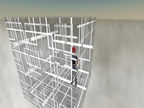
The Art Space in Virtual Worlds
My latest articles in SLATE Magazine explore the notion of the art space in virtual worlds. In part one I analyse how some spaces are remediations of the real world and then in part two I pose ideas about what would be the ‘white cube’ equivalent (the ideal environment to experience art) in a virtual world. I’ve opened up a forum thread at the end so anyone can add their own thoughts. In this 2nd issue of SLATE are reviews of art festivals and galleries in SL, an interesting article about a theatre production in SL by Anya Ixchel (Angela Thomas in RL) the editor of SLATE, and the second installment of the backbackers guide to SL: Sim Trekker. I love the idea of the last one: getting around SL on a budget! Anyway, there is plenty more: talk about the notion of identity in SL, relationships, science fiction and so on. Enjoy! [blogged by Christy Dena on WRT]
Posted by jo at 02:06 PM | Comments (0)
Upgrade! Lisbon
![]()
Santiago Ortiz
Lisboa 20 Arte Contemporânea welcomes next Wednesday, September 27th @19:00, Upgrade! Lisbon’s monthly gathering featuring digital artist Santiago Ortiz. Entrance is free and drinks will be served.
Santiago Ortiz will be presenting artificial life and information representation works. His projects relate to the idea (scientific or not) of life. The interactive processes happening inside a cell, between cells, inside a living organism, between living organisms of the same species or from different ones, especially those processes dealing with information, surpass largely in speed, creativity and diversity, human imagination. Both digital art and information representation science can find in life a multitude of processes, devices and ideas.
Genetics represents life as a group of cells loading, sharing and replicating code. Code, a simplifies representation of language, can also be found in the history of human culture (in literature, laws, music, religion…). Digital art creates narrative complexities through code. In all these examples code can be shared and replicated.
The writing of performative code, creative programming, allows writing code that will process other code, that simulates living interactions and constitutes information that will generate more information.
In his presentation for the Upgrade! Lisbon, Santiago Ortiz will show and discuss some of his projects dealing with artificial life and the representation of biological information. In the end, Ortiz will present a small musical performance based on a research addressing the musicalization of a virtual life model, in collaboration with Miguel Cardoso.
Santiago Ortiz was born in Bogotá, Colombia, in 1975. Artist, mathematician and researcher on subjects such as art, cience and representational spaces, He is the co-founder of Blank, a digital art and culture magazine and of Bestiario.
For more information visit Upgrade! Lisbon at http://www.lisboa20.pt/upgrade
Posted by luis at 01:29 PM | Comments (0)
Vida 9.0 Eighth Edition

Art & Artificial Life International Competition
Fundación Telefónica launches the eighth LIFE 9.0 international awards, the purpose of which is to acknowledge excellence in artistic creation carried out in the field of “artificial life” and associated disciplines.
The event is addressed at all artistic projects that explore the interaction between “synthetic” and “organic” life, and innovative projects that develop the field of Artificial Life. In previous years, award-winning projects have included robots, electronic avatars, chaotic algorithms, knowbots, cellular automata, computer viruses and virtual ecologies that evolved with the interaction of the participant. Applicants can view all these winning projects from previous years at the Internet portal of LIFE, at http://www.telefonica.es/vida.
The themes on which the contents of this year’s awards have been organized are, among others: autonomous agents that give form to and interpret our environment saturated with data, various artefacts (robots, Artificial Intelligence agents, wetware, etc., that question pre-existing notions of what is “human”, “natural” and what it means to be alive), how to create empathy between artificial entities and human beings, anthropomorphization of cyberspace and its inhabitants, and how interactive systems can be designed to arouse interest in the emerging field of “artificial life.”, etc.
The competition is open to participants from all round the world and each of them may only present one project completed after September 2004 which will consist of a video with the project in which the images will be accompanied by an audio narration explaining the artistic concept and the technological execution of the project, plus a transcript of this explanation. They must also attach a brief biography (150-200 words), a description of the concept and the technique of the project and between one and three images (slides, photos or high quality CD or Internet digitalizations). The language used may be Spanish or English and the total duration of the video may be between 5 and 10 minutes.
To register, candidates should follow the rules for submission, complete and sign the application form on http://www.telefonica.es/vida and send it with the tape or DVD before 16th October 2006, to any of the sites of the Fundación Telefónica in Spain (Madrid) or Latin America (Mexico D.F., Sao Paulo, Buenos Aires, Santiago de Chile and Lima), the addresses of which can be found at the end of the announcement on http://www.telefonica.es/vida
The works submitted will be examined by an international panel of judges that will meet in Madrid as of 2nd November 2006: Sally Jane Norman, France/New Zealand; Jonah Brucker-Cohen, USA; Mónica Bello Bugallo, Spain; Daniel Canogar, Spain; José-Carlos Mariátegui, Peru; and Nell Tenhaaf, Canada.
A total of 20,000 euros will be awarded for the three projects selected by the judges: First Prize, 10,000 euros; Second Prize, 7,000 euros; and Third Prize, 3,000 euros. The prize-winning projects will have the possibility of being displayed at exhibitions organized by Fundación Telefónica or in which it participates.
Incentive to Iberoamerican productions
The second category of the competition fosters the production of pieces using Artificial Life techniques and associated disciplines, in the Iberoamerican field. With prize money of 20,000 euros, this category will award between one and three proposals that show a relevant concept, a proven quality in earlier works and a clear capacity of the artist to produce the piece. This prize is conceived as an incentive to production, not as a subsidy to cover the total expenses of a project, and therefore the participant’s ability to achieve technical, economic and logistical infrastructure to do the piece will be valued. Each project must be described in a text not exceeding 2,000 words and which must include details of the concepts and techniques planned to develop the piece. The competition is open to participants from all of Iberoamerica, Spain and Portugal and proposals may be sent in Spanish, Portuguese or English. Each participant, however, may only submit one work.
Posted by luis at 10:02 AM | Comments (0)
MESH #19:
![]()
Global/Regional Perspectives
Experimenta will launch the latest issue of MESH at Newcastle Region Art Gallery! :: Friday 29 September 2006, 6.30pm :: 1 Laman Street, Newcastle.
MESH#19 looks at the relation of the local to the global by focussing on specific media art and screen-based practices around the world. The six articles commissioned by Experimenta highlight contemporary media arts that are an expression of current cultural movements in Europe, South America, the Middle East, New Zealand and North and Central America.
Each article provides insightful and thought-provoking explorations of current trends in the creative applications of technological development, the cultural contexts from which media art practice emerges, and cultural reactions to the practice and exhibition of media art.
With full-colour images, references for further research and highlighted key words and concepts, Mesh #19 is an excellent resource for artists, curators, writers, researchers, students as well as those with a general interested in contemporary arts.
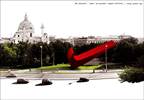
F FOR FAKE [NET ART]: Or how I Iearned to manipulate the media to tell the truth by DOMENICO QUARANTA, Europe. Translation from Italian by Anna Carruthers.
Media manipulation is probably one of the greatest issues this Millennium. Now more than ever, truth is unstable, nebulous and difficult to grasp as it is hidden under layers and layers of information. But if the media manipulate truth, they can be manipulated in turn to interfere with the flux of information, so as to make it clearer or even thicker. This article aims to explain the rules at play in today's European net art, and reflect on the relationship between reality and fiction, information and manipulation, the artificial and authentic, drawing on the latest amazing fake by 0100101110101101.org (United We Stand), UBERMORGEN.COM's [F]originals (forged originals) and the cruel hyper-realism of the Where-next website (MOLLEINDUSTRIA + GUERRIGLIAMARKETING). PDF version.
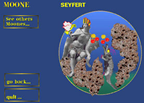
TELECOMMUNICATION ART IN BRAZIL by MARTHA CARRER CRUZ GABRIEL, Global Practices :: Artist and scholar Martha Gabriel takes up the dialogue about telecommunications in the context of language as our main mode of communication and shared meaning and discusses the inherent challenges of translation. The artworks she presents include those that use telematics, SMS (short message service), mobile phones and telephone on the web. Gabriel details an ongoing net.art project titled VoiceMosaic that she designed and presented at SIGGRAPH Art Gallery 2006 which uses intelligent voice technologies on the web, converging phone and web.
This article is about artworks that use telecommunications technologies and aims to discuss some Brazilian artists whose works are representative of telecommunication art. Of course I do not have the pretension here of covering the entire Brazilian panorama of artistic manifestation in telecommunication art since Brazil is a country with continental territorial dimensions, with cultural differences among regions and broad artistic production. The aim here is to give a ‘taste’ of the Brazilian scene in this area through the presented artists and their works. PDF version.
Posted by jo at 09:46 AM | Comments (0)
terminus1525.ca takes over the city !
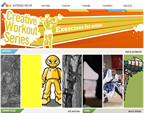
Disseminating Canadian Cultural Content
terminus1525, Canada's online arts community, is proud to announce a partnership with community wireless groups Ile Sans Fil and Wireless Toronto, which uses new technology to engage Canadian audiences with art in their local cafes, libraries and parks. Ile Sans Fil's and Wireless Toronto's 27,500 users are being introduced to art by young Canadians when they use any of the 135 free public wireless hotspots operated by the two groups. Most of the hotspots are located in Montreal and Toronto, but the project includes resources for interested volunteers to set up hotspots in their own cities and towns.
terminus1525 is proud to support and participate in this ground-breaking large-scale project, which is developing new methods to promote Canadian art. Maintained by zinc Roe Design, terminus1525.ca is a collaborative workspace brought to life by the ingenuity and imagination of young Canadian artists working in a wide range of disciplines. A project that has been funded by Canadian Heritage and administered via Canada Council for the Arts, t1525 operates free online studios where emerging artists can show their work, find support, feedback and inspiration.
Ile Sans Fil (ISF) and Wireless Toronto (WT) are volunteer-run non-profit organizations which develop, deploy and support community-focused wireless infrastructure. This is accomplished through providing free Internet access in public spaces, as well as geographically-specific information and cultural content at each hotspot.
Through this collaboration, the three organizations aim to innovate in methods of disseminating Canadian cultural content. Work by t1525 artists is shown to a large captive audience of mobile wireless users. Already echoing the mandate of ISF and WT in supporting community via technology, t1525 also wants to introduce members to the creation of locative, mobile and syndicated artistic content.
Through the community-owned wireless infrastructure installed and managed by ISF and WT, users are directed to a website specific for each hotspot before they can surf the web. This opportunity is used to showcase local information or content, and in this case, art from terminus1525. At 30 select hotspots where the project has supported advanced audio and video service, an on-site mini-server allows the delivery of location-specific, large files of music and videos at speeds currently impossible over the internet.
The size of this project is impressive. By harnessing the infrastructure and contribution of volunteers at Ile Sans Fil and Wireless Toronto, content from terminus1525.ca young artists will be disseminated to over 27,500 users, many of whom make daily use of these infrastructures.
Sources:
Michael Lenczner
Ile Sans Fil
michael[at]ilesansfil.org
514 708 5112
Michael Pereira
Wireless Toronto
michael[at]wirelesstoronto.ca
416 821 5081
Sophie Le-Phat Ho
terminus1525
sophie[at]terminus1525.ca
514 993 2312
Posted by jo at 08:30 AM | Comments (0)
Real Time Rome
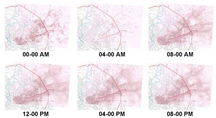
at Venice Biennale
MIT Real Time Rome project to debut at Venice Biennale :: Real Time Rome, a pioneering MIT project that promises to usher in a new era of urban mapmaking, will have its worldwide debut at the Venice Biennale, the prestigious biannual exhibition of contemporary art, from Sept. 10 to Nov. 19.
The project utilizes data gathered, in real time and at an unprecedented scale, from cell phones and other wireless technologies, to better understand the patterns of daily life in Rome, and to illustrate what ubiquitous connectivity in an urban environment looks like.
"In today's world, wireless mobile communications devices are creating new dimensions of interconnectedness between people, places and urban infrastructures," said project director Carlo Ratti, director of the SENSEable City Lab at MIT. "The goal of Real Time Rome is to use this connectivity to map the city in real time, which may ultimately lead to a deeper understanding of how modern cities function."
Real Time Rome features seven large animations, projected on transparent plexiglass screens. One screen shows traffic congestion around the city, while another screen shows the exact movements of all the city's buses and taxis. Another screen is able to track Romans celebrating major events like the World Cup or the city's annual White Nights festival (Notte Bianca, which will happen on Sept. 9, the evening before the Biennale's architecture exhibition opening). Additional screens show how tourists use urban spaces and how cars and pedestrians move about the city.
Ratti believes these types of visualizations will help reduce the inefficiencies of present day urban systems and open the way to a more sustainable future: "Our hope is that projects like Real Time Rome will give city dwellers more control over their environment by allowing them to make more informed decisions about their surroundings. Imagine being able to avoid traffic congestion, or knowing where people are congregating on a Saturday afternoon. In a worst-case scenario, such real time systems could also make it easier to evacuate a city in case of emergency."
Ratti's team obtains its data anonymously from cell phones, GPS devices on buses and taxis, and other wireless mobile devices, using advanced algorithms developed by Telecom Italia, the principal sponsor of the project. These algorithms are able to discern the difference between, say, a mobile phone signal from a user who is stuck in traffic and one that is sitting in the pocket of a pedestrian wandering down the street. Data are made anonymous and aggregated from the beginning, so there are no implications for individual privacy.
"The exhibit will hopefully trigger many more urban studies that take advantage of the already existing data on mobile phones and transportation systems, in order to create a deeper understanding of how cities are being used," said project curator Andres Sevtsuk, a graduate student in urban studies and planning.
Ratti describes Real Time Rome as a new kind of mapmaking. Along with other powerful interactive maps, such as Google Earth, Real Time Rome is backed up by huge databases that will ultimately make it possible to conduct highly customized searches and view displays in real time.
"We are very excited to carry out our experiment in Rome, the city where Gianbattista Nolli refined modern cartography in 1748," Ratti said. "Maps of the future will be large databases that will enable us to extract fragments that suit our needs, much like we can do today on the web, and will also tap into the coming revolution in RFID (radio frequency identification) technology."
Real Time Rome is produced by MIT's SENSEable City Laboratory, an initiative that studies the impact of new technologies on cities.
Other MIT projects will also be on display at the Biennale, in the same location as Real Time Rome. They include including an interactive bus stop with wireless Internet; designs for digitally enhanced public spaces in the Milla Digital in Zaragoza, Spain; a smart car and public transportation system by the MIT Media Lab and Design Lab; and new computer interfaces by the Tangible Media Group at the Media Lab.
"All these projects from MIT deal with specific aspects of the urban environment and digital technology," said Sevtsuk. "Together they start to form a multifaceted picture of how real-time communications can change urban design."
Following the Venice Biennale, the SENSEable City Laboratory will launch the SENSEable City Consortium, a major research initiative aimed at bringing together city and public administrators, network operators, electronic hardware and software producers and urban hardware manufacturers in MIT's unique research environment.
The principal sponsor of Real Time Rome is Telecom Italia. Technical partners are the Rome public transportation authority (ATAC), Google, Samarcanda Taxi and the city of Rome.
The Real Time Rome team at the SENSEable City Lab is composed of Ratti, Sevtsuk, Burak Arikan, Francesco Calabrese, Assaf Biderman, Filippo Dal Fiore, Saba Ghole, Daniel Gutierrez, Sonya Huang, Sriram Krishnan, Justin Moe, Carlo Ratti, Francisca Rojas, and Najeeb Tarazi.
For more information, visit senseable.mit.edu/realtimerome/.
Posted by jo at 08:02 AM | Comments (0)
September 21, 2006
Google-ad hacks
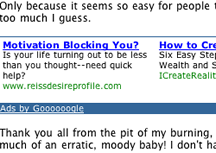
Kurt Cobain's Suicide Letter vs. Google AdSense
A few years ago, French artist Christophe Bruno created the Google AdWords Happening, in which he utilized the AdWords program to publish abstract poetry instead of ads. Google didn't find the happening appropriate hence, he got banned.
Last year Bruno's happening was followed up by GWEI - Google Will Eat Itself, an artistic click-fraud scheme developed by Hans Bernhard & Alessandro Ludovico. GWEI turned Google's ubiquitous AdSense program against Google itself in order to draw public attention to the fact that Google's immense popularity constitutes a democratic paradox. The operation was quickly discovered and stopped by Google.
Now, US artist Cory Arcangel has added to the list of conceptual Google-ad hacks. Arcangel recently put up a webpage containing the entire text from Kurt Cobain's suicide note and paired it with Google AdSense.
Naturally, the text-ads generated by Cobain's suicide note are totally absurd and so, the site demonstrates just how clueless AdSense is despite Google's claim that 'AdSense can deliver relevant ads because Google understand the meaning of a webpage'. [blogged on Guerrilla Innovation]
Posted by jo at 07:06 PM | Comments (0)
Langlois Foundation Grants for Researchers in Residence
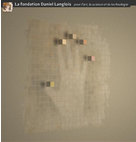
Call for Submissions
This year, the deadline for submission of research proposals for the Grants for Researchers in Residence Program is October 31, 2006.
A number of changes were recently made to this program, including the introduction of two research components: CR+D documentary collections and archival fonds and Information architecture and online publishing. As in previous years, the Daniel Langlois Foundation will award two research grants for 2007. The proposals selected will allow researchers to work at the Langlois Foundation's Centre for Research and Documentation (CR+D).
Anyone interested in submitting a research proposal is asked to read the new program guidelines [PDF]. An application form is available online, and must be used to submit a proposal.
Posted by jo at 06:06 PM | Comments (0)
[iDC] Some things about things
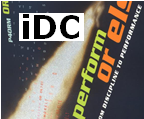
"Performance" and Situated Technologies.
I thought I might introduce a paradigm, that of "performance", into the discussion of situated technologies. This could provide a way to talk about people and things in networked milieus without fetishizing the object or exceptionalizing the human.
Trebor writes: "Sociality between networked objects and humans is a core question. Who is served by such mythologizing rhetoric with terms like "co-inhabiting"? These, ___ (fill in the blank) are just pieces of metal and silicon... They are around and they make some things easier and they (will) join our conversations by contributing data."
And Anne also points out: "I also wonder about a current fetishising of 'things'. Or how can we 'return to the object' without privileging objectivity? I really disliked the phrase 'the internet of things' when I first heard it, but I've since embraced it as a rather lovely manifestation of a type of contemporary commodity fetishism."
Firstly, as a designer I can't help but like things. Sometimes they are buildings but mostly they are just things. I don't design them in and for themselves but to be used by a variety of actors: people (gender age and race a clear consideration) but also for institutions (and here I use it in Agre's terminology: http://polaris.gseis.ucla.edu/pagre/hci.html) like festivals and cities. Although I agree with Anne's warning of fetishizing, I don't think it will be of the object. Their will be nostalgia for the material object, but it will be difficult in light of networked technologies, virtual/real hybrids to essentialise and fetishize the object in the same way again. What I do think will be become fetishized if it hasn't already is "performance".
Jon McKenzie in his book _Perform or Else: From Discipline to Performance_ attempts to formulate a general theory of performance by drawing on three strands of concurrent but fundamentally independent researches: "Performance Studies", "Management Performance" and "Techno-Performance". All three are products of the post-war: Performance Studies taking its germination from theater studies and anthropology, Management Performance developing in opposition to Taylor's Scientific Management and Techno-Performance Research tied to computer science and engineering. What McKenzie tries to do is demonstrate the "normativity" of performance. Performance has become a mode of measuring, evaluating and ultimately reifying forms of knowledge and power. The nature of these measures/values differs from one activity to another and McKenzie distills three to coincide with his three research areas: "efficacy" for cultural performances, "efficiency" for organizational performance and "effectiveness" for technological performance. These valuations are instrumental in maintaining "high standards" (normative) while also issuing a challenge (operational) to all those that wish to participate. It is in the relationship between challenging and performance that McKenzie finds "the power of performance":
"At the crack of millennia, performativity guides innumerable processes ranging from the intricacies of class, race, ethnic, gender, and sexual identification to the large-scale installations of technologies, organizations and cultures. "Perform- or else" is a challenge made in the USA and now restoring itself worldwide through innumerable circuits... Challenging is the fundamental tonality of this transformation without foundation; it is the affective dimension of the performance stratum, the shifting element of its "perform_ or else." Accordingly, the age of global performance is not only populated by high performers, peak performers, star performers, performers who challenge forth themselves and others, but also by the performatively challenged, those who cannot perform up to spec: the mentally challenged, the physically challenged, the economically challenged, the digitally challenged, the stylistically challenged and even the liminally challenged. Perform- or else: there is no performance without challenge, without claims and contestations, demands and accusations, field tests and identity checks, as well as the occasional untimely dare (p.188)"
In light of the performance paradigm Sterling's spimes are interesting. They rise to the challenge of techo-effectiveness as they as incredibly sophisticated compositions of cutting edge technologies: rfid, gps, the internet, CAD, rapid prototyping and recycling. They rise culturally to the environmental challenge because as they transform materially and informationally over their lifetime they develop a history with their environment (people and other things). And when their use is up they forfeit their material existence for the benefit of other spimes and the planet. Organizationally they would be an efficient version of my verizon mobile phone service or my fav software, both organizations of "convenience", quick fixes, and upgrades every n years. Also spimes carry lifetime warranties, which tie me to a contract that probably carries heavy penalties, social and financial, if I want to opt out. The spime program appeals to designers and why shouldn't it? It has great technical challenges tied to social responsibility. This is innovation with conscience. In conflict resolution parlance it is a win-win.
McKenzie again:
"The most striking aspect of performative power is that it actually encourages transformation, innovation, even transgression and perversion. No longer objects of discipline, we now perform, multitask, do our own thing. This last aspect of performance is especially troubling, for it reveals the libidinal infrastructure of contemporary domination. Deleuze, reading Foucault, writes that strata coalesce around relatively rare perfomative statements or "order-words." The order word of the performance stratum? Perform- or else."
This is the paradox of performance, it is "normative" but also "mutational". The disaffection that I sense from Trebor and Anne's posts seem to be directed at performance's normative tendencies: techno-effectiveness with its concerns for "optimizing" and organizational-efficiency with its needs on "streamlining". Perhaps it is easy for us on this list to rally around cultural performances, theater, dance, performance art, aesthetic practices, political demonstrations and "free cooperation", whose aims are social efficacy. But I am suspicious that it won't be so easy to decouple one type of performance from another. As McKenzie also points out "the paradigms are coming into contact more and more, and as their citational networks become hyperlinked, their respective performatives and performances break apart and recombine in a highly charged, highly pressurized milieu."
This brings me to Architecture and Situated Technologies. I think architecture in architecture in particular is a good example of the "perform-or else" challenge. It requires efficient organizational management to handle the considerable capital that it uses, it provides lots of work making it one of the engines of the global economy, its practitioners are concerned with the aesthetic, social and environmental effects of their project (mostly) and technical innovation is a hallmark of its quality. The role of situated technologies in this mix can be twofold. They can contribute to achieving the prime directive ("perform-or else") or they can open the performance of architecture up to unscripted performances which would allow for other socialities: alterity, participation, learning, cooperation. It all depends on "which" situated technologies we are talking about and not "what" situated technology.
In my last post I evoked the specter of Gordon Pask, "mister cybernetics" to suggest some antecedents for this symposium. In addition to his contributions to the subject of cybernetics and human-machine interaction he was a performer and "dramaturg" http://www.pangaro.com/published/Pask-as-Dramaturg.html. In July, 1968 Gregory Bateson organized a conference in Burg Wartenstein, Austria entitled "Effects of Conscious Purpose on Human Adaptation." Its proceedings were published in the form of a personal account by Mary Catherine Bateson entitled "Our own Metaphor." The conference has extended conversations on cybernetics with the metaphor of the machine being a contentious point. Here is Pask laying out an argument for "things":
"'You have all talked as though there was a fixed heritage of machines that dated from the Industrial Revolution or somewhat earlier,' Gordon said. "It seems to me that the notion of machine that was current in the course of the Industrial Revolution- and which we might have inherited- is a notion, essentially, of a machine without goal, it had no goal "of", it had a goal "for". And this gradually developed into the notion of machines with goals "of", like thermostats, which I might begin to object to because they might compete with me. Now we've got the notion of a machine with an underspecified goal, the system that evolves. This is a new notion, nothing like the notion of machines that was current in the Industrial Revolution, absolutely nothing like it. It is, if you like, a much more biological notion, maybe I'm wrong to call such a thing a machine; I gave that label to it because I like to realize things as artifacts, but you might not call the system a machine, you might call it something else.'"
Pask's "biological" observation is performative not ontological. These "things" will perform biologically, evolutionarily, iteratively. The agency that he gives them should not be confused with the idea of human agency which is tied to intentionality and hence consciousness. I think material things with underspecified goals can have agency in the way Pask describes them, where "intentionality" doesn't exist a priori but is an emergent quality apprehended only recursively.
If we are to understand the "internet of things", "networked things" or "situated technologies" from the position of performance then I think we may be able to interrogate them critically and constructively. We have to be careful of terms like "co-habitation" because to inhabit or dwell may suggest too much human intentionality. "Co-perform" may be better? To do this we would ask which situations? and what technologies? so as not to objectify the "thing' but elaborate on its performativity.
Omar Khan
Below is an excerpt from Pask's The Architectural Relevance of Cybernetics, Architectural Design 1969
A simple cybernetic design paradigm
In the context of a reactive and adaptive environment, architectural design takes place in several interdependent stages:
i) Specification of the purpose or goal of the system(with respect to human inhabitants). It should be emphasized that the goal may be and nearly always will be underspecified, ie. The architect will no more know the purpose of the system than he really knows the pupose of a conventional house. His aim is to provide a set of constraints that allow for certain, presumably desirable, modes of evolution.
ii) Choice of the basic environmental materials.
iii) Selection of the invariants which are to be programmed into the system. Partly at this stage and partly at ii above, the architect determines what properties will be relevant in the man environment dialogue.
iv) Specification of what the environment will learn about and how it will adapt
v) Choice of plan for adaptation and development. In case the goal
of the system is underspecified (as in i) the plan will chiefly consist in a number of evolutionary principles.
_________________________________________________________________
Like a sleeping dog whose ears prick up when he hears himself being called, I glimpsed my name in Sergio's post, and, flattered as I am by the mention, just want to nuance what I said about Performance. I was trying to suggest that Performance was both a product of and a resistence to burgeoning digital culture. This is the quote from the book
...whatever their individual content or treatments performance works are united by a shared consideration of context and methods. Central to any performance is the question of the space in which it takes place and the means by which it is articulated, often centred on the artist's body as both location and means. Such work concerns the media, in the sense of that which mediates a communication, and how that mediation affects the message. It is no coincidence that modern Performance Art emerged at a time when electronic media were initiating what the Italian philosopher Gianni Vattimo describes as an 'society of generalized communication'. To some extent Performance can be understood as a pre-emptive defensive reaction, emphasizing the corporeal and embodied as well as the ephemeral and the physically located, as a form of resistance to the immateriality, ubiquity and virtuality of mass media and communications, which had taken over so much of art's role as the provider of aesthetic solace and meaning. But Performance can also be seen as rehearsing many issues that later become relevant to electronic and, in particular, digital media. These included questions of interaction, response, feedback, the relationship between the audience and the performance, the methods for combining different media elements and so on. Much of the visual and interactive grammar of modern electronic media, such as television and digital multimedia of various sorts derives from the work of those involved with performance and other, similar areas. Those working in these areas were among the first to explore the possibilities offered by electronic media, first in video and then in digital technology. Many of those involved in developing Performance as an artistic practice are currently involved in media art practice. But, even before the widespread use of technology these practices offered a framework for thinking about multimedia, interactivity and other issues, as well as offering an artistic and poetic matrix through which to think about their use.
Charlie
Charlie Gere
Reader in New Media Research
Director of Research
Institute for Cultural Research
Lancaster University Lancaster LA1 4YL UK
Tel: +44 (0) 1524 594446
E-mail: c.gere[at]lancaster.ac.uk
http://www.lancs.ac.uk/fss/cultres/staff/gere.php
iDC -- mailing list of the Institute for Distributed Creativity:: iDC[at]bbs.thing.net :: http://mailman.thing.net/cgi-bin/mailman/listinfo/idc
List Archive: http://mailman.thing.net/pipermail/idc/
Posted by jo at 05:34 PM | Comments (0)
Re:Transmission Event and Network
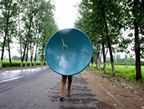
Invitation to Participate
Invitation to participate in Re:Transmission Event and Network :: Dates: Friday 13th – Sunday 15th October, 2006 :: Location: Limehouse Town Hall, London, also British Film Institute and RampArt Social Centre.
Re:Transmission is a gathering of citizen journalists, video makers, artists, programmers and web producers who are developing online video distribution tools for social justice and media democracy. Earlier this year thirty groups met in Rome for four days of intensive workshops, discussions and presentations to identify key infrastructural needs of video based alternative media production. The Transmission event provided a vibrant cross-pollination of projects in the wider context of Internet communication; for reports go here.
Based on existing work by groups active in the field for many years, the meeting successfully identified a clear set of projects required for alternative media groups to collaborate on, with the goal of overcoming infrastructural problems of increasing visibility and cooperation.
This event is entitled 'Re:Transmission' because participants will be passing on and developing some of the ideas, contacts, plans and processes begun at the
Rome Transmission meeting.
Citizen journalism and independent artists representing themselves on-line is a big focus of this event. As we witness the growth of user-contributed content, people continue to blog, upload, pirate, learn. The Free Open Source Software community has provided a wide number of production and distribution tool on the Net, while the Creative Commons copyleft licence offers a way to share content without commercial exploitation. The event has been organised to add to the work of these and other communities to contribute to the building of real world usable tools for distributing and sharing video online.
The gathering is participant-run and will made up of discussions, workshops, screenings, training, presentations and a 24/7 lab.
All welcome but workshop places are limited so please book early. RSVP to: r_transmission[at]yahoo.com
Ways to get involved:
Participate by suggesting and running a workshop or take part in an existing working group; contribute films for screenings, offer specific trainings and presentations. Alternatively you can volunteer to help with one of the areas of coordination. Read our call for co-ordinators here.
Post a story to the website and/or join the discussion list.
Workshops, screenings and presentations at the Limehouse are free, but donations most welcome to cover costs. BFI events are ticketed, see below.
If you want to speak to a human being about how you can help, press enquiries or for further information please contact:
Adele: 07733 227 335
Simon: 07904 066 702
Mick: 07913882193
Summary of Events
Re:Transmission screenings / discussions at the British Film Institute
Saturday 14th October
14:00: Citizen Video: Urgent, politicised, this programme of contextualised screenings explores the emergence of citizen video reporting on the Net.
16:00: Soft TV: Software cultures are changing the way that we make, distribute and watch moving-image, creating new opportunites for participation,
collaboration and content-sharing.
This is a ticketed event, tickets cost £6 each, or £9 for both, concesssions available, contact BFI box office on (0)20 7928 3232 or book online at https://tickets.bfi.org.uk
Main Programme of Events at Limehouse Town Hall
Friday 13th October:
12:00/19:00: Workshops, Presentations and Discussions
[further details to come].
20:00: Film Screening – co-ordinated by
Clearerchannel.org.
Saturday 14th October
09:00/12:00: Workshops. [further details to come] 20:00: Open Access Film Screening; co-ordinated by Collective Vision.
Sunday 15th October
10:30 / 17:30 Workshops, Presentations and Discussions. [further details to come]
Friday – Sunday
On-going 24/7 Hacklab and tech experimentation sessions at the Rampart Centre. Bring what you expect to find.
Posted by jo at 05:21 PM | Comments (0)
CAFKA.07: Haptic

Call for Proposals
Our physical connection to objects and spaces is essential to our being in the world: in the environments we inhabit, in the ways we relate to one another, and in the products we create. From the distinctive craftsmanship of the Waterloo Region’s German and Mennonite founders to the region’s current role in shaping the technological future we see a consistent understanding of the importance of haptic relationships from the outstanding design and use of materials in early furniture to the engineering prowess and innovation in our high-tech and research sector. This local context gives us a unique perspective from which to investigate the interplay of science, technology and artistic vision in the formation and understanding of our connections to places and things.
We ask artists to consider actual or metaphorical possibilities enabled by the haptic connection, whether achieved through exceptional handling of traditional materials or of new media. Artists may wish to consider how contemporary art practice, with its emphasis on the new, co-exists with and incorporates the skills, techniques and values of the past: to explore haptic relationships, or how contemporary art practice places into question the Cartesian duality of mind and body.
For Haptic, CAFKA invites proposals for new or existing works that engage with the theme and the environment in and around City Hall. Works in all media will be considered including sculpture, performance, video, audio, installation, photography, painting, drawing and new media. Video artists are invited to submit work relating to the theme. CAFKA.07 will create a video compilation to be screened during the Forum.
The exhibition will take place in and around Kitchener City hall for 11 days at the end of September, 2007. Artist Fees paid for Visual and Media Art Projects: CND $2,000 (intended to cover all aspects of mounting including materials and transportation). Video and one-time Performance fees paid in accordance with CARFAC (Canadian Artists’ Representation/le Front des Artistes Canadiens).
Please submit 10 images (JPG/JPEG format or 35mm slides), or video documentation (NTSC DVD or VHS), along with 10 copies of printed matter including: Curriculum Vitae, project proposal, technical requirements, budget, and a completed application form. All applications must be received by November 1, 2006.
Mail address:
Haptic – CAFKA.07 Submissions
P.O. Box 1122
Kitchener, ON N2G 4G1 Canada
Courier Address:
Haptic – CAFKA.07 Submissions
141 Whitney Place (rear entrance)
Kitchener, ON N2G 2X8 Canada
For more information please contact cafka@contemporaryartforum.ca or call (519) 744-5123.
23 projects will be selected and artists will be notified within approximately two months. Absolutely no fax submissions will be accepted. Support material must be in one or more of the following formats: CD, DVD, VHS, JPG/JPEG, PDF (for text) or 35mm slide. Other media will not be considered. Please do not refer CAFKA to a website for information about you or your work.
Posted by jo at 05:09 PM | Comments (0)
London Games Festival Fringe, Cybersalon and Select Parks
![]()
Artful Gaming
ARTFUL GAMING FORUM :: Thursday, 5th October 2006, 1-10pm :: The Science Museum's Dana Centre. ARTFUL GAMING EXHIBITION :: Monday 2nd, 2-6pm, Tuesday 3rd - Thursday 5th, 10am-6pm, Friday, 6th October, 10am-2pm :: The Science Museum's Dana Centre. More info at Cybersalon.
As part of the London Games Festival Fringe, Cybersalon and Select Parks host Artful Gaming at the Science Museum's Dana Centre - a one-day forum and week-long exhibition that spotlights innovation and platforms new work, new developments and new thinking in gaming culture.
Through an exhibition of key works, artistic and technical 'knowledge sharing' workshops, panel discussions, artist talks and playful interactions Artful Gaming will explore a series of key questions at the frontiers of gaming innovation: :: How are independent developers and artists exploring and extending the horizons of both gaming and art? :: How are they shaping alternative approaches that challenge traditional games development and distribution? :: What impact could this exploration have on the mainstream gaming sector and the longer-term development of gaming and gaming culture?
The programme showcases artists and developer groups and small pioneering agencies developing alternative gaming experiences - be it devising new interactive interfaces; exploring non-traditional gaming environments; modifying existing game engines; using innovative R&D and production methods; or distributing their work via new networks.
The sharing of expertise, technical or otherwise, formed the original 'grass roots' of game development, as we know it today. Artful Gaming aims to foster this tradition by bringing the underground art games community into contact and dialogue with small, independent commercial gaming agencies and make them more visible to the commercial gaming sector and to game enthusiasts, London's digital art community and the general public. Artful Gaming will make the case that art games are to the game industry what short films are to the film industry; that you don't have to work in the industry to experiment with game design/development; and that gaming should be reclaimed as a medium for any use, not only 'entertainment'.
Contributors, speakers and works include: Myfanwy Ashmore - Mario Battle No. 1, Ed Cookson of The Sancho Plan - The Sancho Plan, Ole Ciliox of Susigames - EdgeBomber, Toshi Endo - Chit Chat National Park, Adam and Aaron Fothergill of Strange Flavour Ltd, Ruth Gibson and Bruno Martelli of Igloo - Summerbranch, Tanya Krzywinska, Reader in Film and TV Studies, Brunel University, Julian Oliver of Select Parks, Anthony Rowe of squidsoup - Ghosts and others to be confirmed.
A full programme for the forum and exhibition will be announced shortly on the Artful Gaming micro site via the Cybersalon website.
Cybersalon gratefully acknowledges support from the Science Museum's Dana Centre, UK Online/Sky Broadband and Creative London.
THE LONDON GAMES FESTIVAL :: Monday, 2nd - Saturday, 7th October 2006 :: The London Games Festival is a new major international event to celebrate the diverse creativity and cultures of interactive entertainment. The festival is the first of its kind in a country that is both one of the leading sources of creativity and innovation in video games and other interactive media as well as an international centre of business excellence in a rapidly growing industry.
The LGF programme will include a series of diverse events for consumers as well as industry. Participants will include publishers, developers, creative professionals, artists, students, trade organisations, academia, arts and media organisations as well as anyone who just likes to play.
The LGF is unique in the UK in being backed by every sector of the games industry: developers, publishers, platform owners and trade associations. The mainstream of the festival will include a range of consumer-facing events in major venues alongside B2B events organised by the industry's trade bodies and other organisations. It includes BAFTA's relaunched Games Awards.
The Festival's ambition is to become the most significant event in the world celebrating the culture and creativity of video games and interactive entertainment.
THE LONDON GAMES FESTIVAL FRINGE
This year's London Games Festival includes a festival fringe that explores the cultural aspects of interactive entertainment, their creative form and how there is a market that often falls outside the recognised games industry. The fringe is designed to recognise that many computer games and most digital play, fall beyond the scope of the mainstream games industry.
It encompasses a spectrum of activity: performances, exhibitions, master classes and seminars, participatory workshops and, of course, opportunities to play. Areas of interest include; independent game development and distribution, participatory community play, the future of game design, artists' games, live action role-play, augmented reality games, interactive storytelling and much more.
The Fringe will be a source of inspiration, innovation and opportunity; a series of events aimed at new entrants and people who would like to develop their careers in the industry - especially those currently under-represented.
The London Games Festival and Fringe is supported by the Creative London (London Development Agency), TIGA, ELSPA, BAFTA, 01zero-one and a range of developers, publishers and educational institutions.
Posted by jo at 04:55 PM | Comments (0)
Annie Abrahams & Clément Charmet
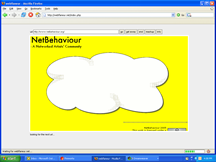
Webflâneur 4.0
Webflâneur 4.0 by Annie Abrahams & Clément Charmet :: A kind of compressed browsing, like sometimes those dreams, that condense the weight of a whole day in a single action, in which everything gets mixed. This feeling of "watching the cache" of our browser (the hidden?). A discovery tool that brings us back to the earlier ages of the web, when "flaner" was still possible.
Trotting the web guided by a travel software, going from one page to another without doing anything at all, immersing the data flow while observing its interior structure. Going in all directions, losing oneself, finding unexpected relations and gigantic domains that stick, places from where you can hardly escape. To stop and consult the list of the pages you visited, to have its plan, to be able to choose again. Having a possibility to generate at any moment a unique Mashup controlled by a random script. Images, texts, videos and sounds collected during your visit form an orgiastic collage.
If your stroll is very slow, please try another URL or come back at another moment of the day or find a faster connection.
Posted by jo at 04:34 PM | Comments (0)
BrainWaves
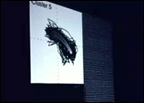
Neural Sounds
BrainWaves is a project of complex systems' data representation, like the human brain, developed at the Georgia Tech University by the students of neural engineering (prof. Steve Potter). The experiment is based upon the application of some pattern recognition techniques (through these techniques data - or patterns - are classified basing on a previous knowledge, or basing on statistical data retrieved from the patterns themselves), and it's inspired by our brain ability of perceiving and distinguish different audio samples. The neural activity (in a neuron's cultivation) subjected to sound stimulations is recorded through a series of electrodes and then played through eight speakers. The endeavor is of give a spatial propagation representation of the electric pulses into the cultivation. Moreover eight controllers allows an interaction with the neurons, simulating the pulse propagation starting from different cultivation points. The experiment is presented as an interactive music performance, and the aim of BrainWaves is not onlu to understand neurons' activities but also to construct a musical 'product' with its own aesthetic significance. - Vito Campanelli, NEURAL.
Posted by jo at 02:16 PM | Comments (0)
Urban Play

Call for Submissions
The city is paved with pixels, the flow of traffic becomes the flow of bits, the flow of people, the flow of electrons. Streets and circuit diagrams become meshed. The race has begun. Each one of us becomes a player in the game of the city, furiously manipulating the control pad, tapping buttons, flicking switches. Leaping from platforms, scaling the walls the concrete/media playground is before us. Hurtling around corners, lunging up surfaces, shooting through the streets. Join the rush and surge of the city, find new ways to play the game.
Trampoline invites you to participate in Urban Play, a one day event held on 23rd November in Nottingham, UK. Its objective is to merge video gaming, art and design with the investigation of the city space. The structures of the city are increasingly pervaded by new media with screens, cctv, electronic networks, mobile devices, implements often designed to control our movement through urban space and even to remove us from our surroundings. We wish to investigate how new media can form an even tighter relationship with our immediate environment challenge and subvert its conventional structures hacking the city.
Trampoline is searching for work which explores urban space and methods of play, in particular projects which combine these areas in examining and utilising new media elements of the city.
Trampoline invites you to submit proposals of urban games, creative computer games, video, interactive installation, audio guides, sound, music and performance exploring play, gaming, new media and the city.
The submission of participatory works which promote a high degree of audience involvement this includes informal exploratory workshops as well as completed projects is highly encouraged.
Key points to focus the proposal on are:
The relation between the work and the city
The element of play
and
Its encouragement of audience participation
How to Submit work:
Please fill in the Submission Form, downloadable from
http://www.trampoline.org.uk/Applicationform.doc
Submissions should include:
Images/documentation/videofootage
Description of work
CV
Please note for those submitting video works:
We would request that you send the full version of your video works in PAL avi data format if possible
Deadline to submit proposals is October 23rd 06
Submissions should be postmarked by this date
Please send your applications to:
Emma Lewis
Trampoline
14-18 Broadway Media Centre
Broad Street
Nottingham
NG1 3AL
UK
Posted by luis at 10:10 AM | Comments (0)
Rumour as Media
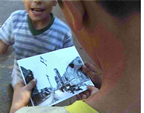
The Performative Power of Rumour
Rumour as Media :: 20 October 2006 – 21 October 2006 :: Opening: 26 Sept 2006, 6 p.m. :: Petra Bauer / Jochen Gerz / Lamia Joreige / Martha Rosler / Walid Sadek / The Speculative Archive / Ultralab™ :: Akbank Sanat, Istiklal Caddesi No. 14-18, Beyoglu - Istanbul :: Tel: +90 212 252 35 00 or +90 212 292 39 84. Discussion Forum: “How to do things with rumour”, Wednesday, 27 September 2006.
Rumour may be the world’s oldest media. What is more all-pervasive, more corrosive than rumour? Like its siblings, gossip and hearsay – or what is loosely referred to as “news” – rumour is not just the channel through which the subordinate classes vent their spleens against the rich and famous, spreading compromising half-truths about them. Nor conversely, is rumour merely the way in which the powers-that-be manipulate public opinion. If rumour is so corrosively effective, it is because it is itself a media.
Though rumour is characterised by its indeterminacy – its basic anonymity and lack of identifiable source or authentication protocol – rumours are performative. That is, they make things happen. As everybody knows, there is “no smoke without fire,” and once a person is stained by rumour, it is next to impossible for them to clear their name. It is for this reason that rumours have always proven so devastatingly effective in provoking panic and pogroms. Whether they spread from the outskirts to the corridors of power, or the other way around, rumours have terrified and inspired the common people no less than their rulers, sparking fear of war and reprisal, thirst for vengeance and retaliation. At the same time, rumours are always context specific. A rumour “flies” in one context though it would never leave the ground in another. This context specificity is linked to rumour’s indeterminacy. In short, precisely because it is by definition unauthored, rumour is what “people are s aying”, what’s “going around” or – to quote songwriter Leonard Cohen – what “everybody knows.” This is what makes rumour so impossible to suppress or control, and why in the age of the blogosphere, cell phones and media concentration, rumour has such a promising, and eminently ambiguous, future before it.
This exhibition seeks to document the performative power of rumour and to examine some of the ways in which seven contemporary artists and artists collectives have made use of that media to deconstruct, manipulate or exploit its fascinating power. In highly different ways, their works focus on rumour’s paradoxical capacity to build community, by instilling in its listeners an almost overwhelming urge to pass it on to someone else, drawing its participants into a collective rhetorical operation of confident uncertainty.
Curated by Stephen Wright
Posted by jo at 08:43 AM | Comments (0)
Blog? Project
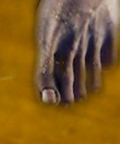
Blog as Platform for Creating Art
Blog? - exhibition at no-org.net is launched! :: Participant Artists: Cyrill Duneau, DVBlog, Mez, Eduardo Navas, Coyoteyip, Jhave, Confettis, Gustavo Romano, Bridgegirl.
Blog, one of the most spread forms of expression on the web -varying from personal diaries to community weblogs, professional knowledge exchange resources, political campaigns and more. In their different manifestations, blogs (moblogs, videoblogs, photoblogs, etc.), became a phenomenon influencing in many cases upon social and cultural areas: journalism, politics, alternative knowledge sources, literature, art, etc.
The blogs? project takes blog as art and as a stage for net artworks investigating the language, the aesthetics, the impacts and the practices of blogs, blogging and the blogoesphere. Blog? presents works utilizing the blog platform for creation of artwork. Works that break the conventional purpose of the platform, conveying a message or delivering data, by emphasizing poetical and aesthetic manifestations of blog, and by exposing capabilities of the blog as a platform for creating art. Blog-specific works.
Posted by jo at 08:21 AM | Comments (0)
September 20, 2006
International Airport Montello
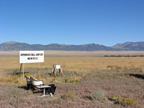
eteam CAUSES EXTENDED LAYOVER at IAM
eteam CAUSES EXTENDED LAYOVER at IAM :: International Airport Montello :: On Friday, September 15, 2006, an 8-passenger Beechjet 400 of AiG Airlines was on its way to Las Vegas for a weekend of art and gambling, when the pilots received a radio call about a sand storm in Nevada causing an unexpected 8-hour layover at the International Airport Montello (IAM).
Fortunately, IAM was prepared. The terminal’s food court and services were ready to serve, including the five star Juan’s Coffee Shop, the VIP Sky View Dinner Club, the Cowboy and Saddle Sore Bars. And IAM employees welcomed AiG Airlines passengers and other layover tourists with the utmost attention. Adventurous travelers and unique characters were among the passengers who were stuck at the IAM, adding to the distinctiveness of this layover. Despite that the IAM kept its air conditioning at extremely low temperature and its fans at high speed it was the perfect airport to experience an extended layover.
The International Airport Montello (IAM) is a project done in collaboration between the Brooklyn-based artist’s collective known as eteam and the citizens of Montello in Nevada. It takes place around a 10-acre piece of land purchased by eteam from an auction at eBay.com for less than $500 dollars. IAM consists of a series of recurring events in or about an abandoned airstrip—that is approximately 6000 feet and located nearby the eteam’s land—in order to reignite its use or potential.
During the summer, in a program at the New School’s Vera List Center for Art and Politics with writer Jeffrey Kastner and Matthew Coolidge of the Center for Land Use and Interpretation, eteam presented IAM to New York audiences. Weeks later, curators Jeffrey Walkowiak and Rachel Gugelberger of Sara Meltzer Gallery helped eteam turn that gallery’s penthouse into an airport gate, where passengers waited for hours to catch a plane that never came. Before the layover, IAM hired the Brooklyn-based artist and writer Jason Dean as one of its Layover Crewmembers, who together with eteam was present at the layover. In October, and thanks to park ranger Linc Hallowell, eteam will use the runways of Floyd Bennett Airfield in New York City to connect to the middle of nowhere where IAM operates.
These events, including the layover, are part of the eteam’s art project IAM, which will culminate in an exhibition at Art in General opening on January 27, 2006. The IAM wiki-website is created and administered by eteam and the citizens of Montello: www.internationalairportmontello.com
The International Airport Montello by eteam and the citizens of Montello is commissioned by Art in General. The website component of the project is co-commissioned by Art in General and the Digital Matrix Commissions of Longwood Arts Projects in New York.
Posted by jo at 11:33 AM | Comments (0)
Annie Abrahams
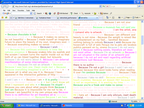
Am I an artwork? Performance
Am I an artwork? Yes, no, maybe. Suis-je une oeuvre d'art? Oui, non, peut-être.
Am I an artwork? was commissioned by the FRACLR in 2002. The piece (in perl) collected visitor reactions and traced them by IP to influence the colours of the page layout. This was a way to point to the fact that the visitor wasn't anonymous, something a lot of visitors weren't aware of in 2002. More important, and still actual, the piece permitted to openly ask if a piece of "net art" could be "art" on the site of an official French art institution.
On the 24th of September all the French entries of the piece will be read in public during a performance in the show called "Chauffe Marcel !" organised by the same art institution. Two microphones will be placed about 10 meters one from another. One will be used to amplify the "yes" phrases the other the "no" phrases.
Performance: lecture/combat :: 24 September 2006 11.00h, la Panacée, 14 rue de l'école de pharmacie, Montpellier, France. in the show "Chauffe Marcel ! " subtitle "L'imitation de Marcel Duchamp". Curator : Emmanuel Latreille, director of the FRAC Languedoc Roussillon. The performance will be followed by a special guided visit of the show by Emmanuel Latreille its curator.
Posted by jo at 11:19 AM | Comments (0)
www.res-qualia.net

CALL FOR ENTRIES
We would like to invite you to collaborate in res-qualia.net. You can introduce your projects or texts related to the themes: art-science and evolution of consciousness. www.res-qualia.net aims to create an working collaborative environment among artists that are working on the proposed themes. To know all the works that are related to this area and to make them public in different events such as conferences, press, publications, etc. We ask for your participation to know that your work "does exist".
Topics: -Digital-art-science-consciousness -Philosophy of consciousness -Cognitive psychology -Linguistics -Neuroscience -Qualia -Awareness/ Perception -Synaesthesia -Levels of consciousness -Spirituality -Meditation -Evolutionary systems -Emergent behaviors -Adaptive systems -Complexity -Artificial life -Artificial Intelligence -Natural phenomena -Genetics -Transgenic -Life Sciences -Astronomy -GPS technology -Robotics -Virtual Reality -Inmersive Environments -Augmented Reality -Gravity 0.
Posted by jo at 11:02 AM | Comments (0)
FURTHER PROCESSING
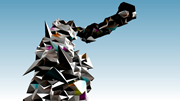
Generative Art, Open Systems
FURTHER PROCESSING: Generative Art, Open Systems :: Pablo Miranda Carranza (ES), Fabio Franchino (IT), Ben Fry (USA), Golan Levin (USA), Lia (AT), Mark Napier (USA), C.E.B. Reas (USA), Martin Wattenberg (USA), Marius Watz (NOR)
Opening: Sat 23.09.2006, 1.15 p.m. :: Duration: 23.09.-25.11.2006, Tue-Fri 2-6 p.m., Sat 11 a.m.-6 p.m. :: Venue: Kunstverein Medienturm, Josefigasse 1, A-8020 Graz :: Curators: Sandro Droschl, Marius Watz.
FURTHER PROCESSING uses the Open Source software "Processing" as a departure point to examine current positions in software-based art. Code is becoming an aesthetic material, with software as the new art object. The exhibition can be grouped into two loose positions: Generative Art and Data Art. The former sees the software system itself as an object of investigation, with algorithms and code structures becoming the framework and material for the work itself. The generative works present an aesthetic of complexity, concerned with formal explorations of spatial and temporal parameters. Ranging from the opulent to the minimalist, these pieces comfortably bridge the gap between an electronic image culture and traditions in drawing and painting.
Data Art positions the computer as mediator between humans and the increasingly complex information networks that surround us, using computational processes to make visible structures and patterns that go unseen by our natural senses. Data visualization thus becomes a pure art of the database, a new cultural artefact in a world of information.
Beside works of nine well known international media artists the software "Processing" will also be on display, so that visitors can try the tool and perhaps get a taste of code for themselves. After all, FURTHER PROCESSING is based on a continuous artistic discourse, of which the effects are reflected on an aesthetic, technological and discursive level.
Posted by jo at 10:55 AM | Comments (0)
The International Digital Art Festival

On the Edge
The International Digital Art Festival :: In November 2006 Denmark’s biggest international digital art festival so far, will be unrolled. The festival includes exhibitions, concerts and real-time events in a number of cultural institutions in Aarhus. Amongst the bigger international names are Critical Art Ensemble and Eduardo Kac, who both exhibit their work in Aarhus Kunstbygning from November 3.-26. and also participate in the festival’s seminar from November 4.-5. at Kasernescenen at Institute for Aesthetic Studies, University of Aarhus.
Critical Art Ensemble, USA, is known for its work on critical theory, bio tecnology and political activism. On May 11. 2004 Steve Kurtz, lecturer in Art History at University of Buffalo, co-founder and a member of CAE, was seriously in the searchlight of the authorities. Steve kurtz found his wife Hope dead from a heart attack and called 911. When the authorities came to his home, they found the materials that Kurtz and CAE so frequently had used at art arrangements all over the world. Due to the find/discovery of these materials, which can all be easily required, Kurtz was accused of bio-terrorism, in spite of the fact that it was only a contemporary art matter.
Eduardo Kac, USA/Brazil, is known for his creation of a luminous/flourescent green rabbit by means of a GFP gene. Eduardo Kac is one of the pioneers of the new art trend in USA: Biotech Art. By manipulating the gene material in living organisms, the artists are capable of making “living works of art”. Besides from the luminous/flourescent rabbit, Eduardo Kac has also created a tobacco plant, the leaves of which have an extra twist, making the plant sculpturally beautiful. The plant is a part of the artwork “Move 36”, which will be on show in Kunstbygningen during the International Digital Art Festival.
The International Digital Art Festival is divided into two sections:
Theme projects: The exhibition “On the Edge” and the seminar to match “Crime and Political Aspects in New Media Art” focus on the human curiosity and need of posing questions. The artists challenge the dominant structure and order represented by society in general, for instance by affecting the very goal-directed results of research and the technological and commercial product development. What is in question is art on the edge, that seeks to tickle and disturb the present order
Satellite projects: In a local network of cultural institutions, educational institutions and organisations that hold resources and experience on digital art, the festival and its collaboration partners present an excellent row of exhibitions, concerts and performances. Each location that covers the Festival will, as far as possible, illuminate digital art from their own point of view and proportional to the locations own perspective on the digital field. The satellite projects will among other places be shown at: The Centre for Advanced Visualization and Interaction, The main Library, Gallery Splab, Gallery Image, Aarhus Film Workshop etc.
The International Digital Art Festival, that will be launched in November 2006, is arranged by Kulturforeningen Pappagallo.
Curator
Annette Damgaard
International Digital Art Festival
Skt. Nikolausgade 4
8000 Aarhus C
info[at]digitalfestival.dk
Mobile phone: (+45) 60 64 18 16
Posted by jo at 10:12 AM | Comments (0)
Oslo's interfaces

Interface and Society
In our everyday life we constantly have to cope more or less successfully with interfaces. We use the mobile phone, the mp3 player, and our laptop, in order to gain access to the digital part of our life. In recent years this situation has lead to the creation of new interdisciplinary subjects like Interaction Design or Physical Computing.
Currently we live between two worlds, our physical environment and the digital space. Technology and its digital space are our second nature and the interfaces are our points of access to this techno sphere.
This division will dissolve into a seamless distribution of information technology into most aspects of our life, advertised as ubiquitous computing. Immaterial information and physical objects will fuse into an Internet of Things. Our world will transform into an interface as a whole.
Since artists started working with technology they have been developing interfaces and modes of interaction. The interface itself became an artistic thematic in its technical, social and political dimensions.
Interface and Society investigates artistic strategies and practices which deal with and build upon the transformation of our everyday life through information technology and electronic interfaces.
With the rapid technological development a thoroughly critique of the interface towards society is necessary. The contribution of the artist thereby is relevant. S/he takes the freedom to deal with technologies beyond form, function and usability. The utilisation of an eclectic range of strategies and practices guaranties a diversity of results.
EXHIBITION: 10th to 19th of November
PERFORMANCES AND EXHIBITION OPENING: 10th of November at 20h
PLACE: Henie Onstad Kunstsenter, Oslo, Norway
Art by Accident (Kalle Grude, Jan L�chst�er) (no)
Franz Alken and Karl Rueskaefer (de/uk)
Artificial Paradise (uk)
Norene Leddy (with technical lead Andrew Milmoe) (us)
Agnes Meyer-Brandis (de)
Silver
Daniel Skoglund (se)
Leonardo Solaas (ar)
Marius Watz (no/de)
CONFERENCE: 10th and 11th of November
Erich Berger (at/fi) - Interface and Society
Bruce Sterling (us/cs) - Spime: a map of ideas
Susanne Jaschko (de) - On the virtuality of public space
Laura Beloff (fi) - Not imagined, it is real
Per Platou (no) - Failure is success (is failure)
Truls Lie (no) - On Guattaris concept of the "machin" as the mental and social apparatus that directs our everyday praxis
Adam Greenfield (us) - Everyware: Some thoughts on the social and ethical implications of ubiquitous computing.
Artificial Paradise (uk) - Instruction Sets
Marius Watz (no/de) - It`s all about the software, baby
Sabine Seymour (at/us) - The Epidermis as Interface, Dynamic Textile Surfaces
Interface and Society is produced by Atelier Nord in collaboration with Henie Onstad Kunstsenter and Le Monde Diplomatique (Nordic Edition). Supported by Arts Council Norway and Freedom of Expression Foundation, Oslo. Trolleys provided by ISS Lufthavnservice AS
See http://www.anart.no for detailed information.
Posted by luis at 10:10 AM | Comments (0)
The Junction

Call for public art project
The Junction in Cambridge, UK, is seeking to commission an artist (individual or collective) to produce an innovative and exciting high profile public artwork encompassing new technologies for the south façade of its original auditorium. This is the second of two commissions funded by Turnstone Partners and Arts Council England East for the site, the first being Bins and Benches by Greyworld in 2005.
Expressions of interest are invited from artists, to be received before the 1st October 2006.
The budget for this commission is 60,000 (to include fee, production and installation costs). For more information, including a detailed brief, please see www.junction.co.uk/publicart.
Posted by luis at 09:58 AM | Comments (0)
Digital technologies in Lancaster
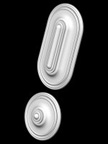
Perimeters, Boundaries and Borders
Fast-uk and folly have partnered to present the exhibition Perimeters, Boundaries and Borders which explores the possibilities afforded to artists, architects, designers, and others for the creation of new types of objects, buildings, and products stemming from the increasing use of and integration between digital technologies for design and fabrication. The converging and blurring of traditional disciplinary boundaries is made possible by these technologies, from rapid prototyping to the use of generative and algorithmic software for design.
Perimeters, Boundaries and Borders is an exhibition of contemporary arts and design practice. It is especially concerned with object and spatially oriented disciplines, the use of digital technologies and the convergence of sculpture, product design and architecture.
This exhibition will bring emerging and existing contemporary practitioners and technologies into the public arena and help to make cutting-edge developments in art and technology more accessible. 'Perimeters, Boundaries and Borders' will be held from 29 September - 21 October 2006 at venues across Lancaster city centre in the North West of England. The main exhibition space will be the new CityLab development in Dalton Square .
Perimeters, Boundaries and Borders features:
Gavin Baily & Tom Corby
Human Beans
Simon Blackmore
Brit Bunkley
Future Factories
Simon Husslein
Tavs Jrgensen
Aoife Ludlow
Geoffrey Mann
Justin Marshall
.MGX by Materialise
NIO Architecten
Adam Somlai-Fischer, Bengt Sjln & Usman Haque
Masaru Tabei & Yasuno Miyauchi
Ben Woodeson
Venue: Citylab, 4-5 Dalton Square, Lancaster LA1 4PP, 01524 582114
Date: 29 September 21 October, 12 - 5 pm, Mon Sat.
Perimeters, Boundaries and Borders Symposium
An opportunity to hear a selection of practitioners participating in the Perimeters, Boundaries and Borders exhibition talk about their work and discuss how digital technologies have enabled a convergence of disciplines, creative practice and production techniques.
This symposium is free, but booking is essential. To book, telephone 01524 388550 or email enquiries@folly.co.uk
Venue: St. Martin's College, Lancaster Campus, Bowerham Road, Lancaster LA1 3JD
Date: Thursday 28 September, 1 5pm followed by Private View: 6-8pm
Keynote: Dr. Paul Rodgers
Grow Your Own Media Lab in 3D - Julian Oliver
A free one day workshop on the use of Blender, an open source 3D graphics software package used for modelling, animation, post-production, interactive content creation and playback. Blender is available for all major operating systems and can be downloaded for free.
Julian Oliver is a New Zealand-born artist, free software developer, teacher, composer and media-theorist. He has presented papers and artworks at numerous international electronic art events and conferences, and has led workshops and master classes in game-design, virtual architecture, interface design, augmented reality and open source development practices worldwide.
This workshop is free, but booking is essential.
To book, telephone 01524 388550 or email enquiries@folly.co.uk
Venue: St. Martin's College, Lancaster Campus, Bowerham Road, Lancaster LA1 3JD, 01524 384384
Date: Tuesday 17 October 9:30am 4:30pm
www.blender.org www.selectparks.net
Perimeters, Boundaries and Borders is funded by Arts Council England, Lancaster City Council and Miriad.
Posted by luis at 09:40 AM | Comments (0)
September 19, 2006
PERFORMING PLACES seminar: media and embodiment in the urban environment

Call for participation
Call for participation :: PERFORMING PLACES seminar: media and embodiment in the urban environment :: Helsinki, November 7-9, 2006 :: Submission deadline: October 6, 2006 :: Notification of acceptance: October 12 :: Full papers due: October 31 :: Seminar opening/closing: November 7, 6 pm / November 9, 4 pm.
Seminar theme: The Performing places seminar will bring together researchers, artists and developers whose work touches on the experiential, affective and political aspects of urban and technological life, and who share an interest in inventive artistic and technical practices of the urban environment. The seminar addresses the current urban situation, where lived environments are undergoing major experiential and social changes, driven mainly by technical and economic pressures. Our aim is to create a forum for critical, transdisciplinary exchange by bringing to resonance a set of relevant themes:
1. Urban space, in its current versions, blends embodied and mediated forms, orchestrating everyday actions to an invisible score of signals and software. With ubiquitous computing, devices pervade our physical environments to trace and modulate behaviour, enabling new modes of service, surveillance and intervention.
2. Cities are increasingly shaped by the formation of 'creative clusters', according to innovation strategies which target an evolving experience industry and seek global competitiveness for a particular region or place. These strategies typically neglect embodied, affective or everyday aspects of the production of space - even if they often include programmes to advance citizen participation and social inclusion.
3. Artists and media developers have the possibility of addressing urban space in ways that prioritize its experiential, social and political contexts. Strategies of site-specific, community and performance art are complemented by the activity of media artists and designers, producing interventions and applications that can capture the collective dimensions of our experience and render them palpable.
4. Recent theories in human geography and the cultural study of technology highlight the affective and relational qualities of the urban/technological environment. In their focus on the performative and collective aspects of use and production, these theories challenge dominant views of representation and innovation, proposing more event-based and mobile accounts of inventive agency.
Participation
The seminar invites participation from all relevant disciplines, especially from practitioners and researchers in
*media, performance and urban arts
*IT design and and urban planning
*urban and media studies.
The aim is to build conceptual links and exchanges between disciplines, in order to produce a critical framework with real relevance for urban practice, research and policy. For this reason the seminar will take the form of parallel workshops, with short presentations and a collaborative development of issues. Project demonstrations are warmly encouraged - but the main objective is to move beyond presentation and arrive at a problematization of practices. Of special interest are contributions discussing, for example:
*Performativity and performance - embodied, affective and non-representational practices in media, arts and sociality;
*Ubiquitous interaction - collective, participatory agency in urban interactions;
*Affected places - art and media interventions in the physical and virtual environment;
*Urban media experience - audiovisual, mobile and network media in the production, consumption and experience of places;
*In/visibility - techniques and practices of representing and making visible, from infrastructures to surveillance to performance;
*Critical urban practice - critical artistic and technical practice in the urban sphere; perspectives on production, coding, design, planning and development.
How to participate
Submissions should include 1) Title, 2) Keywords 3) 500-word abstract 4) Selected bibliography and 5) 200 word cv of presenter.
They should be sent by October 6, 2006 to informer[at]m-cult.org as pdf or rtf attachments.
Notification of acceptance is October 12 and full papers due October 31, 2006.
For further information, contact Minna Tarkka: minna tarkka [at] m-cult [dot] org
Invited speakers and artists
Nigel Thrift, University of Warwick, Human Geography
http://www.geog.ox.ac.uk/~kstraus/thrift/biography.html
Sally Jane Norman, Newcastle University, Culture lab
http://www.ncl.ac.uk/culturelab/people/sally-jane-norman.htm
Adrian Mackenzie, Lancaster University, Institute for Cultural Research
http://www.lancs.ac.uk/staff/mackenza/
Hille Koskela, University of Helsinki, Department of Geography
http://www.helsinki.fi/maantiede/kaumaa/Hille_eng.html
Invited artist-researchers
Pia Lindman, performance artist, Fellow, MIT Centre for Advanced Visual Studies
http://web.mit.edu/pialindman/
Ari Tenhula, choreographer, researcher, Theatre Academy of Finland
http://www.aritenhula.net/
Heidi Tikka, media artist, researcher, Media Lab UIAH / USED
http://mlab.uiah.fi/~htikka/
Organisers
The seminar is organised in context of USED (Urban Spaces and Experience Design), an arts and research interaction project carried out by m-cult and HIIT and funded by the Academy of Finland and the Arts Council of Finland. The co-organising partners are:
m-cult centre for new media culture, Minna Tarkka
http://www.m-cult.org
HIIT Helsinki Institute for Information Technology, Giulio Jacucci
http://www.hiit.fi
Helsinki University of Technology, Urban and Regional Studies, Panu Lehtovuori
http://www.tkk.fi/Units/Separate/YTK/
Theatre Academy of Finland, Performance studies, Annette Arlander
http://www.teak.fi
University of Art and Design Helsinki, Environmental Art, Alan Prohm
http://www.uiah.fi/page.asp?path=1866,1915,4118,9086,9089
University of Art and Design Helsinki, Media Lab, Lily Diaz
http://www.mlab.uiah.fi
Posted by jo at 06:48 PM | Comments (0)
Protections. This is Not an Exhibition
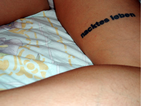
Traumas and Pleasures of Life in a State of Emergency
Protections: This is Not an Exhibition :: Co-production between Gutshaus Kranz and steirischer herbst 2006 :: Curators: Adam Budak, Christine Peters :: Opening: Sat, September 23, 11am :: September 23 – October 22, 2006, Tue - Sun 10am – 6pm, Thu 10am – 8pm :: Gutshaus Kranz, Lendkai 1, A–8020 Graz :: T +43-316/8017-9200, F -9212 :: info[at]kunsthausgraz.at
A strive for safety, a constant need of security and a basic demand for care and comfort are in focus of this project which resists to be yet another exhibition. Here, no fixed points but rather a dynamic structure which bridges visual arts, performance, theatre and architecture constitutes a platform to renegotiate elemental aspects of the contemporary beyond-modern life.
From a subversive architectural gesture of Elmgreen & Dragset (prefabricated houses as a design platform for other artists’ projects), through laboratory cinema of Moser & Schwinger (a specific location set for still new episodes of good soldier Schwejk) and a vertical stage of Markus Schinwald’s Stage Matrix II (impressive site for a non-stop spectacle of everyday choreography) to the MUSU, Apolonija Sustersic’s Museum-Bus (a mobile architecture on the route between Ljubljana and Graz as a fictive Slovenian Museum of Contemporary Art) and invisible and gentle performative act of Roman Ondak (The Stray Man, performed everyday in front of the Kunsthaus Graz) and Kris Martin with his endless landscape staged on the Gutshaus Kranz inner skin – such is a maze of events and situations in the shell of a temporary Gutshaus Kranz carousel of identity.
As a project-in-progress, Protections does not protect the viewer by providing him/her with the final product of conventional exhibition making. It allows to follow the development of a concept spread in time and space and executed by the artists in a close encounter with the audience. Its composition - as a storyboard - challenges the usual perceptive habits and it invites to explore the museum space in a participatory way. As such, Protections. This is Not an Exhibition generates a situation which turns the museum into both a meeting place and a site of discovery.
As an ongoing anti-spectacle, Protections does protect the viewer and his/her desire to reflect upon the museum and its (social and cultural) function in the most independent and autonomous way. The performative character of artistic proposals as well as the organic process of collected events guarantee an experience of duration and involvement. Simultaneously, it offers and seeks for temporary shelter whilst creating a non-stable construction site: here the attentiveness is put at stake and the fragility of spectatorship is exposed. Thus the site becomes a playground for staging the relations of public and private nature and producing the knowledge on the practice of everyday life.
As such Protections is a polyphonic edifice where a variety of artistic activities is being inhabited: from architectural interventions, through performances, theatrical forms and performative installations, down to visual contributions that include film and video as well as conceptual and discursive studies. The complex and provocative architecture of the Gutshaus Kranz as well as the social and cultural milieu of the city constitute the matrix for all artistic approaches gathered within this project thus turning into a site-specific event.
Participating artists: Cezary Bodzianowski, the Centre of Attention, Katrina Daschner, Elmgreen & Dragset, Tim Etchells, Vlatka Horvat, Christian Jankowski, Marysia Lewandowska & Neil Cummings, Katarina Löfström, Daria Martin, Kris Martin, Frédéric Moser & Philippe Schwinger, Warren Neidich, Roman Ondak, Elisabeth Penker, Philippe Rahm, Markus Schinwald, Dejan Spasovik, Apolonija Sustersic, Mark Wallinger, Markus Weisbeck, Herwig Weiser
A comprehensive Reader in English and German has been published on the occasion of Protections (with contributions from Marius Babias, Zygmunt Bauman, Beatrice von Bismarck, Adam Budak, Jordan Crandall, Claire Doherty, Jean Fisher, Elisabeth Grosz, Nikolaus Hirsch, Veronica Kaup-Hasler, Peter Pakesch, Christine Peters, Irit Rogoff, Stefan Römer, Renata Salecl and Michael Terman).
Protections. This Is Not an Exhibition is accompanied by a very intense programme of events, Gutshaus Unplugged , grouped in four sections: CURATING AS PERFORMANCE or yet another Protections vernissage; GUIDED (PROTECTION ARTIST) TOURS AS PERFORMANCE or a subjective view of an insider; BOOK AS PERFORMANCE or staging a source material; PERFORMATIVE LECTURE or discursive qui pro quo.
Tuesday, September 26, 6pm
Curating As Performance: Florian Zeyfang, artist and curator/Berlin:
break in / break out and Proprio Aperto.
Wednesday, September 27, 3pm and 6pm
Guided (Artist) Tour As Performance: Philippe Rahm, architect/Paris
focus: architecture and ambiance.
Thursday, September 28, 6pm
Book As Performance: Maria Lind, IASPIS/Stockholm in conversation with Søren Grammel, Graz: Curating with Light Luggage, REVOLVER 2005.
Saturday, September 30, 5-7pm
Special Event At The Generosity Broadcasting House: Marysia Lewandowska & Neil Cummings, artists,/London: Open Content Film Culture.
Tuesday, October 3, 7pm
Curating As Performance: Sören Grammel, Grazer Kunstverein & Luca Frei, artist/Sweden: Installation and Presentation of SPARKS.
Wednesday, October 4, 3pm and 6pm
Guided (Artist) Tour As Performance: Elisabeth Penker, artist/Vienna
focus: sound and language.
Thursday, October 5, 6pm
Book As Performance: Claire Doherty, University of the West of England/Bristol: Contemporary Art - from Studio to Situations, Black Dog Publishing, 2005 with a screening of Guy Debord's films and Jeremy Deller's The Battle of Orgreave.
Friday, October 6 – Saturday, October 7
Walk-In-Progress: With participation of Claire Doherty, Apolonija Sustersic, Bojana Kunst, Christine Peters and Adam Budak and featuring students of the Schauspielinstitut, Kunstuniversität Graz.
Saturday, October 7, 6-8pm
Special Event At The Generosity Broadcasting House: Eileen Simpson & Ben White, artists/London: Open Music Archive.
Tuesday, October 10, 6pm
Curating As Performance: Barbara Steiner, Gallery for Contemporary Art/Leipzig: Spaces of Negotiations with AS IF Architekten/Wien, Berlin.
Wednesday, October 11, 3pm and 6pm
Guided (Artist) Tour As Performance: Markus Schinwald, artist/Vienna
focus: performance and theatre.
Thursday, October 12, 7pm
Performative Lecture: Jordan Crandall, media artist and theorist/Los Angeles:
Ready for Action!
Friday, October 13, 3pm
Performative Lecture: Beatrice von Bismarck, Academy of Visual Arts/Leipzig:
Making Exhibitions - Processing Relations.
Saturday, October 14, 2-10pm
Special Event At The Generosity Broadcasting House: MaMa, Club/Zagreb:
Skill Sharing.
Tuesday, October 17, 6pm
Curating As Performance: Nikolaus Hirsch (co-curator), architect/Frankfurt & Anton Vidokle, artist, Berlin: United Nations Plaza.
Wednesday, October 18, 3pm and 6pm
Guided (Artist) Tour As Performance: Warren Neidich, artist/New York, Berlin
focus: Phenomen(a)logic Urbanism. An Ontotopologic Journey.
Wednesday October 18 – Saturday, October 21, daily 10am-6pm
Book As Performance: Seminar and Workshop :: Nina Möntmann, curator and writer/Hamburg & Jan Verwoert, art critic/Berlin: Art and Institutions. Current Conflicts and Collaborations, Black Dog Publishing, 2006
Friday, October 20, 5pm
Discussion: Subtle Environmental Influences on Mood, Sleep an Alertness
Michael Terman, Department of Psychiatry, Columbia University/New York in a discussion with Anna Wirz-Justice, Centre for Chronobiology, Psychiatric University Clinics/Basel, Michael Lehofer, Med Uni/Graz and Colin Fournier, architect/ Bartlett School of Architecture, London
Workshop: with Michael Terman and Ann Wirz-Justice and students from Architectural Association, London, ECAL, Lausanne and Technical University, Graz. 3-4.30pm.
Posted by jo at 06:33 PM | Comments (0)
Sendung
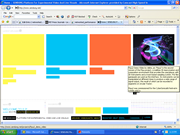
a platform for Live Visuals and Experimental Video
As a platform for Live Visuals and Experimental Video, initiated and run by Marcus Wendt and Vera Glahn, Sendung serves an on- and offline community via its virtual gallery and web features as well as events and workshops in real time and space.
Sendung brings artists and designers from different fields, countries and levels together to discuss and develop their work. Posted comments, critiques and reviews intend to help raising a serious discourse on this very hybrid art genre. We pay special attention on the maintenance of the site and the project´s network to make Sendung both an enjoyable showcase and a useful tool for artists and designers as well as curators, producers and facilitators. Visit us from time to time and be sure to find some inspiration!
Join In: Find latest contributions on the frontpage gallery; browse the Archive for more and make use of the advanced search to find topics, contributors, and countries by tags. Get your own selection as a Videocast and never miss a new upload by your favorite artist or in a certain genre. Post your own videos and make Sendung a stage for your own work! Recordings of big event performances and bedroom jamsessions are as welcome as non-live-experiments. Registration and Upload for Sendung are foolproof!
Posted by jo at 06:21 PM | Comments (0)
PENINSULA

Contemporary Media Arts Commissions
Independent Photography invites you to a evening showcase of PENINSULA, contemporary art exploring the Greenwich Peninsula :: Thursday 5th October 2006, 6.30pm:: Greenwich Yacht Club, 1 Peartree Way, London SE10 0BW. :: info[at]independentphotography.org.uk :: 20 8858 2825.
PENINSULA is a programme of contemporary media arts commissions by Independent Photography. The showcase will present: Greenwich Emotion Map: Mapping how people feel about the Peninsula by Christian Nold :: Exploring the peninsula through personal journeys, participants have recorded their responses to the area using biological tracking devices and digital tools, producing a new emotion map of the peninsula.
Accidental Holiday: A guide to thriving on the Peninsula by Lottie Child :: Taking inspiration from feral life, councillors, residents, developers and school children have collaborated with the artist to investigate what people need to thrive on the peninsula. The work explores playful, challenging, nuturing and risky activities, including constructing shelters and feeding off the land.
Peninsula Voices: A GPS sound walk of Peninsula life and politics by Daniel Belasco Rogers / Plan b :: A sound walk using GPS and handheld computer devices to explore the Peninsula Ward. As you walk, you hear voices recounting insights, events and memories of the landscape around you.
Gasworks to Dome: An online archive of Peninsula history by Rib Davis & Tom Keene :: A new website encouraging exploration and contribution to the history of East Greenwich and the peninsula within living memory. It presents oral histories, old photographs, and new digital images of the area as an open archive inviting contributions from the public.
Peninsula.me.uk: New tools for community communication by Comwifinet: A research project bringing residents and workers together to share information about what's happening to the area and to discuss their interests and issues. Participants are learning new self-publishing (blogging) tools, community website tools (CMS/Joomla) and email/web-based discussion lists (phpBB).
Posted by jo at 02:02 PM | Comments (0)
The Department of Network Performance
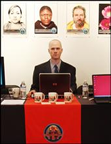
Arts 404.JO
Open Enrollment 9.19.2006 :: The Department of Network Performance :: Network Performance - Arts 404.JO :: Times: Ongoing, Always, 24-7 :: Professor: C. Peppermint, Dept. of Network Performance :: Fall 2006 - current.
Course Outline: This is not MySpace. This is Arts 404.JO, simultaneously a networked course and performance intended to assist students in the conceptualization, development, and implementation of online instances of networked performance-art practices.
PLEASE NOTE: This course is intended as a restless, evolving, active-media template for researching, exhibiting, coding, creating, and building network performances. Arts 404.JO is NOT a vehicle for commercial, corporate, individual, or self-promotion. Arts 404.JO is not a course for simply displaying one's works. This course is a network performance unto itself. Unexpected solutions are encouraged, i.e. works that follow the exercises provided in the syllabus but attempt to push that structure into realms of creative play.
Course Requirements and Objectives: (1) Arts 404.JO is an information-arts course titled "Network Performance Art - Arts 404.JO" Arts 404.JO is intended for: Artists, Hackers, Cultural Purveyors, Imaginative Housewives, Creative Construction Workers, Creative Workers, Creative Chocolatiers, Urban Homesteaders and Back to the Land Types, Special Teachers, Special Education Teachers Who are Fighting Corporate / State Mandates, Cosmopolitan Farmers, Innovative People and Animals, Eco-minded Global Citizens, Cultural Readers, Whole Food Eaters, Savvy Art Critics, Curators, and Art Historians Who Aren't Afraid to Ride In The Back of Pick-up Trucks, Cyborg Mycologists, AIs Masquerading As Musicians, Information DJs, Print-makers, Painters and Ceramicists Who Set Information Free, etc.
Posted by jo at 10:03 AM | Comments (0)
8 BIT
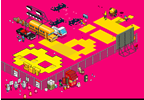
A Hybrid Documentary about Video Games
8 BIT is a hybrid documentary examining the influence of video games on contemporary culture. A mélange of a rocumentary, art expose and a culture-critical investigation, 8 BIT ties together seemingly disconnected phenomena like the 80’s demo scene, chiptune music and contemporary artists using machinima and modified games.
Produced in NYC, LA, Paris and Tokyo, 8 BIT brings a global perspective on the new artistic approaches of the DIY generation which grew up playing Atari and Commodore 64. Some of the artists featured in 8 BIT include Cory Arcangel, Bit Shifter, Bodenstandig 2000, Bubblyfish, Mary Flanagan, Alex Galloway, Glomag, Paul Johnson, John Klima, Johan Kotlinski, Nullsleep, Joe McKay, Tom Moody, Akiko Sakaizumi, Eddo Stern, TEAMTENDO, Treewave and Carlo Zanni.
With the help of media critic Ed Halter and new media curator and writer Christiane Paul, these very recent artistic strategies are put in the historical context of modernist and postmodernist discourse and examined as potential examples of a transition into fresh, uncharted territory. 8 BIT insists that in the 21st century Game-Boy rock, machinima and game theory belong together and share a common root: the digital heritage of Generation X.
Posted by jo at 09:28 AM | Comments (0)
My Favorite Things: The Joy of the Gizmo
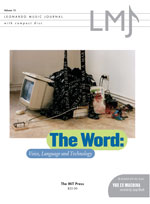
Call for papers
Leonardo Music Journal 17 (2007) Call for papers :: My Favorite Things: The Joy of the Gizmo :: If, as Marshall McLuhan so famously suggested, the medium is the message, then the gizmo must be the one-liner. From baroque violinists to laptoppers, sound artists have long fetishized the tools of their trade, the mere naming of which can provoke an instant reaction: Shout "LA-2A," "TR-808," "JTM45" or "Tube Screamer" in a room full of musicians, and you will notice the eyes brighten, the breath shorten and the anecdotes pour forth. But only to a point: Many a "secret weapon" is held close to the chest.
This is the chance to get that secret off your chest: LMJ 17 will address the significance of physical objects in music and sound art in a time of increasing emphasis on software and file exchange. We are soliciting papers (2,000--5,000 words) and briefer artist's statements (500-1,000 words) on the role of purchased or homemade instruments, effect boxes, pieces of studio gear, "bent" toys, self-built circuits, and so on, in your work as a composer, performer, artist, producer, recording engineer, etc. Wherever possible, please include photographs of your subjects (300 ppi TIFFs preferred).
Please submit a brief proposal by 1 October 2006. Final texts and all materials (text, image, sound file) must be received by 1 January 2007. Contact Nicolas Collins ncollins[at]artic.edu with any questions. Finished articles should be sent to the LMJ Editorial Office at lmj[at]leonardo.info.
Posted by jo at 08:26 AM | Comments (0)
September 18, 2006
Marcel.lí Antúnez Roca
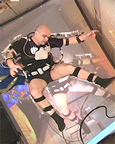
Transpermia
Performance calendar :: A mechatronic conference presenting the Dedalus project and its micro performances at zero gravity as well as the Transpermia theory.
Using the Space Station as a metaphor, Marcel.lÌ Ant·nez Roca has developed a hybrid show alternating performance, concert and lecture. It is structured in different modules. During the show Ant·nez wears his Dreskeleton (an exoskeletal body interface) and with it he samples, activates and modulates sounds as well as controlling the films projected on two screens. In the first module he presents some of the mechanical aspects characteristic of his work such as the Fleshbots, the Dreskeletons, the Biometries and the Systematurgy. The second module takes us through recurrent images in his work. The third module reveals the end result of the process of preparation for the Dedalus project in Star City in the Russian Federation as well as the micro performances that were carried out during periods of microgravity provided by the parabolas.
In these micro performances we witness the Requiem bodybot experiment and the interaction between the dreskeleton, the softbot and the interactive films. The last module presents the Transpermia theory and at this point the performance becomes more like a conference. Ant·nez proposes a new landscape for a Utopia called Transpermia. He describes some of his prototypes organized in 4 sections:
1 Interface: new devices with which to perceive the world and take part in it
2 Robots: machines as metaphors for life
3 Fleeting Identities: transitory states of personality as a setting for new experiences and knowledge
4 New Creations: models of activity in the Transpermia Utopia.
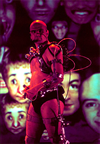
Marcel.lí Antúnez Roca (Moià, 1959) is well-known in the international art scene for his mechanotronic performances and robotic installations. In the nineties his avantguard mechatronic performances combined such elements as Bodybots (body-controlled robots), Systematugy (interactive narration with computers) and dresskeleton (the exoskeleton body interface). The themes explored in his work include: the use of biological materials in robotics, as in JoAn? l’home de carn (1992); telematic control on the part of a spectator of an alien body in the performance EPIZOO (1994); the expansion of body movements with dresskeletons (exoskeletical interfaces) sed in the performances AFASIA (1998) and POL (2002); involuntary choreography with the bodybot REQUIEM (1999); and microbiological ansformations in the installations RINODIGESTIO (1987) and AGAR (1999). He is currently working on the spatial and utopian artwork TRANSPERMIA.
In the early nineties his performance EPIZOO caused a commotion in the international art scene. For the first time a performer’s body movements could be controlled by the audience. By operating a videogame, a spectator interacts with the bodybot worn by Antúnez, moving his buttocks, pectoral muscles, mouth, nose and ears. This performance stresses the ironical, and even cruel, paradox rising from the coexistence between virtual digital iniquity and the performer’s physical vulnerability.
Since the eighties, Antúnez’s work has been based on a continuous observation of how human desires are expressed and in what specific situations they appear. First in the tribal performances of La Fura del Baus and later, on his own, he expressed this interest by creating complex, in many cases hybrid, systems hard to classify. Antúnez’ works belong to the fields of both visual and scenic arts.
From the early nineties, the incorporation and transgression of scientific and technological elements in Antúnez’ work, and their interpretation by means of unique and specific devises, have produced a new cosmogony - warm, raw and ironic - of traditional themes such as affection, identity, or death. In his works these elements take on an extremely human dimension that causes a spontaneous reaction in the audience. He was also founding member of La Fura dels Baus, he worked in this company as art co-ordinator, musician and performer from 1979 to 1989, and presented the group’s macro-performances ACCIONS (1984), SUZ/O/SUZ (1985) and TIER MON (1988).
Posted by jo at 04:51 PM | Comments (0)
Connecting Worlds

Creative Possibilities of the Networking Age
09.15-11.26.06 :: Connecting Worlds, the first exhibition after the renewal of NTT InterCommunication Center[ICC] focus on the "communication", with contributions exploring the creative possibilities that emerged out of the new environments of the networking age.
'As the first exhibition since the reopening of ICC, this show raises-from the horizons of art and programming-practical alternative possibilities of various phases of communication that we currently see around us. This exhibition features artwork and projects that take a unique step into contemporary networks, politics, economies, physiology, or urban environments by manipulating sound, games, the Internet, or other media as well as foreseeing artwork created in the past.' Yukiko Shikata, curator
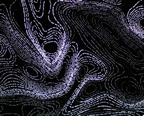
cyclone.soc by Gavin BAILY + Tom CORBY, UK 2005 :: CYCLONE.SOC brings together two contemporary phenomena: (1) severe weather, the project uses weather data that charts the emergence and progress of hurricanes; (2) the polarized nature of debate that occurs in certain online newsgroup forums. The project maps textual conversation taken from the political and religious newsgroups to the isobars of a dynamic, interactive weather visualization of hurricanes - whose complex structures are used to visualize the conversational churn and eddies of the newsgroup conversations.
In staging these interactions as a process of meteorological precipitation, newsgroup conversations "condense" in the works environment as a temporal ambient patterning - a structuring that acts not only as a metonym of difference, but of ideological tensions which mirror the dynamics of social space. CYCLONE.SOC is a navigable environment that gives the user the ability to zoom in or out and skate across and through the cyclonic weather formations in order to read or be immersed in the newsgroup text.
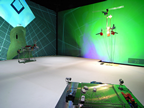
OBJECT B by exonemo, Japan 2006 :: OBJECT B 2006 Yamaguchi Center for Arts and Media (YCAM) YCAM InterLab Installation presenting a modified first-person 3-D shooting game with kinetic objects and a virtual-reality setting. Installed inside the three-dimensional environment created through projections onto all four walls of the exhibition space, are three objects made of keyboards, mice, and other computer parts and electric tools, and a control terminal for players. The robots' (programmed) frequent violent actions trigger automatic commands, according to which the game develops.
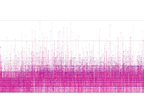
MaSS (Market as Speed Spectra) by MaSS Dev., Japan 2006 :: In e-trade, there are cases in which up to 1,000 "ticks" (contracts made when seller and buyer agree on a price are being counted per second?DThis work extracts log data of daytrade, where instantaneous decisions are being made based on numbers displayed on the computer monitor?Cand transforms the speed and rhythm of such transactions into sound and light. "MaSS" likens the steady high-speed exchange of data in e-banking to a worldwide network of reflex nerves.
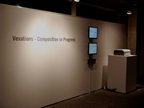
Vexations-c.i.p. (Composition in Progress) by MOHRI Yuko + MIHARA Soichiro, Japan 2005 :: "Vexations - c.i.p.(Composition in Progress)" 2006 transmediale 06, Berlin This work presents "Vexations", an odd piano piece of a single phrase repeated 840 times, originally composed by Erik Satie in the late 19th century, interpreted through an automatic, computer-controlled looping system. While incorporating modifications caused by data of environmental noises recorded with microphones at the venue, the software automatically generates new scores, based on which the piece gradually changes as the performance continues.
Artists include: ambientTV.NET (AT/IN/UK) / Wayne CLEMENTS (UK) / Robert DAVIS + Usman HAQUE (UK) / exonemo (JP) / Peter FISCHLI & David WEISS (CH) / Muntadas (UK/SP) / MaSS Dev. (JP) / MOHRI Yuko + MIHARA Soichirou (JP) / Newtype Technology Lab. (JP) / Dennis OPPENHEIM (UK) / Manuel SAIZ (UK/SP) / TANO Taiga (JP).
Posted by jo at 04:18 PM | Comments (0)
Insectopia:
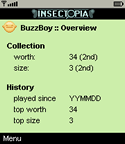
Context-Aware Gaming
insectopia is a new kind of cell phone game where the real world spills into the game world. Players roam the cityscape searching for and catching a multitude of different insects. Each insects in the game world is generated by using the available bluetooth devices available in the player’s vicinity. By catching insects and trading them with other players, players build their own collection bigger and better. The current status of the game is displayed on various highscore lists both in the phones and online.
See also geoquiz, a location-based mobile game in which players create and answer questions related to their current geographic position (kept track of through the GSM network). [blogged by Nicolas on pasta and vinegar]
Posted by jo at 03:42 PM | Comments (0)
Monument (If it Bleeds It Leads)
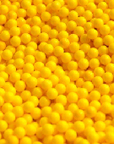
XML Graveyard
A recent project by Seattle artist Caleb Larsen harnesses RSS feeds to document the news media's cynical exploitation of readers' lust for tragedy. Titled after a newsroom cliche, Monument (If it Bleeds It Leads) scans a Google News feed for the word 'killed' and accompanying statistics about the number of dead. The figure is sent to a toy that shoots brightly colored plastic pellets from the ceiling of a gallery space, dispensing a pellet for every death reported. Sometimes the pellets come one at a time, sometimes 1,500 are fired. As one waits for the next wave to fall, the anticipation associated with viewing kinetic sculpture becomes a metaphor for a fascination with bloody news stories. In the sculpture, actual tragedy is eclipsed by a desire for an aesthetic experience in the same way that tragedy vanishes behind the spectacle of a gristly headline. But far from simply moralizing about media cynicism and public bloodlust, as the pellets pile up, the project becomes a sobering memorial. Once it hits home that each yellow sphere represents an actual life lost, the project creates an occasion to reflect on deaths that had once become sensational abstractions streaming over the Web. - Bill Hanley, Rhizome News.
Posted by jo at 10:32 AM | Comments (0)
MTV's Virtual Laguna Beach

Not in the Real World Anymore
September 18, 2006 :: Not in the Real World Anymore by RICHARD SIKLOS, The New York Times.
At MTV, reality has always been a moving target. Sixteen years ago, the network heralded the era of reality television with “The Real World.” Three years ago, it pushed the genre further with “Laguna Beach: The Real OC,” in which the mundane lives of a clique of pretty teenagers were presented in a way that appeared scripted and dramatic.
Now the cable channel aims to push the boundaries of false reality one step further. This week, MTV will introduce Virtual Laguna Beach, an online service in which fans of the program can immerse themselves — or at least can immerse digitized, three-dimensional characters, called avatars, that they control — in virtual versions of the show’s familiar seaside hangouts. “You can not only watch TV, but now you can actually live it,” Van Toffler, the president of the MTV Networks Music, Film and Logo Group, said in an interview.
Wednesday’s introduction of Virtual Laguna Beach is the first of three virtual worlds that MTV plans over the next year as part of an effort to steal a march on popular Web sites like MySpace and YouTube that have diverted the attention of the MTV audience. ... Of the two other virtual worlds planned, VMTV is a music destination where visitors can club-hop among hip neighborhoods, buy music, watch videos, sing karaoke or even start their own bands. The third virtual destination, LogoWorld, an offshoot of Logo, the gay and lesbian cable channel, will be designed entirely by its participants.
While avatars and virtual communities are a puzzling concept to many people over, say, 35, they are old hat to players of video games and to young people accustomed to revealing details of their lives online through social networking Web sites. Avatar-based social Web sites like Sims Online, Second Life and There.com have attracted hundreds of thousands of users.
[...]
“Our content is a starting point for them, not an ending point,” said Jeffrey B. Yapp, an MTV Networks executive who helped oversee the project. “There’s been a lot of discussion about letting go.”
[...]
To design Virtual Laguna Beach and the other forthcoming 3-D online communities, MTV enlisted Makena Technologies, the creator of There.com. Henry Jenkins, a professor at M.I.T. and the author of “Convergence Culture,” said such virtual communities were a natural next step for mainstream media companies seeking to deepen their connections to fans.
He said “Laguna Beach” was an interesting choice for the first venture because it had a heavily female audience and because the show itself was such a blur of real, unreal and sort of real. “It’s just layer upon layer of reality and fiction,” Mr. Jenkins said.
Some 22,000 people, drawn from a pool of 600,000 “Laguna Beach” watchers who registered for fan clubs on other MTV Web sites, signed up to participate in the test phase of Virtual Laguna Beach. Several hundred of those are designated as volunteer “lifeguards” who greet new arrivals online.
Cast members from the television show’s three seasons are not part of the planned online experience, although they could come as avatars of their own making.
Visiting Virtual Laguna Beach requires registering at the Web site, www.vlb.mtv.com, and downloading a piece of software. The first step is designing your avatar — which can be made to look as much like or unlike your actual self as you wish. During a demonstration last week at MTV, Mr. Bostwick played the role of an avatar named Violet Jade whom he configured — scrolling through an extensive menu of eye shapes, hair colors, skin tones and so on — to look like a typical character on the show: blond, tan and scantily clad.
[...]
“MTV speaks uniquely to a group of people who are endlessly fascinated with watching themselves,” she said.
Posted by jo at 09:53 AM | Comments (0)
OneWebDay

The Web is worth celebrating
OneWebDay is one day a year when we all - everyone around the physical globe - can celebrate the Web and what it means to us as individuals, organizations, and communities.
As with Earth Day - an inspiration and model for OneWebDay - it’s up to the celebrants to decide how to celebrate. We encourage all celebrations! Collaboration, connection, creativity, freedom. By the end of the day, the Web should be just a little bit better than it was before, and we’ll be able to see our connection to it more clearly. OneWebDay is September 22 every year, starting in 2006. If you write about OneWebDay or take a picture related to OneWebDay, tag it onewebday and it will show up on this site.
If you’re interested in being part of a project to celebrate the net on OneWebday, go to the ProjectWiki. If you’d like to coordinate a project, let us know and we’ll help find people for you to work with. If you’d like to sponsor a project, by providing computing resources or money, go here and let us know. This site is serving as a clearinghouse for projects, helping to match people to ideas (and ideas to people). [via Random]
Posted by jo at 09:25 AM | Comments (0)
RELAX

we save what you give
Verlag für moderne Kunst Nürnberg presents RELAX (chiarenza & hauser & co) – we save what you give, ed. by Irene Müller, Ilka and Andreas Ruby, Emanuel Tschumi, Susann Wintsch, Zurich / Nuremberg.
The collaboration between Marie-Antoinette Chiarenza (*1957, Tunisia) and Daniel Hauser (*1959, Bern) began in the 1980s in Paris at the squatter-occupied Giraud-Phares factory. Since the beginning of the 1990s they increasingly worked on projects in public space, respectively art-on-architecture projects. During their 1997-2001 collaboration with the city-and-landscape planner Daniel Croptier (*1949, Biel-Bienne), they changed their name to RELAX (chiarenza & hauser & croptier) Since 2003 the artists have lived and worked in Zurich; their works and projects trade under the name RELAX (chiarenza & hauser & co), whereby the “co” stands for partners who change according to the project.
In its works, RELAX occupies an artistic position that since the 1980s has sought out in-between spaces, infiltrated them, posed irksome questions as to economic connections and their cultural impact and examined social links and patterns. The research the artists instigated, their coming-to-grips with societal, political and social questions, their stand vis-à-vis the art system per se and the prevailing theoretical discourses are all transformed into photography, installations, drawings, video works and performances. RELAX consciously uses “poor” materials and industrial semi-products to direct our gaze to the spatial and site-specific contexts, i.e., the works’ statement. This position becomes, so to speak, paradigmatic for the artists’ way of working; it leads to works and projects in which the thematic level and situation-related aspects are always given precedence over purely aesthetic approaches and art-immanent queries. It is the site as the place of concrete realizat ion, but above all also as the mental category, the mirror of a social (activity) space, the territory for different interactions and interventions that, in the 1990s, became a central aspect of RELAX’s art.
The present publication is quite explicitly neither an artist’s book nor an exhibition catalogue, but a kind of standard work. After in-depth analysis of the works and lengthy conversations between the artists and the editors, a concept emerged that, on the one hand, corresponds with a claim of scholarliness and an overview but, on the other, gives the artists’ way-of-working its due. Texts and photos, as well as the filmed audio-visual sequences on the DVD, compile and examine the artists’ works. Over 500 illustrations allow an in-depth look into a rigorous artistic production; two hours of video material offer a comprehensive survey of the artists’ numerous video works. The volume of texts is comprised of four essays, in which scholars and curators follow the media-specific character of the works, as well as survey and reflect on RELAX’s artistic position and works against the background of theoretical models. In addition this volume contains an oeuvre catalogue of the work s, which includes a differentiated list of materials, as well as a deeper commented look into select pieces. Its fundamental essays, the oeuvre catalogue and the carefully selected picture material – and not least of all its conceptual stringency – makes this publication the definitive work on RELAX.
Book launch: 15 September 2006, 5 to 10 pm at Condor Films, Studio Bellerive, Kreuzstrasse 2, 8034 Zurich
Irene Müller, Ilka and Andreas Ruby, Emanuel Tschumi, Susann Wintsch (Eds.)
RELAX (chiarenza & hauser & co) – we save what you give
Text contributions by Irene Müller, Ilka and Andreas Ruby, Katharina Schlieben and Sønke Gau, Philip Ursprung, Susann Wintsch (German, French, English)
192 and 261 pages, approx. 550 color reproductions, 29.7 x 21 cm, hardcover (2 volumes), integrated DVD, Zurich / Nuremberg, a project of edition fink in Verlag für Moderne Kunst Nürnberg, 2006
Press contact: Irene Jost/Culture_Art_Communications, Projektteam RELAX Monografie, Lindenstrasse 35, CH-8008 Zürich, Tel. +41 (0)79 456 96 55, irene.jost@culture-art-com.ch
Downloads of press images and text: http://www.culture-art-com.ch/relax (press)
Posted by jo at 09:10 AM | Comments (0)
Ports

Real and Virtual Ports as Hubs of Globalisation
The project Ports by Armin Medosch is an investigation into real and virtual ports as hubs of globalisation. Ports is looking into traffic of goods, information and people, trying to map out their relations and transitions. Over the last two decades the traditional image of the city has given way to an understanding of cities as spaces of flow. Ports is an attempt to map this new reality with a variety of methods.
There is obviously an analogy or some sort of overlap between maritime traffic and the connections that the sea facilitates and the virtual world of networks. Sea trade and the global projection of force through navies was the basis of the first 500 years of 'globalisation'. Now the control of information flows in networks is seen as the defining component of a new phase of globalisation in the so called information age. But how to bring those two layers together, how to map one onto the other?
During his 9Pin residency commissioned by Scan and supported by ACE, Armin Medosch conducted a writing and research project that took him to Southampton, Portsmouth and Poole. Combining field work, research in libraries and on the internet he studied the history and present condition of the three port cities, focussing thereby on their role as communication interfaces. Using traditional writerly research methods such as walks, observations of the everyday and conversations with a wide range of people, he at the same time developed ideas for digital and networked tools which would serve the same overall research interest.
The research has lead to the development of five project proposals two of which have been developed further and are presented as working prototypes. The prototypes, the proposals and an extensive research journal are documented on the Ports Wiki, a multi-user open source publishing environment.
Posted by jo at 08:52 AM | Comments (0)
September 16, 2006
wi Journal

on emerging mobile technologies
wi, the journal of the Mobile Digital Commons Network (MDCN), publishes the latest in Canadian mobilities research, encompassing disciplines such as design, engineering, computer science, communications and media studies.
Currently focusing on the research work of MDCN projects, wi aims to expand its purview in the coming months to include other national and international scholarship, artistic productions and design research on mobility, wireless technologies, and digital media. In this issue:
:: Letter from our Editors-in-Chief (Barbara Crow, York University & Kim Sawchuk, Concordia University) :: Mapping the Mobile Digital Commons Network (Michael Longford, Concordia University) :: p2P: Cityspeak's Reconfiguration of Public Media Space (Marrousia Lévesque, Lucie Bélanger & Jason Lewis, Concordia University) :: The Liminal Magic Circle: Boundaries, Frames, and Participation in Pervasive Mobile Games (Alison Harvey, Concordia University) :: The Persistence of Surveillance: The Panoptic Potential of Locative Media (Andrea Zeffiro, Concordia University) :: Learning From Commercial Mobile Games (Janice Leung, York University) :: Iterative and Digital: The Use of Blogs and Wikis in Social Science Research (Neil Barratt, Concordia University) :: Editor's Choice (Top Links on Mobility Related Websites) :: Comments/Suggestions: Contact us at editors[at]wi-not.ca
Posted by jo at 03:27 PM | Comments (0)
ROBODOCK FESTIVAL 2006
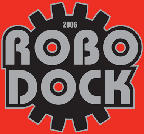
ALCHEMY
September 20-23, 2006 :: NDSM-wharf in Amsterdam-Noord :: Robodock Festival merges technology and art to an overwhelming experience. Alchemy will be the core theme of the spectacle theatre, music, robots, multimedia and interactive installations this year. Robodock will become one big bubbling laboratory for present time wizards from here and abroad. Artists and theatremakers will turn old materials into unforgettable new experiences.
Robodock is a unique international festival with a main core of technology, spectacle theatre, multi-media and industrial installations. In cooperation with artists, technology students and theatre makers the festival is styled by re-using scrap and other industrial left-overs. Nowadays Robodock has an important international workshop-function.
The festival shows unpredictable combinations of different disciplines and bizar theatral applications, of which fire and steel are important elements. No disciplines are excluded: theatre, plastic arts, music, dance, film, multimedia, acrobatics, technical experiments, deejays.
With a surprising and renewing program Robodock shows four days 'state of the art' - projects that have no like in Europe and that are specially developed for and by the Robodock Festival. On every day of the festival there will be a different program.
Theme of 2006: Alchemy
Alchemy is the old secret science that, by using the 'philosopher's stone', aimed at brewing a life-elixer out of precious metals. In 2006 Robodock will research the question wheter this science is still actual in our modern times. Do modern technologies contain a life-elixer?
Alchemy not only is a inspiring theme. It is also a theme that touches the search in our present society to spirituality, mysticism, symbolism and religion. Functioning as a experimental platform Robodock will become a alchemist laboratory. These are the corners of our focus this year.
History
The Robodock Festival takes place since 1998 and is organised by the ADeM foundation. The festival can be traced back further in time to the former cultural hotspots of the 90ies like the Graansilo and Vrieshuis Amerika. For many years the festival took place at the ADM-wharf in the western harbour of Amsterdam. After one edition in Rotterdam in 2003, the festival came back to Amsterdam.
In 1998 Robodock was the initiator of the Amsterdamse Broedplaats Policy. Nowadays Robodock has a sharp identity within the the field of international festivals. In cooperation with NEMO Robodock also organises conventions on technology, creativity and art.
In short: Robodock gives an exciting and lifely face to the creative industry of Amsterdam.
Posted by jo at 10:31 AM | Comments (0)
September 15, 2006
Upgrade! Berlin

Initial Salon
September 15th 2006 Upgrade! Initial Salon :: at Gustav-Mueller-Platz 4, Berlin-Schoeneberg :: Start: 8pm GMT, open end.
The first Upgrade! Berlin meeting on September 15th leads us to the typical starting point of networks in Berlin: the private appartement, which has a long tradition as a gamet of salons and get-togethers. The private place creates a space for debates that go beyond the limitation of scientific disciplines or practical concerns. In this first meeting we want to develop question strategies for our further exploration of media art and culture in Berlin. Each of us will come up with a specific topic of particular interest and an idea of how we could implement this topic into our question structure. We will also set up an agenda for the next Upgrade! field trips and nominate the hosts of the particular meetings. This initial Berlin meeting will be live streamed and we will invite guests from the international Upgrade! network via webconference. If you want to be part to this first meeting, please visit the private place that we temporarily open for the start of Upgrade! Berlin at Gustav-Mueller-Platz 4 in Berlin, Schoeneberg. Please let us know in advance if you will come and whom you plan to bring along.
Virtual guests are also welcome! Please write us about the way you want to contribute to our question salon.
Posted by jo at 07:01 PM | Comments (0)
Trebor Scholz

The "electricity" of future participation
A few months ago, when we started to work on the Architecture and Situated Technologies symposium it took me a while to get into the language (ubiquitous findable objects- UFO, geo-locative systems, context-aware/ ambient/ ubiquitous/ invisible/ continuous/ pervasive computing, locative media) and the unfamiliar context of architecture. I was more into all things networked and did not immediately see the connection. But soon I realized that The Internet of Things offers a captivating angle on the "electricity" of future participation in online sociality; may that be through the hardwired or the wireless Internet.
Over the past months on the iDC list we started to talk about networked objects and "The Internet of Things." Things? Things are not a species of their own making. So, why talk of "things" instead of objects? There must be more than semiotic cuteness at play; the term Internet of *Things* can't just be about anthropomorphizing artifacts, machines, products, and gizmos.
Anne Galloway responds:
The sandbox of the future. Not long ago only few people saw much of a future in reading and writing and video production. It was a consumer's world in which we were all "end-users" (I have to shut up and settle for what comes out of the assembly line. Sterling in Shaping Things, p78) But that has changed with what some call the relationship revolution. There is a participatory turn under way. Bang!!! and you have 100 million MySpace members, 600 billion web pages online, and half of American youth contributing content online. (Well, it was not quite so sudden.) Now, the projection expands to participation/content production beyond the screen engaging humans with networked objects. [continue]
I don't want to side-track an excellent post Trebor, but I would like to reflect a bit if I may on the role that Bruce Sterling, science-fiction author, is having in the current practice of pervasive computing research and design. I bring this up not as a commentary on, or critique of, Bruce Sterling the person, but because I believe that traditional questions about authorship are still relevant. I also consider his conference presentations (including their circulation online), and particularly his book Shaping Things, to be rather active non-human actors in the current development of thinking on these matters.
[See also: http://www.purselipsquarejaw.org/2006/03/its-all-about-playing-in-bogs.php]
So, here's my favourite Sterling quote about how Shaping Things came to be:
"I'd been trying to write a novel about ubiquitous computation, a science fiction novel, and it's set, you know, in the mid-21st century, and I'm trying to get it down on paper what it's like to work in an actually functional internet of things, and it's really a kind of serious ideational challenge, I mean it's just hard to make it convincing...I was asked to give a Toyota lecture at Art Center, because I knew people in the faculty..and delivered this sort of impassioned rant, saying, look, you know, I think this is gonna break big, and this is why, and I want you designers to kinda like think about this and help me out. What advice can you give me in kinda doing the background for my science fiction novel? And they just sorta stared for a second and said, well, we can't do anything about that but maybe you should join the faculty."
[transcribed from:
http://www.businessweek.com/mediacenter/qt/podcasts/innovation/innovation_12_13_05.mp3
and more here: http://www.purselipsquarejaw.org/2006/03/internet-of-things-quotes-of-day.php]
I love that he couldn't come up with a _convincing_ story. That someone else was willing to suggest that pervasive computing was not only a cultural myth (at least in part) , but not a very good one at that!
But seriously, the man understands that _words do things_. He's a writer and a charismatic performer after all. And even if he wouldn't use these terms or references, I think he definitely gets Wittgenstein's language games, Austin and Searle and Derrida on speech acts, and even (or especially) Callon and Latour's processes of translation.
So he's been attempting to mobilise his words, his ideas, at conferences--and others are trying to mobilise them as well for their own purposes (including coining their own neologisms). And Sterling's ideas are largely science fiction/social theory/design ideas, although I totally agree with your assessment that Sterling's perspectives lack "deep socio-political analysis" and give too much (strangely apolitical) agency to designers and design. Not surprising, I think, since he is not a social researcher and he was supported by a design department while he wrote the book.
So what is it then, I wonder, that Sterling _succeeds_ in mobilising? Is it the narrative and performative aspects of technology? Is it a tension between fact and fiction? Is it a _critical_ perspective? To be honest, I'm not sure. But I do know that it focusses on things and environments more than on people. In other words, I believe that it fundamentally lacks discussion on traditional social and cultural topics like race, class, gender, power (inequality) and, as you also suggest, history. and it makes it very difficult to understand or appreciate my role as a human, as a woman, as a scholar, etc. in this brave new world of his.
Some of the risks I see us attribute to new technologies often rely on a _lack of reflexivity_ in our own positions. Unlike Sterling, I don't believe our goal should be to "revolutioniz[e] the interplay of human and object" but rather first to acknowledge how we've never been as separate from objects as his position requires, and that small revolutions happen everyday.
And now back to our regular programming...
Cheers,
Anne
Anne Galloway
Dept. of Sociology & Anthropology
7th Floor, Loeb Building
Carleton University
1125 Colonel By Drive
Ottawa, Ontario
Canada K1S 5B6
www.purselipsquarejaw.org
www.spaceandculture.org
Posted by jo at 06:57 PM | Comments (0)
Mark Wallace

LonelyGeeks, LifeLogs and Four Eyed Monsters
A few of us from the Brooklyn metaverse crowd went to see Four-Eyed Monsters last night, a very interesting feature film about a young New York couple who end up documenting their every move via videotape and handwritten notes, only because they’ve decided not to actually speak to each other. While the film is not a documentary, it was made by the couple who it’s about, and their real lives and dramatized lives do begin to converge toward the end of the film. While it’s a movie about relationships (you know, the kind where two people “slowly start to meld into one beast that has 2 mouths, 4 eyes and 8 limbs and takes up 2 seats on the subway!!!”), it’s in greater measure a movie about the act of recording itself, and what it means at a moment in history when you can store, play back and share as much of your life as you like, with as many people as are willing to pay attention. In this case, Susan and Arin have created a virtual version of their real life together, and it’s interesting to ask what the differences between the two may be, if any — especially in light of similar trends in things like lifelogging, and in the fictionalization of a life like lonelygirl15’s. And if you stay with this long-winded post all the way to the end, you get to think about how this kind of logging of our lives might help enhance them in some future 3pointD world.
“How long can their relationship survive as an art project???” asks the Four Eyed Monsters Web site. But that doesn’t describe everything that’s going on here. There’s an art project unfolding, but there’s a relationship too. Are they the same thing? Does the art project follow the course of the relationship, or is the relationship subservient to the art project? The truth is probably somewhere in between: you can’t separate the relationship from the art project; at some level, the relationship is the act of documenting itself. A more interesting question might be, “How long could their relationship survive if it stopped being an art project?”
The documented life got some attention recently with the stellar rise of lonelygirl15, who appeared to be recording her days via a video diary on YouTube. Except that lonelygirl15, who’d garnered millions of fans in the four months she’d been videoblogging herself, turns out to be the construct of a couple of young California filmmakers. “Bree” was a totally fictional character, but it’s interesting to ask how the fictional Bree differs from the fictionalized Susan and Arin. Four Eyed Monsters is composed for the most part not of documentary footage but of re-enactments. (And in any case, what does it mean to re-enact what was in part acted out in the first place?) Are the characters of “Susan” and “Arin” that appear on the screen somehow qualitatively different from the character of “Bree” that appears in the YouTube videos? Are they all virtual people, or do Susan and Arin have some deeper gravitas for being based on their actual counterparts? And isn’t Bree, the lonely teenager, based on an actual archetype? Does that make her any “more fictional” than the characters in the film? Or is that like being “more pregnant”?
One of my favorite ideas is the impossibility of autobiography: you can’t ever really give an accurate account of yourself and your history; there are just too many intangibles of memory, bias and emotion that get in the way. Four Eyed Monsters is only one version of the lives of Arin and Susan. Cut together differently, the film could have given a very different impression, or examined some other aspect of what it’s like to come together in the way they have. You can’t present all views at once, and any one view leaves out some amount of information. (There’s a 3pointD uncertainty principle here that I’ll post about at some point in the future.)
Lately, though, some people have been looking for ways to capture their lives in as much detail as possible, using the tools of the information age. While the Internet and digital media make recording the scenes of one’s days far easier than it has been before, they also make possible, at least in theory, a detailed quantification of one’s life that could potentially be very useful in a future metaversal age.
One failed version of this is the now-discontinued LifeLog program of the Department of Defense. “The LifeLog capability would provide an electronic diary to help the individual more accurately recall and use his or her past experiences to be more effective in current or future tasks,” according to DARPA’s description. “The goal of the LifeLog is to turn the notebook computers or personal digital assistants used today into much more powerful tools for the warfighter.”
That program is no more, but into the breach has stepped ur-blogger Justin Hall, who’s been looking at “Passively Multiplayer Online Games” in recent months. (We first blogged about this back in June.) Basically, a PMOG, in Justin’s early conception, logs all your Internet activity and assigns scores based on various factors such as which and what kind of sites you visit, for how long, and what you do there, etc. It’s not very far advanced beyond an idea, but a kind of proof-of-concept version of Justin’s game is online, where you can see how surfing various sites might raise or lower various attributes that are used to describe your avatar in the game.
It’s interesting to contemplate what it might be like to compare the fictionalized self created by such a game to the real person who plays it. But this kind of lifelogging can be taken a giant step further and allowed to bleed out into the real world, where it could become really useful (or really scary, depending on who’s doing the logging).
It already happens on the Web all the time: the recommendations you get from Amazon or NetFlix and the targeted ads in your Gmail sidebar all work off subsets of the lifelogging idea. Amazon, NetFlix and Google log your activity on their sites, and use that information to point you toward things that are in line with the preferences you’ve shown in the past.
Now extend that idea to all areas of your life. Imagine if, after you’d used FreshDirect for a while, it started automatically ordering and delivering your food for you, based on the orders you’d placed in the past. Now knock down the walls between FreshDirect’s information and the information gathered by NetFlix, and it might even tweak your delivery based on what kind of movies you’d ordered that week. (Popcorn and chocolate for the chick flicks, Red Bull for the slasher movies?) Now imagine you’re sharing all this information — travel itineraries, iTunes playlists, anything else you care to name — with a whole bunch of other people, much as Susan and Arin shared the moments of their lives.
I’ll let Jerry contemplate the ramifications of videologging (no “b” here) one’s life for all to see. Logging the data of your every move, though, could get interesting. Vernor Vinge mentioned the potential opportunities that are opened by this in his keynote speech at the end of the recent Austin Game Conference. Vinge envisioned “lifestyle cults” that gather and share their information in order to garner favorable terms in whatever context. If 1,600 other people in your neighborhood all order Red Bull on the weekends, for instance, you ought to be able to leverage that into a discount. Things like that seem to be the gist of Vinge’s thinking here.
If it sounds outlandish to be sharing so much information with so many other people, consider the fact that Web 2.0 has pushed us much further in that direction than almost anyone thought we would head. On Flickr, YouTube, Blogger and so many other sites, we offer up personal information about our habits, thoughts, purchases and selves every day — many times a day, in fact. One of the ideas behind lifelogging is simply that you as an individual would be able to aggregate all that information in a single place. Without revealing anything more than you’re already putting out there, you’d immediately have a powerful resource for doing things like making decisions, making friends, making new discoveries, you name it.
Me, I’ve shared enough in this post already. (1,400 words!) See you — or some version of you, at least — at the movies. [blogged by Mark Wallace on 3pointD]
Posted by jo at 04:55 PM | Comments (0)
USC Annenberg Center Speaker’s Series
![]()
Speaker’s Series/Do-It-Yourself (DIY) Media
As part of the USC Annenberg Center Speaker’s Series, once a month speakers will discuss issues and practices associated with Do-It-Yourself (DIY) media. These DIY Media seminars will focus on the shifting relations between cultural producers and consumers and the rise of participatory media cultures across various industry sectors due to the growing prevalence of digital tools and networks.
In line with the participatory ethos, the seminars are meant to be highly interactive. Short presentations will be followed by discussion, and throughout the session there will be a backchannel for text-based chat. If you would like to participate in the backchannel, please attend with your laptop and be sure to have an IRC client that you can use. Our backchannel will be #diymedia on irc.freenode.net.
During the week following the seminar USC Annenberg Center Fellow Howard Rheingold will post blog entries and invite other participants to join in an asynchronous discussion at http://weblogs.annenberg.edu/diy/, and to post photos with the Flickr tag "diymedia." This online space will serve as a resource and networking site for the key players in this emergent area.
Both the seminars and the online forum are a prelude to the Fall 2007 DIY Media Festival, organized by Mimi Ito, Adrienne Russell, and a committee of USC Annenberg Center staff members and researchers.
Continue reading after the jump for the Fall semester schedule for the USC Annenberg Center Speaker’s Series/DIY Media seminars:
September 14
Speakers: Mimi Ito and Howard Rheingold
Mimi Ito’s talk is entitled "Amateur Cultural Production in the New Networked Age." She is a cultural anthropologist who studies new media use, particularly among young people in Japan and the US. She is currently co-leading a multi-year project on Digital Kids and Informal Learning, with support from the MacArthur Foundation. As part of this project she is conducting case studies of anime fandoms in Japan and the English-speaking online world. She is a Senior Fellow at the Annenberg Center for Communication.
Howard Rheingold’s talk is entitled "Participatory Media Literacy and Civic Engagement." His 2002 book Smart Mobs, was widely acclaimed as a prescient forecast of the always-on era. The weblog associated with the book (http://www.smartmobs.com/) has become one of the top 200 of the 8 million blogs tracked by Technorati, and won Utne Magazine's Independent in 2003. In 2005, he taught a course at Stanford University on "A Literacy of Cooperation," as part of a long-term investigation of cooperation and collective action, undertaken in partnership with the Institute for the Future. He teaches Participatory Media/Collective Action at UC Berkeley's School of Information, and Digital Journalism at Stanford University. He is a Nonresident Fellow at the USC Annenberg Center for Communication, and a visiting Professor at De Montfort University in Leicester, UK.
October 19
Speakers: Bob Stein and Todd Richmond
The topic of Bob Stein’s talk is open source academic publishing. He is Senior Fellow at the USC Annenberg Center, and Director of the Institute for the Future of the Book-- a project designed to explore, understand, and influence the shift from the printed book to digital publishing. Stein is currently working on SOPHIE-- a new software program that will allow artists, scholars, writers and others create digital documents incorporating audio and visual elements, along with text. The underlying goal of this project is to develop software that allows users to create their publications without having to hire a specialized programmer or learn complicated programming techniques. Upon completion in 2006, SOPHIE will be distributed on an open-source basis via the Institute for the Future of the Book.
The topic of Todd Richmond’s talk is open source courseware. He is currently a Fellow at the USC Annenberg Center, and the Center for Creative Technologies at USC. He is also an Adjunct Professor in the Interactive Media Division of the USC School of Cinema-Television. He specializes in basic and applied research in the broad field of digital networked media, social networks, and social software. He is currently working on a Hewlett Foundation-funded research project titled "Viral University Education" which seeks to better understand and facilitate the uptake of freely available open educational content on the Internet by using a variety of social software tools and technologies to create viral learning communities and content.
November 16
Speakers: danah boyd and Justin Hall
Danah boyd’s [sic] talk is entitled "Creating Culture Through Collective Identity Performance: MySpace, Youth, and DIY Publics." Danah is a PhD candidate in the School of Information at the University of California-Berkeley and a Graduate Fellow at the USc Annenberg Center. Funded by the MacArthur Foundation, her dissertation focuses on how youth engage in networked publics like MySpace. In particular, she investigates how youth formulate a presentation of self and negotiate socialization in mediated contexts where the audience is often unknown. Prior to Berkeley, danah received an AB in computer science from Brown University and an MS in sociable media from MIT Media Lab. She has worked as an ethnographer and social media researcher for various corporations, including Intel, Tribe.net, Google and, currently, Yahoo! She also created and managed a large online community for V-Day, a non-profit organization working to end violence against women and girls worldwide. She actively blogs about social media at Apophenia (www.zephoria.org/thoughts/)
Justin Hall will speak about "Passively Multiplayer Online Games." He is a Graduate Fellow at the USC Annenberg Center and a graduate student in the USC Interactive Media Division where he explores alternatives to text publishing online. He is currently developing surveillance-based gameplay online and on mobile phones called "Passively Multiplayer Online Gaming." He has taught classes and workshops at USC School of Cinema-Television encouraging the creation and distribution of short videos online. He started "Justin’s Links from the Underground" (www.links.net) in January 1994 eventually writing 4,800 pages of hypertexted personal journalism before stepping back in January 2005. In December, 2004, New York Times Magazine referred to him as "the founding father of personal blogging."
December 14
Speakers: Jennifer Urban and Cory Doctorow
Cory Doctorow is co-editor for the popular technology blog "Boing Boing."He is also a Senior Fellow at the USC Annenberg Center, and is currently the first to hold USC's Canada-U.S. Fulbright Visiting Research Chair in Public Diplomacy. He actively supports liberalizing copyright laws in order to increase the amount of creative work available to share, remix, and develop. A proponent of Creative Commons, his work emphasizes digital rights management, file-sharing, Disney, and post-scarcity economics.
Jennifer Urban is a Fellow at the USC Annenberg Center and a Clinical Associate Professor of Law at USC. She teaches Intellectual Property and classes related to Technology Law and Policy. She also is the Director of the USC Intellectual Property Clinic, where students learn intellectual property law through hands-on work with cutting-edge, real-world projects. She is a faculty member of the USC Center for Communication Law and Policy.
For more information on these talks or speakers, go to www.annenberg.edu, or call 213-743-2520. [blogged by Scott on USC Interactive Media Division]
Posted by jo at 04:41 PM | Comments (0)
You Are Not Here
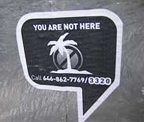
Baghdad in Brooklyn
I followed the You Are Not Here walk which was presented yesterday at Conflux. This urban tourism mash-up invites participants to become meta-tourists on an excursion through the city of Baghdad while walking through the streets of New York. We were given maps printed on both sides: on the recto, a map of Baghdad, on the verso, a map of New York. By looking through it in the light, we were able to navigate through the Baghdad/New York streets. We had to look for the You Are Not Here signs placed on lamposts, walls or other locations in the streets, they indicated us that we had arrived at an important monument or square of the capital of Irak. The YANH street-signs provided the telephone number for the Tourist Hotline.
Site-specific access codes entered on our mobile phones through the Tourist Hotline provided us with audio information about the current site that we had discovered. For example, when we arrived in central Baghdad's Firdos Square, we received information about the toppling of the statue of Saddam Hussein and how this might have been a stage event as most of the spectators of it were American soldiers and journalists.
Through the website, you can get your own mashed-tourist map of Baghdad, NYC with a full tour guide to all of the must-see locations.
You Are Not Here tries to expose the contrasts and the similarities between two mashed cities. We are consuming global information on a daily basis: a tourist visit demands a higher level of commitment and identification with a place than a habitual commute. YANH provides participants with a fragmented tourist experience, which provokes a critical view of urban space and its subjection to media and politics.
The experience was quite nice and walking becomes the medium through which we discussed, commented and exchanged our views about the Iraqi events.
A work by Mushon Zer-Aviv, Dan Phiffer, Kati London, Thomas Duc, Ran Tao and Charles Joseph.
You Are Not Here will also be part of the Come Out and Play festival that will take place in New York on September 22-24. [blogged by Regine on we-make-money-not-art]
Posted by jo at 04:30 PM | Comments (0)
Ulises Ali Mejias
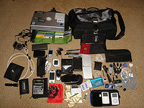
The thing about the internet of things
While I am not very familiar with the whole 'internet of things' discourse, I recognize plenty of recurring themes to be troubled about. We encounter, once again (but with new buzz words), the argument that new technologies can rehabilitate our relationship to the real and to the social. This time, however, instead of investing our sense of self entirely in the virtual (soooo 1990's), we can invest it in 'things' (human-object assemblages) which populate reality, but which are still interconnected and organized in the virtual. The return of the object or 'thing' would seem to suggest that we are moving away from the idea of the virtual as an alternate realm of reality and towards a more complex understanding of reality as encompassing both the virtual and the actual (thank you, Monsieur Deleuze). However, I fear that our technophilia is obscuring the politics of these virtual-actual assemblages, obstructing the need to critically assess how agency is distributed amongst things connected through the internet.
One possible direction this critique can take is to analyze new (and old) modes of production and consumption in the internet of things. The corporate call to action (there are non-commercial alternatives, thankfully) is that we must break free of the shackles of passive consumption to enter a new era of active consumption organized around networked objects scattered in the 'real' world. To be called an audience is an insult in this age when "the demand side supplies itself," when —given the sanctioned source materials— we can all be producers or re-mixers of the objects we shall consume (what I call 'ultimate consumerism'). The difference is that now we need not be stationed in front of our computers to do so; our regained mobility and wirelessness signals a return to the real. Hurray! The freedom to move around while being invisibly tethered to the market, digitizing things or information about things outside the market and putting them in circulation within it. Needless to say, I share Anne's concerns about the fetishizing of 'things' and about the 'return to the object' as the privileging of objectivity.
What I find most troubling is that the discourse of the 'internet of things' suggests a certain inevitability: the true potential of the internet of things can only be achieved to the extent that it encompasses everything (it is not accidental that the internet of things is an extension of the discourse of ubiquitous or pervasive computing). Shouldn't we question this inevitability? After all, the act of 'outsourcing' (to use Trebor's term) our memory and social functions to internet things is not without political and social consequences: The mobility of us cyber nomads —our ability to detach and re-attach ourselves to reality at will— is usually acquired thanks to the drudgery and exploitation endured by someone else (the call center worker in India, the Cassiterite miner in Congo, the factory worker in Mexico or Taiwan, etc.).
At the same time, our response should not be a blind rejection or phobia of things. There are no more 'things' today than before, nor do we rely more on 'things' now than in the past. I was reading an old essay by Ivan Illich ("Silence is a Commons") in which he basically laments the pollution of silence by new electronic things. While I share some of his concerns, I wonder if an average day is less filled with things for someone living on the fringes of consumerism than for someone living within it. Of course, the differences should be accounted for (from natural things, to things produced by us, to things produced by somebody else), but assemblages of humans and things are not abnormal or evil, a priori. The questions is: If we have always delegated (or in the worst case, surrendered) social agency to things in order to control, manipulate, facilitate, condition, interpret, etc., what functions are the 'things' in the internet of things fulfilling?
I don't think Illich was arguing against new things per se, but against the loss of opportunities to reflect on what is being substituted by or forgotten with the new things, to be critical of new things, and to reject things we find unsustainable. [blogged by Ulises Ali Mejias on IDEANT]
Posted by jo at 04:22 PM | Comments (0)
Invisible Geographies
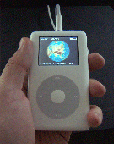
Ears to the Ground
Invisible Geographies, an exhibition organized by critic Christophe Cox, presents four works that illuminate different facets of contemporary German sound art--a scene that has been tremendously influential since the 1970s. Aside from the national focus, what is unique about Invisible Geographies, amidst a wider burgeoning of sound art practice, are the diverse, large-scale installations of which it's comprised. Encompassing sculpture, video, light, and found objects, the four works by Jens Brand, Jan-Peter E.R. Sonntag, Stefan Rummel, and Christina Kubisch push far-flung edges of sound art's formal boundaries. They are linked by their common interest in physical or social dimensions of sound, and in their deft re-mapping of urban space. Kubisch presents three related projects under the heading 'New York Electrical Walk' that variously highlight, visualize and transform electro-magnetic sound waves the artist recorded in Times Square. A rough-hewn installation by Rummel made with found building materials and retired electronic equipment re-constitutes the space of the gallery according to its resident aural elements, putting echoes from hidden storage spaces in conversation with the humming of light fixtures. Gallery-goers can expect their senses will be re-tuned after a trip to Invisible Geographies, which will be reverberating at The Kitchen, in New York, through October 14th. - Lauren Cornell, Rhizome News.
Posted by jo at 04:14 PM | Comments (0)
paraflows 06
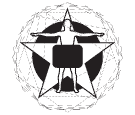
Annual Convention for Digital Arts and Cultures
paraflows 06 - annual convention for digital arts and cultures :: 9 through 16 September 06 :: paraflows 06 focusses on the idea of a ‚net behind the net’ which can mean both the digital behind the social net, and the social behind the digital net. paraflows (the Greek prefix ‘para’ meaning: beside, near, moreover) emanates from the main motors of freedom of the net and its para-experts, the wikipedias and slashdots of all areas within which consumers help each other voluntarily to become and remain critical users and experts in their fields.
The symposium draws participants from all over the world and consists of lectures and workshops on the topic of paraflows 06: ‘nets behind the net’. The exhibition will display works dealing with the ‘social web’ focussing on the topic of the ‘nets behind the nets’. Installations and performances are meant to encourage visitors to actively participate in the event. The horizontal concept of the exhibition consciously takes on the approved principles of a decentralized organisation and of participatory practices. The exhibition will therefore be held in seven locations within the Viennese art and culture scene. The daily evening events will top off the festival and encourage participants and visitors to communicate with each other.
Symposium
Paraflows 06 – the nets beyond the net
High abstraction goals for local communities
In the year 2006, neither Amnesty International nor Greenspeace have been put out of work, yet new horizons of necessary political engagement have emerged that call on the abilities of computer scientists, lawyers and artists alike – and lots of them.
These alternative task forces have recently formed, like the state-of-the-art movement of Pirate Parties that originated in Sweden and strives to get techaware citizens elected into parliaments on a worldwide scale, the Big Brother Awards that report back and collect local cases of corporate technologialy abuse in more than 15 countries, or the Free Software Foundation that designs operation systems and licenses that can spread freedom from digital abuse in an already abusive environment. They all advise their politicians, lawyers and journalists in their free time to stop steering our societies into a direction where Europeans have little understanding of where it will lead: intimidated citizens, security-obsessed decision makers, atmospheres of faschism, powered by the IT-sector itself and its shareholders.
At this moment in time, participants in the Viennese netznetz-experiment succeeded by being entrusted 500.000 Euro every year, to distribute among themselves and their projects, obliging themselves to the task of stabilizing and re-designing their procedures collectively, step by step, and in a democratic fashion that nevertheless produces results. This complex task seems to be just like "rebuilding the plane as you are flying“ (A. Limi). Yet by co-constructing the local workflows they are already changing the flows of cash and hardware, material and knowledge, information and inspiration in the city of Vienna. Seen from a personal point of view, a lot of them already look back on a hybrid education between the computer sciences, the social sciences and the arts, testifying with their own experience in the netznetz – process that the perception of scientific facts and artistic artifacts, tools for collaboration and devices for self-alienation, promising instability and outmoded routines may sometimes blend into each other rather paradoxically, as if both states were to be true at once, or on parallel dimensions.
But how are these two scales of endeavour related, both the organisation of a local production- and safety-net via the web and the care for interrelated issues like copyrights and patent approaches via international, distributed technologies and communities? The most immediate concern that invokes scrutiny are people. Because just looking back into the ideologies and technologies of the year 1968 or 1996 will not suffice to properly adress these new power constellations that have emerged between the social, the political, the legal, the technological and the personal aspects of our daily life. And be it in Vienna or elsewhere, in order not to paralyse our momentum, these complexities must be adressed in a innovative way, by researching and testing possible re-constellations and current models of collective collaboration for the long term. And by reminding oneself that, within all complexity, "the most important source of energy is the human being and what he or she believes.“ (J.A. Wheeler). Paraflows 06 will present different viable approaches to personal self-organization with a global bandwidth reach.
Participants:
Rena Tangens (foebud.org), Albena Yaneva, Gary Danner & Elisa Rose (Station Rose), Hartmut Pilch (ffii.org), Mirko T. Schäfer, Alvise Mattozzi, Rick Falkvinge (Pirat Partiet, Stockholm; remote), Tom Fürstner, Rainer Prohaska (cntrcpy), Frank Hartmann, Denisa Kera, Florian Hufsky (Piraten Partei Österreich), Felix Stalder, Pamela Bartar (concult.at), Thomas Ballhausen, Vladimir Jeric (Creative Commons Serbia), Jan Lauth, Andreas Trawögger u.a.
Posted by jo at 03:58 PM | Comments (0)
Electric Skin
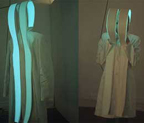
Breath turns to Pulses of Light
Electric Skin, by Suzi Webster -- a MFA student at the Slade Centre of Electronic Media, is a bio-responsive garment that turns the breath of the wearer into pulses of light, acting as a mediating membrane and seeking to create homeostasis between the wearer's internal environment and the external environment. Video. The garment is made of Elumin8 printed LEDs, silk and sensors.
The responsive garment turns the breath of the wearer into pulses of light. The wearer's inhalation and exhalation activate a breath sensor that dims and brightens the printed LED of the garment. The wearer is bathed in the electric aqua light. S/he is connected to the grid by an umbilical cord/power cable, and while this creates a seductive light, it also creates a frisson of danger and unease. Other viewers see the intimate breathing of the wearer as slow pulses of light on the exterior of the garment.
Electric Skin is a hybrid object/performance that questions divisions between ‘subject/object’ ‘inner/outer’ and ‘mind/body’ and creates an experience of that liminal space that is neither inside nor outside, but is a third space inbetween.
Electric Skin will be presented this Friday at the How Smart Are We? symposium the Royal Institute of British Architects.
Related: Scuba, an audio device that allows you to adapt the soundscape from the external environment to your breath; the Kiss COmmunicator, the art of breathing, Breathe on me, the Breath Car. [blogged by Regine on we-make-money-not-art]
Posted by jo at 02:31 PM | Comments (0)
From dust till dawn
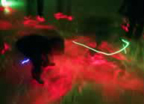
"robs the term tangible media of its intangibility"
Dust behaves unpredictably and is difficult to control. Besides that it is not especially popular, being regarded as "dirt" in our culture. As elusive as time seems to us it nevertheless leaves physical traces in the form of dust. The installation "From dust till dawn" made by Markus Decker and Dietmar Offenhuber kicks up a lot of dust and produces noise in the form of acoustic traces. The dust and atmosphere in the empty room form the installation’s interactive medium. Dust is identified by a surface laser and a photographic identification system and becomes a highly unusual means of interaction.
A grid of line lasers installed just above the floor produces a homogeneous carpet of light which is at first invisible. Objects and particles that pierce this carpet, such as dust, cigarette smoke or larger objects, become visible in the laser beams as a silhouette or an outline. The outlines and dust patterns are recorded and their two-dimensional movements converted to sound on an xy raster synthesizer. Every step the visitor makes, indeed his or her mere presence, sets the air moving and causes dust to swirl up. Its deals with a fragile interactive medium which is barely controllable and robs the term tangible media of its intangibility. [blogged by Ruairi on Interactive Architecture dot org]
Posted by jo at 01:10 PM | Comments (0)
The Vera List Center for Art and Politics at The New School
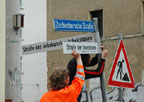
The Public Domain
The Vera List Center for Art and Politics at The New School Launches “The Public Domain,” annual theme for 2006-2007 :: The New School, Theresa Lang Community and Student Center, 55 West 13th Street, New York City :: Further information: 212.229.5353 or kuonic[at]newschool.edu.
September 14, 2006 – 6:30 p.m. :: Inaugural Lecture :: The Eclipse of the Public: The Necessity to Revitalize the Public Sphere by Richard J. Bernstein, Vera List Professor of Philosophy, The New School for Social Research :: Each year, an inaugural lecture launches the Vera List Center’s annual theme, defining the intellectual territory that will be explored in public programs throughout the year. Professor Bernstein will discuss the meaning of the concepts of public life and public space in the works of John Dewey, Hannah Arendt, and Jurgen Habermas, and will consider how these concepts are relevant for understanding public freedom and democracy.
Future Events:
September 25, 2006M – 6:30 p.m.
Mapping. And Now We Can See it All?
With:
William Bevington, Parson Institute for Information Mapping
Daniel N. Dubno, Producer, CBS News
Joy Hirsch, Columbia University, Department of Neuroscience
Henrik Mayer, Reinigungsgesellschaft
A discussion on the different areas in which information is decoded, presented, and processed in an overstimulated culture, with a focus on the politics of information mapping in terms of what is revealed and what is concealed.
September 29, 2006 – 7 p.m.
Negativland: Adventures in Illegal Art
A Performance by Mark Hosler
Of mythical stature in the worlds of music, performance and law, Negativland presents a film/performance/lecture by one of its four members, co-founder Mark Hosler.
For over two decades, Negativland has not just touched on critical issues but has actually provoked, and in court defended, them: concepts such as intellectual property issues, file sharing, media literacy, creative activism in a media-saturated multinational world, evolving notions of art and ownership, and law in a digital age.
October 27, 2006 – 6:30 p.m.
Public Space and Sustainable Development
The Future of an Old City
With
Amale Andraos and Dan Wood, WORKac, New York
John Krieble, Office of Sustainable Design, City of New York
Victoria Meyers, Landscape Architect
Miodrag Mitrasinovic, Parsons The New School of Design
Joel Towers, Tishman Environment and Design Center, The New School
As the distinction between commerce and leisure is increasingly blurred, public space has morphed into a structure that is semi-private, semi-governmental and facilitates both commerce and entertainment. This panel considers how sustainable design—with its emphasis on energy conservation, efficiency, environmentally reflexive material specification etc.—has been deployed in contemporary public space through developers’ initiatives and government subsidies, and to what ends.
December 4, 2006 – 6:30 p.m.
Open Source on the Line
With
Cory Arcangel, artist
Daniel Mayer, CFO, Wikipedia
and others
A discussion on the contested terrain of open source culture online, and how new models and practices offer innovative artistic and political possibilities to some, and questionable author- and ownership complications to others. Panelists from different disciplines and backgrounds will explore the effects of online platforms such as Wikipedia and delicious on culture and offline systems of knowledge, as well as current challenges to open source principles such as “net neutrality.” Presented in collaboration with Rhizome.
Additional programs in the works.
Posted by jo at 12:38 PM | Comments (0)
SENTINEL TO THE WIND
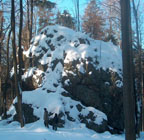
Returning the Rarified Sounds of the Wind
SENTINEL TO THE WIND by JEFF TALMAN will be installed in the Bavarian Forest this coming week and will run through September 30. The work is commissioned by the Lower Bavarian/Oberpfalz Artists Guild in cooperation with the Agriculture and Forestry Service of the Bavarian Forest in Waldmünchen, Germany as a part of their Wald – Symposium, a forest exhibition that will present the work of ten international artists.
Sentinel to the Wind is a five-channel sound installation that will cover over 12,000 square meters of forest terrain. Located atop and around the Pucher Outcropping, the installation will return the rarified sounds of the wind, which I recorded there last winter as they cut across the face of the stone. The region, on the Czech-Bavarian border was once home to sentinel towers and military complexes as part of the Iron (and NATO) Curtain. Today you can backpack through the forest and cross the border freely, which of course the wind always does. (more)
Posted by jo at 11:06 AM | Comments (0)
Gaming Realities
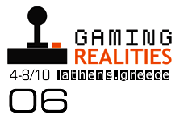
Virtual Spaces are the New Public Spaces
In less than a month Gaming Realities, one of the biggest festivals to date encompassing the critical exploration of videogames in the fine arts and humanties, kicks off in Athens. The festival hosts a great line up of artists and speakers, many of which we've covered or archived here at Selectparks over the years (Blast Theory, Sir Frasca, Darwinia, Eastwood Group, Molleindustria and many more). I'll be there, so if you're at the festival come to my keynote and ask some impossibly difficult questions when I least expect it. Cheers! Read on for the comprehensive press release and exhbition details. [posted by julian on selectparks]
EXHIBITION: NetODrom by Christoph Anthes, Alexander Wilhelm, Helmut Bressler, Roland Landershamer, Johannes Zarl, Silke Wiesinger; Austria, 2005 :: Can you see me now? by Blast Theory; U.K., 2001 :: Philosopher Death Match by Benjamin Chang; U.S.A., 2006 :: Grid Chase - The 5€ Dance Pad Project by Dimi Christopoulos; Greece, 2002-2006 :: Himalaya’s Head by DEVART; Netherlands, 2005 :: Civilization IV – Age of Empire by Eastwood Group; Serbia, 2004 :: N o w h e r e - ein welt raum spiel by Sylvia Eckermann, Gerald Nestler, Christof Cargnelli, Oliver Irschitz; Austria, 2005 :: Bordergames by Fiambrera; Spain, 2005 :: Postvinyl by Mathias Fuchs; U.K., 2005 :: Lykno by David Gauthier, Henri Marino, Laurie Prevot, Jean Batiste Spieser; France, 2006 :: Semiomorph by Troy Innocent; Australia, 2001 :: Darwinia Introversion Software, U.K., 2005 :: Ready Played by The Ludic Society (Margarete Jahrmann/Max Moswitzer); Austria/Switzerland, 2006 :: Kalamiotou_02 by The mamayans; Greece, 2006 ::
Max Payne cheats only by Jodi; Netherlands :: Ariadne’s Sonic Threadball by Panagiotis Koutlemanis, Dimitris Dinieas; Greece, 2006 :: Façade by Michael Mateas, Andrew Stern; U.S.A., 2005 :: The McDonalds’s Videogame by Molleindustria; Italy, 2006 :: Soviet Unterzogersdorf the adventure game by Monochrom; Austria, 2005 :: Book and Volume by Nick Montfort; U.S.A., 2005 :: The making of Balkan wars: the game by Personal Cinema; Greece, 2004 :: Disaffected by Persuasive Games; U.S.A., 2006 :: Interactive Circus by Prof. Marie-Helene Tramus, Cedric Plessier; France, 2005 :: Jumping Rope by Orna Portugaly, Daphna Talithman, Sharon Younger; Israel, 2004 :: Global Conflicts: Palestine by Serious Games Interactive; Denmark, 2005-2006 :: Boys in the Hood by Axel Stockburger; Austria/U.K., 2005 :: The endless forest by Tale of Tales; Belgium, 2005 :: Game Music by Vladimir Todorovic; Serbia, 2004-2005 :: Fijuu2 by Julian Oliver, Steven Pickles; Germany - New Zealand, 2006 :: Coin Snatch by sheismartha, Alexandros Plakidas Dasios; Greece, 2006 :: History Lost Redux by University of the Aegean; Greece, 2006 ::
Conference Highlight:
The democratisation of virtual environments
Personal Cinema
International New Media Collective
A spectre is haunting Virtual Environments, their democratisation.
It is the spectre of democracy, which after the abandonment of its physical space [real life] sinking more and more in the contradiction of lies and the cancellations that lead to its constitution, it breached the relations with the real and it became itself a spectre. This is how the paradox of spectre occurred, the wandering shadow of democracy. A spectre that tries to penetrate, and aims to democratise the new kind of ghosts that constitute the space which forms a major element of human experience: The Virtual Environments.
The democratisation of virtual environments, computer and video games is one main debate issue in the industry of interactive media. In new media and especially video games the democratisation is related mainly to the fact that the user, in the context of interaction and personalisation, takes major part in the creation process of the games themselves. Mods, thousands of volunteer designers in Half Life, Everquest, Oblivion, and Quake, are examples of how the users participate in the creation process. If we are able to discuss something new in new media it is the user’s capability to participate in the creation process. This capability is not a gift or an offer of a generous democratic technology, but immanence within its own structure, it is an immediate reflection of the conflicts that constitute this capability of participation which has as its final destination democracy.
In other words, speaking of the conditions which arose from the utopian meeting of spectres, which magical ritual could be useful for both the old spectre of democracy and the ‘spectral’ world of virtual environments?
The vast majority of the users understand democracy according to the quantity of interactive “clicks” which represent the voting “right” in cyber space. The image of the voting procedure and democratisation in virtual space isn’t the supposed infinite choice of different web pages or the user’s ability to create personalised narration in a video game; it is the image of the cursor itself over the icon of “choice” accompanied by the sound of the “click” which really is the extension of the image of the poll and the hand that is “capable of choosing”.
How is possible to revive democracy in the realm of the potential, when within the context of the objective it became a commodity that has usually been exported and imported via violence?
Posted by jo at 09:32 AM | Comments (0)
September 14, 2006
Scoot
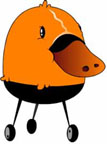
a location-based game
Melbournians have another chance to save their town from those pesky aliens when the location-based game, Scoot, returns this weekend 16 - 18th September.
Following its 2005 premiere at ACMI and Federation Square, Scoot 2006 will be played over 3 days across Victoria's 5 major cultural organisations and takes participants on a unique interactive treasure hunt through the virtual and real worlds of Australian Centre For Moving Image, National Gallery of Victoria, State Library of Victoria, the Arts Centre and Melbourne Museum.
A location-based game that employs sms, multimedia and the online environment to explore concepts of space, Scoot 2006 is played out via sms instructions sent to participants' mobile phones. It begins with players receiving a mystery SOS message leading them to the world of Scoot. In order to avoid invasion, players must then seek out magical characters, play online games and interact with the strange objects that have arrived in Victoria's major arts institutions.
Created by artist Deb Polson and presented by Australian Centre For Moving Image in collaboration with National Gallery of Victoria, State Library of Victoria, the Arts Centre and Melbourne Museum, Scoot explores using mobile phones as tools of play and creates a gaming experience across multiple locations in Australia's largest location-based game. It has been supported by the Victorian Government through Arts Victoria and the Community Support Fund.
Families and groups of 2-6 can play. For more information and to register visit Scoot or ACMI Games Lab [posted by jacinta on selectparks]
Posted by jo at 07:28 PM | Comments (0)
Dropping Knowledge

The Global Dialogue Platform
dropping knowledge is a way of asking and answering questions that recognizes multiple viewpoints. When you ask in order to understand, when you answer in order to share, you are dropping knowledge.
Dropping Knowledge's took place on September 9th, 2006; 112 of the world’s great minds--a number of them are artists, musicians, filmmakers and authors--came together around the world’s largest table in Berlin’s historic Babelplatz Square.
Recorded by 112 digital cameras, they simultaneously answered 100 questions chosen out of thousands donated by the global public. The resulting 600+ hours of audiovisual content launched an unprecedented online resource: a knowledge portal and dialog forum created to host a global conversation covering the most pressing questions of our time. [via]
Posted by jo at 07:17 PM | Comments (0)
Untitled Media
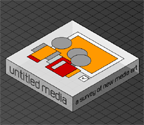
Public Perceptions of New Media Art
In response to the ongoing debate by mainstream art establishments, contemporary art theorists, practitioners and the art going communit - to define what constitutes a New Media Art practice - Untitled Media is an attempt to document and categorise examples of artworks that might, or might not fall into the domain of New Media Art.
The Untitled Media project is a hybrid art research activity that is created at site-specific New Media galleries and events. Consisting of a data collection survey, data collection analysis software and data visualization model - the project collects information on public perceptions of New Media Art. These findings are then made public through a visualised dynamic database. The data base will be added to by running the Untitled Media project at a number of New Media venues to establish the typologies of contemporary New Media Art.
Unlike traditional artworks such as painting or sculptures, New Media Art is often difficult to describe or identify, Untitled Media is a participatory classification system that attempts to define the mutability of contemporary New Media Art, whilst becoming an artwork in itself.
The Untitled Media project is a product of the Reality Co-operative: creative technologists - Ian Gwilt - Elisa Lee - Shigeki Amitani - Adam Hinshaw
Posted by jo at 06:41 PM | Comments (0)
ICH² - INTERMEDIA DANCE PERFORMANCE FOR PLANETARIUMS
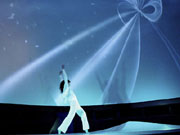
360 Degree Projection meets Motion-Tracking
ICH² - INTERMEDIA DANCE PERFORMANCE FOR PLANETARIUMS [Premiered on June 8, 2006 at the Mediadome in Kiel, Germany. The Programm will be resumed at the Mediadome in Kiel in February 2007.]
The performance ICH² combines dance and media art with complex content and attractive use of cross-media. Art and technology synergetically combine to a creative game on duplication and variation. ICH² is merging the components into a hybrid amalgamation, which creates a digital space of possibilities, which is not only reflecting the perspectives of genetechnology, but offers the visitor a new space for experience.
An intruiging atmosphere is created by the interaction between stage and the projection onto the dome. A unique installation for an extra-ordinary space: a planetarium including a 360 degrees moving image projection. State-of-the-art projection technology is merging with dance theatre and interactive media into a fascinating wholesome piece of art, is modifying it and allowing a completely new kind of production: dancer and media together create an artistic space that involves the audience in a new way. The impact of the imagery and the intensively short proximity of the performers, forms a high level of immersion.
Hardly has a visitor been closer to the dancers. This turns standard planetariums into experiental Digital Theatres, in which man and technology can be part of a unique symbiosys.
Tracking Bodies
The main area of research for project ReACT was the further development of the Tracking-technology in regard of the spacial and technical characteristics of planetariums. While usually only linear image sets were shown, the use of reactive software allowed interactivity and manipulation of the projected content.
Concept: With the help of installed cameras and sensors attached to the performer’s body, movements in the space can be tracked and transmitted to a computer system. A specially programmed software interprets the dancer’s movements in real-time, which in turn is then projected onto the dome as interactive projection and stage backdrop. This allows to create a digital double of the dancer: Motion Tracking as duplication process.
In this way a reactive visual and audio world is created, that synergetically re-interprets the image and audio composition.
Posted by jo at 06:32 PM | Comments (0)
Jane McGonigal

Please feed (but don't fetishize) the participation
I'm feeling a bit squeamish about a lot of the lonelygirl discussion going on this week, in the wake of the previously secret puppet masters' curtain call. As someone who designs participatory experiences, often games with a serial narrative component, I think it's really important that we stop and look at the kind of participation and engagement actually engendered by projects that purport to solicit the collaboration of the audience.
In the LA Times, the producers of the You Tube serial drama describe their goals for engaging the audience:
The intent was to allow fan response posted in the comment section of lonelygirl15's YouTube and MySpace pages to determine the direction of each subsequent episode.As an example of the fans' influence over the story line, what the team calls "collaborative storytelling," they pointed to an episode in which Daniel reveals his romantic feelings to Bree. "In the 'Hiking' video," Beckett said, "where Daniel filmed her, there were a ton of comments saying, 'Daniel likes you. It's obvious that the cameraman was completely in love with you.' We saw the comments and said this is the perfect opportunity to address this."
Okay, fair enough. I'm all for collaborative storytelling. But I don't think it's right to accept this account of the kind of participation that happened during the lonelygirl project at face value. Today and yesterday I spent a lot of time reading through pretty much every single comment left on the lonelygirl videos, the space where the audience was purportedly invited to help decide and direct the course of the narrative. I would encourage anyone else interested in the currently much praised and hyped lonelygirl "community" to do the same. A great hub for doing this is here.
As the statistics on this traffic counter show, each lonelygirl video has roughly 1000-4000 comments, nearly all of them left before the puppet masters were unmasked. And I have to say this: the level of hate, mean-spiritendess, crudeness and often downright misogeny of the majority of them is impossible to ignore.
As we talk about the “new art form” or “participatory culture” aspects of this project, I want to be very careful that we don’t fetishize the participation aspects of this experience that was had by a very few who may have intelligently, passionately and seriously investigated and responded to the texts and the media objects. I want instead to think about the mainstream experience of and participation in this project and the success of the platform provided for engagement.
To give you an idea, here is a sample of comments that I would characterize as representative of at least 33% if not more of comments to the lonelygirl videos:
You are pretty boring. Get a psychologist.
Ok. Why don’t you just keep your personal problems to yourself and stop making a scene
show us your tits
you are really ugly i hope you know that
Your eyebrows are too far apart. But, you’re still pretty.
Fuck you. Welcome to the new world we Don’t Have to Respect what you think. get over it
I hope Daniel rapes you. No hard feelings.
WHORE lol
HHHmmmmm,your caucasian,live in a decent to luxurious house, are well taken care of,and it looks like you are one of those spoiled girls that kiss ass to thier daddy.Think you have it rough?Why dont you come live in East Los Angeles,whee you cant go anywhere without being shot at,you fuckin spoiled brat.
Cry me a river bitch, your a teenager, do what your parents say bitch.
(Most discussion in the comments is not about whether lonelygirl is real or not-- they appear to accept the videos at face value, or otherwise not to care whether they are insulting a "real" girl or an actress.)
So: Is this really the birth of a new art form? Is this a kind of social participation that we like or find interesting? I'm all for participatory entertainment. But let's carefully design platforms, vehicles, and contexts for participation that really work to engage audiences, players, makers, collaborators in meaningful ways.
One more point I want to make: I think this question of "is she real or not" and how does the audience feel about being hoaxed or played with is a really important one. Although many, many viewers were openly skeptical or cynical about the verity of lonelygirl's professed identity, from what I can tell, far more took it close enough to real to play along.
Now I've written a lot about, and worked on quite a few, projects that ask players to perform belief in the story and game experiences, but--and here's the key distinction--without presenting actually credible fictons. (Stories set 500 years in the future, for instance, or involving poker rooms full of ghosts). The media itself never clearly said "I'm not real", but the content absolutely had no chance of fooling anyone. So I'll come out and say it: I don't personally like entertainment in the form of credible hoaxes. Not necessarily from a moral position, but rather because I believe that "real or not" distracts from the more important question: How can I meaningfully engage?
I agree that serial drama on You Tube is a great art form (so are traditional ARGs, the more elaborate art form that lonelygirl represents a pared back style of, in my opinion), but the real conversation should be not about the realness, but rather: How do people want to participate in it? Do they want to be the makers of their own videos? To have role-playing style conversations in the comments? Do they want to directly influence the narrative or to just speculate and gossip about it so they can be proven right by what happens next? And most importantly how do we inspire participation that is more than hostile juvenile comments? How do we create a real participatory community around an entertainment property, and what forms of participation are possible... and desirable? [posted by Jane on Avant Game] [Related post]
Posted by jo at 06:18 PM | Comments (0)
MONKEY TOWN
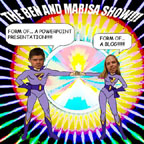
THE MARISA AND BEN SHOW
THE MARISA AND BEN SHOW :: Saturday, September 30 :: Admission: $8 :: Showtimes: 7:30pm and 10pm (reservations are recommended: 718.384.1369) :: MONKEY TOWN, 58 N 3rd St (btw Wythe & Kent), Williamsburg, Brooklyn :: Subway: L Train to Bedford.
Join film festival prankster Ben Coonley and internet artist Marisa Olson for an evening of "ubiquitous media:" PowerPoint presentation send-ups, subversive Blogging, pro-sporting simulacra, and a host of new media topsy-turveydom. By appropriating amateur technologies to create innovative and amusing forms of entertainment, Ben and Marisa give us a slice of "life as art," just maybe pointing out that the kind of life our culture leads brings forth absurd new ways of experiencing it. The program will consist of some never-before-screened gems and a two-channel collaborative installation specifically created for Monkey Town.
Website for Marisa: http://www.marisaolson.com
Website for Ben: http://www.tvchannel.tv/
Marisa Olson: Marisa Olson's performance-based work revolves around the shared histories of popular music, cinema, and sound recording technologies. Her interdisciplinary practice incorporates internet art, videos, audio recordings, drawings, and installations in tandem with live performance, to make statements about life, communication, and the voice in contemporary digital culture. these works are often infused with mixed metaphors about the relations between talent, fame, and failure.
Marisa studied art at Goldsmiths College, History of Consciousness at UC Santa Cruz, and Rhetoric and Film Studies at UC Berkeley. Her work has most recently been presented by the Whitney Museum of American Art, the New Museum of Contemporary Art, the Berkeley Art Museum/Pacific Film Archive, New Langton Arts, the Art Gallery of Knoxville, Side Cinema-UK, and the New York and Chicago Underground Film Festivals. While Wired has called her both funny and humorous, the New York Times has called her "anything but stupid."
Ben Coonley: Ben Coonley is a video and performance artist who uses comic pedagogical styles and direct audience address to explore aspects of media culture and film history. Drawing from the avant garde canon and amateur/public access video conventions, his videos are sardonic no-brow subversions of cinematic form and genre. Born in Boston (1976), Coonley studied Art Semiotics at Brown University, and received his MFA from Bard College. His works have been screened at venues and film festivals including the International Film Festival Rotterdam, New York Underground Film Festival, Cinematexas and the Pacific Film Archive. He is a regular contributor to Movies with Live Soundtracks, a quarterly DIY film/performance series based in Providence, RI. He lives in Brooklyn.
Presented by Nick Hallett (HARKNESS A/V)
Posted by jo at 04:20 PM | Comments (0)
[iDC] Architecture and Situated Technologies - September Overture
![]()
Anne Galloway
Thanks Mark for your thoughtful introduction to the September discussions. I've been following with great interest since I introduced myself in July, and now I'd like to share and begin to explore some things that have particularly resonated with me.
You mention the "current status of the material object [and] forms of embodied interaction" and I've often thought about this 'return' to the body and the physical after the (failed?) promises of cyberspace disembodiment. In other words, I see a kind of re-embodiment ethos at work right now in research, art and design practice, and a re-newed commitment to the material. In some ways, then, it seems that the pendulum of technological desire has merely swung to the other side.
Since my first two degrees are in anthropology and archaeology I also have a special interest in material culture. Coupled with my doctoral work in social studies of science and technology, I find this question of materiality to be rather persistent in my research. If you'll forgive my self-referencing, Matt Ward and I wrote a paper recently about some intersections we saw between archaeology and locative media design:
http://leoalmanac.org/journal/Vol_14/lea_v14_n03-04/gallowayward.asp
and I continue to imagine a possible future where complex legal battles are being fought over the cultural repatriation of digital artefacts
I mean, I sometimes wonder if our pervasive computing collections (we _are_ still talking databases) will more closely resemble the British Museum (http://www.thebritishmuseum.ac.uk/) or the City Reliquary (http://www.cityreliquary.org/)?
I also wonder about a current fetishising of 'things'. Or how can we 'return to the object' without privileging objectivity? I really disliked the phrase 'the internet of things' when I first heard it, but I've since embraced it as a rather lovely manifestation of a type of contemporary commodity fetishism. Earlier this year I gathered links on the historical development and use of the phrase, and it's not difficult to trace its movements--its inscription devices--from academic-industry research partnerships to popular business and technology publications to popular blogs and back to academic-industry research partnerships.
http://www.purselipsquarejaw.org/2006/03/internet-of-things-working.php
http://www.purselipsquarejaw.org/2006/09/bibliography-of-things.php
You may note in that cycle I just described there was no mention of particular technologies, or rather no mention of pervasive computing devices. I think that the material status of 'pervasive computing' today can be profitably distinguished from the material dreams of 'the internet of things'. (The _things_ we're talking about are different in each case.) In actuality, most embedded computing today is used for surveillance/monitoring or 'consumer convenience' and _not_ for participatory media production. I guess my point is that pervasive computing in its most banal and mundane expressions is by definition dull and boring. It's the Oyster card used on the Tube every day, the fingerprint scan to get into the office, the rfid tag stuck on the broom. But that's also _everyday life_ and sometimes boredom is just what people want and need. Plus, I try to never underestimate how inventive people are when it comes to finding hope and joy in small things.
I think that David Lyon got it right when he described surveillance as 'social sorting,' even if his sense of the social was too humanist for my taste. The sorts of structured and stored monitoring necessary for context-aware computing are also matters of spatial and cultural sorting (inclusion and exclusion). I find that we're still not very clear on these notions of 'publics' or 'communities' either, or rather that people are working with a multitude of different understandings that are often glossed over in conversation. Add to this the matter of matter--or things--and we're in a downright voluptuous state, where _things_ often don't co-operate.
So we induce, we create, places where it's easy to associate only with those who share our interests and values, where it's easy to avoid being accountable to, and for, precisely those interests and values that we do not share. And all despite the fact that we pass different others--move through spaces together--every day! (I guess that does trouble me.) At the same time, I'm not sure it's productive to essentially reframe this social and cultural discussion in terms of public and private. I'm not sure that dichotomy is either reliable or useful beyond helping me understand the everyday movements in-between...
In any case, I do continue to focus my work on how we are (re?)imagining our being-together in mobility--and I'm looking forward to our continuing discussions and to meeting some of you at the symposium.
Kind regards,
Anne
--
Anne Galloway
Dept. of Sociology & Anthropology
7th Floor, Loeb Building
Carleton University
1125 Colonel By Drive
Ottawa, Ontario
Canada K1S 5B6
www.purselipsquarejaw.org
www.spaceandculture.org
From Mark Shepard, September 20, 2006:
Anne wrote:
> I also wonder about a current fetishising of 'things'. Or how can
> we 'return to the object' without privileging objectivity?
I think this is a key question. As Sterling noted at the talk he gave for the Lift conference[1] last March, the phrase "Internet of Things" is a useful one if you are looking for venture capital in southern California. And indeed, the discourse surrounding the convergence of ubiquitous / embedded / context-aware / geospatial / locative technologies finds its (fundable) applications predominately in the commodity object or "objective" control systems for the military- industrial-light-and-magic complex. So it's not surprising that given the circuit running from "academic-industry research partnerships to popular business and technology publications to popular blogs and back to academic-industry research partnerships" produces ideas that feed this fetish for the object and objectivity.
Trebor asks:
> So, why talk of "things" instead of objects?
Well, for one thing, calling them objects doesn't account for meanings such as "That's another thing entirely", "She knows how to handle things", or "We're just doing our thing." Things are "actions, events and affairs" as much as they are "artifacts." Networked _things_ are not at all the same as networked objects (but they may include them). When we reduce _things_ to objects, however, we limit our ability to consider how _things_ are embedded within everyday life, their meaning contingent upon their use (or mis-use), and the relations they enact or perform.
Take Heidegger's "jug", for example:
> "No representation of what is present, in the sense of what stands
> forth and of what stands over against as an object, ever reaches to
> the thing qua thing. The jug's thingness resides in its being a qua
> vessel. We become aware of the vessel's holding nature when we fill
> the jug... the pouring that fills it flows into the empty jug. The
> empty space, this nothing of the jug, is what the jug is as the
> holding vessel... But if the holding is done by the jug's void,
> then the potter who forms sides and bottom on his wheel does not,
> strictly speaking, make the jug... The vessel's thingness does not
> lie at all in the material of which it consists, but in the void
> that holds." [2]
Heidegger's understanding of the thing stands in contradistinction to the object. While I find the larger argument he's making in this essay problematic, I do find useful the idea that the "thingness" of the thing doesn't reside in its being a representable object, but rather in the way _things_ bring human practices together and make them intelligible.
Recently I screened Tati's "Play Time" for a group of graduate students. I am always fasinated by the way _things_ for Tati - modernist chairs, glass plane doors (or at least their handles) - carry with them an excess beyond their role as functional objects. With the chairs, for example, that excess is the sound they produce when sitting on them, how the body engages with the acoustic properties of the material, and the (hilarious) social implications of this... This excess often lies in the difference between how things are designed and how they are used, or how they perform in ways not anticipated by their designers.
Dunne and Raby's "post-optimal" electronic objects would appear to take this excess as an opportunity for a reflexive, critical design practice, one that doesn't so much reject the optimizations and efficiencies of Taylorism as it considers them moot: already achieved, and therefore not much of a design challenge. If anything, contrary to Trebor's suggestion, I'd say critical design can play a key role in shaping a future of things that are not invested in "intentionally restricting the way the user can behave, or enforce certain modes of behavior."
Ulises wrote:
> I fear that our technophilia is obscuring the politics of these
> virtual-actual assemblages, obstructing the need to critically
> assess how agency is distributed amongst things connected through
> the internet.
The question of agency here is crucial. But I think it's useful to distinguish between humans and things in actor networks. This might help abate some of the hysteria surrounding the current discussion. That we can see networked things as systems doesn't necessarily mean that these systems can think, act, or exercise power in any subjective way.
Still, subjective human agency is but one form of "being in action or exerting power", and its important to consider how representative democracies, for example, can be influenced by _things_ that are capable of asserting themselves within networked societies.
Take Bruno Latour's Parliament of Things, for example:
> Let one of the representatives talk, for instance, about the ozone
> hole, another represent the Monsanto chemical industry, a third the
> workers of the same chemical industry, another the voters of New
> Hampshire, a fifth the meteorology of the polar regions; let still
> another speak in the name of the State; what does it matter, so
> long as they are all talking about the same thing, about a quasi-
> object they have all created, the object-discourse-nature-society
> whose new properties astound us all and whose network extends from
> my refrigerator to the Antarctic by way of chemistry, law, the
> State, the economy and satellites. [3]
Or Julian Bleecker's description of Blogject agency:
> Agency as I am using it here does not just mean a local “artificial
> intelligence” that makes a Blogject able to make autonomous, human-
> like decision or fashion croaky human-speech from text. Blogjects
> have no truck with the syntax of human thought. Things could not
> care any less about their Turing Test report card. Blogject
> intellect is their ability to effect change. Their agency attains
> through the consequence of their assertions, and through the
> significant perspective they deliver to meaningful conversations.
> Blogjects bring something heavy to the table. Or, they are brought
> to the table because they have semantic weight. Agency is
> literally imbued in Blogjects. Things that matter completely sully
> the previously starched white relationship between subject and
> object, human and nonhuman. Things that matter inflect the course
> of social debate and discussion, and cannot help inflicting local
> and global change. Witness the Spotted Owl. Witness the Pacific
> Northwest Salmon. Witness all the non-human, non-subject "things"
> that became fully imbued with the status of first-class citizens.
> Heck, most humans don't have the capacity to effect the kind of
> worldly change and receive the same order of protection, status and
> economic resources as a fish.
These networked things are obviously far more than "just pieces of metal and silicon... " and at the same time far less than the hype and hysteria currently surrounding them might suggest.
Best,
Mark
+++
[1] http://video.google.com/videoplay?docid=-8575858411965484751&q=bruce+sterling&hl=en
[2] Heidegger, "The Thing," in Poetry, Language, Thought, A. Hofstadter, trans. (New York: Harper & Row, 1971)
[3] Latour, Bruno. We Have Never Been Modern, trans. by C. Porter. Cambridge, MA: Harvard University Press. 1993. p. 144
[4] Bleecker, Julian. Why Things Matter. 2006. http://research.techkwondo.com/files/WhyThingsMatter.pdf
+
mark shepard
+
http://www.andinc.org
iDC -- mailing list of the Institute for Distributed Creativity:: iDC[at]bbs.thing.net :: http://mailman.thing.net/cgi-bin/mailman/listinfo/idc
List Archive: http://mailman.thing.net/pipermail/idc/
Posted by jo at 04:17 PM | Comments (0)
Fabjectory
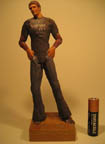
New 3D Printing Service For Second Life Objects
The excellently named Fabjectory is the latest service offering to produce a physical model of an object that exists only in the virtual world of Second Life. For $75 and up, you can get a 3D model of your avatar, complete with detailed color textures applied. The project comes from one Michael Buckbee (aka SL’s Hal9k Andalso), who also runs Second411, a third-party search site for Second Life. I’m guessing the Fabjectory will produce better results than the other 3D milling service that was offered to SL residents, only because that one more or less withdrew its offer in the end for artistic reasons. I’m not sure of the exact 3D printing technology being used here (an email is out to Michael), but the site says the models “are built from a plaster material that is built up in layers to form the right shape.” Tao Takashi has a good roundup of the situation on his blog, and Amazon’s Jeff Barr has more. Order today. [blogged by Mark Wallace on 3pointD]
Posted by jo at 09:23 AM | Comments (0)
Move by Andrew Hieronymi
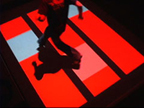
Performing Verbs
Move by Andrew Hieronymi is an interactive installation divided into six distinct modules. Each module offers single-user interaction based on a verb corresponding to the action the participant is invited to perform. JUMP, AVOID, CHASE, THROW, HIDE and COLLECT comprise the six modules.
The participant interacts with abstract shapes such as circles and rectangles. In the game of AVOID, the participant has to avoid getting his or her circle hit by a red particle. Whereas in the game of JUMP, the participant has to jump from platform to platform before they fade away.
Check out the videos of each of the six modules. Move was presented at this years Ars Electronica Festival. [blogged by Lene Mailund on Digital Experience]
Posted by jo at 09:16 AM | Comments (0)
Bridge, by Michael Cross

Walk on Water
“Bridge is a spectacular new site-specific design commission for Dilston Grove, London (Cafe Gallery Projects) by Michael Cross. Housed in a former church, (one of the earliest examples of poured concrete construction and a Grade II listed building), the piece comprises submerging two thirds of the inside of the church in water, and producing a series of steps which rise out of the apparently empty man-made ‘lake’ as you walk across them. Each step emerges one step in front of you and disappears back underneath behind you as you go. This ‘bridge’ is purely mechanical, the weight of the person on it depresses each step a little, this force activates a submerged mechanism which raises the next step.
The public are invited to walk out on it as if walking on water, eventually reaching the middle of the lake, thirty steps and twelve meters from the shore. There they will stand alone and detached, stranded in the middle of a plane of water until they choose to return the way they came. For some people this experience of being cut off and surrounded by water will be peaceful, for others terrifying. For some walking across the water will be pure childish joy, whilst others will be too scared to try”. (full text)
Fantastic! I am really looking forward to seeing this work and standing in the middle of water. I’ll post some photos and more detailed observations next week.
I saw products from Michael at the RCA show in 2004 (link), so its no surprise that this event is part of the London Design Festival, although the first time Cafe Gallery Projects have shown the work of a designer in the church. 20th Sep - 29th Oct at Dilston Grove, Southwark Park, London (location map). Opening preview this Sunday.
Bridge was commissioned and curated by Andrée Cooke. [blogged by Chris O' Shea on Pixelsumo]
Posted by jo at 09:02 AM | Comments (0)
AXIOM Gallery presents:
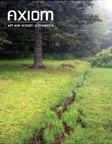
Art and Science: A Symbiosis
AXIOM Gallery presents: Art and Science: A Symbiosis :: Opening Reception - September 22nd 6-9pm :: Performance by John Holland: Wed. Sept 27th 7:30pm :: Cultural Evolution Discussion: Oct. 11th, 7:30pm :: AXIOM Gallery 186 Hampshire Street, Cambridge, Massachusetts. Corner of Hampshire and Prospect Sts in Inman Square.
Featuring work selected by the Nature and Inquiry group, including: Sahra Brady, Donald Burgy, John Holland, Margot Kelley, Nathalie Miebach, Amy Robinson, Nita Sturiale, Gail Wight, and Ron Wallace.
Art and Science a Symbiosis, explores biological and, cultural symbiosis and the symbiotic relationship between art and science, as well as showcasing a variety of works that exemplify the juxtaposition of art and science relating to the development and evolution of contemporary culture.
Gallery Hours: Friday, Saturday, and Sunday 2-6pm or by appointment. For more information, visit www.axiomart.org or call 617-513-6375.
Posted by jo at 08:36 AM | Comments (0)
Upgrade! Montreal
![]()
explosive electro_sound
Upgrade! Montreal: The September 13th 2006 Upgrade culminates two years of explosive presentations, performances and gatherings by the grassroots organisation Upgrade Montreal. The Upgrade has always loved the sonic arts and so it is only appropriate that we close our 2006 season with two of the most intense investigators of sound that call Montréal a second-home: internationally acclaimed sound-artist Francisco Lopez and underground breakcore and genre-destroying turntablist Fishead.
Spain's Lopez is well known for his many albums exploring field recordings that approach intensive levels of noise while retaining the heterogeneity of a soundscape. He recently completed the Montreal Sound Matter project at Quartier Ephemere where he worked with local sound-artists to capture and reinterpret the sounds of Montreal. For the Upgrade Montreal, Lopez will discuss his recent "Blind City" soundwalks in which the blind lead blindfolded listeners around the city. We will also be subject to a high-volume performance in as much darkness as we can muster.
Fishead still lurks in the shadows in Montreal. A native Winnipegger and dedicated Midwesterner, Fishead has risen to acclaim as Montreal¹s number 3 DJ (ranked by Mirror columnist Steve Lalla in 2006). After some 16 years behind the turntables and with an encyclopaedic memory of vinyl history (and a massive record collection to boot), the articulate Fishead will discuss his approach to conceptually and technically layering disparate track selections. For our ears, he will demonstrate some of his "collision engineering" techniques on the decks. Don't miss what will be undoubtedly a learning experience for any DJ willing to call themselves by the name. Long-time DJ partners Fishead and tobias c. van Veen will finish the evening with a classic ControlToChaos.ca tag-team set.
Posted by jo at 08:27 AM | Comments (0)
September 13, 2006
empyre discussion: Luis Silva + Joanna Callaghan

Mobile Media
Hello everyone,
I am very happy to be able to be part of this month's discussion. Having studied Social Sciences and personally interested in how they can share some insights over our relation to technology, Mobile Media is such an interesting subject to be discussing. Mobile media changed the way we interact with technology, with physical (i won't be using the term real) space and with each other. The term here is ubiquity, no longer nomadism. These devices have been shaping a new kind of public space that is no longer the utopian cyberspace of the ninetees, but a new one that still relates to a certain extent to Habermas's definition and has , by means of its own mobility, a strong relation to the physical space in which we lead our daily routines. It is public, but is is also private, it is dependent of the physical environment but only to deny its specificity and minimize the importance of local references and context.
A good example of this new kind of public space, not dependent on the geography but on connections, that can also serve as a good starting point to this debate is the project "As if we were alone" by the artistic duo Empfangshalle. This project adresses the mobile phone user and how he or she creates mobile "private spheres" while communicating over the phone. They have concluded that "whoever uses his cell phone in public dissociates himself from his surroundings via real or virtual spaces".
The core of the project lies in this process of dissociating oneself from the physical space through mobile media. One departs from the geographically defined public space of the streets, the squares, or public transportation to join a (semi) public space defined by the amount and variety of connections.
So my point here is, are these two public spaces ontologically different, despite overlaping? Is this mobile media space truely a public space, or a new version of the concept of private sphere, but once again with no physical references?
Best,
Luis [posted on empyre]
From: "Joanna Callaghan"
Subject: RE: [-empyre-] mobile media
To: empyre@lists.cofa.unsw.edu.au
Hi Luis and everyone else,
Thanks for inviting me Paula to be part of this months list.
I think Luis' comments are a really good starting point. They also happen to be directly related to some work I did recently called Mobile Dream Telling, was part of the Sydney Design Festival. (http://mobiledreamtelling.blogspot.com/)
What might be useful to discuss is whether the concept of 'space' is relevant to the notion of mobility. Perhaps what we are dealing with is different ways of being within time. Are mobile phones changing how we are to ourselves and to others? Do they influence our sense of self? Is the mobility that is at the heart of the mobile phone creating mobile, mulitple ‘egos’ or ‘selves’? Who or what is the remote ‘other’?
Theorist Sadie Plant believes that mobile phones have created a new form of functioning of peoples minds which she refers to as bi-psyche. This double psyche is required to attend simultaneously to the real world that physically surrounds the speaker and the virtual world that is opened up through the phone he or she is holding. She raises questions around the effects of what can be seen as a schizophrenic existence or bi-psyche, that is a divorce between what one says verbally and what one does with one’s body.
Following on, Jose Luis Pinillos has coined the phrase The Present Extensive as a way of living in time that emerges as linked to the modern city or urban psychopathology. ‘…with its incessant mobility and rapidity of its changes, the city situates its inhabitants in a permanent here and now, where references to yesterday and tomorrow vanish. Precisely because of this provisional character that prevails and because urban existence accentuates the ephemeral nature of all events, the technified city produces in those who live there a form of living in time that has been called the ‘present extensive’ (Pinillos 1977:239)
So what does this mean in terms of the self? If mobile phones allow us to manage multiple identities simultaneously what does that mean for our relationships? Can we collate these identities to create an enduring or permanent sense of self that I think, is necessary to live and make sense of ones life? If mobile phones connect us to particular, remote others, do they close us off consequently from the spontaneous, unexpected contact with strangers that can be so important in opening our experiences and minds to our fellow human beings?
These are purposefully philosophical questions since my own interest in mobile media is not about the technology but about the sociological and psychological effects, affects, consequences, influences and creative product that can be derived from these fascinating little machines.
Joanna
Posted by jo at 12:42 PM | Comments (0)
Upgrade! Johannesburg
![]()
Andre SC: TECHNOGRAFFI
Upgrade! Johannesburg :: September 16, 2006: Andre SC: TECHNOGRAFFI: Drawing the pixel curtain :: 3pm, WSOA Digital Arts.
In /*technoGraffi* - drawing the pixel curtain/, André SC will show and discuss some of his recent ‘stuff’ involving generative procedures, pseudo neuro-biological theory, ridiculous amounts of pornography, 'post-digital abstraction' as well as netVerse - the current interactive online project that N. Stern describes as “a noteworthy feat …a cross between fridge magnet poetry, geeky guy gluttony, snot flinging, and surrealist games…”
New media manipulator (read pixel-maniac), André SC a.k.a. Clements completed a BA at the University of Pretoria in ‘95. Since then he has been a designer, corporate consultant, experimental artist, studied some more stuff and lectures in Media Design Technology. He is the web-editor/developer of davidkrutpublishing.com and keeps a personal blog site at pixelplexus.co.za. also see his net.art project, netverse.
Posted by jo at 12:32 PM | Comments (0)
Drunken Boat 8
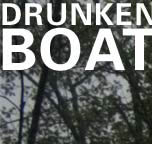
Awards
Drunken Boat 8: W E B A R T Judged by Talan Memmott; WINNER: Jason Nelson; SPECIAL MENTIONS: Thomas Petersen, Andres Manniste; EDITOR'S CHOICE: Juliet Davis FINALISTS: J.R. Carpenter, Neil Jenkins, Bioteknica, Sally Pryor, Jessica Gomula, Maria Miranda and Norie Neumark.
V I D E O Judged by David Hall WINNER: John Fillwalk SPECIAL MENTIONS: Christina McPhee, Daniel Shiffman; EDITOR'S CHOICE: Ethan Ham; FINALISTS: Rosemary Bodolay, Joy Garnett, Keith Tuma/jUStin!katKO, Justyna Latek, Dene Grigar and Steve Gibson, Ryan Hovenweep and Rory Keohane.
S O U N D Judged by Paul D. Miller WINNER: Erik Bünger SPECIAL MENTIONS: The Night Collective, Matthew Burtner, Marcelo Radulovich EDITOR'S CHOICE: Maxime Tanaka FINALISTS: Sawako Kato, The Phonographers, Union, Ken Urban, Philip Blackburn, Joan Schuman, Krista Franklin & Alison Chesley, John Hudak.
Posted by jo at 11:50 AM | Comments (0)
The Flattening and Opening of Space
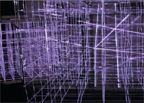
and Walking/Listening/Recording
Carrie Bodle will be presenting her work at two openings in the Pacific Northwest in the upcoming weeks. Her collaboration with Margie Livingston in the New Works Laboratory 2006, jointly sponsored by 911 Media Arts Center and the Henry Art Gallery, The Flattening and Opening of Space, explores artworks at the intersections of painting and installation art to investigate the boundaries between 2-dimensionality and 3-dimensionality. Their project incorporates drawing, sound, and projected imagery to create the experience of being inside a perspective drawing. By opening what is usually flat, and flattening what is usually spatial, Bodle and Livingston challenge the viewer’s preconceptions of space.
2006 New Works Laboratory at 911 Media Arts Center: Carrie Bodle and Margie Livingston: The Flattening and Opening of Space; Robert Campbell and Yuki Nakamura: Floating Plaster/City Motion.
September 12–October 27, 2006 :: Monday through Friday, 12:00 noon–6:00 p.m. :: Opening Reception: Tuesday, September 12, 2006, 6:00–9:00 p.m. :: Location: 911 Media Arts Center, 402 9th Ave. N. (at Harrison), Seattle 206.682.6552 www.911media.org
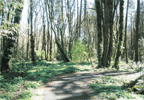
Walking/Listening/Recording: Tryon Creek (2006) is a 10-channel sound installation set along the Trillium Trail in Tryon Creek State Park, Portland, Oregon. Along the initial 250ft passage of the Trillium Trail, speakers from hidden locations cast layers of found sounds interwoven with poetic murmurs and field recordings from around the Red Fox Bridge area in the park. William Stafford's poem "Walking with Your Eyes Shut" inspired the use of poetry in the piece - to form a dialogue between the visual and audible experience. These layers of sound are intended to engage visitors in a sonic narrative along the trail.
Friends of Tryon Creek State Park presents: Natural Cycles: A Celebration of Art in the Forest :: Carrie Bodle's Walking/Listening/Recording: Tryon Creek State Park.
September 17, 2006 – August 2007
Opening Reception
Sunday, September 17th, 2006
5:00 - 7:00pm
Location:
Tryon Creek State Park, Portland, Oregon
Artists:
Julian Voss-Andreae
Christine Harrington
Leta Evaskus
Carrie Bodle
Martha Morgan
Charissa Brock
Contact: Stephanie Wagner
Executive Director
503-636-4398
www.tryonfriends.org
Posted by jo at 11:38 AM | Comments (0)
Upgrade! Paris Launches with

Atau Tanaka
Upgrade! Paris: Atau Tanaka :: September 22, 2006 :: "THE UPGRADE! PARIS" - VENDREDI 22 SEPTEMBRE 19h - ARS LONGA Incident.net est heureux de vous annoncer la naissance de "THE UPGRADE! PARIS" AVEC ATAU TANAKA, qui présente son nouveau projet, « Net_Dérive » qui aura lieu a la Maison Rouge les 6 et 7 octobre prochain. Médiateur : Dominique Moulon.
Atau Tanaka bridges cultures of east and west, of technology and music. He creates music with sensors and networks - a composer who is performer, a performer who is instrument builder, finding the voice in interactive technology. His first inspirations came in the 80’s upon meeting John Cage. He came up in Silicon Valley in the 90’s making music from virtual reality technology. He moved to Paris in 1992 and played music festivals like Sonar, Musique Action and Club Transmediale, and arts centers like IRCAM, STEIM and V2, making interactive systems for Fred Frith and others. He founded Sensorband with Zbigniew Karkowski and Edwin van der Heide, mythic for their physical performances and monumental instruments.
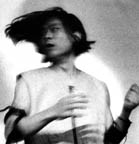
After five years in France, he moved in 1997 to Japan for a project at NTT/ICC and came in contact with the noise music scene, playing with Merzbow, Otomo, KK Null and others. Back in France since 2001, he has realized large scale installations with Kasper Toeplitz and network pieces including a commission from the German radio SWR. He has curated a collection of Japanese music for the San Francisco Museum of Modern Art.
Atau is best known for his performances with the BioMuse - a sensor system that turns his body into a musical instrument. Muscle tension is captured and modulates digital signal processes in the computer. Concentrated gestures, not unsimilar to Tai-chi, create pulsing organic electronic sounds. He creates layers of pure tones and noise, sculpting and filtering with broad strokes with his arms. Sweeping through empty space, he creates virtual sculptures in sound, making the listening experience visceral.
Atau’s work has beern recognized by the Ars Electronica, the Cyberstar award, and the Daniel Langlois Foundation for Art, Science and Technology. He has CD releases on solo, group, and compilation recordings on labels such as Subrosa, Bip-hop, Caipirinha Music, Touch/Ash, Sonoris, Sirr-ecords, and others.
Posted by jo at 10:41 AM | Comments (0)
Living in a World of Smart Everyday Objects
Risk Evaluation of Pervasive Computing
A quote from Jürgen Bohn, Vlad Coroama, Marc Langheinrich, Friedemann Mattern, Michael Rohs Living in a World of Smart Everyday Objects – Social, Economic, and Ethical Implications. Journal of Human and Ecological Risk Assessment, Vol. 10, No. 5, pp. 763-786, October 2004.
Today’s technical infrastructures, such as the phone system, television, and electricity, are relatively easy to use, even for people with no special qualifications. This also entails the ability to detect malfunctions: for example, if you lift a telephone receiver and do not hear a dial tone, it is immediately evident that the phone (either the handset or the landline) is not working properly. However, this type of predictability of system behavior can no longer be taken for granted in an ambient-intelligence landscape, as systems are expected to function without users noticing their presence. This will make fault detection and diagnosis fundamentally difficult, especially for the layman (Estrin et al. 2002). Additionally, users might continue to rely on a failed service (e.g., an automated backup service or the self-diagnostics of a smart product) without noticing, thus increasing the damage done until the problem is finally discovered. [blogged by nicolas on pasta and vinegar]
Posted by jo at 08:12 AM | Comments (0)
September 12, 2006
CONFLUX 2006
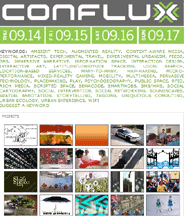
Festival for Contemporary Psychogeography
CONFLUX 2006 begins this week, and we invite all of you to join us! This year's Conflux will take place September 14 - 17th, headquartered at the McCaig-Welles Gallery in Brooklyn. Over 80 artists from across the US and countries including Canada, UK, Spain, Germany, Finland, Sweden and Australia will come to Williamsburg to present projects including experimental walking, biking, boat and public-transport tours; street games and tech workshops; mobile broadcasts, performances and temporary installations. For more information, including a detailed schedule, project descriptions, and contributor bios, please check the Conflux website! [posted by krista on Glowlab]
KEYWORDS: AMBIENT TECH, AUGMENTED REALITY, CONTEXT-AWARE MEDIA, DIGITAL ARTIFACTS, EXPERIMENTAL TRAVEL, EXPERIMENTAL URBANISM, FEEDS, GPS, IMMERSIVE NARRATIVE, INFORMATION SPACE, INTERACTION DESIGN, INTERACTIVE ART, LATITUDE/LONGITUDE TRACKING, LOCAL SEARCH, LOCATION-BASED SERVICES, MANY-TO-MANY, MAP-MAKING, MICRO-PERFORMANCE, MIXED-REALITY GAMING, MOBILITY, MULTIMEDIA, PERVASIVE TECHNOLOGY, PLACEMAKING, PLAY, PSYCHOGEOGRAPHY, PUBLIC SPACE, RFID, RICH MEDIA, SCRIPTED SPACE, SEMACODE, SMARTMOBS, SMS/MMS, SOCIAL CARTOGRAPHY, SOCIAL INTERVENTION, SOCIAL NETWORKING, SOUNDSCAPES, SPATIAL ANNOTATION, STORYTELLING, TAGGING, UBIQUITOUS COMPUTING, URBAN ECOLOGY, URBAN EXPERIENCE, WIFI.
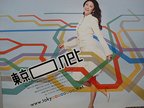
Killing the Fathers, or: If You Meet Jane Jacobs On The Road...
Adam Greenfield
This is a short talk about a great many complicated things: about urban form in an age of mobile, ubiquitous and pervasive computing; about how our relations with places familiar and unfamiliar change as a result of our engagement with new information technologies; and, above all, about how we may need to jettison our dependence on the beloved heroes and heroines of 20th century urbanism in order to understand what's happening all around us.
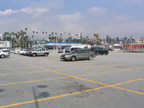
Parking Public
Ryan Griffis
Parking Public is an investigation into the realities of utopian thought as materialized in the mundane and pragmatic spaces of parking lots. Parking lots, one of the most visible, yet overlooked, artifacts of American mobility reveal the concrete space required to store the supposed tools of utopian ideals. Parking Public is a mapping of these literally concrete spaces in an attempt to locate the utopia they serve. Underneath both the empty spaces of parking and the empty promises of utopia are real economies and structures of power. For Conflux 2006, The TTO will offer a guided tour of parking in the Brooklyn area that will also serve as a participatory mapping of personal utopias upon the topography of property development. These tours will add to the Parking Public database of research on parking and utopias. This tour will be conducted by van, and can accommodate 11 people. If you would like to RSVP for the tour, to ensure a seat, please visit: temporarytraveloffice.net/rsvp The Temporary Travel Office has created tours of parking lots in Hollywood, historic downtown Los Angeles and Champaign, IL. These tours are augmented with distributed surveys, in embodied space and on the web, recording the utopian desires of the users. Cell phones will allow people to participate in the phone survey, but are not necessary.
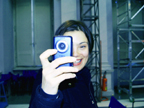
In the intimacy of the city
Régine Debatty
Designers, artists, and hackers have been very active over the past few years trying to find a way to reclaim the boundaries that we routinely create in our use of public space and that neither passersby nor electromagnetic fields respect.

Stations of a Commute
Nita Sturiale
Stations of a Commute is a series of audio tracks designed to be listened to during an urban commute away from one's loves - whether children, partners or life work. There are 14 stations in all, each preceded by instructions as to where they should be performed. The stations provide an opportunity to practice a walking meditation in the face of the city's noise and entropy, while also celebrating the community, culture and diversity the city provides. These 14 stations can be performed on any commute away from your loved ones and/or obligations. Listen to the narrations with a meditative and solemn approach. Stop walking, pull the car over for a moment. Take a breath. Reciprocate. This project is available as a Podcast from http://www.stationsofacommute.com or as a limited edition audio CD available during CONFLUX. Users will need either an iPod or a portable CD player to experience Stations of a Commute. The duration is as long as your commute is.
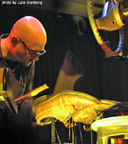
Radio Wonderland
Joshua Fried
A solo performance in which I subvert the local media stream--live FM radio--into recombinant funk. While the processing is all in the laptop, the tools are surreal: a real steering wheel (from a Buick), four old shoes hit with sticks, and a classic ‘80s boom box from which the original sound source emanates: all of it. Live. All radio bits are to be equally abstracted, recontextualized--stripped of their ability to soothe and distract. I want to show those who may be cowed by technology and media that we can manipulate the neverending flow. Therefore the processing is simple: framing, reshuffling, repeating, transposing. The surreal touch of ordinary objects (shoes, wheel) underscores the basic, congenial nature of the transformations. So, too, my riffs must be vernacular, and not elite. I want my audience to go home and start messing with their own radios--or TVs--with just a volume knob and tuner.
And much much more....
Posted by jo at 06:44 PM | Comments (0)
lonelygirl15

"we are witnessing the birth of a new art form."
Over the last week, i've gotten innumerable emails about lonelygirl15. Folks were wondering if i was behind it or if i knew who was. They wanted to know my opinion, if i thought it was fake.
I did. I thought it was fake but i expected that it was a TV or movie organization. I was kinda curious if it was an ARG but it didn't look like it. I decided that i should do a proper analysis of the different bits when the news broke: LonelyGirl15 is crafted by a group of filmmakers as an art project. Here's the letter they wrote to their fans on the forum explaining LonelyGirl15:
To Our Incredible Fans,
Thank you so much for enjoying our show so far. We are amazed by the overwhelmingly positive response to our videos; it has exceeded our wildest expectations. With your help we believe we are witnessing the birth of a new art form. Our intention from the outset has been to tell a story-- A story that could only be told using the medium of video blogs and the distribution power of the internet. A story that is interactive and constantly evolving with the audience.
Right now, the biggest mystery of Lonelygirl15 is "who is she?" We think this is an oversimplification. Lonelygirl15 is a reflection of everyone. She is no more real or fictitious than the portions of our personalities that we choose to show (or hide) when we interact with the people around us. Regardless, there are deeper mysteries buried within the plot, dialogue, and background of the Lonelygirl15 videos, and many of our tireless and dedicated fans have unearthed some of these. There are many more to come.
To enhance the community experience of Lonelygirl15, which you have already helped to create, we are in the process of building a website centered around video and interactivity. This website will allow everyone to enjoy the full potential of this new medium. Unfortunately, we aren't programmers. We are filmmakers. We are working furiously to complete the website, and hope to have it up and running shortly.
So, sit tight. You are the only reason for our success, and we appreciate your devotion. We want you to know that we aren't a big corporation. We are just like you. A few people who love good stories. We hope that you will join us in the continuing story of Lonelygirl15, and help us usher in an era of interactive storytelling where the line between "fan" and "star" has been removed, and dedicated fans like yourselves are paid for their efforts. This is an incredible time for the creator inside all of us.
Some thoughts
Now that i've killed the suspense, let me back up and tell you about what happened. For those who aren't familiar, videos by LonelyGirl15 started appearing on YouTube over the summer. She's supposedly a teenager who is homeschooled by religious parents who don't know she's creating videos online. Her friend Daniel helps her with the videos and they often talk back and forth across their videos. It's rather endearing but too good to be true.
As more videos popped up, people started questioning whether this was real or not. Speculation mounted and fake lonelygurls started to appear. People created videos to comment on LonelyGirl15. People flocked to the LonelyGirl15 forum to discuss. Problem is the LonelyGirl15 domain was registered before the videos started appearing. People started tracking down more and more clues, trying to hone in on what it was, who was behind it. Suspicion mounted. In classic fan style, people dove right down and tore apart all of the data. Quite a few thought that this was an ARG, Jane McGonigal style, but she denied involvement on NPR. Others thought it was an advert or some marketing campaign.
The clues people dug up were fascinating. Personally, i was intrigued by "Bree's" MySpace profile. I knew it was fake but i didn't know if the YouTube LonelyGirl15 made the MySpace profile LonelyGurl15. Why did i know it was fake? Well, i read too many teenage MySpaces. Not sure i should give away clues as to how to create a real-looking fake MySpace profile. ::wink::
Then press started covering it. Hands down, The New York Times had the best coverage. I can't help but wonder if the NYTimes knew the truth because they are certainly using the same language: "Hey There, Lonelygirl - One cute teen's online diary is probably a hoax. It's also the birth of a new art form." If so, go Adam for good reporting!
I like the idea that it is an art form but i also think it's part of what Henry Jenkins calls Convergence Culture. Regardless, it's super cool that people are using new media to create narratives. They are telling their story, truth or fiction. Of course, this makes many people very uncomfortable. They want blogs and YouTube and MySpace to be Real with a capital R. Or they want it to be complete play. Yet, what's happening is both and neither. People are certainly playing but even those who are creating "reality" are still engaged in an act of performance. They are writing themselves into being for others to interpret and the digital bodies that emerge often confound those who are doing the interpretation. In many ways, this reminds me of the Fakester drama during the height of Friendster. As one of the instigators behind the Fakester manifesto explained, "none of this is real." I won't get all existential on you so we'll leave it at that.
In many ways, i have to admit that i'm sad that the truth is out. I was really enjoying the suspicion. Far more than any episode of Lost or reality TV show. I was enjoying not knowing who was behind it and spending hours speculating and trying to find hints. I was enjoying watching a community of people talk endlessly about what they thought might be going on. Sure, the videos were quite endearing (although the ending of Poor Pluto disturbed the hell out of me) but do i just want to watch the videos by themselves? I'm not sure. I think i liked them for the mystery.
Regardless, i absolutely love the way people are using all of these new social technologies to create cultural experiments. To me, this signifies the importance of social media.
Update: The LATimes is reporting that emails concerning the site come from the Creative Artists Agency (CAA), a talent agency in Beverly Hills. (Perhaps i wasn't as off as i thought?) [blogged by zephoria on apophenia]
Posted by jo at 03:22 PM | Comments (0)
Vholoce: Weather Visualiser
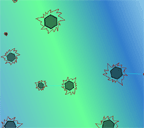
Seeking a Collaborator
Vholoce: Weather Visualiser :: A net artwork merging meteorological science, and digital artwork. Vholoce*: Weather Visualiser uses real-time weather data to create a series of visualizations intended to both artistically interpret weather conditions, and create new methods of understanding weather data. Working with talented programmer Rory Hering, Griffith University lecturer Jason Nelson created the weather visualiser as a prelude to future data visualization projects. Specifically, Jason and Rory are seeking interested parties to collaborate in developing a visualiser for Australian water data.
The weather visualiser lets the user choose cities from Australia, New Zealand, Canada and the United States. Those city’s current weather conditions (numbers representing temperature, humidity, pressure, wind, weather description) are then loaded into five different visualizations: Prose:Poetics, Animated, Molecular, Abstract:Noir, and Video.
*Vholoce is the Native American Creek tribe word for “cloudy”. [via Rhizome Raw]
Posted by jo at 02:59 PM | Comments (0)
Primary and Other Remote Locations
We recently finished a short video describing a project we started last summer (2K5), and that was completed early this summer. Just recently I posted it to youtube. It is somewhere at the intersection of database, painting, diy gis, walking work and locative media. Does painting put the taint on new media or new media the taint on painting, or both? But we don't worry very much about mixing oil (paint) with (scarce) water. Exploring the confluence of new and old media, as well as the virtual and real, is where we have been working recently. [posted by Brett Stalbaum on Locative]
Posted by jo at 02:18 PM | Comments (0)
net.weight project recently set up by Rich White
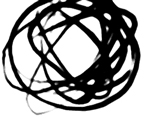
The Internet as a Sculptural Entity
On my internet Travels, I have just noticed a curious project by one of our Netbehaviourist's. It is called net.weight. It is initiated and administrated by Rich White. Its purpose is to act as a sounding board for ideas about the internet as a sculptural entity. Discussions could revolve around such topics as the size and mass of the internet, sculptural visualisations (literal, metaphorical etc...) and the sculptural methods used in creating net-based artworks.
the only rules are: - keep it on topic. - keep it clean. unless, of course you can justify it. - keep it professional, this is not a platform for grudge matches and insults. - the administrator reserves the right remove any posts deemed to break the above rules.
go and have a browse, even join in on the discussions:-) Main page. About. [posted by marc garrett on netbehaviour]
Posted by jo at 02:06 PM | Comments (0)
TESLA Medien>Kunst

Picturing Free Knowledge
Picturing Free Knowledge :: Friday, 15 and Saturday, 16 September, 20:30, at TESLA Medien>Kunst
Image economies take place between Big Business and Creative Commons licences: The Brasilian agency Radiobrás started publishing its news and multimedia broadcasts under CC licences just this summer. During Robbie Williams' recent tour in Germany photographers were not permitted to take pictures of the pop star. A Berlin newspaper reacted by publishing mobile phone pictures taken by their reporter -- the resolution was accordingly low. If one compares the search results in Google Images with the results from databases like Corbis and Getty Images, one has to find out that the pay services clearly
offer higher quality.
Starting from the debate on copyrights, the videos in the programme ask for the power relations in image production and distribution. Which pictures dominate the discourse of the media? How can images be created and distributed outside copyright obligations? What does the enormous and enthusiastic image production in online video communities such as YouTube mean?
The programme presents artistic strategies by which power relations and media image policies represented in images are reflected: The correspondence with the footage-department of a company selling royalty-free film and video clips for commercial purpose reveals their guidelines allowing nothing but hegemonic and stereotypical images. For a moment the logic behind the circulation of capitalist value becomes visible. In other cases, works demand a freer way of dealing with images, for example when public domain footage from film archives is rearranged and published under a Creative Commons licence.
Picturing Free Knowledge I: Image Banks
Friday, 15 September, 20:30
Videos by Johanna Billing, Nina Fischer / Maroan el Sani, Nate Harrison, Marysia Lewandowska / Neil Cummings, Sean Snyder, VitoriaMario, Florian Zeyfang and others
The first programme entitled 'Image Banks' takes existing images as its starting point: Images and their sources are reflected in different contexts, for example, the homogenous aethetics of news images or the categories of commercial image databases are called into question.
Later in the evening, Ricardo Ruiz and Tatiana Wells, currently residents at TESLA, will play a music programme and live stream mix from Brasilian radio stations.
22:00 Klub: rádio cidadão comum: net batucada brasileira on free and pirated music
Picturing Free Knowledge II: Image Agents
Saturday, 16 September, 20:30
Videos by Anna La Chocha, Anja Kirschner, Dariusz Kowalski, TV-TV, Tobias Werkner and others
'Image Agents' compiles video works that make productive use of found footage or pursue new concepts for media knowledge production. The programme is about the appropriation of visual technologies, formats and styles.
Following this logic, Serhat Köksal stirs up mass culture: orientalism, pop, politics and folklore collide in the works of DJ Hugo Chavez & VJ Ahmadinejad.
22:00 Klub: 'MyTube & YourSpace' by DJ Hugo Chavez & VJ Ahmadinejad
tesla berlin - andreas broeckmann - artistic co-director klosterstr. 68-70 - d-10179 berlin - tel. +49-30-24749-761 ab@transmediale.de - http://www.tesla-berlin.de
Posted by jo at 10:01 AM
| Comments (0)
September 11, 2006
Snow


Take two sheets of paper
Make Two paper airplanes
Throw them in the street
*Make certain that many people do this at the same time. [posted by alex on IT IN place]
Posted by jo at 06:54 PM
| Comments (0)
Google Will Eat Itself - No. 5

202.345.126 Years until GWEI fully owns Google
Dear GWEI Subscribers,
The current stats: Google Shares owned by GWEI: 123 Amount of USD: 47.276,28 Adsense-Clicks: 126.336 Adsense-Page Impressions: 5.448.926 Adsense-CTR: 2,31% Counter: 202.345.126 Years until GWEI fully owns Google Current Google Share Price: 384.36 USD, Symbol: "GOOG".
Google's Legal Department has contacted us with a very nice and open letter signed by Dr. Arnd Haller, Legal Rep. He stated that Google thinks we are doing great work but somehow something illegal, that they are fully aware that this is an art piece but still we should kindly stop with our assumed illegal activity.
Letter in German.
Our next exhibition will be at the ICC NTT Museum, Tokyo (JP). The "Connecting Worlds" Exhibition curated by Yukiko Shikata, with artists such as Peter Fischli and David Weiss, Dennis Oppenheim, Ambient.tv, Wayne Clements. We will show a digital Slideshow next to a terminal with the web-site:
http://www.gwei.org/pages/exhibitions/slideshow_ICC_tokyo
Media Coverage was very good during the last months, GWEI was featured in BBC World (Radio), Kulturzeit (3Sat TV), Telepolis, Artforum News
and in a lengthy article in Spiegel Online (Deutsch): and "die Presse" (Deutsch) and Sueddeutsche Zeitung (SZ) (Deutsch) and Heise Online, attacking our future project called Amazon Noir.
Additionally, on July 12, 2006 we have frozen a copy of GWEI and added it to the Rhizome Artbase for conservation. And.. we will present GWEI on October 24th at the New Museum New York for the Rhizome 10 years anniversary.
best regards and lovely hugs from the team
UBERMORGEN.COM feat. Alessandro Ludovico vs. Paolo Cirio
Hans Bernhard
UBERMORGEN.COM / etoy.holding
Skype Hans_Bernhard
Studio +43 1 236 19 85
Mobile +43 650 930 00 61
Email hans[at]ubermorgen.com
http://www.ubermorgen.com
Posted by jo at 06:30 PM
| Comments (0)
A Certain Brazilianness
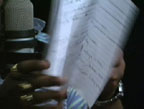
Maurits Script
Maurits Script, the third part of her ongoing project A Certain Brazilianness by Wendelien van Oldenborgh :: 23 September – 29 October 2006 at Casco.
In the attempt to find an alternative mode of production, ‘A Certain Brazilianness’ became the title of a multidisciplinary process, based on relations and resonances. From a heterogeneous Brazilian culture a number of significant strategies, partly stemming from the social sphere, have led to impressive moments of cultural production. As a way of working, A C_B__ transfers these possibilities into the production of film, drawing on the basic language and roles in a film production to set up situations that lead to new relations. Two performative stages have taken place so far. In these active encounters the participants were performers as well as viewers and listeners, creating the script and cinematic material during the event.
The third part will be based on a script compiled of excerpts from different sources relating to Johan Maurits van Nassau’s period as governor of the North East of Brazil (1637 - 1644), for which he has often been credited as being an early modernist ruler. Maurits Script focuses on the paradoxes and inner conflicts produced within the art of governing, the institutions of the period, and personal relations at a moment when many different groups found themselves living together with clashing interests. It will be staged and filmed at a live event in the Golden Room of the Mauritshuis, den Haag (built by Maurits during his period of government in Brazil), where a group of participants, each of whom have differing relations to the contents of the script, will perform it and discusses its contents in relation to the present day.
Wendelien van Oldenborgh is based in Rotterdam. Recent projects include "A C_B__ Sound Track Stage" for “Cut For Purpose”, Museum Boijmans Van Beuningen, Rotterdam 2006, ”The Basis For A Song” for “Be What You Want But Stay Where You Are” (by Ruth Noack and Roger M. Buergel), Witte de With, Rotterdam, 2005.
14 September : Public film shoot: Mauritshuis, den Haag, 1-4pm
Korte Vijverberg 8, NL 2513 AB Den Haag
The film shoot is open to the public, but the Mauritshuis' standard entrance fee applies to all visitors.
Friday 22 September: Opening of exhibition at Casco, 6-9pm
Sunday 22 October: Discussion and screening of final edit of the film, 5-8pm
Maurits Script is supported by Fonds BKVB, Amsterdam, Gemeente Utrecht and the Mondriaan Stichting.
Casco
Office for Art, Design and Theory
Oudegracht 366
Utrecht 3511PP
T/F: +31 (0)30 231 9995
info[at]cascoprojects.org
Posted by jo at 06:24 PM
| Comments (0)
ARUP Advanced Geometry Unit
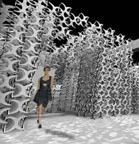
h-edge
ARUP Advanced Geometry Unit: h-edge :: September 14 to October 28, 2006 :: Opening Reception: September 14, 6-8PM.
This fall, Artists Space presents h-edge, a new project created by Cecil Balmond and ARUP Advanced Geometry Unit, a think tank dedicated to researching complex structural geometry in support of new architectural visions and solutions. AGU’s installation at Artists Space will function as an enclosure within the gallery, allowing visitors the opportunity to experience, interact with, and compartmentalize physical space in new and exciting ways. h-edge is an experiment in the use of geometry and matter to create organizations of space. h-edge traverses the boundaries of mathematics, art, architecture and engineering, exploring new opportunities of complexity.
The project exists on three levels: the mathematical-geometric, the architectural-spatial and the structural-tectonic. h-edge is based on a cubic fractal tiling of space known as the Menger Sponge. The geometric matrix of this sponge is modular and self-similar offering positive and negative space at embedded scales. This binary tiling is deployed at three different scales, which create spatial conditions that relate to the scale of the human body. These are named cave, trench, and path.
Tectonically, the tiling is achieved through the use of two modular units: the leaf and the chain-link, which interlock to form a suspended network of reciprocal load-paths. The staggering of the plates along the chain in four directions ensures that no plate touches another and that the chain is pre-stressed to form a rigid load-path. h-edge and the Fourier Carpet are binary systems describable as ordered series of 0 and 1 digits in three- and two-dimensional mathematical space. They both demonstrate how number systems can be used to describe, control and inform geometric complexity.
h-edge has been designed by the ARUP Advanced Geometry Unit in London, and constructed in Philadelphia with the help of Penn Design students. It consists of 5200 laser-cut aluminum plates and almost 5000ft of stainless steel chain. The Fourier Carpet has been digitally generated and designed by Jenny E. Sabin in Philadelphia and woven on a digitized Jacquard Loom by Keystone Weaving in Lebanon, Pennsylvania. It is 36ft by 5ft and is composed of interlaced black and white wool threads.
Design Team: Cecil Balmond, Charles Walker, Francis Archer, Daniel Bosia, Jenny E. Sabin
Assembly Team: Jenny E. Sabin and PennDesign Students
Curated by Christian Rattemeyer
h-edge is supported, in part, by ARUP, the Graham Foundation for Advanced Studies in the Fine Arts, Elise Jaffe + Jeffrey Brown, and PennDesign.
ARTISTS SPACE
38 Greene Street, 3rd Floor
New York, NY 10013
T 212 226 3970
F 212 966 1434
artspace[at]artistsspace.org
http://www.artistsspace.org
Posted by jo at 04:12 PM
| Comments (0)
Sarai READER 06:
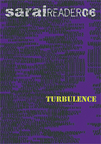
TURBULENCE
Sarai READER 06: TURBULENCE :: Editors for Reader 06: Monica Narula, Shuddhabrata Sengupta, Jeebesh Bagchi, Ravi Sundaram, Awadhendra Sharan + Geert Lovink ::
'TURBULENCE' (from the introduction): If there was ever to be a 'weather report' for our times, an audit of the climate in which we have grown accustomed to live, it would use the word 'turbulence' often. Turbulence is a practice for and of a time that has no name. This book, embodying that practice, is an eclectic index of an uncertain age.The Sarai Reader 6 uses 'Turbulence' as a conceptual vantage point to interrogate all that is in the throes of terminal crisis, and to invoke all that is as yet unborn. It seeks to examine 'turbulence' as a global phenomenon, unbounded by the arbitrary lines that denote national and state boundaries in a 'political' map of the world. Sarai Reader 6 surveys areas of low and high pressure in politics, economy and culture that transcend borders, investigates the flow of information and processes between downstream and upstream sites in societies and cultures globally, witnesses surges and waves in ideas and practices in contemporary art, culture and discourse as they crash against the shorelines of many dispersed locations.
How do we anticipate, recover from and remember moments of sudden transformation? How do we look at the debris of the past and brace ourselves for the whirlwind coming our way from the future? How do we deal with the simultaneous pressures of knowing too much or the anxiety of knowing too little about the world? How do we cope intellectually with the sudden dissolution of established ways of knowing and doing things? What does it mean to know and experience the pull of undercurrents - in society, politics, the economy? How do cities deal with the accumulation of complex infrastructural uncertainty? What happens when urban chaos strikes back at urban planning?How can we map the subterranean tectonic shifts and displacements that occur in culture and intellectual life? What are the histories of anxiety, exhilaration, dread, panic, ecstasy, disorientation and boredom like. How can we begin to narrate these histories? What does it take from us to tell stories, read poetry, make images and record experiences in the wake of turbulence?
Sarai Reader Series Editorial Collective: Monica Narula, Shuddhabrata Sengupta, Ravi Sundaram, Ravi S. Vasudevan, Awadhendra Sharan, Jeebesh Bagchi + Geert Lovink :: Sarai Reader 06: Turbulence is part of the Documenta 12 Magazines Projectí :: Published by the Sarai Programme, Centre for the Study of Developing Societies, Delhi, 2006 [cc] Produced and Designed at the Sarai Media Lab, Delhi :: ISBN 81-901429-7-6, 608 pages, 14.5cm X 21cm, Paperback: Rs. 350, US $ 20, € 20
Posted by jo at 03:57 PM
| Comments (0)
Denis Connolly and Anne Cleary
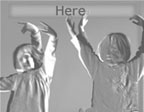
Here There Now Then
Limerick City Gallery of Art presents Here There Now Then by Denis Connolly and Anne Cleary :: 15th September – 27th October 2006 :: The exhibition will be officially opened by Mr Peter Power TD the exhibition at 7pm on Friday 15th September 2006.
Denis Connolly and Anne Cleary, installation and video artists, have lived and worked in Paris since 1990. Their work, which is highly regarded internationally, has appeared in such prestigious events as the Yokohama Triennial and the European Media Art Festival. This entirely new body of work, commissioned by LCGA with support from the Arts Council, uses interactive technology to explore a recurring issue in Cleary & Connolly’s work – the shifting boundary between art and life. The exhibition, comprising six video installations, uses 5 computers, 5 digital video cameras, and seven video projectors to create an exhibition where the spectator becomes actor, the gallery becomes theatre and the artist becomes spectator.
Collaboration has always been central to Connolly and Cleary’s work, and no less here. One of the works in the exhibition was created with Eriko Momotani who will be present at the opening to recreate one of her improvised soirées musicales, while at later date, October 14th at 3pm, the artists will be working with London based dancers John Hurley and Laura Murphy to create an interactive dance performance, made possible by Chris Hurley of the Cork Film Centre and Daghdha Dance Company, Limerick.
Here There Now Then an interactive exhibition conceived for the Limerick City Gallery of Art With the support of the Arts Council of Ireland, The Cork Film Centre, Daghdha Dance Company, Special thanks to Kinsale Arts Week And with the participation of Eriko Momotani, Laura Murphy and John Hurley.
Eriko Momotani, Japanese artist and curator, has lived in Paris since 1990, where she is a well-known figure in the Parisian art world. Renowned for her Micro-Expositions, Eriko questions the notion of public and private by curating exhibitions in her own apartment, thus turning her living place into a public space. This original and personal approach brought her to the attention of the Ville de Paris, who support her work highly, and the Yokohama Triennial, who commissioned three exhibitions from Eriko in 2005, one of which was Cleary and Connolly’s Yokohama Houseguests.
John Hurley trained at the London Contemporary Dance School. He currently works as a freelance dancer with established international choreographers and dance companies in London and throughout Ireland. Laura Murphy achieved an MA Honour in Dance Performance from the Irish World Music Centre in 2003, she is currently supported by the Arts Council of Ireland to train at Laban, London's leading Contemporary Dance Conservatoire. Limerick City Gallery of Art Pery Square, Limerick Ireland + 353 61 310633
Posted by jo at 03:48 PM
| Comments (0)
LAb[au] + Frederik De Wilde
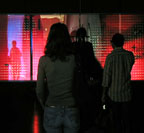
EOD02 + 12m4s
LAb[au] is pleased to invite you to the designers week exhibition presenting two installations: EOD02, a new-media installation in collaboration with Frederik De Wilde and 12m4s, an interactive audiovisual installation taking place at the auction-hall of the Palace of Fine Arts ( ...> ) in Brussels [ BE ] in the context of the exhibition Belgian designers of the 21st century, complied by Dirk Meylaerts and Marie Pok.
The exhibition includes works by: Alain Berteau, Bram Boo, Christophe Bourg, Damien Bihr, Benot Deneufbourg, Nathalie Dewez, Herman Wittockx, Hoet design, Dirk Meylaerts, Gauthier Poulain, Lucile Souflet, Sylvain Willenz , Tov Design, LAb[au] and [UR]Design.
12m4s :: The installation '12m4s' is an interactive audiovisual installation representing human flows by generating out of visitors' main parameters (position, orientation and speed) a visual (3d particles) and sonic (granular synthesis) dynamic scape in real-time. To achieve this result, the installation uses two different tracking techniques: firstly, image recognition is used to create spatial sounds (diffused through 8 speakers disposed along the 12m installation) and secondly, ultra-sound sensors are used to create visual echograms of the space (projected as background image along the 12m screen). These different tracked data influence a graphical vector-field
projected on the entire surface of the screen (foreground), where each of its vectors reacts to a visitor's movements while taking his/her orientation. Furthermore, graphical and sonic objects emerge at the point (location) where movement is recognized. Once created, these sonic and graphical elements start to move through the vector field, while trying to find their path.
For example: a visitor is passing by the installation, s/he is followed by a visual and sonic trace, but as soon as s/he changes direction or produces any other movements, s/he creates turbulences. According to this principle, the visitor can even more actively paint with his/her movements a sonic and visual space on the 12m surface, as it open ups to collective interaction.
The result, this 'particle synthesis' is projected on a 'Mylar' screen fusing projection and reflection while building a common space in between the digital and the body space.
EOD02 :: EOD 02 is a collaboration in between Frederik De Wilde and LAb[au]. The project is a new media installation founded on special species of fish that perceive, electro-sense, their environment and communicate with each other by emitting electric signals, either in pulses or waves. The project explores the normal communication mechanisms of electrical fish, including JAR (the means by which a fish avoids attempts by other fish to jam its frequency) and thus investigates communication and non-communication between individual fish as well as between fish and people.
The installation is based on four aquariums of taintless mirror, each presenting a specific composition of fish producing different electric signals. In each aquarium antennas allows capturing the fish signals which are directly related to four speakers transforming these signals into sound, what we hear is the fishs electric signals_ their communications. Further under each aquarium a light bulb is placed pulsing according to the intensity, rhythm, of the emitted signals of the blind fishes. In this manner the electrical impulses of the fishes drive sound and light, an entire audiovisual space.
Posted by jo at 03:43 PM
| Comments (0)
Year Zero One

TERMINAL01: CALL FOR SUBMISSIONS
Year Zero One is seeking submissions for Terminal01 (T01), an interactive networked art exhibition to be launched at Toronto Pearson International Airport in the spring of 2007. T01 will consist of a custom made kiosk housing a touch-sensitive screen, an audio-video output, an embedded web camera, sensors and projection screen. Artists are invited to create site-responsive computer generated work based on their experience and interpretation of air travel environs, mobility, flight data, airports and networked communities. Emphasis will be given to works with a generative component or works dealing directly with themes relevant to travel (space-time). Deadline for submissions is December 1st, 2006. Artist fees paid. T01 is curated by Michael Alstad and David Jhave Johnston. For more info and online entry form please visit: http://www.year01.com/terminal01/submit.html
Posted by jo at 03:40 PM
| Comments (0)
IRATIONAL ACTION WEEKEND
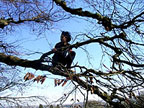
DIY - Do it yourself
IRATIONAL ACTION WEEKEND :: September 15-17, 2006 in Dortmund, Germany, various venues :: DIY - Do it yourself - is the central theme of the irational Action Weekend and you are cordially invited to participate!
On Friday night, Sep 15, Daniel G. Andújar (Valencia) invites you to present the Open Source software you like most, and to share it with others. This will be accompanied by an open bbq - please bring your own grill-food and drinks! During the "Tour de Fence" by Kayle Brandon and Heath Bunting (Bristol) on Saturday one can learn how to climb walls and fences and thus hack urban space. This scope is also addressed by the "International Tree Climbing Day" taking place on Sunday which will also be lead by Brandon and Bunting. Its motto is “Liberate the Horizontal! - Integrate the Vertical Super Surface!" “Natural Reality Superweed" gets planted in an appropriate Superweed Garden in front of the PHOENIX Halle. The genetically mutated superweed is resistant against Monsanto's roundup herbicides. Rachel Baker presents “Towards Death", a creative aerobic video with Cindy Crawford and music by Antifamily. The Mexico-based Mejor Vida Corporation issues Student ID cards on request which anybody can apply for in the exhibition "The Wonderful World of irational.org". On Sunday, the Mexican artist Minerva Cuevas (Mexico City) presents the actions by Mejor Vida Corporation in a lecture.
The program will be accompanied by guided tours (in German) through the exhibition “The Wonderful World of irrational.org" at PHOENIX Halle and a fabulous 10-years HMKV birthday party with the Irational Soundsystem (Valencia, Bristol, London, Mexico City), the HMKV Soundsystem (Dortmund) and Dortmund-based DJ Carstem Helmich (taxi nights).
curated by: Francis Hunger (HMKV Junior Kurator)
EXHIBITION: The Wonderful World of irational.org - Tools, Techniques and Events 1996 - 2006 curated by Inke Arns and Jacob Lillemose August 30 - October 29, 2006 Wed 11:00-17:00, Thu-Sun 11:00-20:00.
Posted by jo at 03:28 PM
| Comments (0)
Conference on Literature and the New Media

Remediating Literature
An international conference on Literature and the new media entitled Re-mediating Literature will take place at Utrecht University (the Netherlands) 4-6 july 2007, with keynote speakers Katherine Hayles, Marie-Laure Ryan, Jan Baetens, and Samuel Weber. Our website features all relevant information concerning the conferencem including the call for papers (deadline is November 6, 2006).
The conference revolves around the following issues: Recent developments in digital and electronic media have stimulated new theoretical reflections on the nature of media as such and on the way in which they evolve across time. The particular aim of this conference is to examine how recent technological changes have affected the ‘old’ medium of literature.
Multimedial and interactive texts, digitalized archives, cyberpoetics, and technological innovations such as foldable screens: together these have influenced the production and reception of literature, along with the ways in which we think about writing and reading. These ongoing developments call for a critical examination both of the relations between literature and the new media, and of the relations between literary studies and media studies.
The concept of ‘remediation’ in our title thus has a double thrust. Firstly, it refers to the transformative exchanges that have occurred in the past, and continue to occur, between literature and new media: how has digitilization affected literature as a cultural medium? Secondly, it indicates a relocation of literary studies within the broader field of (new) media studies: how could literary studies profit from the various analytical tools developed in (new) media studies and conversely, how could our understanding of earlier phases in the evolution of the literary medium contribute to our understanding of present developments? By working on both these issues, we hope to locate the place of literature within the milieu of modern media networks and technologies, but also to relocate the aims and practices of literary studies within the field of (new) media studies.
Main themes
A. New technologies and literary practice: the state of the field: Will literature continue to develop as a schizophrenic medium, a hard medium of printed matter and an unstable medium of electronic data at the same time, or will it fork out in one of two directions? How is digitilisation affecting reading practices and the circulation of literary texts? What new forms of ‘inter-medial’ and multimedial literature are emerging?
B. Literature and the new media: the longer view: What new light do recent developments throw on the history of literature as a cultural medium and, conversely, how might insights from the history of the literary medium contribute to our understanding of recent developments? How can literary history be rewritten in conjunction with such media technologies?
C. Media compatibilities and competitions: new media hardly ever completely subject and annihilate older media. Rather, the two tend to co-exist, each taking on different tasks and responsibilities (cf. film and the novel in the earlier twentieth century). At the same time, however, they often interrupt and compete with each other (cf. television and the digital in the later twentieth century). How can this duplicity of compatibility and competition be mapped and analyzed, and what are the insights that such analyses might yield into media formations as techno-cultural formations?
D. Disciplinary relocations: will literary studies become a branch of media studies in the foreseeable future - and if so, how? Will literary studies profit from such a re-location, and how will this re-location affect its objects and methodologies?
Abstract submissions:
-Topics:
*Changing conceptions and manifestations of the text from print to the digital age;
*Cyberpoetics and the hypertextual in digitalized and printed form;
*Remediation as a cultural process: how have different media reworked and incorporated each other, and how can such reworkings be theorized in terms of cultural memory and media archeology? This could, for instance, focus on the representation of new media in literature (cf. James Joyce, William Gibson), and the way in which these representations have in turn been stored in the practices of such new media;
*Copy-cats and mutations: how have textual, visual, aural, digital, and performative media functioned alongside each other, how have they co-existed? Which tasks and aspects do old media delegate to new media, or which tasks and aspects do new media copy form old media, and how has this changed the status and identity of the old medium?
*Old narratives, new games: narrative and narrative transformations across media;
*Technological inventions and their effects on the object of literary studies: the impact of new mediations of the literary through foldable screens and other flexible, wearable, handheld paper displays, as well as mobile acoustic networks;
*Institutional remediations I: web publishing, accessibility and canonization of hyperfiction, funding of literary projects on the internet, the emergence of new forms and practices of literary criticism on the internet, as well as the institutional development of new strategies and conventions in editing techniques;
*Institutional remediations II: literary studies from cultural to media studies: will we witness, in the foreseeable future, a ‘post-human’ paradigm shift in the humanities that redirects our focus from cultural studies to media studies?
-Submission guidelines:
Abstracts may be submitted through the following mailing address, indicating the applicant’s name, email address and present academic function:
remediatingliterature[at]let.uu.nl
*Abstracts should be no longer than 250 words, should summarize the topic of the paper, and must be written in English;
*Abstracts should conform to one or more of the conference topics;
*Abstracts will be selected by the Program Committee on the basis of originality, significance of contribution, and relevance to the conference topics;
*Abstracts can be submitted until November 6, 2006
*Authors will be notified of acceptance or rejection by e-mail by December 22, 2006
Posted by jo at 02:55 PM
| Comments (0)
REMOTE

You Bring the Secret Location to Life
REMOTE--by Chris Vecchio :: 9 September – 21 October 2006* :: Gallery Joe Bird Park
3rd and Arch Streets :: Philadelphia, PA :: * viewable 24-7 * best experienced at night * (but no sound after 10PM) :: INSTRUCTIONS: 1) Get up off of the couch 2) (but bring the remote control with you) 3) Go to the south west corner of 3rd and Arch 4) Use your remote to activate the park.
REMOTE is an interactive environmental installation containing a range of sound and visual effects. Installed in an outdoor space, the installation is activated, controlled, and navigated using a common household remote control which may be supplied by the viewer. The piece takes the form of an intervention in an outdoor space, along a street or in a small park. There’s an “insider” element to the installation since, when not activated, its location may not be immediately apparent to a passerby. Additionally, the viewer needs to know to bring a remote to the location to bring the secret to life.
At the installation site, pressing buttons on any (TV, DVD, VCR, audio, etc…) remote control triggers a myriad of responses ranging from subtle (bird calls or soft sounds emanating from hidden speakers, changes in the ambient lighting) to bombastic (more dramatic sound effects, explosions, strobe lights, or projected images). Each key press generates a unique combination of effects. Viewers may bring any remote control from home to activate the installation.
Central to my work is an interest in the expressive potential of electronic devices and in the potential for user interfaces to generate new modes of interaction. A set of social precedents now exists for interaction with electrical technology. When these precedents are followed but subverted or there is no clear immediate “functional” objective, a viewer’s expectations are challenged and an opportunity for reflection or commentary on the human-technology relationship is created. This project makes use of such ambiguity – juxtaposing the familiar with the unexpected – to encourage people to question their assumptions about technology and reflect upon their interaction with it.
The piece has a strong element of accessibility. People who may be intimidated by interactive work or by technology in general may be engaged because an everyday object is the agent of action. The experience of the installation is reminiscent of a coin-op arcade shooting gallery. Play and experimentation are encouraged as part of the experience. Participants can keep trying different units from their everyday collection because each remote interacts differently with the piece. This highlights the number and variety of remotes we use for everyday tasks, from the mundane to the complex.
Sound samples in this installation have been gathered from a wide range of sources including sound effect libraries, police scanners, popular music, short wave and CB radio, and by using peer-to-peer networks to search the internet for randomly (inadvertently?) shared audio files. The broad range of sources references the instrumental use of sound samples in music as well as common (mundane) technological interactions such as channel surfing or tuning across a radio band.
Finally, the installation presents the man-technology interface ironically. The couch potato is asked to get off of the sofa and experience art first hand, but still holding the ever-present remote. Issues related to the effects of technological mediation and the degree to which technology is an atrophying rather than an empowering force are raised.
Posted by jo at 01:38 PM
| Comments (0)
They Heart a Computer
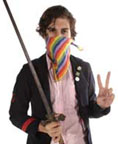
Rhizome @ The Kitchen
They Heart a Computer :: Tuesday, October 3, 8:00 p.m. @ The Kitchen :: Tickets $8 :: Curated by Lauren Cornell as part of Rhizome’s Tenth Anniversary Festival, this evening of live performances and video screenings explores forms of expression, desire, and anxiety prevalent in a culture increasingly influenced by the Internet. Doo Man Group (made up of Ben Jones, Jessica Ciocci, and Jacob Ciocci of Paper Rad) interweaves live percussion with a dense collage of web-based visual ephemera. Jona Bechtolt (of Yacht) and Claire L. Evans combine music, dance, and PowerPoint to explore the possibilities and fallacies embedded in online communities. In addition, videos by Michael Bell-Smith, JODI, Shana Moulton, Takeshi Murata, and humorist Ze Frank investigate how the Internet amplifies and exaggerates life offline.
512 West 19th Street between 10th and 11th Avenues. Subway: A, C, E to 14th Street; 1 to 18th Street; L to 8th Avenue
Posted by jo at 08:06 AM
| Comments (0)
UpStage

ADA Swaray
There will be an ADA Swaray in UpStage this sunday, 10th September,
at 9:00 p.m. New Zealand time. For other local times, check http://www.worldtimeserver.com/
ADA is Aotearoa Digital Arts, a network of digital artists in New Zealand. The swaray is a social forum for us to meet & discuss things. This sunday, a number of NZ artists who attended the recent ISEA in san jose will be reporting back on their experiences.
if you'd like to join us as audience, please come to
http://upstage.org.nz:8084/stages/swaray.
helen varley jamieson: creative catalyst helen[at]creative-catalyst.com http://www.creative-catalyst.com http://www.avatarbodycollision.org
http://www.writerfind.com/hjamieson.htm
Posted by jo at 08:04 AM
| Comments (0)
September 08, 2006
Turbulence Guest Curators: Ars Virtua

honesty is our policy
Turbulence Guest Curators: Ars Virtua :: Opening Here Tonight! September 8, 7-9 pm SLT (Pacific Time).
A few months ago, we invited Ars Virtua--a new media center and gallery located entirely in the synthetic world of Second Life--to curate an exhibition of Turbulence works for Turbulence.org. James Morgan, Amy Wilson and Jay Van Buren rummaged through our ten-year old archive and produced honesty is our policy with works by Cory Arcangel (Urbandale), Nicolas Clauss (Heritage), and David Crawford (Stop Motion Studies).
"…Honesty may seem like a hokey notion in "real-life," but in an environment like Second Life, honesty is all you have. Absent social cues, history, nature, all one has to go on is the trust in another that this is how they view reality, and to interact with anyone on a meaningful level, that version of reality must be accepted.” – Amy Wilson
"Ars Virtua" is a new type of space that leverages the tension between 3D rendered game space and terrestrial reality, between simulated and simulation. It brings the art audience into “new media” rather than new media to the museum or gallery, and calls upon its audience to interact with the art and one another via their avatars within the space. To visit Ars Virtua simply create a free account in Second Life and run the current client. Once you have this properly installed follow this link – secondlife://Dowden/20/40 – directly to Ars Virtua.
BIOGRAPHIES
JAMES MORGAN has shown work internationally and has recently produced a commission for ISEA2006/ZeroOne.
AMY WILSON is an artist represented by Bellwether in New York City. She has shown her work at numerous places, including PS1, The Drawing Center, and The Andy Warhol Museum, and has been reviewed in Art in America, The New York Times, the Village Voice, and Time Out NY among others. She teaches art history and drawing at the School of Visual Arts.
JAY VAN BUREN is an artist and web designer based in Brooklyn New York. He has curated and worked in design under the name early-adopter.com for the past 7 years. He was the founder and co-director of Videoland Gallery in Manhattan's lower east side and has exhibited paintings in New York, Kansas City and Washington DC.
For more Turbulence Guest Curators, visit http://turbulence.org/curators.
Posted by jo at 07:36 PM
| Comments (0)
DANCEPOD 2006

A Sculpture Composed of Simultaneous, Web-Connected Dance Parties
DANCEPOD 2006: On September 9th at 11pm in Portland, 12 am in Guadalajara, 2am in New York City, 3am in Mexico City and 7am in Berlin, dancepod will present an entirely new kind of sculpture. A sculpture composed of simultaneous, web-connected dance parties. The parties, coordinated and developed in conjunction with artists and presenters from each city, will utilize identical dancepod installations. The installations will become the core of a shared physical and virtual experience, supporting streaming video and music as well as live DJ’s, VJ’s, and surprising guest artists. Moving bodies of dancing participants will complete the sculpture.
As part of the Portland Institute of Contemporary Art's (PICA) Time-Based Art (TBA) Festival, in conjunction with PS122, Scene Downtown (Earl Dax), Harkness A/V (Nick Hallett), and technical directors Kraft + Purver, these 4 DANCEPOD sites will be linked by live video starting at 2:00 AM Eastern Standard Time.
NYC DANCEPOD features an eclectic array of New York artists. Join DJs Kevin Graves (Brite Bar) and Van Scott (Patricia Field's Party at element) and dance to visuals artists assembled by Nick Hallett and Harkness A/V, including Chika and Boris. Live performances by John Moran and Saori Tsukada, Sxip Shirey, and Glenn Marla.
Chez Bushwick will be hosting "The Changing of the Garde" starting at 8:00 PM on Saturday. Come early for DANCEPOD and enjoy performances by:
Wanjiru Kamuyu – Spiral
Jim Staley – Solo Trombone
Bruce Nauman - “Abstracting A Shoe (1966)” – Video Art
David Vaughan, Michael Cole, Jonah Bokaer – A John Cage Birthday Reading
Elke Rindfleisch - Untitled
Also... TECHNOPIA Interviews Carla Peterson, Newly-Appointed Artistic Director of DTW.
All this for $5. Come to both the Chez Bushwick and DANCEPOD events for just $10! That's like seeing the early show for FREE! (Regular DANCEPOD admission is $10).
Hosted By
3rd Ward Brooklyn
195 Morgan Ave.
Bushwick, Brooklyn, NY 11206
718.715.4961
www.3rdwardbrooklyn.org
Posted by jo at 05:46 PM
| Comments (0)
Tag Shufflesition:
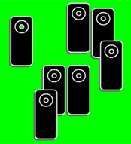
A Mobile Game of Mimicry and Mime
Tag Shufflesition: a mobile game of movement, mimicry and mime, that uses iPod Shuffles to see how fast can you find out who’s “it”! :: Designed by Charlie Hoyt and Andrew Bucksbarg, Indiana University Bloomington (2006) :: Central Park, New York :: Saturday, September 23, 2006 at 3:00PM.
Christo may have turned Central Park into a work of art, but Andrew Bucksbarg and Charlie Hoyt are part of a group of game designers who will be transforming New York into an enormous game level. Mobile and locative technologies have given rise to an international flowering of what are called urban games, street games or Big Games. These games explore new technologies and make the real world and urban spaces their playground. Tag Shufflesition will be featured in New York’s Come Out & Play Festival
From massive multi-player walk-in events, scavenger hunts to public play performances; the festival will give players and the public the chance to take part in a variety of different games. The festival will feature the innovative use of public space and games that make people interact in new ways, such as Tag Shufflesition.
Tag Shufflesition is a mobile system for movement and dance using the random playback feature of mobile mp3 players, such as Apple’s iPod Shuffle. The “Shufflers” (participants) receive random instructions from their iPods as to how to move and interact with the other Shufflers. One iPod is loaded with a slightly different set of instructions. The task of the Shufflers to find out which Shuffler among them is “it”- the one with the different instruction, and begin to mimic all of the “it” Shuffler’s movements. The game is complete when all of the Shufflers are correctly mimicking the “it” Shuffler.
Tag Shufflesition is engaging for both spectators and participants as an interactive game of patterns movement and mimicry. Shufflers will enjoy following the directions, which often exist as small games within the larger game of Tag Shufflesition. Spectators, without the distractions the Shufflers face, will also enjoy trying to guess who’s “it,” but please don’t give “it” away!
Charlie Hoyt is an Audio Instigator. When he’s not staring at a mixing board or making “music”, Charlie enjoys video games, rock ‘n roll, and name-dropping. Charlie is pursuing a Masters in Immersive Mediated Environments at Indiana University in Bloomington, Indiana, studying audio and music for participatory media. Charlie’s previous artistic fracases include “ToneBeast”, which received honorable mention at the 2004 Indiana IDEAS Fest and “MESS”, which received nothing, but is nevertheless fun. Email: audioinstigator(at)yahoo(dot)com
Andrew Bucksbarg is a techno-media artist, experimental interaction designer, audio-visual performer and a professor in the Department of Telecommunications at Indiana University. Bucksbarg’s work and interests reverberate in the space of creative new media practices, technology and theory. As an experimental interaction artist, Bucksbarg concerns himself with technologies and social systems that support tactics of ambiguous, autonomous social creativity and exchange. Bucksbarg’s work appears physically and digitally around the globe, including the Rhizome.org Artbase; Share DJ, NY; The 2006 Bent Festival, NY; National Museum of Australia, Canberra, Australia; Sonorities Festival, Belfast, UK; The Dark light Film Festival, Dublin, Ireland; Trampoline Media Festival, Nottingham, UK and dLux Media Arts Festival, Sydney, Australia. Email: Andrew(at)adhocarts(dot)org Press: 812-219-5310
Posted by jo at 04:37 PM
| Comments (0)
TANGENT_BURN featuring PLATONIQ
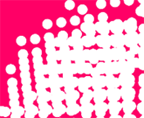
Bringing the Net Down to the Streets
TANGENT_BURN featuring PLATONIQ: This evening V2_Institute for the Unstable Media will be hosting a streamed performative presentation by Barcelona based activist art collective PLATONIQ. If you're not able to make it to V2_ in the flesh, and at the same time catch the opening of this year's 'Wereld van Witte de With' Festival, you're invited to join in on the stream beginning at 20.00 (CEST). The PLATONIQ presentation will be augmented by interventions from local Rotterdam sound and visual artists 'onehertexpressions', Zaplab Creative Television and Meticais.
To join the stream, please go to www.v2.nl, follow the link and have your Realmedia player ready! If you don't have the player, you may download one for free at www.real.com.
Afterwards PLATONIQ'S project BURNSTATION to bring net culture, net music and net radio down to the streets will be active throughout the weekend as part of the Wereld van Witte de Festival. Everyone is invited to partcipate in the BURNSTATION, and upload, listen to, edit and to burn their own sound compilations, the whole process being LEGAL AND FREE OF CHARGE.
more info on PLATONIQ and the BURNSTATION on http://www.platoniq.net
TANGENT_BURN Friday September 08
Rotterdam 20.00
Dublin 19.00
Riga 21.00
Montreal 14.00
Seattle 11.00
Kyoto 03.00 (Saturday)
V2_Institute for the Unstable Media
Stephen Kovats_Program Curator
Eendrachtsstraat 10
3012 XL Rotterdam
The Netherlands
t_ **31 10 750 1519
f_ **31 10 206 7271
e_ kovats@v2.nl
www.v2.nl
TANGENT_BURN featuring PLATONIQ
Friday September 08 @ 20.00 (CEST)
RealMedia stream live via www.v2.nl
www.platoniq.net
Posted by jo at 04:14 PM
| Comments (0)
Night Swim
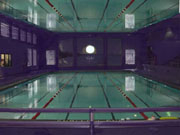
Dive into the Deep End
NIGHT SWIM is a cross between a sound and light installation, a music festival and a swimming pool party which will be held from sunset till sunrise at the Trinity Bellwoods Community Centre swimming pool in Toronto on Saturday September 30, 2006. Architect and artist Christie Pearson, co-organizer of the highly successful WADE festivals of performance art in Toronto’s public wading pools, has transformed this much loved downtown public swimming pool into a shimmering, reflective dream-space for one night only. Wire contributor Marcus Boon has invited sound artists, musicians and DJs to produce site specific works and sets in a sound environment designed by sound designer Darren Copeland, which will include underwater microphones and speakers. The event is free and open all night – visitors can swim (bring your bathing suit, towels provided!), lounge in the kiddies’ pool, or hang out in the bleachers and around the pool, soaking up the sound and light. 120 people in the pool at a time maximum – first come, first served!
Sounds: Montreal dirty beats by Ghislain Poirier and colossal drone-scapes by Tim Hecker; loops by Beijing-based creators of the Buddha Machine FM3; heavy ambient sounds by Boston-based Keith Fullerton Whitman a.k.a Hravatski; turntablist-composer Marina Rosenfeld and experimental tribal rhythmist Raz Mesinai from New York; from Toronto, electronic composer and improvisor Sarah Peebles, Sandro Perri/Polmo Polpo’s indie funk, sexy nocturnal grooves with Luis Jacob, baile funk, grime and dancehall from Geoff Snack, a.k.a. DJ Showcase Showdown, and ecstatic sustained tones by Orixasound.
Night Swim
Trinity Bellwoods Community Center swimming pool
Queen West at Crawford,
Toronto
7 p.m. to 7 a.m.
September 30th 2006
Posted by jo at 03:08 PM
| Comments (0)
The Art of Networks

Jonah Brucker-Cohen
Next week, Montreal's Oboro Gallery will open Deconstructing Networks, a solo exhibition by the very active American new media artist Jonah Brucker-Cohen. The works included in this show provide an excellent overview of Brucker-Cohen's insightful and witty approach to complex questions about networks, as we stare down the barrel of Web 3.0 and beyond. He vividly illustrates the possible physical applications of network structures and concepts, as with the Alerting Infrastructure project, where hits to a website are manifested in physical 'hits' to a building; in the Crank the Web project, a browser that requires elbow grease to run; and in IPO Madness, a slot machine that also acts as a domain name generator for the IPO of your dreams.
The traces and trails generated by data are explored in SpeakerPhone, an arrangement of speakers that spatialize the data it receives. Any internet user will find insights into issues of anonymity, autonomy, and security in projects such as PoliceState, a group of radio-controlled police cars that react when they detect suspicious keywords on a local network, and WiFiHog, a tool that allows a single user to dominate any wireless hotspot. Visitors can directly and spontaneously contribute to the SimpleTEXT audiovisual performance at 3PM on the 16th, so be sure to bring your mobile phone along, and don't forget a sense of play and an inquisitive state of mind, as the underlying intent of the exhibition is to interrogate our participation and implication in the networks that surround us. - Michelle Kasprzak, Rhizome News.
Posted by jo at 01:58 PM
| Comments (0)
September 07, 2006
CADE: Computers in Art and Design Education: Stillness
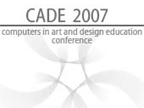
Call for Papers and Abstract Submissions
First Call for Papers and Abstract Submissions: abstract submission for refereed papers :: Deadline 12 January 2007 :: STILLNESS: 2007 Biennale of Electronic Arts Perth Education Program: International Conference: CADE: Computers in Art and Design Education :: 12 - 14 September 2007, Perth, Western Australia.
The Biennale of Electronic Arts Perth (BEAP) is Australia's pre-eminent festival dedicated to showcasing innovative works of art in the areas of new media, electronic screen, sound and interactive media and is the largest and most visionary electronic arts event in the region. Through a broad program of exhibitions, conferences and public talks, BEAP provides a focus for discussion and exploration of the emergent aesthetic, social and technological implications that surround the electronic arts, in all its possible forms, whether visual, audio, interactive, temporal, experiential, digital, 'bio' or 'nano'.
The Computers in Art and Design Education (CADE) conference is a major international event for those interested in the exploration of ideas at the intersection of pedagogy, arts, design, science, and technology. The 2007 conference will provide a focus for shared learning, dialogue and interaction that directly informs professional methodologies and practice.
In 2007 CADE partners with the Biennale for its first conference outside Europe, creating a new focus for exploring the latest research and practice within creative arts education at the point where the 'digital' is both a challenge and a strength.
Perth, the capital of the state of Western Australia, has a distinct creative community that celebrates the uniqueness of Western Australia's stunning bio-diverse environment and combines Indigenous, European and Southeast Asian cultures.
Internationally recognised for its commitment to research in bio and electronic arts in tertiary education, Perth welcomes delegates to explore and reflect on global perspectives from a pivotal point within the Asia-Pacific region.
Conference theme: we invite educators, theorists and creative arts practitioners to meet in Perth, Australia, to explore the paradox of "Stillness." The concept of "stillness" will become an anchor for events in the ceaseless flows of data and provide a reflective moment for new ideas to emerge and interact, explode or coalesce, blossom or fade. BEAP will be supporting and encouraging a community of artists to explore: * Stillness as Sound * Stillness as Bio * Stillness as Data * Stillness as Duration. CADE will challenge you to confront these conceptual issues.
Call for papers: We invite contributions for paper presentations, posters and panel discussions that address the conference theme of "stillness." Papers should provide theoretical understanding, analysis and documentation of creative arts and digital technologies and related contexts for educational development.
The term creative arts includes: new media, multimedia, web design, interactive arts, computer games and mixed media performance and traditional disciplines (such as fine arts, sculpture, photography, printmaking, fashion and textiles, graphic design, illustration, 3D design, product design interior design, architecture, drama, theatre, dance and music).
All submitted abstracts, poster submissions and papers will be double blind peer reviewed by an international panel. Submissions accepted and presented at the conference will be published in the conference proceedings.
500-word abstracts required by 12 January 2007. Full submission can be made through the conference website. Follow link to conferences for http://cedar.humanities.curtin.edu.au/conferences/cade/index.cfm
Join us in Perth - 12 - 14 September 2007.
Conference Convenors
Suzette Worden, Professor of Design,
Curtin University of Technology, s.worden[at]curtin.edu.au
Lelia Green, Professor of Communications,
Edith Cowan University, l.green[at]ecu.edu.au
Paul Thomas, Artistic Director,
Biennale of Electronic Arts Perth, paul.thomas[at]beap.org
Posted by jo at 09:08 AM
| Comments (0)
NuArt NuRadio NuTV

Public are Winners Again
Festival of NUART Stavanger, Norway 6th -10th September 2006 :: Nuart has started!! Artists scurry around town and test broadcasts have begun. For a week of festivities C6 are joined by Motherboard, Oslo's veterans of the live wire resistance party plan, The Graffiti Research Lab, electronic graffiti from New York City. R23, audio visual hackers from Barcelona, Tom Carden, space and flow dynamics from London, and for their 2nd farewell gig in twelve months those telepresence rockers Nood, as well as Toby Sparkz and the C6 disaster Unit providing visuals to acts from Numusic.
Contemporary public art practice has become an audienceless affair with application-based works directed purely at those that fund them. While artists and funding bodies are locked in dialogues of mutual gratification the public are the ultimate losers. The creation of alternative platforms for interaction and discussion must subvert these well established pathways and deliver their content to a wider general public.
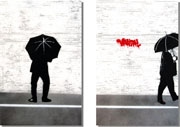
This year's festival uses a range of alternative media outside of conventional art practice to deliver content in ways that are easily accessible and relevant to our audiences, both actual and virtual. Live events will merge in this cross media remix. Using the town and the numusic festival as its palette, this year's nuart festival feeds its street, visual and nu media events into a multi-layered broadcast. Internet radio will merge nuartist presentations and workshops with numusic concerts and interviews. nuTV streams live acts from the numusic stages online and to your mobile phone, while text messages from the public create narratives in nuart VJ sets.
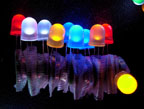
Calls for walls in Stavanger has born fruit with 9 locations in and around the town being painted by some of the worlds great street artists. Open to the public, these street works will be filmed, cut and fed back onto the numusic stages as visual backdrop for numusic acts.
Using alternative media broadcasting techniques, subversive content is made available to those usually sidelined by a lexicon of fine art nonsense.
Official broadcast programme starts on Thursday 21:00 local time 19:00 GMT+2 with the graffiti crews armed and ready and live audio and video stream broadcasts from the numusic stages. The days nuart events will be remixed and vj'd to accompany the music.

NuRadio can be heard here:
http://stream.r23.cc:2323/c6.ogg.m3u
NuTV can be watched here:
http://stream.r23.cc/live/numusic/stage1/
http://stream.r23.cc/live/numusic/stage2/
http://stream.r23.cc/live/numusic/stage3/
Posted by jo at 08:59 AM
| Comments (0)
Preemptive Media's AIR

Launching September 14
"Allowing you to explore your neighborhood and urban environment for pollution and fossil fuel burning hotspots." :: The AIR project will launch on September 14, 2006 in Lower Manhattan at the AIR headquarters located in 125 Maiden Lane (map). Release party from 5-7pm!! The headquarters will be open daily from 12-7 pm from 9/15-21.
AIR is a public, social experiment in which people are invited to use Preemptive Media's portable air monitoring devices to explore their neighborhoods and urban environments for pollution and fossil fuel burning hotspots. Participants or "carriers" are able to see pollutant levels in their current locations, as well as simultaneously view measurements from the other AIR devices in the network. An on-board GPS unit and digital compass, combined with a database of known pollution sources such as power plants and heavy industries, allow carriers to see their distance from polluters and other AIR devices. In addition, the devices regularly transmit data to a central database allowing for real time data visualization on this website.
While AIR is designed to be a tool for individuals and groups to self identify pollution sources, it also serves as a platform to discuss energy politics and their impact on environment, health and social groups in specific regions.
Posted by jo at 08:05 AM
| Comments (0)
September 06, 2006
Tank-FX

Add Sound, Mix 'n Play
The annoying thing about ars electronica is that even if you spend 5 days there, you'll always discover that you've missed several projects once you're in the plane on your way back. In the case of Tank-FX, honorary mention in the net vision category, it's ok cuz the work is online.
The project processes a sound file submitted by the user through an unused tank of 11 x 7 of reinforced concrete built in 1032 at the central station in Obenhauser (Germany.) By installing a linux server, some audio software, microphones and speakers right inside the tank, Tank-FX allows you to upload up to 60 seconds of audio material. It is played immediately in the water tank. The surface of the tank causes a particular reverberation which is picked up by the stereo mics. The reverberated version is recorded and mixed with the original one at a radio set that you can set in advance. The outcome is then converted in the desired output format for you to download and use.
The website is in german but there's an how to in english at FieldMuzik. There's some samples here. A work by German artists Sandro Catallo and Markus Cremers. [blogged by Regine on we-make-money-not-art]
Posted by jo at 07:34 PM
| Comments (0)
Icelandic Rift, 2006 by Sabrina Raaf
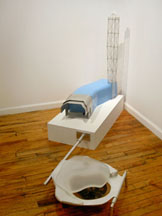
Agriculture in a Zero-G Environment
I was in part inspired to create this work by the landscapes that I explored in Iceland. There, I saw breathtakingly monumental glaciers which seemed to float atop fields smooth black lava rock. In other parts of the country, there were endless stains of acid green sulfur on the earth as well as steaming blue pools of heat-loving algae which defied one’s sense of “the natural”. The landscape in Iceland is famous for its lunar feel but its elements seemed to trump gravity and logic in ways that were utterly unexpected. I am also drawing inspiration for this work from the multi-tiered design of staged, hillside agricultural systems such as those seen in Asian rice terraces. Last, I am drawing inspiration from the soft design forms found in domed space observatories, water droplets, and BioSpheres.
Icelandic Rift is a series of structures assembled from industrial materials, stark yet organic forms, and automated systems. These sculptures come together in each work to form a modular system of organic architecture which plays on the viewer's senses of scale and gravity. The Icelandic Rift sculptures are electronically powered works that include mechanical systems which function to automate lights and fluids within the sculpture body. Materials in the series include aluminum, cast acrylic, eurothene, ferrofluid, and custom kinetics and electronics.
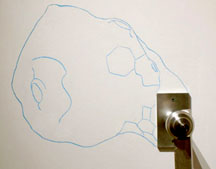
In all, the structures in the Icelandic Rift series represent a future vision of agriculture and growth in a zero-g environment. It is a composition of artificial islands supported and connected by steel and aluminum struts so that they can be assembled as part of a greater mechanical system that hovers above the floor. Together the architecture formed by these structures is designed to be perceived as both vaguely familiar and also austerely alien.
On the larger aluminum islands in the series sit smaller island forms cut from cast acrylic and/or aluminum. The island centers are hollowed out to function as reservoirs to hold Ferrofluid – a type of liquid magnet. This is a dense black liquid which spikes up when an earth magnet is placed in its proximity. Under some of these islands I have automated hard magnets and electromagnets that, in turn, automate the standing ferrofluid liquid in the reservoirs so that the liquid is made to spin, rise, twitch, or travel. These symbolize the energy sources for the systems. [Related posts 1, 2, 3]
Posted by jo at 06:42 PM
| Comments (0)
Amazon Noir

The Big Book Crime
After Google Will Eat Itself ... ubermorgen.com, Paolo Cirio and Alessandro Ludovico are working on a new "subversive happening." They plan to use the 10,000 euro stipend that Hans Bernhard received from Edith Russ Site for media art in Oldenburg (DE) to undermine the online copyright of Amazon and allow users to obtain books from Amazon for free.
Amazon Noir – The Big Book Crime, which for its action will take its cue from the "film noir" school of cinematography, intends to [point out] "the hypocrisy of the digital copyright lobby." The software bot the artists mean to deploy will be ready by this autumn. The bot will outwit Amazon's "search inside the book" system, making up to 5.000 inquiries per book and assembling the individual parts afterwards to compile entire books. This would allow "users to 'legally' copy and redistribute copyright books from amazon.com."
The piece is a performative media-installation and thus continues the historical tradition of happenings and performance art. Provoking reactions from conventional media and business is an integral part of the project.
"We will protect our rights. No information on the matter will be made public," an Amazon spokeswoman said to German news agency dpa.
Via heise, spiegel. Related: Forum IV - Net Vision: [v]ote-auction by ubermorgen.com. [blogged by Regine on we-make-money-not-art]
Posted by jo at 05:28 PM
| Comments (0)
Upgrade! New York

Catherine D’Ignazio a.k.a. kanarinka
Upgrade! New York: September 14, 7:30 pm :: The Change You Want to See Gallery and Convergence Stage :: 84 Havemeyer Street, Store Front @ Metropolitan Ave, Brooklyn, NYC
Are locative media and psychogeography projects just entertainment for white, middle-class, gadget-oriented consumers? Mapping impulses, locative media projects and psychogeographic investigations of place and community have proliferated over the past decade. There is a rich, interdisciplinary field of practice and new strategies, tactics and tools are being invented all the time. However, there is also the need for critical evaluation and discussion of the relevance and impact of these cultural projects. Factors of race and class are often overlooked. Connections to the material (often military and corporate) circumstances of the development of technologies deployed in these projects are often swept aside. Through the increasing corporatization and militarization of participation and play (Web 2.0, Joint Red Flag military war game), it is clear that more participation and play does not mean more democracy and freedom. On the contrary, participation and play are also deployed as mechanisms of social control.
Catherine D’Ignazio a.k.a. kanarinka will discuss several collaborative projects from her practice, show other examples of contemporary psychogeographic investigations and then open the forum for others to do the same. The goal of the talk is to discuss three questions:
1) Is locative media/psychogeography work just entertainment for white, middle-class, gadget-oriented consumers? (Hopefully the answer is no, but we’ll see.)
2) What is at stake in the corporatization and militarization of “play” and “participation”?
3) What kind of agency do these projects have? i.e. What do they really do?
TO BRING (optional): Failures & successes. Bring a psychogeography/locative media project to share with us, including your commentary about what kind of agency it produces, how it addresses its audience, and so on. Both failures and successes - and the numerous projects that have both - are useful.
LATER: We will proceed to the opening for the Conflux Festival at Supreme Trading Post to continue the conversation.
Posted by jo at 01:44 PM
| Comments (0)
artciencia.com

Call for Submissions
artciencia.com, Number 5, October-January 2006 :: Deadline: October 28, 2006 :: For the next issue planned for November 2006, the editors of the artciencia.com invite essays and artworks with new approaches to the long-discussed topics of art and history, aesthetics, bio-science and technology in music, literature, cinema, video art, photography, architecture, new media, painting, and other arts.
We are especially interested in essays and artworks that address the convergences of the science and technology studies with art studies, or reconsider the encounters of arts with specific historical events (new discoveries of science, technology development, political and social mutations, and wars). Other possible essays might work with questions of aesthetics or genre, memory and memorializing, the impacts of critical art studies and science studies on practices of art today, as well as the role of the theories or the public in interpreting arts.
You may submit your work accompanied by a short bio note and an abstract (50-100 words) to: artscience.editor[at]gmail.com. Submissions will also be accepted via e-mail to artciencia.com[at]sapo.pt or artscience_editor[at]sapo.pt.
Please include the subject and send thh texts in Microsoft Word format. More information about submission see Guide for Authors. Direct questions to: Irene Aparicio, Editor
aparicio.irene[at]gmail.com or artscience_com[at]yahoo.com.
Published quarterly since August 2005, artciencia.com intends to publish authors’ articles or artworks on art-science-communication. Recent issue include essays on Picasso, Oscar Wilde, Chin Ce, Henry Fielding, history and literature, Greek theater, art and body, word and painting, encaustic art, tele-performance, installation and art-technology, gender differences and perception of art; artworks on fractal images and symmetries, artificial intelligence and new media art and design, textile art with encaustic application.
Posted by jo at 10:02 AM
| Comments (0)
See You in Walhalla
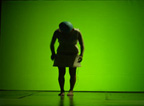
World Premiere of Live Computer Game
[Posted by Yukihiko YOSHIDA] World Premiere of new Live Computer Game "See You in Walhalla" :: September 14, 2006 :: IME Industrial Performing Arts Complex - Athens (Greece) and two other European cities (Sofia and Amsterdam) connected live through the Internet.
The Athens based performance group amorphy.org, with support of the Cultural Center of Kifissia and the EU Culture 2000 Funding Scheme, is proud to present the world premiere of "See you in Walhalla," a distributed live performance game connecting three cities – Amsterdam, Athens and Sofia. This multi-media dance/theatre project, collaboratively created by artists and designers from four different European partner sites in Greece, The Netherlands, Germany and Bulgaria, presents the unusual journey of a video game “avatar” through a haunted urban industrial landscape composed of digital fragments from the spectacle of Europe.
The audience in Athens is invited to witness the exciting premiere of the first live 3D computer game enacted by three dis/located performers simultaneously, with Ermira Goro playing the “avatar” on location in Athens, while Nancy Mauro-Flude and Ivaylo Dimitrov are streamed via web-cams into the game but are located in Amsterdam and Sofia respectively, and watched by local audiences in those cities. At the same time, “See you in Walhalla” can be witnessed live on the Internet, where online players can log on to offer their comments and reactions to the performance/game. The Athens premiere represents the first leg of a European tour scheduled for 2006-2007 seasons.
Description of the new work:
An average man. Slightly obsessive, familiarly lonely. He eats his green apples, rendered phosphorescent in the glow of his computer screen. A new video game, See You in Walhalla – “in this place everyone who is not in jail works for the police.” He creates his avatar. The game’s purpose - to guide this avatar, born as an “empty” shell, through various journeys taking place in an imaginary city-scape morphed out of Amsterdam, Athens and Sofia, with the final goal of rendering the avatar into a more “human being”, capable of surviving the density, danger and psychosis of urban existence, at a time when Europe is undergoing its own nightmares of economic and political integration. Paradoxically, integration in this haunted and visually disturbing game is experienced as a series of physical and psychic dis-sociations. The Player gets more involved with the game, losing a sense of reality and becoming more socially autistic, while his avatar slowly recovers a sensibility for human inter-action which is punished by the pressures and regulations, as well as the hyper-euphoric spectacular image-scapes, of which the urban rhythms of existence are determined.
I am Amalia, if you hurry me I will say I am Molly, I am her, locked up in the big house, desperate, pursued by Rosas’s mazorca, I am Irish, I will say then, I am her and I am also the others, I was the others, I am Hipolita, the gimp, the little cripple, I tottered slightly when I walked, Hipolita, I say to him, and he smiles, Hipolita, with “the gloves on her small hands”, she ran away with the psychopath, the big castrated psychopath who could tell the future on Tarot cards, he had a scar on his groin from here to here.
Three performers inter-connected, a complex web of fantastical events seen from pre-recorded film, live-web cam and audio streams from Amsterdam and Sofia, interactively controlled sound and video based determined by movements of the performer in Athens, and unpredictable site-specific performances in Sofia and Amsterdam – these components compose the 3D live game environment which promises Player and Avatar a life after death (Walhalla).
The protagonist of this game is not an ego-shooter, but a flâneur, a cyber wo-man who discovers herself as an anonymous face in the multitude, but who is free to probe her surroundings for clues and hints that may go unnoticed by the others. The Avatar-wanderer does not abandon herself/himself in the crowd, but actively participates, observes, revolts, and intervenes in her surroundings, and just as she experience her “unbearable lightness of being”, she is nearly killed in an accident.
This theatrical computer game explores the “system” of deadly possibilities that lurk in the entropic cities of late capitalism, amongst the facades of glamour, heroic icons and consumer fetishes which, like a dream, do not exist in reality or can fall apart in a moment, setting fire to the outskirts of our imagination or flooding our delusional consciousness.
* * *
Initial Concept by: Tzeni Argyriou, Ioanna Tsinividi, and Ash Bulayev
Tzeni Argyriou (Concept and Direction); Zoe Chatziantoniou, Ioanna Tsinividi, and Ash Bulayev (Creative Team); Tzeni Argyriou, Zoe Chatziantoniou, Ermira Goro, and Ash Bulayev (Choreography); Ioanna Tsinividi (Video Direction/Editing); Zoe Chatziantoniou and Ash Bulayev (Dramaturgy/Text Composition); Stavros Gasparatos (Music Composition); Arjen Keesmaat and Stoycho Stanchev (System Design/Programming); Paul Verity Smith (Sensor Development); Kostantinos Kipriotakis (Stage Design); Sakis Birbillis (Lighting Design); Despina Makarouni (Costume Design); Nikos Makris (3D Animation); Christopher Brellis (Designer); Lena Kitsopoulou and Ash Bulayev (Voiceovers)
Web interaction design and logistics by: Sher Doruff (Waag/Holland), Johannes Birringer (InteraktionsLabor/Germany), and Galia Dimitrova (InterSpace/Bulgaria)
Performed by: Ermira Goro (Athens), Nancy Mauro-Flude (Amsterdam), and Ivaylo Dimitrov (Sofia)
Production Crew:
Maria Kerasioti (Lead Project Facilitator/ C.C. of Kifissia), Maria Ladaki (Project Coordinator/C.C. of Kifissia), Eleni Katsarou (Project Coordinator & Production Manager/amorphy.org), Galia Dimitrova (Project Coordinator/InterSpace), Johannes Birringer (Project Coordinator/InteraktionsLabor), Floor Van Spaendonck (Project Coordinator/de Waag), Dyonisis Petrouchopoulos (Director of Photography), Katerina Stasinopoulou (Co-Video Editor), Christopher Brellis/antidot (Web-Design/Poster Design), Guy Stefanou (Technical Director)
Logistics:
Date: September 14th, 2006
Time: 21:00 (Athens/Sofia) & 20:00 (Amsterdam)
Locations:
Athens/Greece (IME Industrial Complex, Building 5)
Amsterdam/Netherlands
(Waag Society, Nieuwmarkt Square)
Sofia, Bulgaria
(Red House for Culture & Debate,
15 Ljuben Karavelov Street)
Info: www.amorphy.org/imap
* For press photographs or any other information regarding the show or project, please contact: info[at]amorphy.org
Development History
With funding support of the European Culture 2000 Framework Program, the project development of “See you in Walhalla” began in September 2005, and after extensive filming on location and digital choreography and computer programming workshops in the various partner sites , the new work will be shown as a live networked performance on September 14th, 2006 in Amsterdam, Athens, and Sofia. The collaborative project, implemented through a trans-European network of four participating media art organizations, is dedicated to fostering new and innovative works of art through effective integration of interactive technologies and live performance practices.
Collaborative Network of Co-Organizers
· amorphy.org (Athens, Greece) - www.amorphy.org
amorphy.org is a non-for-profit organization devoted to production of original works of live performance and installation, through constant pursuit of practical investigation fusing media art technologies and live performance practices.
· InteraktionsLabor (Göttelborn, Germany) – www.interaktionslabor.de
InteraktionsLabor, under the direction of Johannes Birringer, is an organization which focuses on research in communications technologies, interactive media, performance and virtual environments.
· InterSpace (Sofia, Bulgaria) – www.i-space.org
InterSpace is a New Media Art Center that works for the establishment of a social attitude to new media art forms, through the development of alternative means and possibilities of artistic expression in new media technologies.
· De Waag (Amsterdam, Holland) – www.waag.org
Waag Society for Old and New Media is a knowledge institute operating on the cutting edge of culture and technology in relation to society, education, government and industry, established in 1994.
· Cultural Center of Kifissia (Athens, Greece) - www.kifissia.gr
C.C. of Kifissia various courses for painting, Greek traditional dancing, theatre, jewelry , photography, batik, mosaic and so on. The municipal cultural centre highly supports and promotes cultural creativity.
Associated Partners
PACT Zollverein - Essen, Goethe Institute, Red House For Culture and Debate, IKS, IME Research Facility, Ipsilon Production Company, Brunel University, i-DAT/University of Plymouth.
ash bulayev/amorphy.org
artistic director
Address:
Alopis 58, Kato Petralona
11853 Athens Greece
email: ash[at]amorphy.org
web: www.amorphy.org
mobile: + 30 6937 20 33 00
work: + 30 210 34 56 341
Posted by jo at 08:18 AM
| Comments (0)
IMPLANT

Transmittable Architecture
International premiere of IMPLANT :: A networked virtual world and installation created by Thomas Soetens and Kora Van den Bulcke, Workspace Unlimited :: IMPLANT will take place at the Vooruit Kunstencentrum in Ghent, Belgium, inside the Domzaal and outside on the gallery street window. Simultaneously IMPLANT will be networked with the project EXTENSION a virtual world installation at the Society for Art & Technology in Montreal and DEVMAP a virtual world installation at V2_Institute for the Unstable Media in Rotterdam. The opening event will be live streamed from the Vooruit and can be followed at the SAT and V2_Institute in the networked virtual world installations!
About the work: Text by Wayne Ashley, Independant Curator, New York :: Workspace Unlimited's new work IMPLANT is both an electronically networked interactive virtual world and an installation physically situated in the magnificent Art Nouveau building of Vooruit, a performance venue in the center of Ghent. Founding members artist Thomas Soetens and architect Kora Van den Bulcke create a digital 3D version of the entire building and its surrounding environs which users can access and navigate on computers from inside Vooruit and simultaneously from the Society for Art and Technology in Montreal, and V2_ Institute for the Unstable Media in Rotterdam. In this way Soetens and Van den Bulcke exercise their most compelling gesture: re-imagining Vooruit as transmittable architecture, an ongoing and revisable place that does not adhere to our ordinary understanding of physics, nor to the continuities of space and time.
Once logged into IMPLANT, visitors navigate through two co-existing architectures: a sumptuous simulation of the real Vooruit, a large complex maze of theater spaces, cafes, meeting rooms, and offices which can be traversed in much the same way we move through physical space--walking upstairs, through doors, down corridors, around corners, inside and out. And a hidden hyperlinked architecture that emerges as users interact with the simulation's various walls and ceilings. This secondary architecture is a malleable, almost liquid space that is contingent and constantly in flux-portals that transport us immediately to continuously shifting destinations within Vooruit according to the position of the visitor; virtual cameras that allow us to secretly follow other visitors and project their journeys and activities onto walls in front of us; the ability to walk through the projection and find ourselves together with them in the same space.
Outside on the real street, passersby will peer into Vooruit's glass lobby only to see a projected simulation of the same lobby seamlessly integrated within Vooruit's facade. Instead of seeing the usual theatergoers purchasing tickets and socializing with friends, viewers will observe the goings-on of avatars, graphical representations of actual people in Vooruit co-mingling and exploring the same simulated space with their counterparts from Montreal and Rotterdam. A web cam outside Vooruit captures the scene on the street, projecting the performances of everyday life back into the virtual world for those inside Vooruit, V2_ and SAT to witness. The effect is dizzying as the borders between inside and outside the virtual world become unclear, and who is performing for whom confused.
The longer visitors explore IMPLANT, the more layers they encounter. Embedded throughout the virtual world and triggered at various moments users encounter video and sound documentation from a recent online symposium called Breaking the Game. The symposium brought together an international group of competing theorists and practitioners to build, debate and reflect on virtual worlds, computer gaming, immersive technologies, and new possibilities for artistic practice and experience.
Workspace Unlimited is interested in breaking down oppositions between practice and theory, interior and exterior, imagination and perception, seeing and being. Soetens and Van den Bulcke seek to explore creative ways of making virtual worlds that are simultaneously intellectual, poetic, and hallucinatory.
Events:
V2_Institute, Eendrachtsstraat 12, Rotterdam, the Netherlands :: Sept. 15 at 17:00 V2_ Ground floor: Lecture by Thomas Soetens and Kora Van den Bulcke streamed in the virtual world installation.
Society for Art & Technology, 1195 Saint-Laurent, Montreal, Canada ::
Sept. 15 at 11:00 am (local time Montreal) Ground floor: Lecture by Thomas Soetens and Kora Van den Bulcke streamed the virtual world installation. :: Sept. 15 - 16 - 17 Ground floor: Exhibition of the interactive virtual world installation.
Workspace Unlimited website: www.workspace-unlimited.org
IMPLANT credits: Artistic direction and creation: Thomas Soetens and Kora Van den Bulcke; OpenGL programming: Patrick Bergeron; Quake 3 programming: Matt McChesney; Modeling and character design: Jason Dovey; Network setup: Simon Piette, Brecht Vermeulen (IBBT), Thomas Bouve; Modeling and character design: Jason Dovey; Communications: Stoffel Debuysere; Copywriting: Wayne Ashley, independant Curator.
Posted by jo at 08:05 AM
| Comments (0)
Silent Sound

Exploration of the Mind's Receptiveness to Suggestion
Silent Sound in Liverpool, U.K. :: PERFORMANCE: THURSDAY 14TH SEPTEMBER :: EXHIBITION: 15TH SEPTEMBER - 26TH NOVEMBER :: Artists Iain Forsyth & Jane Pollard invite you to a uniquely immersive experience which explores the mind's susceptibility to subliminal suggestion.
In 1865 Victorian performers The Davenport Brothers presented a public séance from inside their spirit cabinet on the stage of the Small Concert Hall in St. George's Hall, Liverpool. Unused for over twenty years the Hall will reopen for Silent Sound where the artists will perform on the same stage used by The Davenports. The evening will be introduced by Doctor of Parapsychology Ciarn O'Keeffe and will debut a specially commissioned original score written and performed by Jason Pierce of the band Spiritualized.
The performance takes place during the Liverpool Biennial on Thursday 14th September 2006. For more information regarding obtaining tickets for the performance please email: tickets[at]silentsound.info.
From Friday 15th September Silent Sound will feature in the inaugural programme at Greenland Street, A Foundation's major new contemporary art space - three former industrial buildings in the heart of Liverpool's Baltic Triangle which have been transformed into one of the largest and most challenging exhibition spaces for contemporary art in the country.
An ambisonic audio recording of the live performance created in collaboration with Arup Acoustics will be incorporated into a large-scale immersive installation specifically created by the artists to continue the event's exploration of the mind's potential receptiveness to suggestion. The recording will be reproduced in the installation to three-dimensionally reproduce the sound as it was actually heard in St. George's Hall.
A limited edition signed and numbered Compact Disc recording will be available from Monday 18th September, with a DVD documentary to follow in 2007. All graphic design for the project has been executed by Chris Bigg and Vaughan Oliver at v23.
More information: http://www.silentsound.info
Posted by jo at 07:56 AM
| Comments (0)
September 05, 2006
Activeworlds:
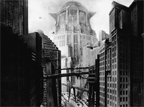
Geography and Social interaction in Virtual Reality
"Abstract: This paper examines the interrelation between the geographical and social aspects of virtual worlds. We examine the main geographical features of Activeworlds, a multi-user virtual environment available over the Internet. Activeworlds is not only one of the most popular virtual environments, it is also the only publicly accessible one in which users can build themselves, and thus shape their geographical and social environment. We examine, among other features, transportation, mobility, and property appropriation in this virtual worlds system. Further, we describe some of the influences, both from urban planning and science fiction, on the geography of Activeworlds. We also examine the social relations that arise from these geographical conditions, including the ‘rough and ready’ mentality of this ‘cyberspace frontier’. Finally, we consider the implications of this virtual worlds system for theories of the emerging geographical and social relations in virtual environments." From Activeworlds: Geography and Social Interaction in Virtual Reality by Ralph Schroeder, Avon Huxor, and Andy Smith.
"1.0 Introduction: The idea behind ‘30 Days in ActiveWorlds’ was to fully document the development of a virtual environment from beginning to end, as a plot of virgin virtual land which, it was hoped, would develop into a community and a fully-fledged new virtual world. The aim was not to create a dialogue of life in the virtual environment, such as the well-documented “My Tiny Life” by Julian Dibbell [1] or “The Cybergypsies” by Indra Sinha [2], yet the events that unfolded over the 30 Day period led to just such a documentation, and with it my conclusions about not only community and design in a virtual environment, but also views on the increasingly blurred boundaries between what is real and what is virtual." From 30 Days in ActiveWorlds – Community, Design and Terrorism in a Virtual World by Dr Andrew Hudson-Smith; Social Life of Avatars, Chapter 8, Ralph Shroder (Editor), Springer-Verlag UK. [via Digitally Distributed Environments]
Posted by jo at 08:59 AM
| Comments (0)
Spur McGuffin: 069recorded
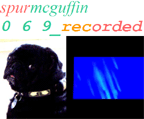
Call for Submissions
069recorded welcomes submissions for its inaugural issue on the theme of Disruptive 069recording series. We seek examples of new thinking and practice that overturn and/or reassess existing performance technology praxis. Submissions may be presented as papers, reviews, audio, visuals (stills / video) and code. Authors may use multiple formats in a single submission. mailto: spur[at] various-euro.com
SPUR MCGUFFIN is http://069recorded.de/ Consisting of major internet-based sound installations and a program of commissioned works for distinct sound stations in the web, Spur McGuffin explores the real and imagined remnants of human presence in autopoiesis. Spur McGuffin was one of the first artist-groups worldwide to use the possibilities of interactive media and especially of the internet in their work. Performances and lectures in art galleries, universities and museums are equally important as performances at media festivals and in the clubscene.
069recorded is a communication laboratory that works on political language. To do so 069recorded have use, also the hacking way, destructuring words and languages, mixing and matching situations and concept and practices; for reinventing the political language and for being more incisive on a vast level of communication. 069recorded was the first recorder managed by women in Germany (in an independent social center in Frankfurt), but it is also a hyper-place scattered with links, a circuit with which to inract that brings to other circuits. A place where sexuality is central cause, it is the zero degree of connection's desire. In the gender, beyond the gender. The 069recorded women use a collective name: "069recorded". Expressing the desire to shut down with the need of auto -- agency.
Posted by jo at 08:53 AM
| Comments (0)
THE PARTICIPATORY CHALLENGE

hands-on guidelines
"This essay is about participation in online collaborations and the potentials of extreme sharing networks in the unregulated commons. Current debates focus too much on what social tools can do and not enough on the people who use them. Motivations of the multitudes who add content to online environments matter a great deal. What follows here are hands-on guidelines and an outline of preconditions for online participation. Terms like: involvement, turn taking, network, feedback, or distributed creativity (1) are frequently applied to characterise this kind of social and cultural interaction. Today, people do not merely browse the web. Instead they give away information, expertise, and advice without monetary compensation. They submit texts, code, music, images, and video files in settings that allow for such contributions. They also re-mix each other’s content. Thousands voluntarily participate in open encyclopedias, social bookmarking sites, friend-of-a-friend networks, media art projects and blogs or wikis. This exemplifies the growing interest in technologies of cooperation. Swarms of users/producers form extreme sharing networks, supporting their goal to lead fullfilled and engaged lives.
This broad cultural context of increased content provision facilitated by the World Wide Web is the precondition for the emerging paradigm of the artist as cultural context provider, who is not chiefly concerned with contributing content to her own projects. Instead, she establishes configurations into which she invites others. She blurs the lines between the artist, theorist, and curator. However, it is surprising how little emphasis has been placed on the subtle motivations for taking part in participatory projects." From THE PARTICIPATORY CHALLENGE by Trebor Scholz [from: Krysa, J., ed. (2006) DATA Browser 03. Curating immateriality. The work of the curator in the age of network systems. Autonomedia: New York.] Trebor Scholz 2006 Attribution-ShareAlike 2.5.
Posted by jo at 08:46 AM
| Comments (0)
Rafael Lozano-Hemmer's

Platforms for Group Experiences
Rafael Lozano-Hemmer :: bitforms, 529 West 20th Street, 2nd Floor, Chelsea, NY :: 212-366-6939 :: September 15 - October 21, 2006 :: Opening: Friday, September 15, 6:00PM - 8:00PM.
(Rafael) Lozano-Hemmer's work taps into the technology of data-networks, robotics, sensors, cell phones, projections and other custom-made devices to create "connective, participatory experiences," in which several realities co-exist. Playful, yet always provocative, his installations have been praised for creating platforms for group experience rather than individual interfaces for solitary participation.
Shown for the first time, Close up and Third Person are part of the Shadow Box series that builds up on Lozano-Hemmer's concepts developed in Under Scan, and in which passers-by activate portraits in their own shadows. Each of the pieces features a high resolution, 30-inch diagonal, interactive display, made of steel and black anodized aluminum and including a built-in computerized tracking system. Close up creates the viewer's image with hundreds of tiny videos of other people who have recently looked at the work. When a viewer approaches, the system automatically makes a video. Up to 800 recent recordings are simultaneously triggered inside the viewer's silhouette, suggesting a schizoid experience where people's image sets off a massive array of surveillance videos.
In Third Person, the interactive display draws the viewer's portrait in real time with hundreds of tiny words, which are all the English and Spanish verbs conjugated in the third person. In addition to these two pieces, the exhibition will include a video of Lozano-Hemmer's critically acclaimed, large-scale public art installation, Under Scan, along with Under Scan Portraits (Lambda print), and a book of signature of the 800 people who participated in this project.
ARTIST'S TALK: Tuesday, September 12, 7pm (reservations: 212-366-6959)
Image from Bitforms Gallery. [Originally from ArtCal] [Related posts 1, 2, 3, 4, 5, 6]
Posted by jo at 08:40 AM
| Comments (0)
[iDC]

Reading List and Situated Bibliography
Here's my current reading list (won't necessarily get to all of it). Basic or even retro cybernetics, with a few prolongations:
--Norbert Wiener: Cybernetics + The Human Use of Human Beings
--Shannon and Weaver: Mathematical Theory of Communication
--Ross Ashby: Introduction to Cybernetics
--Steve Joshua Heims: The Cybernetics Group + John von Neumann and Norbert Weiner (the double biography)
--Ludwig Von Bertalanffy: General System Theory
--J.W. Forrester: Industrial Dynamics + Urban Dynamics
--Paul Edwards: The Closed World
--Gregory Bateson: Steps to an Ecology of Mind
--Heinz von Foerster: Understanding Understanding
--H. Maturana & F. Varela: Tree of Knowledge
--Felix Guattari: Chaosmosis + Cartographies Schizoanalytiques --N. Katherine Hayles: How We Became Posthuman --Tiziana Terranova: Network Culture
Three questions:
1. What happens when I make a plane reservation, then go through security?
2. How did cybernetics become THE applied social science of the postwar period?
3. Were the most interesting 60s-70s cultural experiments a series of second-order revolts against cybernetic systems? If so, what were the consequences on those systems?
All this, to write a text on Guattari's notion of overcoding. But also, to develop a more general theory of collective art practice at grips with the control society.
best, Brian (holmes) [posted on iDC]
________
Brian,
I too have been working with many of the texts you cite. Do you know the following which I found to be incredibly informative especially regards to your question 2: Dupuy, Jean-Pierre. The Mechanization of the Mind: On the Origins of Cognitive Science, Princeton University Press.
Omar Khan
_______________
Hello Omar,
No I don't that book, thanks for the tip. I'm actually an ignoramus in this area, just got very curious as my attention came to focus on that peculiar post-WWII atmosphere that Bush, Cheney and their administration seem to hark back to with such horrid insistence. I will check it out, sounds good. Basically I think there have been 2 main phases, a "closed world" electrical engineering based period where the primary issue is identifying, tracking and targetting (that's the history I am trying to catch up on) and from the 70s onward a second phase, somewhat more familiar, corresponding to "second-order cybernetics" and complexity theory, which became the operative ideology of the globalization decades (80s and 90s, Nigel Thrift makes the operative side of it very clear in is book Knowing Capitalism). Really interesting people like Bateson and Guattari are at the hinge between these two periods, it seems. But such figures contributed to the worst of globalization (eg Mandelbrot with his work on finance) and at the same time, they helped us forget that the logistics (ex: air travel) that runs the whole show is still from the first military-dominated period. So the present really does look like a return of the repressed! The figure that interests me most in the first period is Jay Wright Forrester, inventor of the Whirlwind computer and developer of the SAGE radar-defence perimeter in the 50s, who after his military years became a kind of prophet of cyberneticized industrial management. I am waiting to get his Urban Dynamics, where he applies his cybernetic management principles to cities, and discovers, among other things, that welfare is a bad policy and ought to be scrapped....
best, Brian (Holmes)
________________
Hi all
Perplexed to find myself on this list in the first place, but have been delighted by its range and quality of debate. Was thrilled by Brian Holmes invocation of Schiller and the 'play drive' - researched that for my Play Ethic book (www.theplayethic.typepad.com). I'd like to respond to the play-mobility-triviality debate soon.
But reading list is a nice idea:
Claire Colebrook - Deleuze: A guide for the Perplexed
Wendy Wheeler - the Whole Creature: Complexity, Biosemiotics and the Evolution of Culture Geoff Mulgan - Good and Bad Power Yochai Benkler - The Wealth of Networks James Carse - Finite and Infinite Games Paulo Virno - A Grammar for the Multitude Brian Sutton-Smith - The Ambiguity of Play Edward Castronova - Synthetic Worlds Ivan Illich - Tools for Conviviality
Amassed in order that I can try to explore the notion of a 'ground of play'
- ie, is there any other institutional (perhaps constitutional) arrangement, apart from Lessig's 'innovation commons', that could support a society of player-citizens. Felix Stalder's book on Manuel Castells is on order, and awaited eagerly.
Play well, psychonauts
PK (Pat Kane)
_________________
Thinking to Saul, Charles S. Pierce, notoriously the writings concerning the sign (but Mathematics)... [I do not know the US editions], contemporary of Saussure, is a major source of the actual researches on semiotic machines. But I'm sure that as American researchers you could not ignore his existence.
Paolo Fabbri, Fedrico Montanari
Per una semiotica della comunicazione strategica http://www.associazionesemiotica.it/ec/pdf/fabbri_montanari_30_07_04.pdf
Bruno Latour, Peter Weibel
Making Things Public - Atmospheres of Democracy
2005 MIT Press and ZKM Karlsruhe (Germany)
Both members of the French Academy, Jean-Pierre Dupuy et Michel Serres who teach at Stanford University, the USA, have large fields of knowledge, but mostly well-known for their philosophy of Sciences; it happens that both were strongly inspired and supported by René Girard, thinker of "the mimetic desire" and of the christianization of Sciences who himself has taught at Stanford university, ( himself French academician ): http://en.wikipedia.org/wiki/Ren%C3%A9_Girard. But I do not see which book could be quote in this current review.
C.
A.
__________________________
Situated Bibiliography
For my students I started a bibliography of new media: it is grouped by topical orientation and books appear alongside related art projects.
A short list of readings:
Wenger, E., McDermott, R., Snyder, W. (2002) Cultivating Communities of Practice. Boston: Harvard Business School Press.
Ellul, J. (1964) The Technological Society. New York: Vintage Books. Ellul's deterministic classic warns of the social implications of technology, in fact arguing that technology's internal logic and efficiency may not meet real human needs.
Willinsky, J. (2006) The Access Principle. The Case for Open Access to Research and Scholarship. Cambridge: MIT Press. Willinsky makes the case for open access, arguing that the fruits of scholarship should be shared with a widest possible audience.
Standage, T. (1998) The Victorian Internet. The Remarkable Story of the Telegraph and the Nineteenth Century's Online Pioneers. New York: Berkley Books. Going beyond the Internet hype, this book examines the way in which people have communicated across distances for centuries.
Keeble, L., Loader, B. eds. (2001) Community Informatics. Shaping Computer-Mediated Social Relations. London: Routledge. This book addresses issues such as the rise of networked individualism, computer-mediated self-help, and participation in the information society.
Tenner, E. (2003) Our Own Devices. How Technology Remakes Humanity. New York: Vintage Books. From reclining chairs, keyboards, and eyeglasses to helmets, Tenner investigates the history of invention of everyday objects. He examines our relationship to these objects: the way we are shaped by them and how we, in turn, shape them.
Winner, L. (1977) Autonomous Technology. Technics-out-of-Control as a Theme of Political Thought. This book deals with uncontrolled technological development, the relationship between society and technology.
Sterling, B. (2005) Shaping Things. Cambridge: MIT Press.
Gilmore, D. (2004) We the Media. Grassroots journalism by the people, for the people. Cambridge: O'Reilly. The book on effective citizen journalism.
Warschauer, M. (2003) Technology and Social Inclusion. Rethinking the Digital Divide. Cambridge: MIT Press. Mark Warschauer's insightful book outlines the preconditions for participation in Internet cultures, a detailed look at the gap between the information have and have-nots, updating our understanding of the digital divide.
Gitelman, L. (1999) Scripts, Grooves, and Writing Machines. Representing Technology in the Edison Era. Stanford: Stanford University Press. This study of machines for writing at the end of the 19th century in America explores the relationship between textuality and technology.
Feenberg, A. (2002) Transforming Technology. Oxford: Oxford University Press. Feenberg addresses the question of neutrality of technology and renders the influence that technology has on our daily lives.
Ferre, F. (1995) Philosophy of Technology. Athens: The University of Georgia Press.
Ihde, D. (1993) Philosophy of Technology. An Introduction. New York: Paragon House.
Brown, J. S., Duguid, P. (2002) The Social Life of Information. Boston: Harvard Business School Press. Examining the social implications of technology, this book is described as an antidote to all digital silliness.
Wegner, E. (1998) Communities of Practice. Learning, Meaning, and Identity. Cambridge: Cambridge University Press. Wegners argues for the term "community of practice" in the context of knowledge production.
Hardin, R. (1982) Collective Action. Baltimore: The Johns Hopkins Press.
There are also links to several readings specific to mobile devices at: http://del.icio.us/Trebor/Mobile_Devices
Best,
Trebor Scholz [posted on iDC]
______________
This is a really interesting social networking exercise and should happen more often on lists! I think it's important to either briefly annotate the books as Trebor did so we see why we might want to go to them or else to list the problems we are dealing with as Brian did at the end.
btw Brian, Andrew Murphie (who lurks on this list) put me onto the Dupuy stuff and it's really good! Andrew is doing really interesting stuff about cognition and marketing via cybernetics and actually earlier paradigms -
you would be interested in his stuff.
My list:
Richard Rogers "Why Map? The Techno-epistemological outlook" http://pzwart.wdka.hro.nl/mdr/pubsfolder/whymap/
Philip H. Gouchenour, ‘Distributed Communities and Nodal Subjects’, New Media and Society, vol. 8, no. 1, 2006. pp. 33–51
Elias Canetti, Crowds and Power
Adrian MacKenzie, Transductions
Humberto Maturana and Francesco Varela, The Tree of Knowledge
Brian Holmes, ‘Crisis Cartographies: Stratified Power and the Dynamics of the Swarm http://ut.yt.t0.or.at/site/index.html (follow Meteors link)
James Surowiecki, The Wisdom of Crowds
Gustav le Bon, The Crowd: A Study of the Popular Mind
Jordan Crandall, 'Operational Media',CTheory, http://www.ctheory.net/articles.aspx?id=441
Precarious Labour, the fibreculture journal, issue 5, 2005.
My problems/questions etc:
How can we think about crowds after 'multitude' and in their relations to portable and networked media?
The paucity of thinking crowds in social network theory and theories of collective intelligence.
The paucity of thinking the sociality of new, networked, wireless media and of collective media/aesthetic/cultural practices.
The enduring problem of liberal individualism in new media,social network and mobile/wireless theory.
The technics of mapping crowds.
Towards a social and situated 'energetics' of crowds, media, collective aesthetics and cultural practices.
cheers Anna
Dr. Anna Munster
Senior Lecturer,
Postgraduate Co-ordinator
School of Art History and Theory
College of Fine Arts
University of New South Wales
P.O Box 259
Paddington,
NSW 2021
ph: 612 9385 0741
fx: 612 9385 0615
iDC -- mailing list of the Institute for Distributed Creativity iDC[at]bbs.thing.net http://mailman.thing.net/cgi-bin/mailman/listinfo/idc
List Archive:
http://mailman.thing.net/pipermail/idc/
Posted by jo at 08:36 AM
| Comments (0)
September 04, 2006
Is It True, JetBlue?
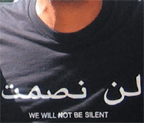
WE WILL NOT BE SILENT
Is It True, JetBlue? by Naeem Mohaiemen
"The artist says, "It's not my business." Then whose business is it? Does that mean you are going to leave the business of the most important issues in the world to the people who run the country? How stupid can we be?" [Howard Zinn, Talk @ Massachusetts College of Art, October 10, 2001]
Is It True Jet Blue? JFK? TSA? A rhetorical question that leads to a tautology. Yes, of course people racially profile the darker masses while whipping up a pervasive fear in the name of "national security." Paranoia is so essential to running the modern state, other navigation tools seem permanently broken.
After learning that Raed Jarrar was told to remove his Arabic WE WILL NOT BE SILENT t-shirt before he could board a JetBlue flight, four members of The Critical Voice (TCV) boarded a Jet Blue flight last Thursday. The four members, all white women and US citizens, were wearing the same Arabic t-shirts. They were allowed to board the flight. This is more evidence that the Raed Jarrar case is one of racial profiling and censorship.
Many of us have been helping as supporters of TCV, an affinity group of Artists Against the War (AAW). Today, after consultation with other members, Laurie of TCV went on Democracy Now and broke the story. I first met Laurie when she and other TCV members were ejected from NY Public Library's "Who's Afraid of Iran" event (w/ Shirin Neshat, et al) -- they were wearing the same t-shirts, but were ostensibly ejected for carrying political posters.
The t-shirts have now spread globally, and become an icon of popular, non violent resistance. Because of the open-ended nature of the two phrases "We" (who?) and "Will Not Be Silent" (about what?), people have appropriated these t-shirts and used their bodies to register opposition to many flanks of the "War On Terror", including invasions, fear-mongering, censorship, detention of immigrants, racial profiling of Muslims, use of African-Americans, Latinos and working-class Whites as cannon fodder, the abandonment of poor Blacks in New Orleans, and the linkages and overlaps between all these and other common struggles. To give one example, two weeks ago, many of us as members of Action Wednesday, collaborated with TCV to distribute the t-shirts at Outernational concert in Central Park, to protest the invasion of Lebanon.
Caroline Parker, Laurie Arbeiter, Susan Kingsland, Ann Shirazi and other members of TCV and AAW put into practice a new model of artists as public actors, activists and intellectuals who refuse to confine their cultural production inside gallery or museum walls.
Contra Adorno, it becomes even more essential to write "poetry" (using an expansive definition) after Auschwitz. To use the many routes of contemporary culture to dissent and to shape a new mental and actual reality.
Sandy Kaltenborn of Kanak Attac in Berlin writes, "Design Is Not Enough." Neither are t-shirts, but they are a good start. To take the carrier of such witless 1970s slogans as "Have A Nice Day", "I'm With Stupid", "Pobody's Nerfect", "Kiss Me, I'm Drunk" "My Parents Went To London And All I Got Was This Lousy T-shirt", and invert it into an act of body-based defiance is a good beginning.
At the risk of descending to repetition, I echo Adorno's sentiment:
"The only relation to art that can be sanctioned in a reality that stands under the constant threat of catastrophe is one that treats works of art with the same deadly seriousness that characterizes the world today." [“Valéry Proust Museum” in Prisms, Samuel and Shierry Weber, trans. (Cambridge: MIT Press, 1983)]
Stay tuned.
Related Links
We Will Not Be Silent On JetBlue (Press Release)
http://tinyurl.com/jjo9k
http://www.parkerstudio.com/AAW/JetBlueNotSilentweb1.pdf
Snakes On, Arabs Off The Plane
http://alternet.org/story/41140/
Artists Against War
http://aawnyc.org/
The Critical Voice
http://thecriticalvoice.org/
Naee Mohaiemen
Visible Collective/Disappeared In America
http://www.disappearedinamerica.org
[posted on sarai]
Posted by jo at 01:30 PM
| Comments (0)
From Here to There

Under an Umbrella
From Here to There Under an Umbrella by Chris Barr: The "Under an Umbrella" project stems from an experience that I had as a freshman in college, in which a younger version of myself offered a young lady a spot under an umbrella during a rainstorm. From that rainy two-block walk and the conversation that it allowed, an exuberant yet naive relationship developed.
For three days during Conflux I will offer to escort local residents and festival participants to their desired location under an umbrella, as a sort of umbrella taxi. Our walk and conversation will be recorded via an "umbrellacam" and will be uploaded to the project website. With this experiment I am interested in how a shift in spatial experience, i.e. a space designed for one being used for two, can shift other relationships such as communication. And how something such as our vulnerability to our environment can offer us unique (and sometime intimate) human experiences.
Participants can sign up for a walk at UnderAnUmbrella.com or call (716) 512-9254. The project will run Friday September 15 through Sunday September 17 from 8am - 4pm with documetation available on the project website.
Posted by jo at 11:18 AM
| Comments (0)
[iDC] Totems without Taboos:
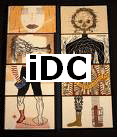
The Exquisite Corpse
This is an essay I've written as the foreward to an anthology on the classic game The Exquisite Corpse: Collaboration, Creativity, and the World's Most Popular Parlor Game edited by Kanta Kochhar-Lindgren, Davis Schneiderman, and Tom Denlinger, to be published by University of Nebraska Press (2007). This collection is the first set of original essays to provide a broad retrospective on the legacy of the Corpse project-and we are defining this legacy fairly loosely, with representation from historical, literary, collaborative, moments (etc.). The vibe is open and the text, I guess, is too. --enjoy! Paul aka Dj Spooky [via iDC]
Totems without Taboos: The Exquisite Corpse, by Paul D. Miller aka Dj Spooky that Subliminal Kid: Database aesthetics, collaborative filtering, musical riddles, and beat sequence philosophy aren't exactly things that come to mind when you think of the concept of the "exquiste corpse." But if there's one thing at I want to you to think about when you read this anthology, its that collage based art - whether its sound, film, multimedia, or computer code, has become the basic frame of reference for most of the info generation. We live in a world of relentlessly expanding networks - cellular, wireless, fiber optic routed, you name it - but the basic fact is that the world is becoming more interconnected than ever before, and it's going to get deeper, weirder, and a lot more interesting than it currently is as I write this essay in NYC at the beginning of the 21st century. Think of the situation as being like this:
in an increasingly fractured and borderless world, we have fewer and fewer fixed systems to actually measure our experiences. This begs the question: how did we compare experiences before the internet? How did people simply say "this is the way I see it?" The basic response, for me, is that they didn't - there was no one way of seeing anything, and if there's something the 20th century taught us, is that we have to give up the idea of mono-focused media, and enjoy the mesmerizing flow of fragments we call the multi-media realm. For the info obsessed, games are the best shock absorber for the "new" - they render it in terms that everyone can get. Play a video game, stroll through a corridor blasting your opponents. Move to the next level. Repeat. It could easily be a Western version of a game that another culture used to teach about morals and the fact that respect for life begins with an ability to grasp the flow of information between people and places. I wonder how many Westerners would know the term "daspada" - but wait - the idea that we learn from experience and evolve different behavioral models to respond to changing environments is a place where complexity meets empathy, a place where we learn that giving information and receiving it, is just part of what it means to live on this, or probably any planet in the universe. What makes "Exquisite Corpse" cool is simple: it was an artists parlour game to expose people to a dynamic process - one that made the creative act a symbolic exchange between players.
Some economists call this style of engagement "the gift economy" - I like to think of the idea of creating out of fragments as the basic way we can think and create in an era of platitudes, banality, and info overload. Even musicians and artists - traditionally, the ciphers that translate experience into something visible for the rest of us to experience - have for the most part been happy for their work to be appropriated by the same contemporary models for material power that have created problems for their audiences - power and art happily legitimizing each other in a merry dance of death, a jig where some people know the rules of the dance, but most don't. But this "death," this "dematerialization" - echoes what Marx and Engles wrote about way back in the 19th century with their infamous phrase "all that is solid melts into air." Think of the exquisite corpse concept as a kind of transference process on a global scale. When you look at the sheer volume of information moving through most of the info networks of the industrialized world, you're presented with a tactile relationship with something that can only be sensed as an exponential effect - an order of effect that the human frame of reference is simply not able to process on its own. At the end of the day, the "exquisite corpse" is just as much about renewal as it is about memory. It depends on how you play the game.
The way I see it, is this: whenever humanity tries to really grapple with the deep issues - life, death, taxes, you name it - it becomes a game, and I like to think that like most human endeavors, "exquisite corpse" is all about chance processes. For example, the Indian game of "daspada"or "Snakes and Ladders" as its commonly called, has its origin in documents from India around 2nd century BC. It's said that it was used as a game for teaching morals - the relative level of reincarnation, and multiple perspectives represented whether life's lessons had been learned - or not. The British took it to England in 1890s and from there, it spread to the rest of Europe and the world, but the basic idea is that the idea of living multiple lives, games theory, and the moral relationship between individuals and society was linked to rules - it seemed like a good place to reflect on how games get "sampled" and remixed, depending on which culture they're in. Cut and paste the result, and the basic idea is that this is all about information, and how we play with it. It could easily be Pac Man, Quake, or Halo2 it depends on your frame of reference. It's a thread that easily connect artists as diverse as Luis Buñuel, John Cage, Virgil Thomson, and Grand Master Flash. Yes, Grand Master Flash! The whole idea is to look at links - at connections that are unacknowledged but also undeniable: chance processes, and randomness do that - they scramble subjectivity in a way that lets the unconscious methods we've used to sort information in our minds become a filter for the way we engage the external world. It's a scenario that turns the mind inside out, and that, like pop culture always says, is a "good thing."
Humanity, according to most studies of "information theory" creates about 8 to 10 exabytes of information a year in the 21st century. An exabyte (derived from the SI prefix exa-) is a unit of information or computer storage equal to approximately one quintillion bytes. Its such a large number that it's literally beyond human comprehension. For example, the total amount of printed material in the world is estimated to be around five exabytes. It was estimated that by the end of 1999, the sum of human knowledge (including audio, video and text) was 12 exabytes - UC Berkeley School of Information suggests that 5 exabytes of storage space was created in 2002 alone, 92% of it on magnetic media, mostly on hard disks - the vast majority of this space is used to store redundant intellectual works such as music and commercial video.
A while ago, University of California Berkelely claimed that 5 exabytes of data approximately equals "all words ever spoken by human beings" this statement is just the tip of the iceberg, but you get the idea - there's a tremendous amount of information being produced by our culture, and the real way that humanity experiences most of it is through multi-media. That's where the "exquiste corpse" concept comes home to roost.
Think of one exabyte as a zillion gigabytes, and you get the idea - scale, density, and the sheer volume - it's all getting smaller, more fragmented, and more nuanced. That's more information than most of humanity has made throughout its existence on this planet over millions of years. Exquisite Corpse is a game - it's also known as "exquisite cadaver" or "rotating corpse" - but basically, it's a filtering process where a collection of words or images are assembled collectively, and the result is commonly known as the exquisite corpse or cadavre exquis in French. Each collaborator adds to the collage composition in sequence. It's the sequence of the game that makes the tension between each player a connected, and ultimately enriching experience - each person is only allowed to see the end of what the previous person contributed.
Think of a more technology oriented description this way: adaptation to human-engineered technologies, testing formal and ecological theorems for high-density lifestyles, sustainable resource sharing among urban organisms, and the play of public/private division in cross-species interaction. Got it? Info density isn't about the information just sitting happily on your hard-drive, on your canvass, or in the artists studio: the whole theme of this group of essays is a reflection on the different paths information takes as it moves from one culture to the next, one individual at a time. Think of Moore's Law: Expressed as "a doubling every 18 months", Moore's law suggests the phenomenal progress of technology in recent years. Expressed on a shorter timescale, however, Moore's law equates to an average performance improvement in the industry as a whole of over 1% a week. What game does that open us up to in the era of large numbers? For example - at pandora.com visitors are invited to enter the name of their favorite artist or song and to get in return a stream of music with similar "DNA," its essentially, in effect a private Internet radio station microtailored to each user's tastes. There's more - for example, customizable Internet radio services like Pandora, Last.fm, Yahoo's Launchcast and RealNetworks' Rhapsody are pointing users to music far beyond the playlists that confine most FM radio broadcasts. The most familiar form uses so-called collaborative filtering, software that makes recommendations based on the buying patterns of like-minded consumers. Think of the "customers who bought items like this also bought ..." function on Amazon.com. Your tastes, and the way the travel through the system are based on variables that leave trail for the algorithms running the software to model - that is then passed on to someone else, and so on and so on. Think of it as the cultural update of what "daspada" was about, just transcribed to the realm of the digital - the Surrealists anticipated this, and made it enjoyable.
In the realm of video and online media, the craze of "Machinima" - or when kids remix video game characters to make their own films, or in the realm of dj culture - it's the mix tape - but the common denominator is selection. The whole schemata that I'm pointing out is that density, and the tools we use to navigate it, are barometers of the deep structure of culture as it is translated into information - it's a pattern that, as the 21st century advances, will become more and more linked to the way we live and the way we play.
Moore's original statement can be found in his publication "Cramming more components onto integrated circuits", Electronics Magazine 19 April 1965 - but for the intents of this essay, let's think of the basic frame work as a mirror for Mie Van Der Rohe's infamous quip about design: less is more. Whisper that in someone's ear and see what happens.
The remix, as always, is what you make of it. Juxtapose, fragment, flip the script - anything else, simply put, would be boring. This anthology, like the original game of the Surrealists, points to a place in culture where, the process of art is a collaborative process. It's a situation that requires, like the name, a kind of collective action. The drawn version predates the written version - the anthology is a map of an un-drawn terrain of bodies and minds. Think of Mary Shelley's Frankenstein - the mis-matched body parts, the fragmented speech, the neo-Romantic sense of loss and renewal - what would that creature feel if it knew that it was justa figment of Shelley's imagination, a conversation piece made up on a cold night in Switzerland in the 19th century? Flip the script, cut and paste the result, and the literary equivalent of the artificial creature flows off the page and becomes another story, another composition, another way of seeing a world rapidly advancing into a frame of reference that we know is at the edge of what we call human.
Again the main motif of the scenario - the drawn version predates the written version - it's a kind of guessing match that produces what has now become a mass culture cliché: that's what I'm talking about. Collective memory, and the way it unfolds in the expression of culture, I guess that could be referred to as the "exquisite corpse" too. The whole idea of this anthology is to explore the places on the cultural map that haven't been marked, places that on any other map would be marked "here be dragons" - yes, the blank places. They invite interpretation, and yes, the active mind wants to doodle and fill in the emptiness. The map's blank spaces beckon like some kind of light at the end of a dark tunnel. I can only say that this collection of writings is a lexicon, a guide for interpreting a phenomenon that we all know waits at the edge of our imagination, if we only had the tools to navigate its unknown space.
Some have played the (graphic) game with a more or less vague or general prior agreement about what the resulting picture will be, but this defeats the essentially Surrealist nature of the game - you can say "look, these are the spaces that we present to you, and the rest is a method acting course in roles that no one is quite sure about how to play - the rest is up to you." See if the puzzle pieces fit, draw a line connecting the dots. But most of all - have fun!
Paul D. Miller aka Dj Spooky that Subliminal Kid
NYC 2006
www.djspooky.com
Posted by jo at 10:14 AM
| Comments (0)
ShiftSpace

A Social, User-Centric Space
There were two great talks at the Pixelspaces panel. One of them was by Dan Phiffer (US) and Mushon Zer-Aviv (IL) who presented ShiftSpace, a project they developed at the ITP in New York (honorary mention in the PrixArs competition). I've got no image for it because my camera broke :-(
The first question they asked themselves was “Is there a public space on the web?” Then they demonstrated that the web is not really a public space.
First example they gave to illustrate their point was Christophe Bruno’s online work: The Google Adwords Happening. He tried to answer the question: “how do you make money from net.art?” that had popped up on the rhizome mailinglist. He decided that he’d start by losing money. So he bought some advertisement slots on google. They were not related to the key word he had bought the space for and were not mentioning any URL.
Many people saw his work. But after some time, he received a letter from Google saying something like “We think that you can do your work better, here’s a few tips: put the keyword on the title; add a clear description of your website and of course, please add the URL of your website. Bruno ignored the letter and left the ads as they were. He got another letter from google threatening him of taking down his adverts if he didn’t conform to the rules. The ads went off and Bruno’s attempt to create public art on the web with the pages of Google ended there. His example shows that google is a very private space.

Just like shopping malls...
Defenition of public space from wikipedia: “A public space or a public place is a place where anyone has a right to come without being excluded because of economic or social conditions, although this may not always be the case. One of the earliest examples of public spaces are commons. For example, no fees or paid tickets are required for entry, nor are the entrants discriminated based on background. Non-government-owned malls are examples of private space with the appearance of public space.”
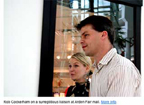
A personal anecdote from Dan: in California there’s a fairly famous website run by a guy called Rob Cockerham who makes pranks: cockeyed.com. He wrote a text on his website asking his readers to follow him in a shopping mall, stalk him as he shops and walks, take pictures of him and behave like papparazzi. But two picture takers were warned by a security guard that unless their cameras were put away they’d be escorted out. When they asked: But isn’t the mall a public space? They were told that, no, in fact a mall is a private property. Shopping malls are like the web, they have the appearance of a public space but they are private.
What is Shiftspace?
If you google “falun gong” on google.com you’ll get a different result than on google.cn because Falun Dafa is censored in China. ShiftSpace adds a note on the Chinese google results that says “Please note that these results have been censored. The un-censored top results should be falundafa.org.”
The artists then showed how they annotated the ars electronica website, hacking its motif. Another example showed a banner on myspace that said that it was Ruppert Murdoch’s space (he bought Myspace), so is it still “your” space?
How does ShiftSpace work?
You browse the net as usual and when a thingy note pops up, you’re informed that the website has ShiftSpace annotations on it. You can filter the notes. For example, decide to see only the notes written by your friends; you can notify ShiftSpace when a note is in fact Spam. The developers also got inspired by the digg system and ShiftSpace allows tho shift up or down a note, according to its interest.
Brief history of the Metaweb.
In 1999 Thirdvoice.com allowed web users to add annotations on a webpage. In 2001, Third Voice had to close. Many lawsuits against them.
In 2004, Greasemonkey let hackers inject code into a page to update it or add new features to the website.
If we compare Shiftspace, Greasemonkey and 3rd Voice, we get:
- Third Voice was a social system; it allowed just one application, was user-centric, it was a proprietary code;
- Grease Monkey wasn’t social, it allowed for various applications, there was no aggregation and it was Open code;
- ShiftSpace is social, it allows for various applications, is user-centric, has an aggregation interface and his code is open.
The tool is very approachable and it allows for people who are not familiar with the code to join the fun.
Now Shiftspace needs your help. How can you participate?
Use the platform and file in bug reports; help develop the core platform. The development heads are IF APIs; Data management; social network and reputation systems; privacy.
Join the mailing list on community.shiftspace.org.
On Tuesday, everyone is invited to the Installation Party at the electrolobby, Dan Phiffer and Mushon Zer-Aviv will install ShiftSpace on your machine. It takes 30 seconds.
Demo video.
Paparazzi image from Dan's flickr page.
Related: Sascha has done a great interview of Christophe Bruno, Google Will Eat Itself. [blogged by Regine on we-make-money-not-art]
Posted by jo at 09:56 AM
| Comments (0)
VIBRA: AUDIO LIMA EXPERIMENTAL
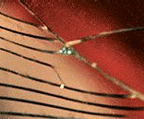
First Contemporary Sound Art Festival in Peru
First-time ever contemporary sound art festival in Peru: VIBRA: AUDIO LIMA EXPERIMENTAL :: The festival will comprise exhibits, concerts, lectures and workshops, to be held from August to November 2006. The festival's main goal is for Lima to become an audio and sound documentation experiences centre that spreads out and links together diverse ways in which we listen to our surrounding world. The festival's activities will focus around the importance of sound in our lives and in artistic creation. Renowned art critic Jorge Villacorta curates the festival and its activities.
Centro Fundación Telefónica and Alta Tecnología Andina presents VIBRA: Audio Lima Experimental festival, the first major event dedicated to contemporary sound art ever organized in Lima. It will comprise exhibits, concerts, lectures and workshops, to be hold from August to November 2006. Art critic Jorge Villacorta curates the festival and its activities.
VIBRA: Audio Lima Experimental will turn Lima into an audio and sound documentation experiences centre that spreads out and links together diverse ways to listen to our surrounding world. The festival¹s activities will focus around the importance sound has in our lives and in artistic creation, and will reinforce the concepts of art, science and the new technologies.
Starting in 1990, sound art has transformed visual arts with a new aesthetic that fuses sensory experiences, thinking, action and creation of scenarios that involve movement and space. Therefore, it was indispensable that a festival of such prominence and innovative proposals was organized for the first time ever in our country.
Furthermore, VIBRA: Audio Lima Experimental will also develop activities within the educational field, with a program that focuses on sound perception, interaction and creation. The program¹s goal is for children and school students to have a first approach towards current art trends and the new media. Children will be able to play and interact with the pieces and objects on exhibit at Centro Fundación Telefónica, and will learn about the diverse manifestations of sound that occur in their surroundings. This educational project is part of the "Arte para aprender" (Art for Learning) program, executed by Fundación Telefónica in association with Museo de Arte de Lima.
The festival will also showcase innovative experimental proposals ‹national and foreign‹ that incorporate digital technologies and link together sound and video in actions, interventions and installations. It will also encourage participative sound scenarios that include group listening experiences. All these proposal focus around sound as a source of inspiration and creative exploration, and lead to new ways of understanding what art is.
Festival exhibitions: The festival will show two main exhibitions, both of which will be hold in Sala Paréntesis of Centro Fundación Telefónica and will work as a 'foundation' for the rest of the activities.
The first exhibition, Audiogeneradores (August 23-September 20), includes the following installations: Spatial Sounds (The Netherlands), rrrrrrrringtonarumori! (Peru) and Audiotránsito Reflex (Peru).
Spatial Sounds (100dB at 100km/h) is an interactive exhibit that responds to the spectator presence with a speaker mounted on an arm that rotates following the visitor movements. This project is a reminder of how human beings are attracted to technology, and of the vulnerable physical and emotional reactions they have towards technological power.
Created by dutch artists De Nijs and Van der Helde, Spatial Sounds makes us aware of the links we ceaselessly create with sound-producing objects in our everyday life, and the influence those sounds have in our spatial perception. This exhibit will be shown in Lima thanks to the cöoperation of the Mondriaan Foundation from The Netherlands.
On the other hand, peruvian artist Valentín Yoshimoto's rrrrrrrringtonarumori! is a system in which mobile phones properly become sound-producing machines. Yoshimoto presents us with a series of mobile phones and the public is invited to use them and to 'become' disc-jockeys by means of mixing and organizing musical sequences.
The third part of Audiogeneradores is Audiotránsito Reflex, an interactive installation that allows visitors of Centro Fundación Telefónica to hear the sound of their footsteps and watch the audio signals generated by their spatial location. This project, open to the public through September 30, consists of a platform crammed with contact microphones that record the passing public and project the sound waves produced by their footsteps. This installation has been created by Peruvian art collective Inaut.
The second exhibition, Resistencias: Primeras vanguardias musicales en el Perú (Resistances: The First Musical Avant-gardes in Peru) (October 4-November 8), will go back in Peruvian musical history, aiming to highlight its educational value and merit. It will showcase the avant-garde of an almost unknown Peruvian generation of artists that worked with foreign first-rate experimental musicians and have been in activity and producing works from the decade of 1950 up to the date.
Invited artists: Some of the most important names in the history of American and European experimental music from 1955 will take part in VIBRA: Audio Lima Experimental, among them: Charlemagne Palestine (USA), Pauline Oliveros (USA), Francisco López (Spain) and the group Black Dice (USA). Together, they represent the most prominent of the experimental sound art scene in the world nowadays.
VIBRA: Audio Lima Experimental will also be organizing the Ciclo de interpretaciones de piezas peruanas contemporáneas (Series of performances of contemporary Peruvian compositions), with pieces created by composers such as César Bolaños and Celso Garrido Lecca. Performers include musicians from the local scene, such as José Javier Castro, Carlos García (Carlangas), Valentín Yoshimoto, Renzo Gianella and Renzo Filinch. The concerts will take place in October and November.
The works by the invited artists range from post-industrial music to radical neo-modernist subjective listening, from electro-acoustic to electronica, also including minimalism and primitivism. Besides playing for the first time a series of concerts in Lima in different parts of the city, they will share their knowledge by conducting workshops and lecturing about their creative process, all of which will allow the public to take a deeper, more thoughtful look, into sound art.
The festival will take place over three months at Centro Fundación Telefónica, open Monday to Saturday from 12.00 to 21.00 (Wednesdays closed), and Sundays from 12.00 to 19.00. Access to all activities is free of charge (limited capacity). Centro Fundación Telefónica can also be reached at http://centro.fundaciontelefonica.org.pe/.
Posted by jo at 09:53 AM
| Comments (0)
ambientTV
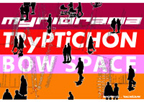
Seminars, Installations, Performances...
:: SPECIES OF SPACES, mukul @ CEPT School of Architecture, AHMEDABAD (IN) 22nd July-7th August, 2006 :: Seminar at the School of Architecture, CEPT, Ahmedabad, India. Mukul leads 32 hrs of exploration for the students and faculty on art, politics, and technology as refracted through concepts (and metaphors) of space. Some areas of focus are the potentials of, and restrictions laid upon, digital networked space; the circumscribing of public space in urban zones; mediaspace (including pervasive/locative media and tactical approaches); activism and dissent; art outside the gallery walls; the body and movement; and acoustic space. A lab component explores systems- and process-based approaches to sound in space from the 1960s. The seminar is now over and student works will be documented online.
:: AMBIENT.LOUNGE, ambientTV.NET @ NTT InterCommunicationCenter, TOKYO (J) from 15th September 2006 :: ambient.lounge: The exhibition 'Connecting Worlds' marks the reopening of the NTT ICC in Tokyo. ambientTV.NET creates the ambient.lounge as a space to browse works, relax, connect, reflect, dream, and snack on wild pixels and grains of sound. As well as showcasing our own work, we have invited guest artist Juha Huuskonen to present The Moment of Long Now.
We created an ambient.lounge as part of our VBI (Voluptuously Blinking Eye) lab at this year's Rotterdam Film Festival. A short video documenting VBI (and featuring Lektrolab, irational.org, Rachel Baker, Tina Hage and Juha Huuskonen) is now online in the download section.
:: WHO WATCHES THE WATCHMEN?, Manu Luksch @ servus Clubraum, LINZ (AT) 21st Sept 2006, 7 pm :: presentation & screening of recent works making use of security and surveillance technology. servus Clubraum, Kirchengasse 4, Linz (AT).
:: IST (Indian Standard Time) - NEW CLOCKS FOR THE CITY, mukul @ Lille3000, LILLE (FR) 14th Oct 2006 - 14 Jan 2007 :: For the Lille 3000 festival, mukul is making idiosyncratic clocks that will be installed inserted in strategic places, including the metro system. The festival opens on 14th October and features a very wide of works performances that engage with the idea of India. Check back online over the next months for updates.
::ORCHESTRA OF ANXIETY, Manu Luksch and mukul @ databodies, AMSTERDAM (NL) 26th of October, 2006 :: The Orchestra of Anxiety is a collection of musical instruments that use materials and technologies from the security and surveillance industries in their construction. The first realized instrument, a harp with strings made of razor wire, will be on show in Amsterdam (NL), during databodies, on 26th of October, 2006.
:: Manu Luksch @ No Man's Land, Womanifesto, ONLINE Oct 2006 :: No Man's Land invites 65 participants internationally to present works online addressing the territorially imagined line of the border, its powers of inclusion and exclusion, and its ability to simultaneously promote both unity and conflict. The project will develop gradually as the invited participants upload their work. No Man's Land is part of Womanifesto 2006 (Bangkok, TH), curated by Varsh Nair and Katherine Olston.
Participants: Yoshiko Shimada, Barbara Lattanzi, Renata Poljak, Tejal Shah, Phaptawan Suwannakudt, Terry Berkowitz, Kai Kaljo, Dragana Zarevac, Roland Bergere, Manit Sriwanichpom, Susanne Ahner, Pisithpong Siraphisut, Patricia Reed, Mella Jaarsma, Mideo Cruz, Mona Burr, Manu Luksch/Ambient TV.NET, Karla Sachse, Martin Zet, Wen Yau, Traci Tullius,Tintin Cooper, Jerome Ming, Estelle Cohenny-Vallier, Katherine Olston, Pinaree Sanpitak, Sutee Kunavichayananda, Lawan Jirasuradej, Sara Haq, Karen Demavivas, Nigel Helyer, Nilofar Akmut, Andrew Burrell, Pamela Lofts, Beatriz Albuquerque, Kirsten Justesen, Maryrose Mendoza, Hsu Su-Chen, Michael Bielicky, thingsmatter, Arahmaiani, Kate Stannard, Judy Freya Sibayan, Chaw Ei Thein, John Hopkins, Farida Batool, Baiju Parthan, Liliane Zumkemi, Noor Effendy Ibrahim, Tamara Moyzes, Ana Bilankov, Chakkrit Chimnok, Suzann Victor, Marketa Bankova, Sue Hajdu, Jim Previtt, Keiko Sei, Suvita Charanwong, Noraset Vaisayakul, Konrad, Reiko Kammer, Silvia Pastore, Felipe, Chitra Ganesh, Varsha Nair.
About ambientTV
ambientTV.NET is a crucible for independent, interdisciplinary practice ranging from installation and performance, through documentary, dance, and gastronomy, to sound and video composition and real-time manipulation. Techniques and effects of live data broadcasting and transmission provide theme, medium, and performative space for many of the works.
http://www.ambientTV.NET/indigo
Posted by jo at 09:39 AM
| Comments (0)
September 01, 2006
etoy.CORPORATION

MISSION ETERNITY at Burning Man 2006
August 29, 2006 8:22:21 AM GMT+02:00: BURNING MAN FESTIVAL 2006 - etoy.AGENTS braving the desert nights, sand in our teeth, resolve in our red eyes. WELCOME to all new M∞ PILOTS! :: As of today, etoy.CORPORATION presents the MISSION ETERNITY SARCOPHAGUS, a mobile sepulcher for users who prefer to be buried at an undetermined geographical location, at the Burning Man 2006. Check us out near the temple (open after sundown), or visit the etoy.CREW at the playaQ camp site at 4:30 and brave!!!
The mobile cemetery tank is a 20 foot ISO standard cargo container which potentially travels planet earth forever. The inside walls of the tank are covered with 12,000 individually addressable LED pixels, forming an immersive, semi-interactive display system with each pixel offering a last resting place of a M∞ PILOT. The system therefore allows for simple re-location of the mortal remains of up to 1000 M∞ PILOTS.
YOU ARE INVITED TO JOIN MISSION ETERNITY - ONE OF THE MOST CHALLENGING OPEN CONTENT PROJECTS IN THE HISTORY OF ART. STORAGE ANGELS, CODERS, LAWYERS AND MORTAL REMAINS COURIERS CAN APPLY ONLINE FOR ANGEL STATUS AND PARTICIPATE IN THE MISSION. http://www.missioneternity.org/angels
Visit http://www.missioneternity.org for detailed project documentation, software download, and initiation protocols. To support MISSION ETERNITY contact invest[at]ir.etoy.com
COMMUNICATION: Due to extensive offline operations in LA, some etoy.AGENTS missed considerable amounts of emails, phone calls and other data traffic. Please visit http://www.etoy.com/ contact and resend your messages to specific agents if you did not get the answer you were looking/waiting for. The etoy.CREW apologizes for the communication inconvenience.
Posted by jo at 03:09 PM
| Comments (0)
Turbulence Commission:

THE ESSENCE OF A NATION: CHINESE VIRTUAL PERSONS ON THE NET
THE ESSENCE OF A NATION: CHINESE VIRTUAL PERSONS ON THE NET by XiaoQian [needs Macromedia Flash Player plugin; Internet Explorer 5+, Mozilla Firefox 1.5.0+, or Safari 1.0+]
My name is XiaoQian, I am an artist and I create virtual persons online. For this website I created 6 chinese virtual persons: Mu Yuming a painter, Shaxpir a hip-hop singer, Wang Shy a ghost in a traditional garden, He Zhengjun a carpenter working with wood and text, Yi Zhe a guest in a wedding and myself XiaoQian. My e-mail is xiaoqian at virtualperson.net
"THE ESSENCE OF A NATION: CHINESE VIRTUAL PERSONS ON THE NET" is a 2005 commission of New Radio and Performing Arts, Inc., (aka Ether-Ore) for its Turbulence web site. It was made possible with funding from the Andy Warhol Foundation for the Visual Arts.
BIOGRAPHY: XiaoQian is a Chinese artist. Her art is to create virtual persons online. She has also designed herself as a virtual person. Her real life identity may never be disclosed.
Posted by jo at 01:58 PM
| Comments (0)
Blogimpsest:
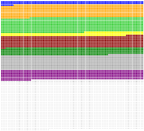
A Blog that Dreams
Blogimpsest: My blog is a Janus head, a 2-faced web0.0 monster. On one side it does what you would expect from the barest of bare-bones blogging systems (no HTML-formatting, no RSS-feed) but on the other side it does have a mind and purpose of its own; it is a blogject. Both faces share the same memory-filled palimpsest-styled head. A head that as a whole is a little mind, a symbiotic alliance; these two faces need to help each other to make the most of the limitations of their common resource. It is an experiment in grassroots AI...
Current Map of Blogimpsest [above image]: Each cube represents a segment of a colour-coded memory. Each black dot represents a free segment. While the palimpsest has free segments entries are added from left to right and from top to bottom. When filled, dreaming commences (and the blogject will eject-text) to make space. This results in chains sharing a segment and releasing one in the process. The neat crystalline order inside the memory that exists in the beginning will slowly become chaotic. See history of growth of palimpsest.
Posted by jo at 12:58 PM
| Comments (0)
Agent Radio
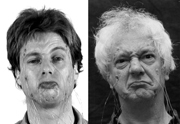
Automatic, Ongoing Soundscape
Agent Radio is an automatic radio station built around a computer with a broadband internet connection. The algorithm which runs the station downloads random sound files from the internet, and mixes them into an ongoing soundscape.
Agent Radio is one of the main projects taking place in the Department of Random Radio of the Institute of Artificial Art Amsterdam. The IAAA promotes the establishment of dedicated radio stations for the diffusion of sound-environments created by algorithmic music, physical processes, industrial machinery, randomly selected audio-documents, and arbitrarily sampled live sound. [via]
Posted by jo at 12:46 PM
| Comments (0)
Smart Urban Intelligence [S.U.I.]
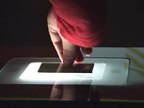
fictive service in the very near future
"Computerized surveillance" in the contemporary society is, regardless of the distinction of government and of corporation, essentially and inextricably linked with "services" or "convenience," and it takes the form of "comfort" within the logic of consumer society. S.U.I. is a caricature of the situation in the very near future. With a mixture of realness and fiction, it somewhat exaggeratingly indicates the situation, which is now occurring and has possibility to occur from now on, in connection with surveillance that explicitly or implicitly exists in our computerized consumer society.
It is a "fictive service in the very near future." Reading actual data in a real smartcard for a railway ticket, which is now very broadly used in Tokyo area, it displays the history in the card in the form of motion video and of visualized route map in real time. At the same time, the bot as "the agent of the service" automatically analyzes the history in the card, and speaks the result to the user.
Basically the bot speaks about the following things.
1. Card holder's "living place."
2. Card holder's most "favorite place" to visit, and the related intrusive recommendation.
3. Card holder's records of "returning home," of "staying out overnight" etc.
4. Card holder's very shortsighted assumed "profile."
5. Something not worth bothering about each station in the history.
6. "General information" about the card.
---etc.
For the bot, the datum is the only real thing, and he analyzes, interprets and evaluates it with his arbitrary and biased view. As the simple "mock AI," the bot speaks about the actual data in the card, extremely shortsighted presumptions, fictive things, the real fact related to the card, and so on.
I hope people become more aware of the growing situation, that is "administration of individual body by the RFID technology," and of the problems it potentially contains through this work.
By Ryota Kimura [Related: The SWIPE Toolkit]
Now in CyberArts2006 exhibit at Ars Electronica 2006, 31. August - 8. October
O.K Centrum fur Gegenwartskunst, Linz. [via Regine on we-make-money-not-art]
Posted by jo at 12:40 PM
| Comments (0)
OPERA.tion LIFE NEXUS
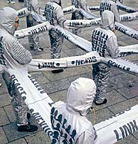
An Evolving Opera
OPERA.tion LIFE NEXUS: Jorge Orta began this mixed media work in 1996 and it will evolve and grow in length until 2006. Based on interdiciplinary collaborations, 3 generations of artists are invited to create a module for the open-ended composition: music scores, dance sequences, sculpture, light and video projections. The federating theme is the heart = Life, the creative idiom from both a symbolic and Human perspective. Its complex mythology renders the symbol poetic.
The Babylonians designated the heart the center of intelligence and memory. For the Egyptians it represented the terrestrial support for the soul. Hypocrite refer to the heart as the intelligence organ. Plato believed the heart was the center of feelings and passion. For Aristotle the heart transformed food into blood and was the emotional centre. Its universal nature helps to converge cultural, social, religious differences and from a scientific angle it exposes a new vision of a medical problem.
OPERA.tion is a locus for debate to address the sensitive subject of life saving organ donation; thousands of people are on a waiting list for organ donations... [F]renzied individualism has left society without hearts and heart !
The opera comes in a kit format and adapts to all venues. Crate sculptures facilitate the transport, preserve the archive of resulting collaborations: objects, music scores, video and photographic works, CD Roms, silkscreen prints, visual poetry, paintings, Body Architectures…, are stored in the wooden crates, which in turn are labeled and stamped with the origin of the multiple actions throughout the world.
Jorge Orta (Rosario, Argentina 1953) lives in Paris Artist and architect, Jorge Orta has been working on large scale ephemeral works since 1973. Protagonist of an urban and social poetic language, he has developed many new and alternative forms to communicate : using mail art, video installations and performance in the early 70's, to large scale projections in the 80's. Over the last 20 years he has devised a polysemic alphabet of signs and symbols which allow him to address very diverse publics, and more recently he has been exploring the symbol "Heart" to consolidate art, mythology and science. Jorge's light projection work took on its veritable dimension in 1992 when he projected giant mobile images inside the Pompidou Centre in Paris and when he embarked on a human experience to project his signs on Machu Picchu mountain in Peru. Since, he has covered the facades of the Venitian palaces at the 1995 Venice Biennale, and more obsolete places such as Capadoccia in Turkey, Cuenca in Spain, Aso volcano in Japan, Chartres and Evry cathedrales and many more.
Posted by jo at 12:09 PM
| Comments (0)
The Beall Center for Art and Technology

Call for Proposals
The Beall Center for Art and Technology seeks projects of high artistic merit that use technology in innovative ways. We offer honorarium and project costs of up to $20,000, to realize the project in our 2500 sqf space. We are also interested in collaborating with other institutions to fund projects of larger scale. We are currently soliciting proposals for exhibition years 2007 and 2008. The proposals will be reviewed in November of 2006 by the Beall Center Curatorial Review Committee, and artists notified in early Winter of 2007.
The Beall Center produces exhibitions and performances in the visual arts, theater, dance, and music, and particularly seeks works that successfully integrate new forms or uses of technology with artistic production or performance. In addition, as the Beall Center has an exceptionally well- developed and flexible infrastructure, and knowledgeable staff that is found in very few art and technology centers, preference will be given to works that can not easily be displayed or performed elsewhere.
Eligibility: Artists, curators, or institutions are eligible to submit proposals. Priority is given to cross-disciplinary projects. Artists or organizations that have previously received funding from the Beall Center must wait at least two years before reapplying. Women and artists of color are encouraged to apply.
Available Facilities: The Beall Center is a 2500 square foot black box with a highly configurable network grid, and connectivity to gigabit speed Ethernet. See "Facility" http://beallcenter.uci.edu for additional information.
Deadline for Application:October 20, 2006
Award Notification: Winter 2007
Proposals
Proposals should be submitted only in electronic format (pdf) and should include :
1) Contact Information (name of lead applicant, address, email, phone)
2) Project abstract: 100 words
3) Project description (500 word max.)
4) Resume or curriculum vitae for applicant and all participants.
5) One page itemized budget.
6) List of equipment and other resources required. If you will require technical assistance, please outline the nature of that support (hardware, software, expectations of personnel, and programming skills that will be required).
7) Copy of any matching awards or copy of funding request for external and internal sources.
Priority will be given to projects with supplemental funding.
8) Preliminary visual diagrams indicating installation concepts, in electronic format (pdf).
9) Samples of work: For ease of presentation it is best to submit images within the PDF proposal document. Include detailed explanations about the work samples. Time-base should be submitted in QuickTime mov files on cd or dvd media only (NO DVDÕs); and for sound works, submit audio files in mp3, refer to your video or audio files in your proposal, with a describtion.
10) Please be prepared to provide two references; you may be contacted during the review process to provide these.
Award Criteria
Criteria used to select proposals include the following:
1) Intellectual and artistic merit in the proposed project
2) Degree of technological innovation
3) Feasibility of the project under sponsorship of the Beall Center
4) Extent of collaborative and interdisciplinary activity
5) Possibility of subsequent installation or performances outside UCI
6) Presence of matching funds
For a list of previously funded projects (2000-2006), see
http://beallcenter.uci.edu/calendar/calendar.htm
Methods of Submission: The preferred submission method (but not required) is to post your proposal and work samples on your website
1. Mail proposal cd, or dvd media (not as dvds) only to:
Beall Center for Art and Technology
Exhibition Grant Proposal
HTC 101, University of California
Irvine, CA 92697-2775
Attn: Eleanore Stewart
2. Email proposal to estewart[at]uci.edu or dfamilia[at]uci.edu
Contact Information
Eleanore Stewart, Director
(949) 824-8945
estewart[at]uci.edu
David Familian, Associate Director
(949) 824-4543
dfamilia[at]uci.edu
Posted by jo at 11:32 AM
| Comments (0)
Reentry: New York City

Studies for Synthetic Meteors
Reentry: New York City :: Studies for Synthetic Meteors :: Eyebeam :: September 21 - October 21, 2006 :: Tues-Sat, 12-6pm :: 540 W. 21st St.
Reentry: New York City merges iconic night cityscapes with HD computer simulations in a series of studies for a daring new public art project: synthetic meteor showers in the Manhattan sky. Evoking the style and spectacle of the Apocalyptic Sublime painting movement with the vastness of Land Art, these new works created by Bill Dolson during his Eyebeam residency will be on view Sept. 21 through Oct. 21, with a special opening reception Sept. 21 6-8pm. The exhibition is open to the public Tuesday through Saturday from 12-6pm and is free of charge with a suggested donation.
Reentry: New York City contains twelve HD videos of synthetic meteors showers envisioned as luminous, ephemeral drawings in the upper atmosphere. These drawings will persist for only seconds, at most minutes. While quite fantastic, the project is technologically possible and preliminary plans have been established with the assistance of scientists at NASA JSC Ames and Los Alamos National Laboratories. Documentary information including tech specs and some of the motivation behind these artworks will be described in companion animation, presented at the entrance to the exhibition.
Reentry: New York City uses new technologies to draw on the tradition of the early large scale land art first produced in the 70s by such innovators as Heizer, Smithson, Morris and de Maria, evoking the same sense of daring, boldness and heightened awareness which the scale of these seminal works produced. However they avoid the permanent monumentalism of earlier land art through their dynamic and ephemeral nature, moderating their vast scale.
These studies invoke the Apocalyptic Sublime, a painting genre of the late 18th and early 19th centuries in Britain, in both content and format. Leading artists of the time including Benjamin West, Blake and Turner produced popular Apocalyptic Sublime works depicting apocalyptic themes such as The Deluge or scenes from the Book of Revelations, often in an urban setting and frequently featuring comets or meteors. The projections and screens in Reentry will be presented salon style. In the two hundred years since the Apocalyptic Sublime, the purview of art has been extended from the depiction of an apocalyptic event to the physical staging of one.
Dolson is simultaneously exhibiting digital C-prints of frames from these video studies at Photographic Gallery, 252 Front Street (South Street Seaport Historic District) in New York City. The exhibition, Trajectories: Carter Hodgkin & Bill Dolson opens September 28 with an artists' reception 6-9 pm.
Posted by jo at 11:30 AM
| Comments (0)
The End of Cyberspace
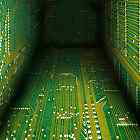
Cyberspace, a state of mind? + Another view
From UC-Irvine professor Mark Warschauer, The Death of Cyberspace and the Rebirth of CALL:
"The notion of "cyberspace" suggests that there exists a virtual, online world that is distinct from our real world. "Cyberspace" is a type of fantasyland, where we take on cyber-identities and engage in virtual reality. But then, when we leave cyberspace, we come back to the "real world".
I would contend, in contrast, that the significance of online communication lies not in its separation from the real world, but rather in how it is impacting nearly every single aspect of the real world. Just like there is no such thing as "speechspace" or "writingspace" or "printspace," so there is no cyberspace. The notion of cyberspace is thus not helpful for understanding the very real impact of online networking on our lives, and indeed the concept of cyberspace is slowly dying out." [link]
Cyberspace, a state of mind?
Buried in my del.icio.us links was a paper titled You Are Where? Building a Research Presence in Cyberspace, by an Edinburgh-based writer named Rory Ewins. It makes the argument that we should understand cyberspace as a kind of state of mind-- or more accurately, as a kind of imaginative state that we enter when reading:
"While most of us associate cyberspace only with computers and the Internet, we have been living in it for years. Whenever we pick up the telephone to talk to another person, we meet them in cyberspace, a place that corresponds to neither end of the line and to both.... [C]yberspace actually predates the “cyber”; we have been shifting in and out of it for as long as we have been communicating at a distance. It’s possible, perhaps, to trace it back even further in the history of communication: long-distance conversations carried out via airmail letters could be said to take place in a kind of cyberspace as much as at either end of the correspondence. As could letters from one side of town to another, or messages carried by couriers. All invoke an imaginative space in which two sides can meet and exchange information.
As anyone who has spent any time surfing the Web knows, it’s quite possible to spend hours at a time “in” cyberspace even when the only communicating one is doing is clicking on a link every few minutes to get a browser to send a request to a server for a new page to read. Most of our time online isn’t spent talking; it’s spent reading. Yet we still feel as if we are “in” cyberspace as we read words from the screen. Because of the history of the term itself, and the way we access these words via the Internet, we might conclude that computer technology is an integral part of this feeling of being in cyberspace....
Given the strong overlap in contemporary thinking between cyberspace and the Internet, and the past examples of the phone and telegraph networks, we might be tempted to think of cyberspace as arising out of communications networks, as being the place we meet when we communicate with each other. But that cannot be the whole story.... [R]eading takes us into an imaginative state, a state shaped by the author of the words we read, and by ourselves as readers. As readers we know what it feels like to be in that state; and we know what it feels like to slip out of it. We have all felt our minds wander as we read words on a page, and found ourselves having to go back and re-read them—forcing ourselves into a focussed, “reading” state of mind—immersing ourselves in those words, giving our attention over to them, quietening our own inner voice to listen to the voices of others.
What is this mental state? Where are we when we are in it? I would argue that it’s cyberspace; we simply didn’t have a name for it before. It’s a virtual place—the place where our mind meets another’s; where reader meets author. It’s the place we find ourselves in when we read a friend’s email; the place we meet when we hear their voice on our mobile phone. We have less opportunity when reading a printed page to respond to their words in a way that they will hear, but communication is still taking place, even if one-way....
So cyberspace is not something new. We have been building it for centuries, book by book, letter by letter, web page by web page. Or rather, we have been building gateways to it for centuries, because that’s all any of these are: means of access to the real cyberspace, which is invoked by our minds. Cyberspace is an imaginative state—a state of reading, of communicating, of thinking—which we have made more and more a part of our lives through advances in technology, from writing to printing to telecommunications to television to the Internet." [link] [blogged by Alex Soojung-Kim Pang on The End of Cyberspace]
Posted by jo at 09:56 AM
| Comments (0)
Social Data Browsing
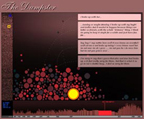
The Dumpster
"Consider the following paradox. The same few decades of the nineteenth century that gave us the most detailed artistic representations of human emotions and inner feelings, including romantic love, also saw the rise of statistical and sociological imagination. While Flaubert and Tolstoy were putting the emotions of their heroines under the artistic microscope of their prose, a different paradigm was emerging in which the individuals were nothing but dots contributing to a social law, a pattern, or a distribution. In 1838 August Compte coined the term 'sociology' for the new discipline that was to study the laws governing the life of society. (He also proposed the term 'social physics'). According to another founder of the discipline, Emile Durkheim, sociology is the science concerned with 'social facts' - phenomena that have an independent and objective existence separate from the actions of the individuals. In his major work Suicide (1897) Durkheim set out to demonstrate how such seemingly individual acts as suicides in fact follow general statistical patterns and can be explained in terms of structural forces that operate in society at large. Compare this to Anna Karenina (1877) where Tolstoy meticulously follows the last hours and minutes of Anna's life with a kind of anti-sociological gaze - looking at her not from the outside as a social scientist, but on the contrary, depicting how the outside world appears as seen by her." Continue reading Social Data Browsing by Lev Manovich, February 12 2006.
Posted by jo at 09:25 AM
| Comments (0)
-empyre- forum: ISEA Pacific Rim New Media Summit

Poetics and Politics
[posted on empyre by Tim Murray] : At ISEA, I delivered a presentation in the Pacific Rim section but was unable to participate in the Summit preceding ISEA as an invited observer.
I am disappointed to learn that the poetic style of [Raqs Media Collective's] language was critiqued for lacking "political content" at a Festival dedicated to the electronic ARTS. Is it possible that "poetic" language opens up an undetermined space for the political that may have been deadened by preconceived notions of recognizability or consensus? Are we confident that we can determine what such "political content" is? Does it exclude poetic and artistic form? Are we so ready to give up on artistic experimentation as a process of pushing the boundaries of how we understand the political? If so, there might not be so many reasons for the ISEA to continue to exist in its present form.
This does not mean that I wasn't concerned by the relative uniformity of the "content" of much of the artwork on display in the giant bubble. I, too, noticed a surprising quietude on the part of selected artists given the depth of overtly political issues confronting our community: from the war and electronic militiary apparati to issues surrounding "digital terror" and politicized borders, to hunger and reproductive rights, etc. Although there were many pieces that made gestures to the weighty issues, the overall tendency of the curatorial vision, which seemed to emphasis "data" collection and projection, tended in my mind to dull the ideological verve of the EA in the perhaps more recognizable guise of sociology, its particular artistic style, and its derivatives (I even think that my own informational presentation of the Chinese archival holdings was guilty of favoring information over ideological content). Nothing wrong at all with that--there were some tremendous works. Of course, there was also a great variety and amount of work spread all over San Jose, much of it both poetic and political, but the work under the bubble did seem to reflect somewhat of a common gesture to precisely the kind of recognizability for which Raqs seems to have been critiqued. I was struck, for instance, that the piece by Muntadas on information systems and interfaces, which he presents with a visually "poetic" interface, found itself exhibited in the isolation of the far wing of the Convention Center where ISEA was not meeting (I never asked him about the reason for this positioning and wondered if it could have been linked to what appeared to be a convention on search systems that seemed to end the day ISEA began?).
What's particularly troubling me, however, is less the curatorial vision than apparent association of poetic style with apolitical or elitist content. Doesn't this delimit the poetic's possibility of extending boundaries, of pushing limits, and of confronting us with articulations previously unspoken? It was in this context that Jean-Francois Lyotard, one of France's most political philosophers, frequently stated that form itself is the most political of constructs.
When Arthur and Marilouise Kroker and I worked together on the design of the common interfaces linking the internet artworks on CTHEORY MULTIMEDIA, grouped around paradigms of genomic, terror, sound, etc., we worked to develop more of an artistic and poetic interface than a more obviously information friendly one. While recognizing that this could alienate some users, our hope was it would encourage them to participate in the poetic openness and interfaces of the many ideological edgy artworks we presented. Of course, the style of our curatorial essays, some presented via multimedia, also shares this commitment to the political verve of style. For me, this is one of the things that distinguishes the ISEA community from its peers in IT.
Hope this helps further catalyze the discussion, now that we all seem to be crawling back from the reserves of vacation.
Tim
Timothy Murray
Professor of Comparative Literature and English
Director of Graduate Studies in Comparative Literature
Director of Graduate Studies in Film and Video
Curator, The Rose Goldsen Archive of New Media Art, Cornell Library
Co-Curator, CTHEORY Multimedia: http://ctheorymultimedia.cornell.edu
285 Goldwin Smith Hall
Cornell University
Ithaca, New York 14853
The discussion begins here.
empyre forum
empyre[at]lists.cofa.unsw.edu.au
http://www.subtle.net/empyre
Posted by jo at 09:12 AM
| Comments (0)
Bring Your Own Voice Museum Tour
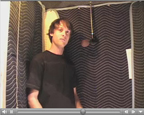
Halsey Burgund @ P.S.1
It's like a directed Speaker's Corner run by Le Tigre...only as interesting as the participants AND editor - PJ
WHEN: Sunday, September 17th, 12–6 PM :: WHERE: P.S.1 Contemporary Art Center, 22-25 Jackson Ave, Long Island City, NY :: Musician, Halsey Burgund, will bring his portable recording booth to P.S.1 Contemporary Art Center on September 17th as part of his Bring Your Own Voice Museum Tour. The tour will take Burgund to a number of art museums in the northeast where he will ask interested participants to voice their opinions about art and museums while being recorded. He will then use these recordings as raw material for original music.
Burgund is specifically targeting art museums on this tour because he wants to explore questions about art and museums and their respective roles in individual’s lives as well as in our current society. He will pose questions to participants that are designed to elicit honest responses about why they are at the museum currently, what they think about specific pieces at P.S.1, and what our society would be like without art and institutions to promote the arts.
Upon completion of the tour, Burgund will take the diverse set of thoughts and opinions he gathers in New York, and - along with collections from other museums - will compose original music representing a collective, yet highly personal, view of art and museums today. The notion of creating music out of everyday expressions not normally considered musical is the cornerstone of Burgund’s approach to composition. He is interested in the spoken voice not only as a kind of instrument (the tonalities, rhythms, unintended melodies etc), but also as a method of communicating personal experiences and opinions.
News via: PS1.org
[Posted by Paddy Johnson on reBlog]
Posted by jo at 09:09 AM
| Comments (0)

Picturing Free Knowledge
Picturing Free Knowledge :: Friday, 15 and Saturday, 16 September, 20:30, at TESLA Medien>Kunst
Image economies take place between Big Business and Creative Commons licences: The Brasilian agency Radiobrás started publishing its news and multimedia broadcasts under CC licences just this summer. During Robbie Williams' recent tour in Germany photographers were not permitted to take pictures of the pop star. A Berlin newspaper reacted by publishing mobile phone pictures taken by their reporter -- the resolution was accordingly low. If one compares the search results in Google Images with the results from databases like Corbis and Getty Images, one has to find out that the pay services clearly
offer higher quality.
Starting from the debate on copyrights, the videos in the programme ask for the power relations in image production and distribution. Which pictures dominate the discourse of the media? How can images be created and distributed outside copyright obligations? What does the enormous and enthusiastic image production in online video communities such as YouTube mean?
The programme presents artistic strategies by which power relations and media image policies represented in images are reflected: The correspondence with the footage-department of a company selling royalty-free film and video clips for commercial purpose reveals their guidelines allowing nothing but hegemonic and stereotypical images. For a moment the logic behind the circulation of capitalist value becomes visible. In other cases, works demand a freer way of dealing with images, for example when public domain footage from film archives is rearranged and published under a Creative Commons licence.
Picturing Free Knowledge I: Image Banks
Friday, 15 September, 20:30
Videos by Johanna Billing, Nina Fischer / Maroan el Sani, Nate Harrison, Marysia Lewandowska / Neil Cummings, Sean Snyder, VitoriaMario, Florian Zeyfang and others
The first programme entitled 'Image Banks' takes existing images as its starting point: Images and their sources are reflected in different contexts, for example, the homogenous aethetics of news images or the categories of commercial image databases are called into question.
Later in the evening, Ricardo Ruiz and Tatiana Wells, currently residents at TESLA, will play a music programme and live stream mix from Brasilian radio stations.
22:00 Klub: rádio cidadão comum: net batucada brasileira on free and pirated music
Picturing Free Knowledge II: Image Agents
Saturday, 16 September, 20:30
Videos by Anna La Chocha, Anja Kirschner, Dariusz Kowalski, TV-TV, Tobias Werkner and others
'Image Agents' compiles video works that make productive use of found footage or pursue new concepts for media knowledge production. The programme is about the appropriation of visual technologies, formats and styles.
Following this logic, Serhat Köksal stirs up mass culture: orientalism, pop, politics and folklore collide in the works of DJ Hugo Chavez & VJ Ahmadinejad.
22:00 Klub: 'MyTube & YourSpace' by DJ Hugo Chavez & VJ Ahmadinejad
tesla berlin - andreas broeckmann - artistic co-director klosterstr. 68-70 - d-10179 berlin - tel. +49-30-24749-761 ab@transmediale.de - http://www.tesla-berlin.de
Posted by jo at 10:01 AM | Comments (0)
September 11, 2006
Snow


Take two sheets of paper
Make Two paper airplanes
Throw them in the street
*Make certain that many people do this at the same time. [posted by alex on IT IN place]
Posted by jo at 06:54 PM | Comments (0)
Google Will Eat Itself - No. 5

202.345.126 Years until GWEI fully owns Google
Dear GWEI Subscribers,
The current stats: Google Shares owned by GWEI: 123 Amount of USD: 47.276,28 Adsense-Clicks: 126.336 Adsense-Page Impressions: 5.448.926 Adsense-CTR: 2,31% Counter: 202.345.126 Years until GWEI fully owns Google Current Google Share Price: 384.36 USD, Symbol: "GOOG".
Google's Legal Department has contacted us with a very nice and open letter signed by Dr. Arnd Haller, Legal Rep. He stated that Google thinks we are doing great work but somehow something illegal, that they are fully aware that this is an art piece but still we should kindly stop with our assumed illegal activity.
Letter in German.
Our next exhibition will be at the ICC NTT Museum, Tokyo (JP). The "Connecting Worlds" Exhibition curated by Yukiko Shikata, with artists such as Peter Fischli and David Weiss, Dennis Oppenheim, Ambient.tv, Wayne Clements. We will show a digital Slideshow next to a terminal with the web-site:
http://www.gwei.org/pages/exhibitions/slideshow_ICC_tokyo
Media Coverage was very good during the last months, GWEI was featured in BBC World (Radio), Kulturzeit (3Sat TV), Telepolis, Artforum News
and in a lengthy article in Spiegel Online (Deutsch): and "die Presse" (Deutsch) and Sueddeutsche Zeitung (SZ) (Deutsch) and Heise Online, attacking our future project called Amazon Noir.
Additionally, on July 12, 2006 we have frozen a copy of GWEI and added it to the Rhizome Artbase for conservation. And.. we will present GWEI on October 24th at the New Museum New York for the Rhizome 10 years anniversary.
best regards and lovely hugs from the team
UBERMORGEN.COM feat. Alessandro Ludovico vs. Paolo Cirio
Hans Bernhard
UBERMORGEN.COM / etoy.holding
Skype Hans_Bernhard
Studio +43 1 236 19 85
Mobile +43 650 930 00 61
Email hans[at]ubermorgen.com
http://www.ubermorgen.com
Posted by jo at 06:30 PM | Comments (0)
A Certain Brazilianness

Maurits Script
Maurits Script, the third part of her ongoing project A Certain Brazilianness by Wendelien van Oldenborgh :: 23 September – 29 October 2006 at Casco.
In the attempt to find an alternative mode of production, ‘A Certain Brazilianness’ became the title of a multidisciplinary process, based on relations and resonances. From a heterogeneous Brazilian culture a number of significant strategies, partly stemming from the social sphere, have led to impressive moments of cultural production. As a way of working, A C_B__ transfers these possibilities into the production of film, drawing on the basic language and roles in a film production to set up situations that lead to new relations. Two performative stages have taken place so far. In these active encounters the participants were performers as well as viewers and listeners, creating the script and cinematic material during the event.
The third part will be based on a script compiled of excerpts from different sources relating to Johan Maurits van Nassau’s period as governor of the North East of Brazil (1637 - 1644), for which he has often been credited as being an early modernist ruler. Maurits Script focuses on the paradoxes and inner conflicts produced within the art of governing, the institutions of the period, and personal relations at a moment when many different groups found themselves living together with clashing interests. It will be staged and filmed at a live event in the Golden Room of the Mauritshuis, den Haag (built by Maurits during his period of government in Brazil), where a group of participants, each of whom have differing relations to the contents of the script, will perform it and discusses its contents in relation to the present day.
Wendelien van Oldenborgh is based in Rotterdam. Recent projects include "A C_B__ Sound Track Stage" for “Cut For Purpose”, Museum Boijmans Van Beuningen, Rotterdam 2006, ”The Basis For A Song” for “Be What You Want But Stay Where You Are” (by Ruth Noack and Roger M. Buergel), Witte de With, Rotterdam, 2005.
14 September : Public film shoot: Mauritshuis, den Haag, 1-4pm
Korte Vijverberg 8, NL 2513 AB Den Haag
The film shoot is open to the public, but the Mauritshuis' standard entrance fee applies to all visitors.
Friday 22 September: Opening of exhibition at Casco, 6-9pm
Sunday 22 October: Discussion and screening of final edit of the film, 5-8pm
Maurits Script is supported by Fonds BKVB, Amsterdam, Gemeente Utrecht and the Mondriaan Stichting.
Casco
Office for Art, Design and Theory
Oudegracht 366
Utrecht 3511PP
T/F: +31 (0)30 231 9995
info[at]cascoprojects.org
Posted by jo at 06:24 PM | Comments (0)
ARUP Advanced Geometry Unit

h-edge
ARUP Advanced Geometry Unit: h-edge :: September 14 to October 28, 2006 :: Opening Reception: September 14, 6-8PM.
This fall, Artists Space presents h-edge, a new project created by Cecil Balmond and ARUP Advanced Geometry Unit, a think tank dedicated to researching complex structural geometry in support of new architectural visions and solutions. AGU’s installation at Artists Space will function as an enclosure within the gallery, allowing visitors the opportunity to experience, interact with, and compartmentalize physical space in new and exciting ways. h-edge is an experiment in the use of geometry and matter to create organizations of space. h-edge traverses the boundaries of mathematics, art, architecture and engineering, exploring new opportunities of complexity.
The project exists on three levels: the mathematical-geometric, the architectural-spatial and the structural-tectonic. h-edge is based on a cubic fractal tiling of space known as the Menger Sponge. The geometric matrix of this sponge is modular and self-similar offering positive and negative space at embedded scales. This binary tiling is deployed at three different scales, which create spatial conditions that relate to the scale of the human body. These are named cave, trench, and path.
Tectonically, the tiling is achieved through the use of two modular units: the leaf and the chain-link, which interlock to form a suspended network of reciprocal load-paths. The staggering of the plates along the chain in four directions ensures that no plate touches another and that the chain is pre-stressed to form a rigid load-path. h-edge and the Fourier Carpet are binary systems describable as ordered series of 0 and 1 digits in three- and two-dimensional mathematical space. They both demonstrate how number systems can be used to describe, control and inform geometric complexity.
h-edge has been designed by the ARUP Advanced Geometry Unit in London, and constructed in Philadelphia with the help of Penn Design students. It consists of 5200 laser-cut aluminum plates and almost 5000ft of stainless steel chain. The Fourier Carpet has been digitally generated and designed by Jenny E. Sabin in Philadelphia and woven on a digitized Jacquard Loom by Keystone Weaving in Lebanon, Pennsylvania. It is 36ft by 5ft and is composed of interlaced black and white wool threads.
Design Team: Cecil Balmond, Charles Walker, Francis Archer, Daniel Bosia, Jenny E. Sabin
Assembly Team: Jenny E. Sabin and PennDesign Students
Curated by Christian Rattemeyer
h-edge is supported, in part, by ARUP, the Graham Foundation for Advanced Studies in the Fine Arts, Elise Jaffe + Jeffrey Brown, and PennDesign.
ARTISTS SPACE
38 Greene Street, 3rd Floor
New York, NY 10013
T 212 226 3970
F 212 966 1434
artspace[at]artistsspace.org
http://www.artistsspace.org
Posted by jo at 04:12 PM | Comments (0)
Sarai READER 06:

TURBULENCE
Sarai READER 06: TURBULENCE :: Editors for Reader 06: Monica Narula, Shuddhabrata Sengupta, Jeebesh Bagchi, Ravi Sundaram, Awadhendra Sharan + Geert Lovink ::
'TURBULENCE' (from the introduction): If there was ever to be a 'weather report' for our times, an audit of the climate in which we have grown accustomed to live, it would use the word 'turbulence' often. Turbulence is a practice for and of a time that has no name. This book, embodying that practice, is an eclectic index of an uncertain age.The Sarai Reader 6 uses 'Turbulence' as a conceptual vantage point to interrogate all that is in the throes of terminal crisis, and to invoke all that is as yet unborn. It seeks to examine 'turbulence' as a global phenomenon, unbounded by the arbitrary lines that denote national and state boundaries in a 'political' map of the world. Sarai Reader 6 surveys areas of low and high pressure in politics, economy and culture that transcend borders, investigates the flow of information and processes between downstream and upstream sites in societies and cultures globally, witnesses surges and waves in ideas and practices in contemporary art, culture and discourse as they crash against the shorelines of many dispersed locations.
How do we anticipate, recover from and remember moments of sudden transformation? How do we look at the debris of the past and brace ourselves for the whirlwind coming our way from the future? How do we deal with the simultaneous pressures of knowing too much or the anxiety of knowing too little about the world? How do we cope intellectually with the sudden dissolution of established ways of knowing and doing things? What does it mean to know and experience the pull of undercurrents - in society, politics, the economy? How do cities deal with the accumulation of complex infrastructural uncertainty? What happens when urban chaos strikes back at urban planning?How can we map the subterranean tectonic shifts and displacements that occur in culture and intellectual life? What are the histories of anxiety, exhilaration, dread, panic, ecstasy, disorientation and boredom like. How can we begin to narrate these histories? What does it take from us to tell stories, read poetry, make images and record experiences in the wake of turbulence?
Sarai Reader Series Editorial Collective: Monica Narula, Shuddhabrata Sengupta, Ravi Sundaram, Ravi S. Vasudevan, Awadhendra Sharan, Jeebesh Bagchi + Geert Lovink :: Sarai Reader 06: Turbulence is part of the Documenta 12 Magazines Projectí :: Published by the Sarai Programme, Centre for the Study of Developing Societies, Delhi, 2006 [cc] Produced and Designed at the Sarai Media Lab, Delhi :: ISBN 81-901429-7-6, 608 pages, 14.5cm X 21cm, Paperback: Rs. 350, US $ 20, € 20
Posted by jo at 03:57 PM | Comments (0)
Denis Connolly and Anne Cleary

Here There Now Then
Limerick City Gallery of Art presents Here There Now Then by Denis Connolly and Anne Cleary :: 15th September – 27th October 2006 :: The exhibition will be officially opened by Mr Peter Power TD the exhibition at 7pm on Friday 15th September 2006.
Denis Connolly and Anne Cleary, installation and video artists, have lived and worked in Paris since 1990. Their work, which is highly regarded internationally, has appeared in such prestigious events as the Yokohama Triennial and the European Media Art Festival. This entirely new body of work, commissioned by LCGA with support from the Arts Council, uses interactive technology to explore a recurring issue in Cleary & Connolly’s work – the shifting boundary between art and life. The exhibition, comprising six video installations, uses 5 computers, 5 digital video cameras, and seven video projectors to create an exhibition where the spectator becomes actor, the gallery becomes theatre and the artist becomes spectator.
Collaboration has always been central to Connolly and Cleary’s work, and no less here. One of the works in the exhibition was created with Eriko Momotani who will be present at the opening to recreate one of her improvised soirées musicales, while at later date, October 14th at 3pm, the artists will be working with London based dancers John Hurley and Laura Murphy to create an interactive dance performance, made possible by Chris Hurley of the Cork Film Centre and Daghdha Dance Company, Limerick.
Here There Now Then an interactive exhibition conceived for the Limerick City Gallery of Art With the support of the Arts Council of Ireland, The Cork Film Centre, Daghdha Dance Company, Special thanks to Kinsale Arts Week And with the participation of Eriko Momotani, Laura Murphy and John Hurley.
Eriko Momotani, Japanese artist and curator, has lived in Paris since 1990, where she is a well-known figure in the Parisian art world. Renowned for her Micro-Expositions, Eriko questions the notion of public and private by curating exhibitions in her own apartment, thus turning her living place into a public space. This original and personal approach brought her to the attention of the Ville de Paris, who support her work highly, and the Yokohama Triennial, who commissioned three exhibitions from Eriko in 2005, one of which was Cleary and Connolly’s Yokohama Houseguests.
John Hurley trained at the London Contemporary Dance School. He currently works as a freelance dancer with established international choreographers and dance companies in London and throughout Ireland. Laura Murphy achieved an MA Honour in Dance Performance from the Irish World Music Centre in 2003, she is currently supported by the Arts Council of Ireland to train at Laban, London's leading Contemporary Dance Conservatoire. Limerick City Gallery of Art Pery Square, Limerick Ireland + 353 61 310633
Posted by jo at 03:48 PM | Comments (0)
LAb[au] + Frederik De Wilde

EOD02 + 12m4s
LAb[au] is pleased to invite you to the designers week exhibition presenting two installations: EOD02, a new-media installation in collaboration with Frederik De Wilde and 12m4s, an interactive audiovisual installation taking place at the auction-hall of the Palace of Fine Arts ( ...> ) in Brussels [ BE ] in the context of the exhibition Belgian designers of the 21st century, complied by Dirk Meylaerts and Marie Pok.
The exhibition includes works by: Alain Berteau, Bram Boo, Christophe Bourg, Damien Bihr, Benot Deneufbourg, Nathalie Dewez, Herman Wittockx, Hoet design, Dirk Meylaerts, Gauthier Poulain, Lucile Souflet, Sylvain Willenz , Tov Design, LAb[au] and [UR]Design.
12m4s :: The installation '12m4s' is an interactive audiovisual installation representing human flows by generating out of visitors' main parameters (position, orientation and speed) a visual (3d particles) and sonic (granular synthesis) dynamic scape in real-time. To achieve this result, the installation uses two different tracking techniques: firstly, image recognition is used to create spatial sounds (diffused through 8 speakers disposed along the 12m installation) and secondly, ultra-sound sensors are used to create visual echograms of the space (projected as background image along the 12m screen). These different tracked data influence a graphical vector-field
projected on the entire surface of the screen (foreground), where each of its vectors reacts to a visitor's movements while taking his/her orientation. Furthermore, graphical and sonic objects emerge at the point (location) where movement is recognized. Once created, these sonic and graphical elements start to move through the vector field, while trying to find their path.
For example: a visitor is passing by the installation, s/he is followed by a visual and sonic trace, but as soon as s/he changes direction or produces any other movements, s/he creates turbulences. According to this principle, the visitor can even more actively paint with his/her movements a sonic and visual space on the 12m surface, as it open ups to collective interaction.
The result, this 'particle synthesis' is projected on a 'Mylar' screen fusing projection and reflection while building a common space in between the digital and the body space.
EOD02 :: EOD 02 is a collaboration in between Frederik De Wilde and LAb[au]. The project is a new media installation founded on special species of fish that perceive, electro-sense, their environment and communicate with each other by emitting electric signals, either in pulses or waves. The project explores the normal communication mechanisms of electrical fish, including JAR (the means by which a fish avoids attempts by other fish to jam its frequency) and thus investigates communication and non-communication between individual fish as well as between fish and people.
The installation is based on four aquariums of taintless mirror, each presenting a specific composition of fish producing different electric signals. In each aquarium antennas allows capturing the fish signals which are directly related to four speakers transforming these signals into sound, what we hear is the fishs electric signals_ their communications. Further under each aquarium a light bulb is placed pulsing according to the intensity, rhythm, of the emitted signals of the blind fishes. In this manner the electrical impulses of the fishes drive sound and light, an entire audiovisual space.
Posted by jo at 03:43 PM | Comments (0)
Year Zero One

TERMINAL01: CALL FOR SUBMISSIONS
Year Zero One is seeking submissions for Terminal01 (T01), an interactive networked art exhibition to be launched at Toronto Pearson International Airport in the spring of 2007. T01 will consist of a custom made kiosk housing a touch-sensitive screen, an audio-video output, an embedded web camera, sensors and projection screen. Artists are invited to create site-responsive computer generated work based on their experience and interpretation of air travel environs, mobility, flight data, airports and networked communities. Emphasis will be given to works with a generative component or works dealing directly with themes relevant to travel (space-time). Deadline for submissions is December 1st, 2006. Artist fees paid. T01 is curated by Michael Alstad and David Jhave Johnston. For more info and online entry form please visit: http://www.year01.com/terminal01/submit.html
Posted by jo at 03:40 PM | Comments (0)
IRATIONAL ACTION WEEKEND

DIY - Do it yourself
IRATIONAL ACTION WEEKEND :: September 15-17, 2006 in Dortmund, Germany, various venues :: DIY - Do it yourself - is the central theme of the irational Action Weekend and you are cordially invited to participate!
On Friday night, Sep 15, Daniel G. Andújar (Valencia) invites you to present the Open Source software you like most, and to share it with others. This will be accompanied by an open bbq - please bring your own grill-food and drinks! During the "Tour de Fence" by Kayle Brandon and Heath Bunting (Bristol) on Saturday one can learn how to climb walls and fences and thus hack urban space. This scope is also addressed by the "International Tree Climbing Day" taking place on Sunday which will also be lead by Brandon and Bunting. Its motto is “Liberate the Horizontal! - Integrate the Vertical Super Surface!" “Natural Reality Superweed" gets planted in an appropriate Superweed Garden in front of the PHOENIX Halle. The genetically mutated superweed is resistant against Monsanto's roundup herbicides. Rachel Baker presents “Towards Death", a creative aerobic video with Cindy Crawford and music by Antifamily. The Mexico-based Mejor Vida Corporation issues Student ID cards on request which anybody can apply for in the exhibition "The Wonderful World of irational.org". On Sunday, the Mexican artist Minerva Cuevas (Mexico City) presents the actions by Mejor Vida Corporation in a lecture.
The program will be accompanied by guided tours (in German) through the exhibition “The Wonderful World of irrational.org" at PHOENIX Halle and a fabulous 10-years HMKV birthday party with the Irational Soundsystem (Valencia, Bristol, London, Mexico City), the HMKV Soundsystem (Dortmund) and Dortmund-based DJ Carstem Helmich (taxi nights).
curated by: Francis Hunger (HMKV Junior Kurator)
EXHIBITION: The Wonderful World of irational.org - Tools, Techniques and Events 1996 - 2006 curated by Inke Arns and Jacob Lillemose August 30 - October 29, 2006 Wed 11:00-17:00, Thu-Sun 11:00-20:00.
Posted by jo at 03:28 PM | Comments (0)
Conference on Literature and the New Media

Remediating Literature
An international conference on Literature and the new media entitled Re-mediating Literature will take place at Utrecht University (the Netherlands) 4-6 july 2007, with keynote speakers Katherine Hayles, Marie-Laure Ryan, Jan Baetens, and Samuel Weber. Our website features all relevant information concerning the conferencem including the call for papers (deadline is November 6, 2006).
The conference revolves around the following issues: Recent developments in digital and electronic media have stimulated new theoretical reflections on the nature of media as such and on the way in which they evolve across time. The particular aim of this conference is to examine how recent technological changes have affected the ‘old’ medium of literature.
Multimedial and interactive texts, digitalized archives, cyberpoetics, and technological innovations such as foldable screens: together these have influenced the production and reception of literature, along with the ways in which we think about writing and reading. These ongoing developments call for a critical examination both of the relations between literature and the new media, and of the relations between literary studies and media studies.
The concept of ‘remediation’ in our title thus has a double thrust. Firstly, it refers to the transformative exchanges that have occurred in the past, and continue to occur, between literature and new media: how has digitilization affected literature as a cultural medium? Secondly, it indicates a relocation of literary studies within the broader field of (new) media studies: how could literary studies profit from the various analytical tools developed in (new) media studies and conversely, how could our understanding of earlier phases in the evolution of the literary medium contribute to our understanding of present developments? By working on both these issues, we hope to locate the place of literature within the milieu of modern media networks and technologies, but also to relocate the aims and practices of literary studies within the field of (new) media studies.
Main themes
A. New technologies and literary practice: the state of the field: Will literature continue to develop as a schizophrenic medium, a hard medium of printed matter and an unstable medium of electronic data at the same time, or will it fork out in one of two directions? How is digitilisation affecting reading practices and the circulation of literary texts? What new forms of ‘inter-medial’ and multimedial literature are emerging?
B. Literature and the new media: the longer view: What new light do recent developments throw on the history of literature as a cultural medium and, conversely, how might insights from the history of the literary medium contribute to our understanding of recent developments? How can literary history be rewritten in conjunction with such media technologies?
C. Media compatibilities and competitions: new media hardly ever completely subject and annihilate older media. Rather, the two tend to co-exist, each taking on different tasks and responsibilities (cf. film and the novel in the earlier twentieth century). At the same time, however, they often interrupt and compete with each other (cf. television and the digital in the later twentieth century). How can this duplicity of compatibility and competition be mapped and analyzed, and what are the insights that such analyses might yield into media formations as techno-cultural formations?
D. Disciplinary relocations: will literary studies become a branch of media studies in the foreseeable future - and if so, how? Will literary studies profit from such a re-location, and how will this re-location affect its objects and methodologies?
Abstract submissions:
-Topics:
*Changing conceptions and manifestations of the text from print to the digital age;
*Cyberpoetics and the hypertextual in digitalized and printed form;
*Remediation as a cultural process: how have different media reworked and incorporated each other, and how can such reworkings be theorized in terms of cultural memory and media archeology? This could, for instance, focus on the representation of new media in literature (cf. James Joyce, William Gibson), and the way in which these representations have in turn been stored in the practices of such new media;
*Copy-cats and mutations: how have textual, visual, aural, digital, and performative media functioned alongside each other, how have they co-existed? Which tasks and aspects do old media delegate to new media, or which tasks and aspects do new media copy form old media, and how has this changed the status and identity of the old medium?
*Old narratives, new games: narrative and narrative transformations across media;
*Technological inventions and their effects on the object of literary studies: the impact of new mediations of the literary through foldable screens and other flexible, wearable, handheld paper displays, as well as mobile acoustic networks;
*Institutional remediations I: web publishing, accessibility and canonization of hyperfiction, funding of literary projects on the internet, the emergence of new forms and practices of literary criticism on the internet, as well as the institutional development of new strategies and conventions in editing techniques;
*Institutional remediations II: literary studies from cultural to media studies: will we witness, in the foreseeable future, a ‘post-human’ paradigm shift in the humanities that redirects our focus from cultural studies to media studies?
-Submission guidelines:
Abstracts may be submitted through the following mailing address, indicating the applicant’s name, email address and present academic function:
remediatingliterature[at]let.uu.nl
*Abstracts should be no longer than 250 words, should summarize the topic of the paper, and must be written in English;
*Abstracts should conform to one or more of the conference topics;
*Abstracts will be selected by the Program Committee on the basis of originality, significance of contribution, and relevance to the conference topics;
*Abstracts can be submitted until November 6, 2006
*Authors will be notified of acceptance or rejection by e-mail by December 22, 2006
Posted by jo at 02:55 PM | Comments (0)
REMOTE

You Bring the Secret Location to Life
REMOTE--by Chris Vecchio :: 9 September – 21 October 2006* :: Gallery Joe Bird Park
3rd and Arch Streets :: Philadelphia, PA :: * viewable 24-7 * best experienced at night * (but no sound after 10PM) :: INSTRUCTIONS: 1) Get up off of the couch 2) (but bring the remote control with you) 3) Go to the south west corner of 3rd and Arch 4) Use your remote to activate the park.
REMOTE is an interactive environmental installation containing a range of sound and visual effects. Installed in an outdoor space, the installation is activated, controlled, and navigated using a common household remote control which may be supplied by the viewer. The piece takes the form of an intervention in an outdoor space, along a street or in a small park. There’s an “insider” element to the installation since, when not activated, its location may not be immediately apparent to a passerby. Additionally, the viewer needs to know to bring a remote to the location to bring the secret to life.
At the installation site, pressing buttons on any (TV, DVD, VCR, audio, etc…) remote control triggers a myriad of responses ranging from subtle (bird calls or soft sounds emanating from hidden speakers, changes in the ambient lighting) to bombastic (more dramatic sound effects, explosions, strobe lights, or projected images). Each key press generates a unique combination of effects. Viewers may bring any remote control from home to activate the installation.
Central to my work is an interest in the expressive potential of electronic devices and in the potential for user interfaces to generate new modes of interaction. A set of social precedents now exists for interaction with electrical technology. When these precedents are followed but subverted or there is no clear immediate “functional” objective, a viewer’s expectations are challenged and an opportunity for reflection or commentary on the human-technology relationship is created. This project makes use of such ambiguity – juxtaposing the familiar with the unexpected – to encourage people to question their assumptions about technology and reflect upon their interaction with it.
The piece has a strong element of accessibility. People who may be intimidated by interactive work or by technology in general may be engaged because an everyday object is the agent of action. The experience of the installation is reminiscent of a coin-op arcade shooting gallery. Play and experimentation are encouraged as part of the experience. Participants can keep trying different units from their everyday collection because each remote interacts differently with the piece. This highlights the number and variety of remotes we use for everyday tasks, from the mundane to the complex.
Sound samples in this installation have been gathered from a wide range of sources including sound effect libraries, police scanners, popular music, short wave and CB radio, and by using peer-to-peer networks to search the internet for randomly (inadvertently?) shared audio files. The broad range of sources references the instrumental use of sound samples in music as well as common (mundane) technological interactions such as channel surfing or tuning across a radio band.
Finally, the installation presents the man-technology interface ironically. The couch potato is asked to get off of the sofa and experience art first hand, but still holding the ever-present remote. Issues related to the effects of technological mediation and the degree to which technology is an atrophying rather than an empowering force are raised.
Posted by jo at 01:38 PM | Comments (0)
They Heart a Computer

Rhizome @ The Kitchen
They Heart a Computer :: Tuesday, October 3, 8:00 p.m. @ The Kitchen :: Tickets $8 :: Curated by Lauren Cornell as part of Rhizome’s Tenth Anniversary Festival, this evening of live performances and video screenings explores forms of expression, desire, and anxiety prevalent in a culture increasingly influenced by the Internet. Doo Man Group (made up of Ben Jones, Jessica Ciocci, and Jacob Ciocci of Paper Rad) interweaves live percussion with a dense collage of web-based visual ephemera. Jona Bechtolt (of Yacht) and Claire L. Evans combine music, dance, and PowerPoint to explore the possibilities and fallacies embedded in online communities. In addition, videos by Michael Bell-Smith, JODI, Shana Moulton, Takeshi Murata, and humorist Ze Frank investigate how the Internet amplifies and exaggerates life offline.
512 West 19th Street between 10th and 11th Avenues. Subway: A, C, E to 14th Street; 1 to 18th Street; L to 8th Avenue
Posted by jo at 08:06 AM | Comments (0)
UpStage

ADA Swaray
There will be an ADA Swaray in UpStage this sunday, 10th September,
at 9:00 p.m. New Zealand time. For other local times, check http://www.worldtimeserver.com/
ADA is Aotearoa Digital Arts, a network of digital artists in New Zealand. The swaray is a social forum for us to meet & discuss things. This sunday, a number of NZ artists who attended the recent ISEA in san jose will be reporting back on their experiences.
if you'd like to join us as audience, please come to
http://upstage.org.nz:8084/stages/swaray.
helen varley jamieson: creative catalyst helen[at]creative-catalyst.com http://www.creative-catalyst.com http://www.avatarbodycollision.org
http://www.writerfind.com/hjamieson.htm
Posted by jo at 08:04 AM | Comments (0)
September 08, 2006
Turbulence Guest Curators: Ars Virtua

honesty is our policy
Turbulence Guest Curators: Ars Virtua :: Opening Here Tonight! September 8, 7-9 pm SLT (Pacific Time).
A few months ago, we invited Ars Virtua--a new media center and gallery located entirely in the synthetic world of Second Life--to curate an exhibition of Turbulence works for Turbulence.org. James Morgan, Amy Wilson and Jay Van Buren rummaged through our ten-year old archive and produced honesty is our policy with works by Cory Arcangel (Urbandale), Nicolas Clauss (Heritage), and David Crawford (Stop Motion Studies).
"…Honesty may seem like a hokey notion in "real-life," but in an environment like Second Life, honesty is all you have. Absent social cues, history, nature, all one has to go on is the trust in another that this is how they view reality, and to interact with anyone on a meaningful level, that version of reality must be accepted.” – Amy Wilson
"Ars Virtua" is a new type of space that leverages the tension between 3D rendered game space and terrestrial reality, between simulated and simulation. It brings the art audience into “new media” rather than new media to the museum or gallery, and calls upon its audience to interact with the art and one another via their avatars within the space. To visit Ars Virtua simply create a free account in Second Life and run the current client. Once you have this properly installed follow this link – secondlife://Dowden/20/40 – directly to Ars Virtua.
BIOGRAPHIES
JAMES MORGAN has shown work internationally and has recently produced a commission for ISEA2006/ZeroOne.
AMY WILSON is an artist represented by Bellwether in New York City. She has shown her work at numerous places, including PS1, The Drawing Center, and The Andy Warhol Museum, and has been reviewed in Art in America, The New York Times, the Village Voice, and Time Out NY among others. She teaches art history and drawing at the School of Visual Arts.
JAY VAN BUREN is an artist and web designer based in Brooklyn New York. He has curated and worked in design under the name early-adopter.com for the past 7 years. He was the founder and co-director of Videoland Gallery in Manhattan's lower east side and has exhibited paintings in New York, Kansas City and Washington DC.
For more Turbulence Guest Curators, visit http://turbulence.org/curators.
Posted by jo at 07:36 PM | Comments (0)
DANCEPOD 2006

A Sculpture Composed of Simultaneous, Web-Connected Dance Parties
DANCEPOD 2006: On September 9th at 11pm in Portland, 12 am in Guadalajara, 2am in New York City, 3am in Mexico City and 7am in Berlin, dancepod will present an entirely new kind of sculpture. A sculpture composed of simultaneous, web-connected dance parties. The parties, coordinated and developed in conjunction with artists and presenters from each city, will utilize identical dancepod installations. The installations will become the core of a shared physical and virtual experience, supporting streaming video and music as well as live DJ’s, VJ’s, and surprising guest artists. Moving bodies of dancing participants will complete the sculpture.
As part of the Portland Institute of Contemporary Art's (PICA) Time-Based Art (TBA) Festival, in conjunction with PS122, Scene Downtown (Earl Dax), Harkness A/V (Nick Hallett), and technical directors Kraft + Purver, these 4 DANCEPOD sites will be linked by live video starting at 2:00 AM Eastern Standard Time.
NYC DANCEPOD features an eclectic array of New York artists. Join DJs Kevin Graves (Brite Bar) and Van Scott (Patricia Field's Party at element) and dance to visuals artists assembled by Nick Hallett and Harkness A/V, including Chika and Boris. Live performances by John Moran and Saori Tsukada, Sxip Shirey, and Glenn Marla.
Chez Bushwick will be hosting "The Changing of the Garde" starting at 8:00 PM on Saturday. Come early for DANCEPOD and enjoy performances by:
Wanjiru Kamuyu – Spiral
Jim Staley – Solo Trombone
Bruce Nauman - “Abstracting A Shoe (1966)” – Video Art
David Vaughan, Michael Cole, Jonah Bokaer – A John Cage Birthday Reading
Elke Rindfleisch - Untitled
Also... TECHNOPIA Interviews Carla Peterson, Newly-Appointed Artistic Director of DTW.
All this for $5. Come to both the Chez Bushwick and DANCEPOD events for just $10! That's like seeing the early show for FREE! (Regular DANCEPOD admission is $10).
Hosted By
3rd Ward Brooklyn
195 Morgan Ave.
Bushwick, Brooklyn, NY 11206
718.715.4961
www.3rdwardbrooklyn.org
Posted by jo at 05:46 PM | Comments (0)
Tag Shufflesition:

A Mobile Game of Mimicry and Mime
Tag Shufflesition: a mobile game of movement, mimicry and mime, that uses iPod Shuffles to see how fast can you find out who’s “it”! :: Designed by Charlie Hoyt and Andrew Bucksbarg, Indiana University Bloomington (2006) :: Central Park, New York :: Saturday, September 23, 2006 at 3:00PM.
Christo may have turned Central Park into a work of art, but Andrew Bucksbarg and Charlie Hoyt are part of a group of game designers who will be transforming New York into an enormous game level. Mobile and locative technologies have given rise to an international flowering of what are called urban games, street games or Big Games. These games explore new technologies and make the real world and urban spaces their playground. Tag Shufflesition will be featured in New York’s Come Out & Play Festival
From massive multi-player walk-in events, scavenger hunts to public play performances; the festival will give players and the public the chance to take part in a variety of different games. The festival will feature the innovative use of public space and games that make people interact in new ways, such as Tag Shufflesition.
Tag Shufflesition is a mobile system for movement and dance using the random playback feature of mobile mp3 players, such as Apple’s iPod Shuffle. The “Shufflers” (participants) receive random instructions from their iPods as to how to move and interact with the other Shufflers. One iPod is loaded with a slightly different set of instructions. The task of the Shufflers to find out which Shuffler among them is “it”- the one with the different instruction, and begin to mimic all of the “it” Shuffler’s movements. The game is complete when all of the Shufflers are correctly mimicking the “it” Shuffler.
Tag Shufflesition is engaging for both spectators and participants as an interactive game of patterns movement and mimicry. Shufflers will enjoy following the directions, which often exist as small games within the larger game of Tag Shufflesition. Spectators, without the distractions the Shufflers face, will also enjoy trying to guess who’s “it,” but please don’t give “it” away!
Charlie Hoyt is an Audio Instigator. When he’s not staring at a mixing board or making “music”, Charlie enjoys video games, rock ‘n roll, and name-dropping. Charlie is pursuing a Masters in Immersive Mediated Environments at Indiana University in Bloomington, Indiana, studying audio and music for participatory media. Charlie’s previous artistic fracases include “ToneBeast”, which received honorable mention at the 2004 Indiana IDEAS Fest and “MESS”, which received nothing, but is nevertheless fun. Email: audioinstigator(at)yahoo(dot)com
Andrew Bucksbarg is a techno-media artist, experimental interaction designer, audio-visual performer and a professor in the Department of Telecommunications at Indiana University. Bucksbarg’s work and interests reverberate in the space of creative new media practices, technology and theory. As an experimental interaction artist, Bucksbarg concerns himself with technologies and social systems that support tactics of ambiguous, autonomous social creativity and exchange. Bucksbarg’s work appears physically and digitally around the globe, including the Rhizome.org Artbase; Share DJ, NY; The 2006 Bent Festival, NY; National Museum of Australia, Canberra, Australia; Sonorities Festival, Belfast, UK; The Dark light Film Festival, Dublin, Ireland; Trampoline Media Festival, Nottingham, UK and dLux Media Arts Festival, Sydney, Australia. Email: Andrew(at)adhocarts(dot)org Press: 812-219-5310
Posted by jo at 04:37 PM | Comments (0)
TANGENT_BURN featuring PLATONIQ

Bringing the Net Down to the Streets
TANGENT_BURN featuring PLATONIQ: This evening V2_Institute for the Unstable Media will be hosting a streamed performative presentation by Barcelona based activist art collective PLATONIQ. If you're not able to make it to V2_ in the flesh, and at the same time catch the opening of this year's 'Wereld van Witte de With' Festival, you're invited to join in on the stream beginning at 20.00 (CEST). The PLATONIQ presentation will be augmented by interventions from local Rotterdam sound and visual artists 'onehertexpressions', Zaplab Creative Television and Meticais.
To join the stream, please go to www.v2.nl, follow the link and have your Realmedia player ready! If you don't have the player, you may download one for free at www.real.com.
Afterwards PLATONIQ'S project BURNSTATION to bring net culture, net music and net radio down to the streets will be active throughout the weekend as part of the Wereld van Witte de Festival. Everyone is invited to partcipate in the BURNSTATION, and upload, listen to, edit and to burn their own sound compilations, the whole process being LEGAL AND FREE OF CHARGE.
more info on PLATONIQ and the BURNSTATION on http://www.platoniq.net
TANGENT_BURN Friday September 08
Rotterdam 20.00
Dublin 19.00
Riga 21.00
Montreal 14.00
Seattle 11.00
Kyoto 03.00 (Saturday)
V2_Institute for the Unstable Media
Stephen Kovats_Program Curator
Eendrachtsstraat 10
3012 XL Rotterdam
The Netherlands
t_ **31 10 750 1519
f_ **31 10 206 7271
e_ kovats@v2.nl
www.v2.nl
TANGENT_BURN featuring PLATONIQ
Friday September 08 @ 20.00 (CEST)
RealMedia stream live via www.v2.nl
www.platoniq.net
Posted by jo at 04:14 PM | Comments (0)
Night Swim

Dive into the Deep End
NIGHT SWIM is a cross between a sound and light installation, a music festival and a swimming pool party which will be held from sunset till sunrise at the Trinity Bellwoods Community Centre swimming pool in Toronto on Saturday September 30, 2006. Architect and artist Christie Pearson, co-organizer of the highly successful WADE festivals of performance art in Toronto’s public wading pools, has transformed this much loved downtown public swimming pool into a shimmering, reflective dream-space for one night only. Wire contributor Marcus Boon has invited sound artists, musicians and DJs to produce site specific works and sets in a sound environment designed by sound designer Darren Copeland, which will include underwater microphones and speakers. The event is free and open all night – visitors can swim (bring your bathing suit, towels provided!), lounge in the kiddies’ pool, or hang out in the bleachers and around the pool, soaking up the sound and light. 120 people in the pool at a time maximum – first come, first served!
Sounds: Montreal dirty beats by Ghislain Poirier and colossal drone-scapes by Tim Hecker; loops by Beijing-based creators of the Buddha Machine FM3; heavy ambient sounds by Boston-based Keith Fullerton Whitman a.k.a Hravatski; turntablist-composer Marina Rosenfeld and experimental tribal rhythmist Raz Mesinai from New York; from Toronto, electronic composer and improvisor Sarah Peebles, Sandro Perri/Polmo Polpo’s indie funk, sexy nocturnal grooves with Luis Jacob, baile funk, grime and dancehall from Geoff Snack, a.k.a. DJ Showcase Showdown, and ecstatic sustained tones by Orixasound.
Night Swim
Trinity Bellwoods Community Center swimming pool
Queen West at Crawford,
Toronto
7 p.m. to 7 a.m.
September 30th 2006
Posted by jo at 03:08 PM | Comments (0)
The Art of Networks

Jonah Brucker-Cohen
Next week, Montreal's Oboro Gallery will open Deconstructing Networks, a solo exhibition by the very active American new media artist Jonah Brucker-Cohen. The works included in this show provide an excellent overview of Brucker-Cohen's insightful and witty approach to complex questions about networks, as we stare down the barrel of Web 3.0 and beyond. He vividly illustrates the possible physical applications of network structures and concepts, as with the Alerting Infrastructure project, where hits to a website are manifested in physical 'hits' to a building; in the Crank the Web project, a browser that requires elbow grease to run; and in IPO Madness, a slot machine that also acts as a domain name generator for the IPO of your dreams.
The traces and trails generated by data are explored in SpeakerPhone, an arrangement of speakers that spatialize the data it receives. Any internet user will find insights into issues of anonymity, autonomy, and security in projects such as PoliceState, a group of radio-controlled police cars that react when they detect suspicious keywords on a local network, and WiFiHog, a tool that allows a single user to dominate any wireless hotspot. Visitors can directly and spontaneously contribute to the SimpleTEXT audiovisual performance at 3PM on the 16th, so be sure to bring your mobile phone along, and don't forget a sense of play and an inquisitive state of mind, as the underlying intent of the exhibition is to interrogate our participation and implication in the networks that surround us. - Michelle Kasprzak, Rhizome News.
Posted by jo at 01:58 PM | Comments (0)
September 07, 2006
CADE: Computers in Art and Design Education: Stillness

Call for Papers and Abstract Submissions
First Call for Papers and Abstract Submissions: abstract submission for refereed papers :: Deadline 12 January 2007 :: STILLNESS: 2007 Biennale of Electronic Arts Perth Education Program: International Conference: CADE: Computers in Art and Design Education :: 12 - 14 September 2007, Perth, Western Australia.
The Biennale of Electronic Arts Perth (BEAP) is Australia's pre-eminent festival dedicated to showcasing innovative works of art in the areas of new media, electronic screen, sound and interactive media and is the largest and most visionary electronic arts event in the region. Through a broad program of exhibitions, conferences and public talks, BEAP provides a focus for discussion and exploration of the emergent aesthetic, social and technological implications that surround the electronic arts, in all its possible forms, whether visual, audio, interactive, temporal, experiential, digital, 'bio' or 'nano'.
The Computers in Art and Design Education (CADE) conference is a major international event for those interested in the exploration of ideas at the intersection of pedagogy, arts, design, science, and technology. The 2007 conference will provide a focus for shared learning, dialogue and interaction that directly informs professional methodologies and practice.
In 2007 CADE partners with the Biennale for its first conference outside Europe, creating a new focus for exploring the latest research and practice within creative arts education at the point where the 'digital' is both a challenge and a strength.
Perth, the capital of the state of Western Australia, has a distinct creative community that celebrates the uniqueness of Western Australia's stunning bio-diverse environment and combines Indigenous, European and Southeast Asian cultures.
Internationally recognised for its commitment to research in bio and electronic arts in tertiary education, Perth welcomes delegates to explore and reflect on global perspectives from a pivotal point within the Asia-Pacific region.
Conference theme: we invite educators, theorists and creative arts practitioners to meet in Perth, Australia, to explore the paradox of "Stillness." The concept of "stillness" will become an anchor for events in the ceaseless flows of data and provide a reflective moment for new ideas to emerge and interact, explode or coalesce, blossom or fade. BEAP will be supporting and encouraging a community of artists to explore: * Stillness as Sound * Stillness as Bio * Stillness as Data * Stillness as Duration. CADE will challenge you to confront these conceptual issues.
Call for papers: We invite contributions for paper presentations, posters and panel discussions that address the conference theme of "stillness." Papers should provide theoretical understanding, analysis and documentation of creative arts and digital technologies and related contexts for educational development.
The term creative arts includes: new media, multimedia, web design, interactive arts, computer games and mixed media performance and traditional disciplines (such as fine arts, sculpture, photography, printmaking, fashion and textiles, graphic design, illustration, 3D design, product design interior design, architecture, drama, theatre, dance and music).
All submitted abstracts, poster submissions and papers will be double blind peer reviewed by an international panel. Submissions accepted and presented at the conference will be published in the conference proceedings.
500-word abstracts required by 12 January 2007. Full submission can be made through the conference website. Follow link to conferences for http://cedar.humanities.curtin.edu.au/conferences/cade/index.cfm
Join us in Perth - 12 - 14 September 2007.
Conference Convenors
Suzette Worden, Professor of Design,
Curtin University of Technology, s.worden[at]curtin.edu.au
Lelia Green, Professor of Communications,
Edith Cowan University, l.green[at]ecu.edu.au
Paul Thomas, Artistic Director,
Biennale of Electronic Arts Perth, paul.thomas[at]beap.org
Posted by jo at 09:08 AM | Comments (0)
NuArt NuRadio NuTV
![]()
Public are Winners Again
Festival of NUART Stavanger, Norway 6th -10th September 2006 :: Nuart has started!! Artists scurry around town and test broadcasts have begun. For a week of festivities C6 are joined by Motherboard, Oslo's veterans of the live wire resistance party plan, The Graffiti Research Lab, electronic graffiti from New York City. R23, audio visual hackers from Barcelona, Tom Carden, space and flow dynamics from London, and for their 2nd farewell gig in twelve months those telepresence rockers Nood, as well as Toby Sparkz and the C6 disaster Unit providing visuals to acts from Numusic.
Contemporary public art practice has become an audienceless affair with application-based works directed purely at those that fund them. While artists and funding bodies are locked in dialogues of mutual gratification the public are the ultimate losers. The creation of alternative platforms for interaction and discussion must subvert these well established pathways and deliver their content to a wider general public.

This year's festival uses a range of alternative media outside of conventional art practice to deliver content in ways that are easily accessible and relevant to our audiences, both actual and virtual. Live events will merge in this cross media remix. Using the town and the numusic festival as its palette, this year's nuart festival feeds its street, visual and nu media events into a multi-layered broadcast. Internet radio will merge nuartist presentations and workshops with numusic concerts and interviews. nuTV streams live acts from the numusic stages online and to your mobile phone, while text messages from the public create narratives in nuart VJ sets.

Calls for walls in Stavanger has born fruit with 9 locations in and around the town being painted by some of the worlds great street artists. Open to the public, these street works will be filmed, cut and fed back onto the numusic stages as visual backdrop for numusic acts.
Using alternative media broadcasting techniques, subversive content is made available to those usually sidelined by a lexicon of fine art nonsense.
Official broadcast programme starts on Thursday 21:00 local time 19:00 GMT+2 with the graffiti crews armed and ready and live audio and video stream broadcasts from the numusic stages. The days nuart events will be remixed and vj'd to accompany the music.

NuRadio can be heard here:
http://stream.r23.cc:2323/c6.ogg.m3u
NuTV can be watched here:
http://stream.r23.cc/live/numusic/stage1/
http://stream.r23.cc/live/numusic/stage2/
http://stream.r23.cc/live/numusic/stage3/
Posted by jo at 08:59 AM | Comments (0)
Preemptive Media's AIR

Launching September 14
"Allowing you to explore your neighborhood and urban environment for pollution and fossil fuel burning hotspots." :: The AIR project will launch on September 14, 2006 in Lower Manhattan at the AIR headquarters located in 125 Maiden Lane (map). Release party from 5-7pm!! The headquarters will be open daily from 12-7 pm from 9/15-21.
AIR is a public, social experiment in which people are invited to use Preemptive Media's portable air monitoring devices to explore their neighborhoods and urban environments for pollution and fossil fuel burning hotspots. Participants or "carriers" are able to see pollutant levels in their current locations, as well as simultaneously view measurements from the other AIR devices in the network. An on-board GPS unit and digital compass, combined with a database of known pollution sources such as power plants and heavy industries, allow carriers to see their distance from polluters and other AIR devices. In addition, the devices regularly transmit data to a central database allowing for real time data visualization on this website.
While AIR is designed to be a tool for individuals and groups to self identify pollution sources, it also serves as a platform to discuss energy politics and their impact on environment, health and social groups in specific regions.
Posted by jo at 08:05 AM | Comments (0)
September 06, 2006
Tank-FX

Add Sound, Mix 'n Play
The annoying thing about ars electronica is that even if you spend 5 days there, you'll always discover that you've missed several projects once you're in the plane on your way back. In the case of Tank-FX, honorary mention in the net vision category, it's ok cuz the work is online.
The project processes a sound file submitted by the user through an unused tank of 11 x 7 of reinforced concrete built in 1032 at the central station in Obenhauser (Germany.) By installing a linux server, some audio software, microphones and speakers right inside the tank, Tank-FX allows you to upload up to 60 seconds of audio material. It is played immediately in the water tank. The surface of the tank causes a particular reverberation which is picked up by the stereo mics. The reverberated version is recorded and mixed with the original one at a radio set that you can set in advance. The outcome is then converted in the desired output format for you to download and use.
The website is in german but there's an how to in english at FieldMuzik. There's some samples here. A work by German artists Sandro Catallo and Markus Cremers. [blogged by Regine on we-make-money-not-art]
Posted by jo at 07:34 PM | Comments (0)
Icelandic Rift, 2006 by Sabrina Raaf

Agriculture in a Zero-G Environment
I was in part inspired to create this work by the landscapes that I explored in Iceland. There, I saw breathtakingly monumental glaciers which seemed to float atop fields smooth black lava rock. In other parts of the country, there were endless stains of acid green sulfur on the earth as well as steaming blue pools of heat-loving algae which defied one’s sense of “the natural”. The landscape in Iceland is famous for its lunar feel but its elements seemed to trump gravity and logic in ways that were utterly unexpected. I am also drawing inspiration for this work from the multi-tiered design of staged, hillside agricultural systems such as those seen in Asian rice terraces. Last, I am drawing inspiration from the soft design forms found in domed space observatories, water droplets, and BioSpheres.
Icelandic Rift is a series of structures assembled from industrial materials, stark yet organic forms, and automated systems. These sculptures come together in each work to form a modular system of organic architecture which plays on the viewer's senses of scale and gravity. The Icelandic Rift sculptures are electronically powered works that include mechanical systems which function to automate lights and fluids within the sculpture body. Materials in the series include aluminum, cast acrylic, eurothene, ferrofluid, and custom kinetics and electronics.

In all, the structures in the Icelandic Rift series represent a future vision of agriculture and growth in a zero-g environment. It is a composition of artificial islands supported and connected by steel and aluminum struts so that they can be assembled as part of a greater mechanical system that hovers above the floor. Together the architecture formed by these structures is designed to be perceived as both vaguely familiar and also austerely alien.
On the larger aluminum islands in the series sit smaller island forms cut from cast acrylic and/or aluminum. The island centers are hollowed out to function as reservoirs to hold Ferrofluid – a type of liquid magnet. This is a dense black liquid which spikes up when an earth magnet is placed in its proximity. Under some of these islands I have automated hard magnets and electromagnets that, in turn, automate the standing ferrofluid liquid in the reservoirs so that the liquid is made to spin, rise, twitch, or travel. These symbolize the energy sources for the systems. [Related posts 1, 2, 3]
Posted by jo at 06:42 PM | Comments (0)
Amazon Noir

The Big Book Crime
After Google Will Eat Itself ... ubermorgen.com, Paolo Cirio and Alessandro Ludovico are working on a new "subversive happening." They plan to use the 10,000 euro stipend that Hans Bernhard received from Edith Russ Site for media art in Oldenburg (DE) to undermine the online copyright of Amazon and allow users to obtain books from Amazon for free.
Amazon Noir – The Big Book Crime, which for its action will take its cue from the "film noir" school of cinematography, intends to [point out] "the hypocrisy of the digital copyright lobby." The software bot the artists mean to deploy will be ready by this autumn. The bot will outwit Amazon's "search inside the book" system, making up to 5.000 inquiries per book and assembling the individual parts afterwards to compile entire books. This would allow "users to 'legally' copy and redistribute copyright books from amazon.com."
The piece is a performative media-installation and thus continues the historical tradition of happenings and performance art. Provoking reactions from conventional media and business is an integral part of the project.
"We will protect our rights. No information on the matter will be made public," an Amazon spokeswoman said to German news agency dpa.
Via heise, spiegel. Related: Forum IV - Net Vision: [v]ote-auction by ubermorgen.com. [blogged by Regine on we-make-money-not-art]
Posted by jo at 05:28 PM | Comments (0)
Upgrade! New York
![]()
Catherine D’Ignazio a.k.a. kanarinka
Upgrade! New York: September 14, 7:30 pm :: The Change You Want to See Gallery and Convergence Stage :: 84 Havemeyer Street, Store Front @ Metropolitan Ave, Brooklyn, NYC
Are locative media and psychogeography projects just entertainment for white, middle-class, gadget-oriented consumers? Mapping impulses, locative media projects and psychogeographic investigations of place and community have proliferated over the past decade. There is a rich, interdisciplinary field of practice and new strategies, tactics and tools are being invented all the time. However, there is also the need for critical evaluation and discussion of the relevance and impact of these cultural projects. Factors of race and class are often overlooked. Connections to the material (often military and corporate) circumstances of the development of technologies deployed in these projects are often swept aside. Through the increasing corporatization and militarization of participation and play (Web 2.0, Joint Red Flag military war game), it is clear that more participation and play does not mean more democracy and freedom. On the contrary, participation and play are also deployed as mechanisms of social control.
Catherine D’Ignazio a.k.a. kanarinka will discuss several collaborative projects from her practice, show other examples of contemporary psychogeographic investigations and then open the forum for others to do the same. The goal of the talk is to discuss three questions:
1) Is locative media/psychogeography work just entertainment for white, middle-class, gadget-oriented consumers? (Hopefully the answer is no, but we’ll see.)
2) What is at stake in the corporatization and militarization of “play” and “participation”?
3) What kind of agency do these projects have? i.e. What do they really do?
TO BRING (optional): Failures & successes. Bring a psychogeography/locative media project to share with us, including your commentary about what kind of agency it produces, how it addresses its audience, and so on. Both failures and successes - and the numerous projects that have both - are useful.
LATER: We will proceed to the opening for the Conflux Festival at Supreme Trading Post to continue the conversation.
Posted by jo at 01:44 PM | Comments (0)
artciencia.com
![]()
Call for Submissions
artciencia.com, Number 5, October-January 2006 :: Deadline: October 28, 2006 :: For the next issue planned for November 2006, the editors of the artciencia.com invite essays and artworks with new approaches to the long-discussed topics of art and history, aesthetics, bio-science and technology in music, literature, cinema, video art, photography, architecture, new media, painting, and other arts.
We are especially interested in essays and artworks that address the convergences of the science and technology studies with art studies, or reconsider the encounters of arts with specific historical events (new discoveries of science, technology development, political and social mutations, and wars). Other possible essays might work with questions of aesthetics or genre, memory and memorializing, the impacts of critical art studies and science studies on practices of art today, as well as the role of the theories or the public in interpreting arts.
You may submit your work accompanied by a short bio note and an abstract (50-100 words) to: artscience.editor[at]gmail.com. Submissions will also be accepted via e-mail to artciencia.com[at]sapo.pt or artscience_editor[at]sapo.pt.
Please include the subject and send thh texts in Microsoft Word format. More information about submission see Guide for Authors. Direct questions to: Irene Aparicio, Editor
aparicio.irene[at]gmail.com or artscience_com[at]yahoo.com.
Published quarterly since August 2005, artciencia.com intends to publish authors’ articles or artworks on art-science-communication. Recent issue include essays on Picasso, Oscar Wilde, Chin Ce, Henry Fielding, history and literature, Greek theater, art and body, word and painting, encaustic art, tele-performance, installation and art-technology, gender differences and perception of art; artworks on fractal images and symmetries, artificial intelligence and new media art and design, textile art with encaustic application.
Posted by jo at 10:02 AM | Comments (0)
See You in Walhalla

World Premiere of Live Computer Game
[Posted by Yukihiko YOSHIDA] World Premiere of new Live Computer Game "See You in Walhalla" :: September 14, 2006 :: IME Industrial Performing Arts Complex - Athens (Greece) and two other European cities (Sofia and Amsterdam) connected live through the Internet.
The Athens based performance group amorphy.org, with support of the Cultural Center of Kifissia and the EU Culture 2000 Funding Scheme, is proud to present the world premiere of "See you in Walhalla," a distributed live performance game connecting three cities – Amsterdam, Athens and Sofia. This multi-media dance/theatre project, collaboratively created by artists and designers from four different European partner sites in Greece, The Netherlands, Germany and Bulgaria, presents the unusual journey of a video game “avatar” through a haunted urban industrial landscape composed of digital fragments from the spectacle of Europe.
The audience in Athens is invited to witness the exciting premiere of the first live 3D computer game enacted by three dis/located performers simultaneously, with Ermira Goro playing the “avatar” on location in Athens, while Nancy Mauro-Flude and Ivaylo Dimitrov are streamed via web-cams into the game but are located in Amsterdam and Sofia respectively, and watched by local audiences in those cities. At the same time, “See you in Walhalla” can be witnessed live on the Internet, where online players can log on to offer their comments and reactions to the performance/game. The Athens premiere represents the first leg of a European tour scheduled for 2006-2007 seasons.
Description of the new work:
An average man. Slightly obsessive, familiarly lonely. He eats his green apples, rendered phosphorescent in the glow of his computer screen. A new video game, See You in Walhalla – “in this place everyone who is not in jail works for the police.” He creates his avatar. The game’s purpose - to guide this avatar, born as an “empty” shell, through various journeys taking place in an imaginary city-scape morphed out of Amsterdam, Athens and Sofia, with the final goal of rendering the avatar into a more “human being”, capable of surviving the density, danger and psychosis of urban existence, at a time when Europe is undergoing its own nightmares of economic and political integration. Paradoxically, integration in this haunted and visually disturbing game is experienced as a series of physical and psychic dis-sociations. The Player gets more involved with the game, losing a sense of reality and becoming more socially autistic, while his avatar slowly recovers a sensibility for human inter-action which is punished by the pressures and regulations, as well as the hyper-euphoric spectacular image-scapes, of which the urban rhythms of existence are determined.
I am Amalia, if you hurry me I will say I am Molly, I am her, locked up in the big house, desperate, pursued by Rosas’s mazorca, I am Irish, I will say then, I am her and I am also the others, I was the others, I am Hipolita, the gimp, the little cripple, I tottered slightly when I walked, Hipolita, I say to him, and he smiles, Hipolita, with “the gloves on her small hands”, she ran away with the psychopath, the big castrated psychopath who could tell the future on Tarot cards, he had a scar on his groin from here to here.
Three performers inter-connected, a complex web of fantastical events seen from pre-recorded film, live-web cam and audio streams from Amsterdam and Sofia, interactively controlled sound and video based determined by movements of the performer in Athens, and unpredictable site-specific performances in Sofia and Amsterdam – these components compose the 3D live game environment which promises Player and Avatar a life after death (Walhalla).
The protagonist of this game is not an ego-shooter, but a flâneur, a cyber wo-man who discovers herself as an anonymous face in the multitude, but who is free to probe her surroundings for clues and hints that may go unnoticed by the others. The Avatar-wanderer does not abandon herself/himself in the crowd, but actively participates, observes, revolts, and intervenes in her surroundings, and just as she experience her “unbearable lightness of being”, she is nearly killed in an accident.
This theatrical computer game explores the “system” of deadly possibilities that lurk in the entropic cities of late capitalism, amongst the facades of glamour, heroic icons and consumer fetishes which, like a dream, do not exist in reality or can fall apart in a moment, setting fire to the outskirts of our imagination or flooding our delusional consciousness.
* * *
Initial Concept by: Tzeni Argyriou, Ioanna Tsinividi, and Ash Bulayev
Tzeni Argyriou (Concept and Direction); Zoe Chatziantoniou, Ioanna Tsinividi, and Ash Bulayev (Creative Team); Tzeni Argyriou, Zoe Chatziantoniou, Ermira Goro, and Ash Bulayev (Choreography); Ioanna Tsinividi (Video Direction/Editing); Zoe Chatziantoniou and Ash Bulayev (Dramaturgy/Text Composition); Stavros Gasparatos (Music Composition); Arjen Keesmaat and Stoycho Stanchev (System Design/Programming); Paul Verity Smith (Sensor Development); Kostantinos Kipriotakis (Stage Design); Sakis Birbillis (Lighting Design); Despina Makarouni (Costume Design); Nikos Makris (3D Animation); Christopher Brellis (Designer); Lena Kitsopoulou and Ash Bulayev (Voiceovers)
Web interaction design and logistics by: Sher Doruff (Waag/Holland), Johannes Birringer (InteraktionsLabor/Germany), and Galia Dimitrova (InterSpace/Bulgaria)
Performed by: Ermira Goro (Athens), Nancy Mauro-Flude (Amsterdam), and Ivaylo Dimitrov (Sofia)
Production Crew:
Maria Kerasioti (Lead Project Facilitator/ C.C. of Kifissia), Maria Ladaki (Project Coordinator/C.C. of Kifissia), Eleni Katsarou (Project Coordinator & Production Manager/amorphy.org), Galia Dimitrova (Project Coordinator/InterSpace), Johannes Birringer (Project Coordinator/InteraktionsLabor), Floor Van Spaendonck (Project Coordinator/de Waag), Dyonisis Petrouchopoulos (Director of Photography), Katerina Stasinopoulou (Co-Video Editor), Christopher Brellis/antidot (Web-Design/Poster Design), Guy Stefanou (Technical Director)
Logistics:
Date: September 14th, 2006
Time: 21:00 (Athens/Sofia) & 20:00 (Amsterdam)
Locations:
Athens/Greece (IME Industrial Complex, Building 5)
Amsterdam/Netherlands
(Waag Society, Nieuwmarkt Square)
Sofia, Bulgaria
(Red House for Culture & Debate,
15 Ljuben Karavelov Street)
Info: www.amorphy.org/imap
* For press photographs or any other information regarding the show or project, please contact: info[at]amorphy.org
Development History
With funding support of the European Culture 2000 Framework Program, the project development of “See you in Walhalla” began in September 2005, and after extensive filming on location and digital choreography and computer programming workshops in the various partner sites , the new work will be shown as a live networked performance on September 14th, 2006 in Amsterdam, Athens, and Sofia. The collaborative project, implemented through a trans-European network of four participating media art organizations, is dedicated to fostering new and innovative works of art through effective integration of interactive technologies and live performance practices.
Collaborative Network of Co-Organizers
· amorphy.org (Athens, Greece) - www.amorphy.org
amorphy.org is a non-for-profit organization devoted to production of original works of live performance and installation, through constant pursuit of practical investigation fusing media art technologies and live performance practices.
· InteraktionsLabor (Göttelborn, Germany) – www.interaktionslabor.de
InteraktionsLabor, under the direction of Johannes Birringer, is an organization which focuses on research in communications technologies, interactive media, performance and virtual environments.
· InterSpace (Sofia, Bulgaria) – www.i-space.org
InterSpace is a New Media Art Center that works for the establishment of a social attitude to new media art forms, through the development of alternative means and possibilities of artistic expression in new media technologies.
· De Waag (Amsterdam, Holland) – www.waag.org
Waag Society for Old and New Media is a knowledge institute operating on the cutting edge of culture and technology in relation to society, education, government and industry, established in 1994.
· Cultural Center of Kifissia (Athens, Greece) - www.kifissia.gr
C.C. of Kifissia various courses for painting, Greek traditional dancing, theatre, jewelry , photography, batik, mosaic and so on. The municipal cultural centre highly supports and promotes cultural creativity.
Associated Partners
PACT Zollverein - Essen, Goethe Institute, Red House For Culture and Debate, IKS, IME Research Facility, Ipsilon Production Company, Brunel University, i-DAT/University of Plymouth.
ash bulayev/amorphy.org
artistic director
Address:
Alopis 58, Kato Petralona
11853 Athens Greece
email: ash[at]amorphy.org
web: www.amorphy.org
mobile: + 30 6937 20 33 00
work: + 30 210 34 56 341
Posted by jo at 08:18 AM | Comments (0)
IMPLANT

Transmittable Architecture
International premiere of IMPLANT :: A networked virtual world and installation created by Thomas Soetens and Kora Van den Bulcke, Workspace Unlimited :: IMPLANT will take place at the Vooruit Kunstencentrum in Ghent, Belgium, inside the Domzaal and outside on the gallery street window. Simultaneously IMPLANT will be networked with the project EXTENSION a virtual world installation at the Society for Art & Technology in Montreal and DEVMAP a virtual world installation at V2_Institute for the Unstable Media in Rotterdam. The opening event will be live streamed from the Vooruit and can be followed at the SAT and V2_Institute in the networked virtual world installations!
About the work: Text by Wayne Ashley, Independant Curator, New York :: Workspace Unlimited's new work IMPLANT is both an electronically networked interactive virtual world and an installation physically situated in the magnificent Art Nouveau building of Vooruit, a performance venue in the center of Ghent. Founding members artist Thomas Soetens and architect Kora Van den Bulcke create a digital 3D version of the entire building and its surrounding environs which users can access and navigate on computers from inside Vooruit and simultaneously from the Society for Art and Technology in Montreal, and V2_ Institute for the Unstable Media in Rotterdam. In this way Soetens and Van den Bulcke exercise their most compelling gesture: re-imagining Vooruit as transmittable architecture, an ongoing and revisable place that does not adhere to our ordinary understanding of physics, nor to the continuities of space and time.
Once logged into IMPLANT, visitors navigate through two co-existing architectures: a sumptuous simulation of the real Vooruit, a large complex maze of theater spaces, cafes, meeting rooms, and offices which can be traversed in much the same way we move through physical space--walking upstairs, through doors, down corridors, around corners, inside and out. And a hidden hyperlinked architecture that emerges as users interact with the simulation's various walls and ceilings. This secondary architecture is a malleable, almost liquid space that is contingent and constantly in flux-portals that transport us immediately to continuously shifting destinations within Vooruit according to the position of the visitor; virtual cameras that allow us to secretly follow other visitors and project their journeys and activities onto walls in front of us; the ability to walk through the projection and find ourselves together with them in the same space.
Outside on the real street, passersby will peer into Vooruit's glass lobby only to see a projected simulation of the same lobby seamlessly integrated within Vooruit's facade. Instead of seeing the usual theatergoers purchasing tickets and socializing with friends, viewers will observe the goings-on of avatars, graphical representations of actual people in Vooruit co-mingling and exploring the same simulated space with their counterparts from Montreal and Rotterdam. A web cam outside Vooruit captures the scene on the street, projecting the performances of everyday life back into the virtual world for those inside Vooruit, V2_ and SAT to witness. The effect is dizzying as the borders between inside and outside the virtual world become unclear, and who is performing for whom confused.
The longer visitors explore IMPLANT, the more layers they encounter. Embedded throughout the virtual world and triggered at various moments users encounter video and sound documentation from a recent online symposium called Breaking the Game. The symposium brought together an international group of competing theorists and practitioners to build, debate and reflect on virtual worlds, computer gaming, immersive technologies, and new possibilities for artistic practice and experience.
Workspace Unlimited is interested in breaking down oppositions between practice and theory, interior and exterior, imagination and perception, seeing and being. Soetens and Van den Bulcke seek to explore creative ways of making virtual worlds that are simultaneously intellectual, poetic, and hallucinatory.
Events:
V2_Institute, Eendrachtsstraat 12, Rotterdam, the Netherlands :: Sept. 15 at 17:00 V2_ Ground floor: Lecture by Thomas Soetens and Kora Van den Bulcke streamed in the virtual world installation.
Society for Art & Technology, 1195 Saint-Laurent, Montreal, Canada ::
Sept. 15 at 11:00 am (local time Montreal) Ground floor: Lecture by Thomas Soetens and Kora Van den Bulcke streamed the virtual world installation. :: Sept. 15 - 16 - 17 Ground floor: Exhibition of the interactive virtual world installation.
Workspace Unlimited website: www.workspace-unlimited.org
IMPLANT credits: Artistic direction and creation: Thomas Soetens and Kora Van den Bulcke; OpenGL programming: Patrick Bergeron; Quake 3 programming: Matt McChesney; Modeling and character design: Jason Dovey; Network setup: Simon Piette, Brecht Vermeulen (IBBT), Thomas Bouve; Modeling and character design: Jason Dovey; Communications: Stoffel Debuysere; Copywriting: Wayne Ashley, independant Curator.
Posted by jo at 08:05 AM | Comments (0)
Silent Sound

Exploration of the Mind's Receptiveness to Suggestion
Silent Sound in Liverpool, U.K. :: PERFORMANCE: THURSDAY 14TH SEPTEMBER :: EXHIBITION: 15TH SEPTEMBER - 26TH NOVEMBER :: Artists Iain Forsyth & Jane Pollard invite you to a uniquely immersive experience which explores the mind's susceptibility to subliminal suggestion.
In 1865 Victorian performers The Davenport Brothers presented a public séance from inside their spirit cabinet on the stage of the Small Concert Hall in St. George's Hall, Liverpool. Unused for over twenty years the Hall will reopen for Silent Sound where the artists will perform on the same stage used by The Davenports. The evening will be introduced by Doctor of Parapsychology Ciarn O'Keeffe and will debut a specially commissioned original score written and performed by Jason Pierce of the band Spiritualized.
The performance takes place during the Liverpool Biennial on Thursday 14th September 2006. For more information regarding obtaining tickets for the performance please email: tickets[at]silentsound.info.
From Friday 15th September Silent Sound will feature in the inaugural programme at Greenland Street, A Foundation's major new contemporary art space - three former industrial buildings in the heart of Liverpool's Baltic Triangle which have been transformed into one of the largest and most challenging exhibition spaces for contemporary art in the country.
An ambisonic audio recording of the live performance created in collaboration with Arup Acoustics will be incorporated into a large-scale immersive installation specifically created by the artists to continue the event's exploration of the mind's potential receptiveness to suggestion. The recording will be reproduced in the installation to three-dimensionally reproduce the sound as it was actually heard in St. George's Hall.
A limited edition signed and numbered Compact Disc recording will be available from Monday 18th September, with a DVD documentary to follow in 2007. All graphic design for the project has been executed by Chris Bigg and Vaughan Oliver at v23.
More information: http://www.silentsound.info
Posted by jo at 07:56 AM | Comments (0)
September 05, 2006
Activeworlds:

Geography and Social interaction in Virtual Reality
"Abstract: This paper examines the interrelation between the geographical and social aspects of virtual worlds. We examine the main geographical features of Activeworlds, a multi-user virtual environment available over the Internet. Activeworlds is not only one of the most popular virtual environments, it is also the only publicly accessible one in which users can build themselves, and thus shape their geographical and social environment. We examine, among other features, transportation, mobility, and property appropriation in this virtual worlds system. Further, we describe some of the influences, both from urban planning and science fiction, on the geography of Activeworlds. We also examine the social relations that arise from these geographical conditions, including the ‘rough and ready’ mentality of this ‘cyberspace frontier’. Finally, we consider the implications of this virtual worlds system for theories of the emerging geographical and social relations in virtual environments." From Activeworlds: Geography and Social Interaction in Virtual Reality by Ralph Schroeder, Avon Huxor, and Andy Smith.
"1.0 Introduction: The idea behind ‘30 Days in ActiveWorlds’ was to fully document the development of a virtual environment from beginning to end, as a plot of virgin virtual land which, it was hoped, would develop into a community and a fully-fledged new virtual world. The aim was not to create a dialogue of life in the virtual environment, such as the well-documented “My Tiny Life” by Julian Dibbell [1] or “The Cybergypsies” by Indra Sinha [2], yet the events that unfolded over the 30 Day period led to just such a documentation, and with it my conclusions about not only community and design in a virtual environment, but also views on the increasingly blurred boundaries between what is real and what is virtual." From 30 Days in ActiveWorlds – Community, Design and Terrorism in a Virtual World by Dr Andrew Hudson-Smith; Social Life of Avatars, Chapter 8, Ralph Shroder (Editor), Springer-Verlag UK. [via Digitally Distributed Environments]
Posted by jo at 08:59 AM | Comments (0)
Spur McGuffin: 069recorded

Call for Submissions
069recorded welcomes submissions for its inaugural issue on the theme of Disruptive 069recording series. We seek examples of new thinking and practice that overturn and/or reassess existing performance technology praxis. Submissions may be presented as papers, reviews, audio, visuals (stills / video) and code. Authors may use multiple formats in a single submission. mailto: spur[at] various-euro.com
SPUR MCGUFFIN is http://069recorded.de/ Consisting of major internet-based sound installations and a program of commissioned works for distinct sound stations in the web, Spur McGuffin explores the real and imagined remnants of human presence in autopoiesis. Spur McGuffin was one of the first artist-groups worldwide to use the possibilities of interactive media and especially of the internet in their work. Performances and lectures in art galleries, universities and museums are equally important as performances at media festivals and in the clubscene.
069recorded is a communication laboratory that works on political language. To do so 069recorded have use, also the hacking way, destructuring words and languages, mixing and matching situations and concept and practices; for reinventing the political language and for being more incisive on a vast level of communication. 069recorded was the first recorder managed by women in Germany (in an independent social center in Frankfurt), but it is also a hyper-place scattered with links, a circuit with which to inract that brings to other circuits. A place where sexuality is central cause, it is the zero degree of connection's desire. In the gender, beyond the gender. The 069recorded women use a collective name: "069recorded". Expressing the desire to shut down with the need of auto -- agency.
Posted by jo at 08:53 AM | Comments (0)
THE PARTICIPATORY CHALLENGE

hands-on guidelines
"This essay is about participation in online collaborations and the potentials of extreme sharing networks in the unregulated commons. Current debates focus too much on what social tools can do and not enough on the people who use them. Motivations of the multitudes who add content to online environments matter a great deal. What follows here are hands-on guidelines and an outline of preconditions for online participation. Terms like: involvement, turn taking, network, feedback, or distributed creativity (1) are frequently applied to characterise this kind of social and cultural interaction. Today, people do not merely browse the web. Instead they give away information, expertise, and advice without monetary compensation. They submit texts, code, music, images, and video files in settings that allow for such contributions. They also re-mix each other’s content. Thousands voluntarily participate in open encyclopedias, social bookmarking sites, friend-of-a-friend networks, media art projects and blogs or wikis. This exemplifies the growing interest in technologies of cooperation. Swarms of users/producers form extreme sharing networks, supporting their goal to lead fullfilled and engaged lives.
This broad cultural context of increased content provision facilitated by the World Wide Web is the precondition for the emerging paradigm of the artist as cultural context provider, who is not chiefly concerned with contributing content to her own projects. Instead, she establishes configurations into which she invites others. She blurs the lines between the artist, theorist, and curator. However, it is surprising how little emphasis has been placed on the subtle motivations for taking part in participatory projects." From THE PARTICIPATORY CHALLENGE by Trebor Scholz [from: Krysa, J., ed. (2006) DATA Browser 03. Curating immateriality. The work of the curator in the age of network systems. Autonomedia: New York.] Trebor Scholz 2006 Attribution-ShareAlike 2.5.
Posted by jo at 08:46 AM | Comments (0)
Rafael Lozano-Hemmer's

Platforms for Group Experiences
Rafael Lozano-Hemmer :: bitforms, 529 West 20th Street, 2nd Floor, Chelsea, NY :: 212-366-6939 :: September 15 - October 21, 2006 :: Opening: Friday, September 15, 6:00PM - 8:00PM.
(Rafael) Lozano-Hemmer's work taps into the technology of data-networks, robotics, sensors, cell phones, projections and other custom-made devices to create "connective, participatory experiences," in which several realities co-exist. Playful, yet always provocative, his installations have been praised for creating platforms for group experience rather than individual interfaces for solitary participation.
Shown for the first time, Close up and Third Person are part of the Shadow Box series that builds up on Lozano-Hemmer's concepts developed in Under Scan, and in which passers-by activate portraits in their own shadows. Each of the pieces features a high resolution, 30-inch diagonal, interactive display, made of steel and black anodized aluminum and including a built-in computerized tracking system. Close up creates the viewer's image with hundreds of tiny videos of other people who have recently looked at the work. When a viewer approaches, the system automatically makes a video. Up to 800 recent recordings are simultaneously triggered inside the viewer's silhouette, suggesting a schizoid experience where people's image sets off a massive array of surveillance videos.
In Third Person, the interactive display draws the viewer's portrait in real time with hundreds of tiny words, which are all the English and Spanish verbs conjugated in the third person. In addition to these two pieces, the exhibition will include a video of Lozano-Hemmer's critically acclaimed, large-scale public art installation, Under Scan, along with Under Scan Portraits (Lambda print), and a book of signature of the 800 people who participated in this project.
ARTIST'S TALK: Tuesday, September 12, 7pm (reservations: 212-366-6959)
Image from Bitforms Gallery. [Originally from ArtCal] [Related posts 1, 2, 3, 4, 5, 6]
Posted by jo at 08:40 AM | Comments (0)
[iDC]

Reading List and Situated Bibliography
Here's my current reading list (won't necessarily get to all of it). Basic or even retro cybernetics, with a few prolongations:
--Norbert Wiener: Cybernetics + The Human Use of Human Beings
--Shannon and Weaver: Mathematical Theory of Communication
--Ross Ashby: Introduction to Cybernetics
--Steve Joshua Heims: The Cybernetics Group + John von Neumann and Norbert Weiner (the double biography)
--Ludwig Von Bertalanffy: General System Theory
--J.W. Forrester: Industrial Dynamics + Urban Dynamics
--Paul Edwards: The Closed World
--Gregory Bateson: Steps to an Ecology of Mind
--Heinz von Foerster: Understanding Understanding
--H. Maturana & F. Varela: Tree of Knowledge
--Felix Guattari: Chaosmosis + Cartographies Schizoanalytiques --N. Katherine Hayles: How We Became Posthuman --Tiziana Terranova: Network Culture
Three questions:
1. What happens when I make a plane reservation, then go through security?
2. How did cybernetics become THE applied social science of the postwar period?
3. Were the most interesting 60s-70s cultural experiments a series of second-order revolts against cybernetic systems? If so, what were the consequences on those systems?
All this, to write a text on Guattari's notion of overcoding. But also, to develop a more general theory of collective art practice at grips with the control society.
best, Brian (holmes) [posted on iDC]
________
Brian,
I too have been working with many of the texts you cite. Do you know the following which I found to be incredibly informative especially regards to your question 2: Dupuy, Jean-Pierre. The Mechanization of the Mind: On the Origins of Cognitive Science, Princeton University Press.
Omar Khan
_______________
Hello Omar,
No I don't that book, thanks for the tip. I'm actually an ignoramus in this area, just got very curious as my attention came to focus on that peculiar post-WWII atmosphere that Bush, Cheney and their administration seem to hark back to with such horrid insistence. I will check it out, sounds good. Basically I think there have been 2 main phases, a "closed world" electrical engineering based period where the primary issue is identifying, tracking and targetting (that's the history I am trying to catch up on) and from the 70s onward a second phase, somewhat more familiar, corresponding to "second-order cybernetics" and complexity theory, which became the operative ideology of the globalization decades (80s and 90s, Nigel Thrift makes the operative side of it very clear in is book Knowing Capitalism). Really interesting people like Bateson and Guattari are at the hinge between these two periods, it seems. But such figures contributed to the worst of globalization (eg Mandelbrot with his work on finance) and at the same time, they helped us forget that the logistics (ex: air travel) that runs the whole show is still from the first military-dominated period. So the present really does look like a return of the repressed! The figure that interests me most in the first period is Jay Wright Forrester, inventor of the Whirlwind computer and developer of the SAGE radar-defence perimeter in the 50s, who after his military years became a kind of prophet of cyberneticized industrial management. I am waiting to get his Urban Dynamics, where he applies his cybernetic management principles to cities, and discovers, among other things, that welfare is a bad policy and ought to be scrapped....
best, Brian (Holmes)
________________
Hi all
Perplexed to find myself on this list in the first place, but have been delighted by its range and quality of debate. Was thrilled by Brian Holmes invocation of Schiller and the 'play drive' - researched that for my Play Ethic book (www.theplayethic.typepad.com). I'd like to respond to the play-mobility-triviality debate soon.
But reading list is a nice idea:
Claire Colebrook - Deleuze: A guide for the Perplexed
Wendy Wheeler - the Whole Creature: Complexity, Biosemiotics and the Evolution of Culture Geoff Mulgan - Good and Bad Power Yochai Benkler - The Wealth of Networks James Carse - Finite and Infinite Games Paulo Virno - A Grammar for the Multitude Brian Sutton-Smith - The Ambiguity of Play Edward Castronova - Synthetic Worlds Ivan Illich - Tools for Conviviality
Amassed in order that I can try to explore the notion of a 'ground of play'
- ie, is there any other institutional (perhaps constitutional) arrangement, apart from Lessig's 'innovation commons', that could support a society of player-citizens. Felix Stalder's book on Manuel Castells is on order, and awaited eagerly.
Play well, psychonauts
PK (Pat Kane)
_________________
Thinking to Saul, Charles S. Pierce, notoriously the writings concerning the sign (but Mathematics)... [I do not know the US editions], contemporary of Saussure, is a major source of the actual researches on semiotic machines. But I'm sure that as American researchers you could not ignore his existence.
Paolo Fabbri, Fedrico Montanari
Per una semiotica della comunicazione strategica http://www.associazionesemiotica.it/ec/pdf/fabbri_montanari_30_07_04.pdf
Bruno Latour, Peter Weibel
Making Things Public - Atmospheres of Democracy
2005 MIT Press and ZKM Karlsruhe (Germany)
Both members of the French Academy, Jean-Pierre Dupuy et Michel Serres who teach at Stanford University, the USA, have large fields of knowledge, but mostly well-known for their philosophy of Sciences; it happens that both were strongly inspired and supported by René Girard, thinker of "the mimetic desire" and of the christianization of Sciences who himself has taught at Stanford university, ( himself French academician ): http://en.wikipedia.org/wiki/Ren%C3%A9_Girard. But I do not see which book could be quote in this current review.
C.
A.
__________________________
Situated Bibiliography
For my students I started a bibliography of new media: it is grouped by topical orientation and books appear alongside related art projects.
A short list of readings:
Wenger, E., McDermott, R., Snyder, W. (2002) Cultivating Communities of Practice. Boston: Harvard Business School Press.
Ellul, J. (1964) The Technological Society. New York: Vintage Books. Ellul's deterministic classic warns of the social implications of technology, in fact arguing that technology's internal logic and efficiency may not meet real human needs.
Willinsky, J. (2006) The Access Principle. The Case for Open Access to Research and Scholarship. Cambridge: MIT Press. Willinsky makes the case for open access, arguing that the fruits of scholarship should be shared with a widest possible audience.
Standage, T. (1998) The Victorian Internet. The Remarkable Story of the Telegraph and the Nineteenth Century's Online Pioneers. New York: Berkley Books. Going beyond the Internet hype, this book examines the way in which people have communicated across distances for centuries.
Keeble, L., Loader, B. eds. (2001) Community Informatics. Shaping Computer-Mediated Social Relations. London: Routledge. This book addresses issues such as the rise of networked individualism, computer-mediated self-help, and participation in the information society.
Tenner, E. (2003) Our Own Devices. How Technology Remakes Humanity. New York: Vintage Books. From reclining chairs, keyboards, and eyeglasses to helmets, Tenner investigates the history of invention of everyday objects. He examines our relationship to these objects: the way we are shaped by them and how we, in turn, shape them.
Winner, L. (1977) Autonomous Technology. Technics-out-of-Control as a Theme of Political Thought. This book deals with uncontrolled technological development, the relationship between society and technology.
Sterling, B. (2005) Shaping Things. Cambridge: MIT Press.
Gilmore, D. (2004) We the Media. Grassroots journalism by the people, for the people. Cambridge: O'Reilly. The book on effective citizen journalism.
Warschauer, M. (2003) Technology and Social Inclusion. Rethinking the Digital Divide. Cambridge: MIT Press. Mark Warschauer's insightful book outlines the preconditions for participation in Internet cultures, a detailed look at the gap between the information have and have-nots, updating our understanding of the digital divide.
Gitelman, L. (1999) Scripts, Grooves, and Writing Machines. Representing Technology in the Edison Era. Stanford: Stanford University Press. This study of machines for writing at the end of the 19th century in America explores the relationship between textuality and technology.
Feenberg, A. (2002) Transforming Technology. Oxford: Oxford University Press. Feenberg addresses the question of neutrality of technology and renders the influence that technology has on our daily lives.
Ferre, F. (1995) Philosophy of Technology. Athens: The University of Georgia Press.
Ihde, D. (1993) Philosophy of Technology. An Introduction. New York: Paragon House.
Brown, J. S., Duguid, P. (2002) The Social Life of Information. Boston: Harvard Business School Press. Examining the social implications of technology, this book is described as an antidote to all digital silliness.
Wegner, E. (1998) Communities of Practice. Learning, Meaning, and Identity. Cambridge: Cambridge University Press. Wegners argues for the term "community of practice" in the context of knowledge production.
Hardin, R. (1982) Collective Action. Baltimore: The Johns Hopkins Press.
There are also links to several readings specific to mobile devices at: http://del.icio.us/Trebor/Mobile_Devices
Best,
Trebor Scholz [posted on iDC]
______________
This is a really interesting social networking exercise and should happen more often on lists! I think it's important to either briefly annotate the books as Trebor did so we see why we might want to go to them or else to list the problems we are dealing with as Brian did at the end.
btw Brian, Andrew Murphie (who lurks on this list) put me onto the Dupuy stuff and it's really good! Andrew is doing really interesting stuff about cognition and marketing via cybernetics and actually earlier paradigms -
you would be interested in his stuff.
My list:
Richard Rogers "Why Map? The Techno-epistemological outlook" http://pzwart.wdka.hro.nl/mdr/pubsfolder/whymap/
Philip H. Gouchenour, ‘Distributed Communities and Nodal Subjects’, New Media and Society, vol. 8, no. 1, 2006. pp. 33–51
Elias Canetti, Crowds and Power
Adrian MacKenzie, Transductions
Humberto Maturana and Francesco Varela, The Tree of Knowledge
Brian Holmes, ‘Crisis Cartographies: Stratified Power and the Dynamics of the Swarm http://ut.yt.t0.or.at/site/index.html (follow Meteors link)
James Surowiecki, The Wisdom of Crowds
Gustav le Bon, The Crowd: A Study of the Popular Mind
Jordan Crandall, 'Operational Media',CTheory, http://www.ctheory.net/articles.aspx?id=441
Precarious Labour, the fibreculture journal, issue 5, 2005.
My problems/questions etc:
How can we think about crowds after 'multitude' and in their relations to portable and networked media?
The paucity of thinking crowds in social network theory and theories of collective intelligence.
The paucity of thinking the sociality of new, networked, wireless media and of collective media/aesthetic/cultural practices.
The enduring problem of liberal individualism in new media,social network and mobile/wireless theory.
The technics of mapping crowds.
Towards a social and situated 'energetics' of crowds, media, collective aesthetics and cultural practices.
cheers Anna
Dr. Anna Munster
Senior Lecturer,
Postgraduate Co-ordinator
School of Art History and Theory
College of Fine Arts
University of New South Wales
P.O Box 259
Paddington,
NSW 2021
ph: 612 9385 0741
fx: 612 9385 0615
iDC -- mailing list of the Institute for Distributed Creativity iDC[at]bbs.thing.net http://mailman.thing.net/cgi-bin/mailman/listinfo/idc
List Archive:
http://mailman.thing.net/pipermail/idc/
Posted by jo at 08:36 AM | Comments (0)
September 04, 2006
Is It True, JetBlue?

WE WILL NOT BE SILENT
Is It True, JetBlue? by Naeem Mohaiemen
"The artist says, "It's not my business." Then whose business is it? Does that mean you are going to leave the business of the most important issues in the world to the people who run the country? How stupid can we be?" [Howard Zinn, Talk @ Massachusetts College of Art, October 10, 2001]
Is It True Jet Blue? JFK? TSA? A rhetorical question that leads to a tautology. Yes, of course people racially profile the darker masses while whipping up a pervasive fear in the name of "national security." Paranoia is so essential to running the modern state, other navigation tools seem permanently broken.
After learning that Raed Jarrar was told to remove his Arabic WE WILL NOT BE SILENT t-shirt before he could board a JetBlue flight, four members of The Critical Voice (TCV) boarded a Jet Blue flight last Thursday. The four members, all white women and US citizens, were wearing the same Arabic t-shirts. They were allowed to board the flight. This is more evidence that the Raed Jarrar case is one of racial profiling and censorship.
Many of us have been helping as supporters of TCV, an affinity group of Artists Against the War (AAW). Today, after consultation with other members, Laurie of TCV went on Democracy Now and broke the story. I first met Laurie when she and other TCV members were ejected from NY Public Library's "Who's Afraid of Iran" event (w/ Shirin Neshat, et al) -- they were wearing the same t-shirts, but were ostensibly ejected for carrying political posters.
The t-shirts have now spread globally, and become an icon of popular, non violent resistance. Because of the open-ended nature of the two phrases "We" (who?) and "Will Not Be Silent" (about what?), people have appropriated these t-shirts and used their bodies to register opposition to many flanks of the "War On Terror", including invasions, fear-mongering, censorship, detention of immigrants, racial profiling of Muslims, use of African-Americans, Latinos and working-class Whites as cannon fodder, the abandonment of poor Blacks in New Orleans, and the linkages and overlaps between all these and other common struggles. To give one example, two weeks ago, many of us as members of Action Wednesday, collaborated with TCV to distribute the t-shirts at Outernational concert in Central Park, to protest the invasion of Lebanon.
Caroline Parker, Laurie Arbeiter, Susan Kingsland, Ann Shirazi and other members of TCV and AAW put into practice a new model of artists as public actors, activists and intellectuals who refuse to confine their cultural production inside gallery or museum walls.
Contra Adorno, it becomes even more essential to write "poetry" (using an expansive definition) after Auschwitz. To use the many routes of contemporary culture to dissent and to shape a new mental and actual reality.
Sandy Kaltenborn of Kanak Attac in Berlin writes, "Design Is Not Enough." Neither are t-shirts, but they are a good start. To take the carrier of such witless 1970s slogans as "Have A Nice Day", "I'm With Stupid", "Pobody's Nerfect", "Kiss Me, I'm Drunk" "My Parents Went To London And All I Got Was This Lousy T-shirt", and invert it into an act of body-based defiance is a good beginning.
At the risk of descending to repetition, I echo Adorno's sentiment:
"The only relation to art that can be sanctioned in a reality that stands under the constant threat of catastrophe is one that treats works of art with the same deadly seriousness that characterizes the world today." [“Valéry Proust Museum” in Prisms, Samuel and Shierry Weber, trans. (Cambridge: MIT Press, 1983)]
Stay tuned.
Related Links
We Will Not Be Silent On JetBlue (Press Release)
http://tinyurl.com/jjo9k
http://www.parkerstudio.com/AAW/JetBlueNotSilentweb1.pdf
Snakes On, Arabs Off The Plane
http://alternet.org/story/41140/
Artists Against War
http://aawnyc.org/
The Critical Voice
http://thecriticalvoice.org/
Naee Mohaiemen
Visible Collective/Disappeared In America
http://www.disappearedinamerica.org
[posted on sarai]
Posted by jo at 01:30 PM | Comments (0)
From Here to There

Under an Umbrella
From Here to There Under an Umbrella by Chris Barr: The "Under an Umbrella" project stems from an experience that I had as a freshman in college, in which a younger version of myself offered a young lady a spot under an umbrella during a rainstorm. From that rainy two-block walk and the conversation that it allowed, an exuberant yet naive relationship developed.
For three days during Conflux I will offer to escort local residents and festival participants to their desired location under an umbrella, as a sort of umbrella taxi. Our walk and conversation will be recorded via an "umbrellacam" and will be uploaded to the project website. With this experiment I am interested in how a shift in spatial experience, i.e. a space designed for one being used for two, can shift other relationships such as communication. And how something such as our vulnerability to our environment can offer us unique (and sometime intimate) human experiences.
Participants can sign up for a walk at UnderAnUmbrella.com or call (716) 512-9254. The project will run Friday September 15 through Sunday September 17 from 8am - 4pm with documetation available on the project website.
Posted by jo at 11:18 AM | Comments (0)
[iDC] Totems without Taboos:

The Exquisite Corpse
This is an essay I've written as the foreward to an anthology on the classic game The Exquisite Corpse: Collaboration, Creativity, and the World's Most Popular Parlor Game edited by Kanta Kochhar-Lindgren, Davis Schneiderman, and Tom Denlinger, to be published by University of Nebraska Press (2007). This collection is the first set of original essays to provide a broad retrospective on the legacy of the Corpse project-and we are defining this legacy fairly loosely, with representation from historical, literary, collaborative, moments (etc.). The vibe is open and the text, I guess, is too. --enjoy! Paul aka Dj Spooky [via iDC]
Totems without Taboos: The Exquisite Corpse, by Paul D. Miller aka Dj Spooky that Subliminal Kid: Database aesthetics, collaborative filtering, musical riddles, and beat sequence philosophy aren't exactly things that come to mind when you think of the concept of the "exquiste corpse." But if there's one thing at I want to you to think about when you read this anthology, its that collage based art - whether its sound, film, multimedia, or computer code, has become the basic frame of reference for most of the info generation. We live in a world of relentlessly expanding networks - cellular, wireless, fiber optic routed, you name it - but the basic fact is that the world is becoming more interconnected than ever before, and it's going to get deeper, weirder, and a lot more interesting than it currently is as I write this essay in NYC at the beginning of the 21st century. Think of the situation as being like this:
in an increasingly fractured and borderless world, we have fewer and fewer fixed systems to actually measure our experiences. This begs the question: how did we compare experiences before the internet? How did people simply say "this is the way I see it?" The basic response, for me, is that they didn't - there was no one way of seeing anything, and if there's something the 20th century taught us, is that we have to give up the idea of mono-focused media, and enjoy the mesmerizing flow of fragments we call the multi-media realm. For the info obsessed, games are the best shock absorber for the "new" - they render it in terms that everyone can get. Play a video game, stroll through a corridor blasting your opponents. Move to the next level. Repeat. It could easily be a Western version of a game that another culture used to teach about morals and the fact that respect for life begins with an ability to grasp the flow of information between people and places. I wonder how many Westerners would know the term "daspada" - but wait - the idea that we learn from experience and evolve different behavioral models to respond to changing environments is a place where complexity meets empathy, a place where we learn that giving information and receiving it, is just part of what it means to live on this, or probably any planet in the universe. What makes "Exquisite Corpse" cool is simple: it was an artists parlour game to expose people to a dynamic process - one that made the creative act a symbolic exchange between players.
Some economists call this style of engagement "the gift economy" - I like to think of the idea of creating out of fragments as the basic way we can think and create in an era of platitudes, banality, and info overload. Even musicians and artists - traditionally, the ciphers that translate experience into something visible for the rest of us to experience - have for the most part been happy for their work to be appropriated by the same contemporary models for material power that have created problems for their audiences - power and art happily legitimizing each other in a merry dance of death, a jig where some people know the rules of the dance, but most don't. But this "death," this "dematerialization" - echoes what Marx and Engles wrote about way back in the 19th century with their infamous phrase "all that is solid melts into air." Think of the exquisite corpse concept as a kind of transference process on a global scale. When you look at the sheer volume of information moving through most of the info networks of the industrialized world, you're presented with a tactile relationship with something that can only be sensed as an exponential effect - an order of effect that the human frame of reference is simply not able to process on its own. At the end of the day, the "exquisite corpse" is just as much about renewal as it is about memory. It depends on how you play the game.
The way I see it, is this: whenever humanity tries to really grapple with the deep issues - life, death, taxes, you name it - it becomes a game, and I like to think that like most human endeavors, "exquisite corpse" is all about chance processes. For example, the Indian game of "daspada"or "Snakes and Ladders" as its commonly called, has its origin in documents from India around 2nd century BC. It's said that it was used as a game for teaching morals - the relative level of reincarnation, and multiple perspectives represented whether life's lessons had been learned - or not. The British took it to England in 1890s and from there, it spread to the rest of Europe and the world, but the basic idea is that the idea of living multiple lives, games theory, and the moral relationship between individuals and society was linked to rules - it seemed like a good place to reflect on how games get "sampled" and remixed, depending on which culture they're in. Cut and paste the result, and the basic idea is that this is all about information, and how we play with it. It could easily be Pac Man, Quake, or Halo2 it depends on your frame of reference. It's a thread that easily connect artists as diverse as Luis Buñuel, John Cage, Virgil Thomson, and Grand Master Flash. Yes, Grand Master Flash! The whole idea is to look at links - at connections that are unacknowledged but also undeniable: chance processes, and randomness do that - they scramble subjectivity in a way that lets the unconscious methods we've used to sort information in our minds become a filter for the way we engage the external world. It's a scenario that turns the mind inside out, and that, like pop culture always says, is a "good thing."
Humanity, according to most studies of "information theory" creates about 8 to 10 exabytes of information a year in the 21st century. An exabyte (derived from the SI prefix exa-) is a unit of information or computer storage equal to approximately one quintillion bytes. Its such a large number that it's literally beyond human comprehension. For example, the total amount of printed material in the world is estimated to be around five exabytes. It was estimated that by the end of 1999, the sum of human knowledge (including audio, video and text) was 12 exabytes - UC Berkeley School of Information suggests that 5 exabytes of storage space was created in 2002 alone, 92% of it on magnetic media, mostly on hard disks - the vast majority of this space is used to store redundant intellectual works such as music and commercial video.
A while ago, University of California Berkelely claimed that 5 exabytes of data approximately equals "all words ever spoken by human beings" this statement is just the tip of the iceberg, but you get the idea - there's a tremendous amount of information being produced by our culture, and the real way that humanity experiences most of it is through multi-media. That's where the "exquiste corpse" concept comes home to roost.
Think of one exabyte as a zillion gigabytes, and you get the idea - scale, density, and the sheer volume - it's all getting smaller, more fragmented, and more nuanced. That's more information than most of humanity has made throughout its existence on this planet over millions of years. Exquisite Corpse is a game - it's also known as "exquisite cadaver" or "rotating corpse" - but basically, it's a filtering process where a collection of words or images are assembled collectively, and the result is commonly known as the exquisite corpse or cadavre exquis in French. Each collaborator adds to the collage composition in sequence. It's the sequence of the game that makes the tension between each player a connected, and ultimately enriching experience - each person is only allowed to see the end of what the previous person contributed.
Think of a more technology oriented description this way: adaptation to human-engineered technologies, testing formal and ecological theorems for high-density lifestyles, sustainable resource sharing among urban organisms, and the play of public/private division in cross-species interaction. Got it? Info density isn't about the information just sitting happily on your hard-drive, on your canvass, or in the artists studio: the whole theme of this group of essays is a reflection on the different paths information takes as it moves from one culture to the next, one individual at a time. Think of Moore's Law: Expressed as "a doubling every 18 months", Moore's law suggests the phenomenal progress of technology in recent years. Expressed on a shorter timescale, however, Moore's law equates to an average performance improvement in the industry as a whole of over 1% a week. What game does that open us up to in the era of large numbers? For example - at pandora.com visitors are invited to enter the name of their favorite artist or song and to get in return a stream of music with similar "DNA," its essentially, in effect a private Internet radio station microtailored to each user's tastes. There's more - for example, customizable Internet radio services like Pandora, Last.fm, Yahoo's Launchcast and RealNetworks' Rhapsody are pointing users to music far beyond the playlists that confine most FM radio broadcasts. The most familiar form uses so-called collaborative filtering, software that makes recommendations based on the buying patterns of like-minded consumers. Think of the "customers who bought items like this also bought ..." function on Amazon.com. Your tastes, and the way the travel through the system are based on variables that leave trail for the algorithms running the software to model - that is then passed on to someone else, and so on and so on. Think of it as the cultural update of what "daspada" was about, just transcribed to the realm of the digital - the Surrealists anticipated this, and made it enjoyable.
In the realm of video and online media, the craze of "Machinima" - or when kids remix video game characters to make their own films, or in the realm of dj culture - it's the mix tape - but the common denominator is selection. The whole schemata that I'm pointing out is that density, and the tools we use to navigate it, are barometers of the deep structure of culture as it is translated into information - it's a pattern that, as the 21st century advances, will become more and more linked to the way we live and the way we play.
Moore's original statement can be found in his publication "Cramming more components onto integrated circuits", Electronics Magazine 19 April 1965 - but for the intents of this essay, let's think of the basic frame work as a mirror for Mie Van Der Rohe's infamous quip about design: less is more. Whisper that in someone's ear and see what happens.
The remix, as always, is what you make of it. Juxtapose, fragment, flip the script - anything else, simply put, would be boring. This anthology, like the original game of the Surrealists, points to a place in culture where, the process of art is a collaborative process. It's a situation that requires, like the name, a kind of collective action. The drawn version predates the written version - the anthology is a map of an un-drawn terrain of bodies and minds. Think of Mary Shelley's Frankenstein - the mis-matched body parts, the fragmented speech, the neo-Romantic sense of loss and renewal - what would that creature feel if it knew that it was justa figment of Shelley's imagination, a conversation piece made up on a cold night in Switzerland in the 19th century? Flip the script, cut and paste the result, and the literary equivalent of the artificial creature flows off the page and becomes another story, another composition, another way of seeing a world rapidly advancing into a frame of reference that we know is at the edge of what we call human.
Again the main motif of the scenario - the drawn version predates the written version - it's a kind of guessing match that produces what has now become a mass culture cliché: that's what I'm talking about. Collective memory, and the way it unfolds in the expression of culture, I guess that could be referred to as the "exquisite corpse" too. The whole idea of this anthology is to explore the places on the cultural map that haven't been marked, places that on any other map would be marked "here be dragons" - yes, the blank places. They invite interpretation, and yes, the active mind wants to doodle and fill in the emptiness. The map's blank spaces beckon like some kind of light at the end of a dark tunnel. I can only say that this collection of writings is a lexicon, a guide for interpreting a phenomenon that we all know waits at the edge of our imagination, if we only had the tools to navigate its unknown space.
Some have played the (graphic) game with a more or less vague or general prior agreement about what the resulting picture will be, but this defeats the essentially Surrealist nature of the game - you can say "look, these are the spaces that we present to you, and the rest is a method acting course in roles that no one is quite sure about how to play - the rest is up to you." See if the puzzle pieces fit, draw a line connecting the dots. But most of all - have fun!
Paul D. Miller aka Dj Spooky that Subliminal Kid
NYC 2006
www.djspooky.com
Posted by jo at 10:14 AM | Comments (0)
ShiftSpace

A Social, User-Centric Space
There were two great talks at the Pixelspaces panel. One of them was by Dan Phiffer (US) and Mushon Zer-Aviv (IL) who presented ShiftSpace, a project they developed at the ITP in New York (honorary mention in the PrixArs competition). I've got no image for it because my camera broke :-(
The first question they asked themselves was “Is there a public space on the web?” Then they demonstrated that the web is not really a public space.
First example they gave to illustrate their point was Christophe Bruno’s online work: The Google Adwords Happening. He tried to answer the question: “how do you make money from net.art?” that had popped up on the rhizome mailinglist. He decided that he’d start by losing money. So he bought some advertisement slots on google. They were not related to the key word he had bought the space for and were not mentioning any URL.
Many people saw his work. But after some time, he received a letter from Google saying something like “We think that you can do your work better, here’s a few tips: put the keyword on the title; add a clear description of your website and of course, please add the URL of your website. Bruno ignored the letter and left the ads as they were. He got another letter from google threatening him of taking down his adverts if he didn’t conform to the rules. The ads went off and Bruno’s attempt to create public art on the web with the pages of Google ended there. His example shows that google is a very private space.
![]()
Just like shopping malls...
Defenition of public space from wikipedia: “A public space or a public place is a place where anyone has a right to come without being excluded because of economic or social conditions, although this may not always be the case. One of the earliest examples of public spaces are commons. For example, no fees or paid tickets are required for entry, nor are the entrants discriminated based on background. Non-government-owned malls are examples of private space with the appearance of public space.”

A personal anecdote from Dan: in California there’s a fairly famous website run by a guy called Rob Cockerham who makes pranks: cockeyed.com. He wrote a text on his website asking his readers to follow him in a shopping mall, stalk him as he shops and walks, take pictures of him and behave like papparazzi. But two picture takers were warned by a security guard that unless their cameras were put away they’d be escorted out. When they asked: But isn’t the mall a public space? They were told that, no, in fact a mall is a private property. Shopping malls are like the web, they have the appearance of a public space but they are private.
What is Shiftspace?
If you google “falun gong” on google.com you’ll get a different result than on google.cn because Falun Dafa is censored in China. ShiftSpace adds a note on the Chinese google results that says “Please note that these results have been censored. The un-censored top results should be falundafa.org.”
The artists then showed how they annotated the ars electronica website, hacking its motif. Another example showed a banner on myspace that said that it was Ruppert Murdoch’s space (he bought Myspace), so is it still “your” space?
How does ShiftSpace work?
You browse the net as usual and when a thingy note pops up, you’re informed that the website has ShiftSpace annotations on it. You can filter the notes. For example, decide to see only the notes written by your friends; you can notify ShiftSpace when a note is in fact Spam. The developers also got inspired by the digg system and ShiftSpace allows tho shift up or down a note, according to its interest.
Brief history of the Metaweb.
In 1999 Thirdvoice.com allowed web users to add annotations on a webpage. In 2001, Third Voice had to close. Many lawsuits against them.
In 2004, Greasemonkey let hackers inject code into a page to update it or add new features to the website.
If we compare Shiftspace, Greasemonkey and 3rd Voice, we get:
- Third Voice was a social system; it allowed just one application, was user-centric, it was a proprietary code;
- Grease Monkey wasn’t social, it allowed for various applications, there was no aggregation and it was Open code;
- ShiftSpace is social, it allows for various applications, is user-centric, has an aggregation interface and his code is open.
The tool is very approachable and it allows for people who are not familiar with the code to join the fun.
Now Shiftspace needs your help. How can you participate?
Use the platform and file in bug reports; help develop the core platform. The development heads are IF APIs; Data management; social network and reputation systems; privacy.
Join the mailing list on community.shiftspace.org.
On Tuesday, everyone is invited to the Installation Party at the electrolobby, Dan Phiffer and Mushon Zer-Aviv will install ShiftSpace on your machine. It takes 30 seconds.
Demo video.
Paparazzi image from Dan's flickr page.
Related: Sascha has done a great interview of Christophe Bruno, Google Will Eat Itself. [blogged by Regine on we-make-money-not-art]
Posted by jo at 09:56 AM | Comments (0)
VIBRA: AUDIO LIMA EXPERIMENTAL

First Contemporary Sound Art Festival in Peru
First-time ever contemporary sound art festival in Peru: VIBRA: AUDIO LIMA EXPERIMENTAL :: The festival will comprise exhibits, concerts, lectures and workshops, to be held from August to November 2006. The festival's main goal is for Lima to become an audio and sound documentation experiences centre that spreads out and links together diverse ways in which we listen to our surrounding world. The festival's activities will focus around the importance of sound in our lives and in artistic creation. Renowned art critic Jorge Villacorta curates the festival and its activities.
Centro Fundación Telefónica and Alta Tecnología Andina presents VIBRA: Audio Lima Experimental festival, the first major event dedicated to contemporary sound art ever organized in Lima. It will comprise exhibits, concerts, lectures and workshops, to be hold from August to November 2006. Art critic Jorge Villacorta curates the festival and its activities.
VIBRA: Audio Lima Experimental will turn Lima into an audio and sound documentation experiences centre that spreads out and links together diverse ways to listen to our surrounding world. The festival¹s activities will focus around the importance sound has in our lives and in artistic creation, and will reinforce the concepts of art, science and the new technologies.
Starting in 1990, sound art has transformed visual arts with a new aesthetic that fuses sensory experiences, thinking, action and creation of scenarios that involve movement and space. Therefore, it was indispensable that a festival of such prominence and innovative proposals was organized for the first time ever in our country.
Furthermore, VIBRA: Audio Lima Experimental will also develop activities within the educational field, with a program that focuses on sound perception, interaction and creation. The program¹s goal is for children and school students to have a first approach towards current art trends and the new media. Children will be able to play and interact with the pieces and objects on exhibit at Centro Fundación Telefónica, and will learn about the diverse manifestations of sound that occur in their surroundings. This educational project is part of the "Arte para aprender" (Art for Learning) program, executed by Fundación Telefónica in association with Museo de Arte de Lima.
The festival will also showcase innovative experimental proposals ‹national and foreign‹ that incorporate digital technologies and link together sound and video in actions, interventions and installations. It will also encourage participative sound scenarios that include group listening experiences. All these proposal focus around sound as a source of inspiration and creative exploration, and lead to new ways of understanding what art is.
Festival exhibitions: The festival will show two main exhibitions, both of which will be hold in Sala Paréntesis of Centro Fundación Telefónica and will work as a 'foundation' for the rest of the activities.
The first exhibition, Audiogeneradores (August 23-September 20), includes the following installations: Spatial Sounds (The Netherlands), rrrrrrrringtonarumori! (Peru) and Audiotránsito Reflex (Peru).
Spatial Sounds (100dB at 100km/h) is an interactive exhibit that responds to the spectator presence with a speaker mounted on an arm that rotates following the visitor movements. This project is a reminder of how human beings are attracted to technology, and of the vulnerable physical and emotional reactions they have towards technological power.
Created by dutch artists De Nijs and Van der Helde, Spatial Sounds makes us aware of the links we ceaselessly create with sound-producing objects in our everyday life, and the influence those sounds have in our spatial perception. This exhibit will be shown in Lima thanks to the cöoperation of the Mondriaan Foundation from The Netherlands.
On the other hand, peruvian artist Valentín Yoshimoto's rrrrrrrringtonarumori! is a system in which mobile phones properly become sound-producing machines. Yoshimoto presents us with a series of mobile phones and the public is invited to use them and to 'become' disc-jockeys by means of mixing and organizing musical sequences.
The third part of Audiogeneradores is Audiotránsito Reflex, an interactive installation that allows visitors of Centro Fundación Telefónica to hear the sound of their footsteps and watch the audio signals generated by their spatial location. This project, open to the public through September 30, consists of a platform crammed with contact microphones that record the passing public and project the sound waves produced by their footsteps. This installation has been created by Peruvian art collective Inaut.
The second exhibition, Resistencias: Primeras vanguardias musicales en el Perú (Resistances: The First Musical Avant-gardes in Peru) (October 4-November 8), will go back in Peruvian musical history, aiming to highlight its educational value and merit. It will showcase the avant-garde of an almost unknown Peruvian generation of artists that worked with foreign first-rate experimental musicians and have been in activity and producing works from the decade of 1950 up to the date.
Invited artists: Some of the most important names in the history of American and European experimental music from 1955 will take part in VIBRA: Audio Lima Experimental, among them: Charlemagne Palestine (USA), Pauline Oliveros (USA), Francisco López (Spain) and the group Black Dice (USA). Together, they represent the most prominent of the experimental sound art scene in the world nowadays.
VIBRA: Audio Lima Experimental will also be organizing the Ciclo de interpretaciones de piezas peruanas contemporáneas (Series of performances of contemporary Peruvian compositions), with pieces created by composers such as César Bolaños and Celso Garrido Lecca. Performers include musicians from the local scene, such as José Javier Castro, Carlos García (Carlangas), Valentín Yoshimoto, Renzo Gianella and Renzo Filinch. The concerts will take place in October and November.
The works by the invited artists range from post-industrial music to radical neo-modernist subjective listening, from electro-acoustic to electronica, also including minimalism and primitivism. Besides playing for the first time a series of concerts in Lima in different parts of the city, they will share their knowledge by conducting workshops and lecturing about their creative process, all of which will allow the public to take a deeper, more thoughtful look, into sound art.
The festival will take place over three months at Centro Fundación Telefónica, open Monday to Saturday from 12.00 to 21.00 (Wednesdays closed), and Sundays from 12.00 to 19.00. Access to all activities is free of charge (limited capacity). Centro Fundación Telefónica can also be reached at http://centro.fundaciontelefonica.org.pe/.
Posted by jo at 09:53 AM | Comments (0)
ambientTV

Seminars, Installations, Performances...
:: SPECIES OF SPACES, mukul @ CEPT School of Architecture, AHMEDABAD (IN) 22nd July-7th August, 2006 :: Seminar at the School of Architecture, CEPT, Ahmedabad, India. Mukul leads 32 hrs of exploration for the students and faculty on art, politics, and technology as refracted through concepts (and metaphors) of space. Some areas of focus are the potentials of, and restrictions laid upon, digital networked space; the circumscribing of public space in urban zones; mediaspace (including pervasive/locative media and tactical approaches); activism and dissent; art outside the gallery walls; the body and movement; and acoustic space. A lab component explores systems- and process-based approaches to sound in space from the 1960s. The seminar is now over and student works will be documented online.
:: AMBIENT.LOUNGE, ambientTV.NET @ NTT InterCommunicationCenter, TOKYO (J) from 15th September 2006 :: ambient.lounge: The exhibition 'Connecting Worlds' marks the reopening of the NTT ICC in Tokyo. ambientTV.NET creates the ambient.lounge as a space to browse works, relax, connect, reflect, dream, and snack on wild pixels and grains of sound. As well as showcasing our own work, we have invited guest artist Juha Huuskonen to present The Moment of Long Now.
We created an ambient.lounge as part of our VBI (Voluptuously Blinking Eye) lab at this year's Rotterdam Film Festival. A short video documenting VBI (and featuring Lektrolab, irational.org, Rachel Baker, Tina Hage and Juha Huuskonen) is now online in the download section.
:: WHO WATCHES THE WATCHMEN?, Manu Luksch @ servus Clubraum, LINZ (AT) 21st Sept 2006, 7 pm :: presentation & screening of recent works making use of security and surveillance technology. servus Clubraum, Kirchengasse 4, Linz (AT).
:: IST (Indian Standard Time) - NEW CLOCKS FOR THE CITY, mukul @ Lille3000, LILLE (FR) 14th Oct 2006 - 14 Jan 2007 :: For the Lille 3000 festival, mukul is making idiosyncratic clocks that will be installed inserted in strategic places, including the metro system. The festival opens on 14th October and features a very wide of works performances that engage with the idea of India. Check back online over the next months for updates.
::ORCHESTRA OF ANXIETY, Manu Luksch and mukul @ databodies, AMSTERDAM (NL) 26th of October, 2006 :: The Orchestra of Anxiety is a collection of musical instruments that use materials and technologies from the security and surveillance industries in their construction. The first realized instrument, a harp with strings made of razor wire, will be on show in Amsterdam (NL), during databodies, on 26th of October, 2006.
:: Manu Luksch @ No Man's Land, Womanifesto, ONLINE Oct 2006 :: No Man's Land invites 65 participants internationally to present works online addressing the territorially imagined line of the border, its powers of inclusion and exclusion, and its ability to simultaneously promote both unity and conflict. The project will develop gradually as the invited participants upload their work. No Man's Land is part of Womanifesto 2006 (Bangkok, TH), curated by Varsh Nair and Katherine Olston.
Participants: Yoshiko Shimada, Barbara Lattanzi, Renata Poljak, Tejal Shah, Phaptawan Suwannakudt, Terry Berkowitz, Kai Kaljo, Dragana Zarevac, Roland Bergere, Manit Sriwanichpom, Susanne Ahner, Pisithpong Siraphisut, Patricia Reed, Mella Jaarsma, Mideo Cruz, Mona Burr, Manu Luksch/Ambient TV.NET, Karla Sachse, Martin Zet, Wen Yau, Traci Tullius,Tintin Cooper, Jerome Ming, Estelle Cohenny-Vallier, Katherine Olston, Pinaree Sanpitak, Sutee Kunavichayananda, Lawan Jirasuradej, Sara Haq, Karen Demavivas, Nigel Helyer, Nilofar Akmut, Andrew Burrell, Pamela Lofts, Beatriz Albuquerque, Kirsten Justesen, Maryrose Mendoza, Hsu Su-Chen, Michael Bielicky, thingsmatter, Arahmaiani, Kate Stannard, Judy Freya Sibayan, Chaw Ei Thein, John Hopkins, Farida Batool, Baiju Parthan, Liliane Zumkemi, Noor Effendy Ibrahim, Tamara Moyzes, Ana Bilankov, Chakkrit Chimnok, Suzann Victor, Marketa Bankova, Sue Hajdu, Jim Previtt, Keiko Sei, Suvita Charanwong, Noraset Vaisayakul, Konrad, Reiko Kammer, Silvia Pastore, Felipe, Chitra Ganesh, Varsha Nair.
About ambientTV
ambientTV.NET is a crucible for independent, interdisciplinary practice ranging from installation and performance, through documentary, dance, and gastronomy, to sound and video composition and real-time manipulation. Techniques and effects of live data broadcasting and transmission provide theme, medium, and performative space for many of the works.
http://www.ambientTV.NET/indigo
Posted by jo at 09:39 AM | Comments (0)
September 01, 2006
etoy.CORPORATION

MISSION ETERNITY at Burning Man 2006
August 29, 2006 8:22:21 AM GMT+02:00: BURNING MAN FESTIVAL 2006 - etoy.AGENTS braving the desert nights, sand in our teeth, resolve in our red eyes. WELCOME to all new M∞ PILOTS! :: As of today, etoy.CORPORATION presents the MISSION ETERNITY SARCOPHAGUS, a mobile sepulcher for users who prefer to be buried at an undetermined geographical location, at the Burning Man 2006. Check us out near the temple (open after sundown), or visit the etoy.CREW at the playaQ camp site at 4:30 and brave!!!
The mobile cemetery tank is a 20 foot ISO standard cargo container which potentially travels planet earth forever. The inside walls of the tank are covered with 12,000 individually addressable LED pixels, forming an immersive, semi-interactive display system with each pixel offering a last resting place of a M∞ PILOT. The system therefore allows for simple re-location of the mortal remains of up to 1000 M∞ PILOTS.
YOU ARE INVITED TO JOIN MISSION ETERNITY - ONE OF THE MOST CHALLENGING OPEN CONTENT PROJECTS IN THE HISTORY OF ART. STORAGE ANGELS, CODERS, LAWYERS AND MORTAL REMAINS COURIERS CAN APPLY ONLINE FOR ANGEL STATUS AND PARTICIPATE IN THE MISSION. http://www.missioneternity.org/angels
Visit http://www.missioneternity.org for detailed project documentation, software download, and initiation protocols. To support MISSION ETERNITY contact invest[at]ir.etoy.com
COMMUNICATION: Due to extensive offline operations in LA, some etoy.AGENTS missed considerable amounts of emails, phone calls and other data traffic. Please visit http://www.etoy.com/ contact and resend your messages to specific agents if you did not get the answer you were looking/waiting for. The etoy.CREW apologizes for the communication inconvenience.
Posted by jo at 03:09 PM | Comments (0)
Turbulence Commission:

THE ESSENCE OF A NATION: CHINESE VIRTUAL PERSONS ON THE NET
THE ESSENCE OF A NATION: CHINESE VIRTUAL PERSONS ON THE NET by XiaoQian [needs Macromedia Flash Player plugin; Internet Explorer 5+, Mozilla Firefox 1.5.0+, or Safari 1.0+]
My name is XiaoQian, I am an artist and I create virtual persons online. For this website I created 6 chinese virtual persons: Mu Yuming a painter, Shaxpir a hip-hop singer, Wang Shy a ghost in a traditional garden, He Zhengjun a carpenter working with wood and text, Yi Zhe a guest in a wedding and myself XiaoQian. My e-mail is xiaoqian at virtualperson.net
"THE ESSENCE OF A NATION: CHINESE VIRTUAL PERSONS ON THE NET" is a 2005 commission of New Radio and Performing Arts, Inc., (aka Ether-Ore) for its Turbulence web site. It was made possible with funding from the Andy Warhol Foundation for the Visual Arts.
BIOGRAPHY: XiaoQian is a Chinese artist. Her art is to create virtual persons online. She has also designed herself as a virtual person. Her real life identity may never be disclosed.
Posted by jo at 01:58 PM | Comments (0)
Blogimpsest:

A Blog that Dreams
Blogimpsest: My blog is a Janus head, a 2-faced web0.0 monster. On one side it does what you would expect from the barest of bare-bones blogging systems (no HTML-formatting, no RSS-feed) but on the other side it does have a mind and purpose of its own; it is a blogject. Both faces share the same memory-filled palimpsest-styled head. A head that as a whole is a little mind, a symbiotic alliance; these two faces need to help each other to make the most of the limitations of their common resource. It is an experiment in grassroots AI...
Current Map of Blogimpsest [above image]: Each cube represents a segment of a colour-coded memory. Each black dot represents a free segment. While the palimpsest has free segments entries are added from left to right and from top to bottom. When filled, dreaming commences (and the blogject will eject-text) to make space. This results in chains sharing a segment and releasing one in the process. The neat crystalline order inside the memory that exists in the beginning will slowly become chaotic. See history of growth of palimpsest.
Posted by jo at 12:58 PM | Comments (0)
Agent Radio

Automatic, Ongoing Soundscape
Agent Radio is an automatic radio station built around a computer with a broadband internet connection. The algorithm which runs the station downloads random sound files from the internet, and mixes them into an ongoing soundscape.
Agent Radio is one of the main projects taking place in the Department of Random Radio of the Institute of Artificial Art Amsterdam. The IAAA promotes the establishment of dedicated radio stations for the diffusion of sound-environments created by algorithmic music, physical processes, industrial machinery, randomly selected audio-documents, and arbitrarily sampled live sound. [via]
Posted by jo at 12:46 PM | Comments (0)
Smart Urban Intelligence [S.U.I.]

fictive service in the very near future
"Computerized surveillance" in the contemporary society is, regardless of the distinction of government and of corporation, essentially and inextricably linked with "services" or "convenience," and it takes the form of "comfort" within the logic of consumer society. S.U.I. is a caricature of the situation in the very near future. With a mixture of realness and fiction, it somewhat exaggeratingly indicates the situation, which is now occurring and has possibility to occur from now on, in connection with surveillance that explicitly or implicitly exists in our computerized consumer society.
It is a "fictive service in the very near future." Reading actual data in a real smartcard for a railway ticket, which is now very broadly used in Tokyo area, it displays the history in the card in the form of motion video and of visualized route map in real time. At the same time, the bot as "the agent of the service" automatically analyzes the history in the card, and speaks the result to the user.
Basically the bot speaks about the following things.
1. Card holder's "living place."
2. Card holder's most "favorite place" to visit, and the related intrusive recommendation.
3. Card holder's records of "returning home," of "staying out overnight" etc.
4. Card holder's very shortsighted assumed "profile."
5. Something not worth bothering about each station in the history.
6. "General information" about the card.
---etc.
For the bot, the datum is the only real thing, and he analyzes, interprets and evaluates it with his arbitrary and biased view. As the simple "mock AI," the bot speaks about the actual data in the card, extremely shortsighted presumptions, fictive things, the real fact related to the card, and so on.
I hope people become more aware of the growing situation, that is "administration of individual body by the RFID technology," and of the problems it potentially contains through this work.
By Ryota Kimura [Related: The SWIPE Toolkit]
Now in CyberArts2006 exhibit at Ars Electronica 2006, 31. August - 8. October
O.K Centrum fur Gegenwartskunst, Linz. [via Regine on we-make-money-not-art]
Posted by jo at 12:40 PM | Comments (0)
OPERA.tion LIFE NEXUS

An Evolving Opera
OPERA.tion LIFE NEXUS: Jorge Orta began this mixed media work in 1996 and it will evolve and grow in length until 2006. Based on interdiciplinary collaborations, 3 generations of artists are invited to create a module for the open-ended composition: music scores, dance sequences, sculpture, light and video projections. The federating theme is the heart = Life, the creative idiom from both a symbolic and Human perspective. Its complex mythology renders the symbol poetic.
The Babylonians designated the heart the center of intelligence and memory. For the Egyptians it represented the terrestrial support for the soul. Hypocrite refer to the heart as the intelligence organ. Plato believed the heart was the center of feelings and passion. For Aristotle the heart transformed food into blood and was the emotional centre. Its universal nature helps to converge cultural, social, religious differences and from a scientific angle it exposes a new vision of a medical problem.
OPERA.tion is a locus for debate to address the sensitive subject of life saving organ donation; thousands of people are on a waiting list for organ donations... [F]renzied individualism has left society without hearts and heart !
The opera comes in a kit format and adapts to all venues. Crate sculptures facilitate the transport, preserve the archive of resulting collaborations: objects, music scores, video and photographic works, CD Roms, silkscreen prints, visual poetry, paintings, Body Architectures…, are stored in the wooden crates, which in turn are labeled and stamped with the origin of the multiple actions throughout the world.
Jorge Orta (Rosario, Argentina 1953) lives in Paris Artist and architect, Jorge Orta has been working on large scale ephemeral works since 1973. Protagonist of an urban and social poetic language, he has developed many new and alternative forms to communicate : using mail art, video installations and performance in the early 70's, to large scale projections in the 80's. Over the last 20 years he has devised a polysemic alphabet of signs and symbols which allow him to address very diverse publics, and more recently he has been exploring the symbol "Heart" to consolidate art, mythology and science. Jorge's light projection work took on its veritable dimension in 1992 when he projected giant mobile images inside the Pompidou Centre in Paris and when he embarked on a human experience to project his signs on Machu Picchu mountain in Peru. Since, he has covered the facades of the Venitian palaces at the 1995 Venice Biennale, and more obsolete places such as Capadoccia in Turkey, Cuenca in Spain, Aso volcano in Japan, Chartres and Evry cathedrales and many more.
Posted by jo at 12:09 PM | Comments (0)
The Beall Center for Art and Technology

Call for Proposals
The Beall Center for Art and Technology seeks projects of high artistic merit that use technology in innovative ways. We offer honorarium and project costs of up to $20,000, to realize the project in our 2500 sqf space. We are also interested in collaborating with other institutions to fund projects of larger scale. We are currently soliciting proposals for exhibition years 2007 and 2008. The proposals will be reviewed in November of 2006 by the Beall Center Curatorial Review Committee, and artists notified in early Winter of 2007.
The Beall Center produces exhibitions and performances in the visual arts, theater, dance, and music, and particularly seeks works that successfully integrate new forms or uses of technology with artistic production or performance. In addition, as the Beall Center has an exceptionally well- developed and flexible infrastructure, and knowledgeable staff that is found in very few art and technology centers, preference will be given to works that can not easily be displayed or performed elsewhere.
Eligibility: Artists, curators, or institutions are eligible to submit proposals. Priority is given to cross-disciplinary projects. Artists or organizations that have previously received funding from the Beall Center must wait at least two years before reapplying. Women and artists of color are encouraged to apply.
Available Facilities: The Beall Center is a 2500 square foot black box with a highly configurable network grid, and connectivity to gigabit speed Ethernet. See "Facility" http://beallcenter.uci.edu for additional information.
Deadline for Application:October 20, 2006
Award Notification: Winter 2007
Proposals
Proposals should be submitted only in electronic format (pdf) and should include :
1) Contact Information (name of lead applicant, address, email, phone)
2) Project abstract: 100 words
3) Project description (500 word max.)
4) Resume or curriculum vitae for applicant and all participants.
5) One page itemized budget.
6) List of equipment and other resources required. If you will require technical assistance, please outline the nature of that support (hardware, software, expectations of personnel, and programming skills that will be required).
7) Copy of any matching awards or copy of funding request for external and internal sources.
Priority will be given to projects with supplemental funding.
8) Preliminary visual diagrams indicating installation concepts, in electronic format (pdf).
9) Samples of work: For ease of presentation it is best to submit images within the PDF proposal document. Include detailed explanations about the work samples. Time-base should be submitted in QuickTime mov files on cd or dvd media only (NO DVDÕs); and for sound works, submit audio files in mp3, refer to your video or audio files in your proposal, with a describtion.
10) Please be prepared to provide two references; you may be contacted during the review process to provide these.
Award Criteria
Criteria used to select proposals include the following:
1) Intellectual and artistic merit in the proposed project
2) Degree of technological innovation
3) Feasibility of the project under sponsorship of the Beall Center
4) Extent of collaborative and interdisciplinary activity
5) Possibility of subsequent installation or performances outside UCI
6) Presence of matching funds
For a list of previously funded projects (2000-2006), see
http://beallcenter.uci.edu/calendar/calendar.htm
Methods of Submission: The preferred submission method (but not required) is to post your proposal and work samples on your website
1. Mail proposal cd, or dvd media (not as dvds) only to:
Beall Center for Art and Technology
Exhibition Grant Proposal
HTC 101, University of California
Irvine, CA 92697-2775
Attn: Eleanore Stewart
2. Email proposal to estewart[at]uci.edu or dfamilia[at]uci.edu
Contact Information
Eleanore Stewart, Director
(949) 824-8945
estewart[at]uci.edu
David Familian, Associate Director
(949) 824-4543
dfamilia[at]uci.edu
Posted by jo at 11:32 AM | Comments (0)
Reentry: New York City

Studies for Synthetic Meteors
Reentry: New York City :: Studies for Synthetic Meteors :: Eyebeam :: September 21 - October 21, 2006 :: Tues-Sat, 12-6pm :: 540 W. 21st St.
Reentry: New York City merges iconic night cityscapes with HD computer simulations in a series of studies for a daring new public art project: synthetic meteor showers in the Manhattan sky. Evoking the style and spectacle of the Apocalyptic Sublime painting movement with the vastness of Land Art, these new works created by Bill Dolson during his Eyebeam residency will be on view Sept. 21 through Oct. 21, with a special opening reception Sept. 21 6-8pm. The exhibition is open to the public Tuesday through Saturday from 12-6pm and is free of charge with a suggested donation.
Reentry: New York City contains twelve HD videos of synthetic meteors showers envisioned as luminous, ephemeral drawings in the upper atmosphere. These drawings will persist for only seconds, at most minutes. While quite fantastic, the project is technologically possible and preliminary plans have been established with the assistance of scientists at NASA JSC Ames and Los Alamos National Laboratories. Documentary information including tech specs and some of the motivation behind these artworks will be described in companion animation, presented at the entrance to the exhibition.
Reentry: New York City uses new technologies to draw on the tradition of the early large scale land art first produced in the 70s by such innovators as Heizer, Smithson, Morris and de Maria, evoking the same sense of daring, boldness and heightened awareness which the scale of these seminal works produced. However they avoid the permanent monumentalism of earlier land art through their dynamic and ephemeral nature, moderating their vast scale.
These studies invoke the Apocalyptic Sublime, a painting genre of the late 18th and early 19th centuries in Britain, in both content and format. Leading artists of the time including Benjamin West, Blake and Turner produced popular Apocalyptic Sublime works depicting apocalyptic themes such as The Deluge or scenes from the Book of Revelations, often in an urban setting and frequently featuring comets or meteors. The projections and screens in Reentry will be presented salon style. In the two hundred years since the Apocalyptic Sublime, the purview of art has been extended from the depiction of an apocalyptic event to the physical staging of one.
Dolson is simultaneously exhibiting digital C-prints of frames from these video studies at Photographic Gallery, 252 Front Street (South Street Seaport Historic District) in New York City. The exhibition, Trajectories: Carter Hodgkin & Bill Dolson opens September 28 with an artists' reception 6-9 pm.
Posted by jo at 11:30 AM | Comments (0)
The End of Cyberspace

Cyberspace, a state of mind? + Another view
From UC-Irvine professor Mark Warschauer, The Death of Cyberspace and the Rebirth of CALL:
"The notion of "cyberspace" suggests that there exists a virtual, online world that is distinct from our real world. "Cyberspace" is a type of fantasyland, where we take on cyber-identities and engage in virtual reality. But then, when we leave cyberspace, we come back to the "real world".
I would contend, in contrast, that the significance of online communication lies not in its separation from the real world, but rather in how it is impacting nearly every single aspect of the real world. Just like there is no such thing as "speechspace" or "writingspace" or "printspace," so there is no cyberspace. The notion of cyberspace is thus not helpful for understanding the very real impact of online networking on our lives, and indeed the concept of cyberspace is slowly dying out." [link]
Cyberspace, a state of mind?
Buried in my del.icio.us links was a paper titled You Are Where? Building a Research Presence in Cyberspace, by an Edinburgh-based writer named Rory Ewins. It makes the argument that we should understand cyberspace as a kind of state of mind-- or more accurately, as a kind of imaginative state that we enter when reading:
"While most of us associate cyberspace only with computers and the Internet, we have been living in it for years. Whenever we pick up the telephone to talk to another person, we meet them in cyberspace, a place that corresponds to neither end of the line and to both.... [C]yberspace actually predates the “cyber”; we have been shifting in and out of it for as long as we have been communicating at a distance. It’s possible, perhaps, to trace it back even further in the history of communication: long-distance conversations carried out via airmail letters could be said to take place in a kind of cyberspace as much as at either end of the correspondence. As could letters from one side of town to another, or messages carried by couriers. All invoke an imaginative space in which two sides can meet and exchange information.
As anyone who has spent any time surfing the Web knows, it’s quite possible to spend hours at a time “in” cyberspace even when the only communicating one is doing is clicking on a link every few minutes to get a browser to send a request to a server for a new page to read. Most of our time online isn’t spent talking; it’s spent reading. Yet we still feel as if we are “in” cyberspace as we read words from the screen. Because of the history of the term itself, and the way we access these words via the Internet, we might conclude that computer technology is an integral part of this feeling of being in cyberspace....
Given the strong overlap in contemporary thinking between cyberspace and the Internet, and the past examples of the phone and telegraph networks, we might be tempted to think of cyberspace as arising out of communications networks, as being the place we meet when we communicate with each other. But that cannot be the whole story.... [R]eading takes us into an imaginative state, a state shaped by the author of the words we read, and by ourselves as readers. As readers we know what it feels like to be in that state; and we know what it feels like to slip out of it. We have all felt our minds wander as we read words on a page, and found ourselves having to go back and re-read them—forcing ourselves into a focussed, “reading” state of mind—immersing ourselves in those words, giving our attention over to them, quietening our own inner voice to listen to the voices of others.
What is this mental state? Where are we when we are in it? I would argue that it’s cyberspace; we simply didn’t have a name for it before. It’s a virtual place—the place where our mind meets another’s; where reader meets author. It’s the place we find ourselves in when we read a friend’s email; the place we meet when we hear their voice on our mobile phone. We have less opportunity when reading a printed page to respond to their words in a way that they will hear, but communication is still taking place, even if one-way....
So cyberspace is not something new. We have been building it for centuries, book by book, letter by letter, web page by web page. Or rather, we have been building gateways to it for centuries, because that’s all any of these are: means of access to the real cyberspace, which is invoked by our minds. Cyberspace is an imaginative state—a state of reading, of communicating, of thinking—which we have made more and more a part of our lives through advances in technology, from writing to printing to telecommunications to television to the Internet." [link] [blogged by Alex Soojung-Kim Pang on The End of Cyberspace]
Posted by jo at 09:56 AM | Comments (0)
Social Data Browsing

The Dumpster
"Consider the following paradox. The same few decades of the nineteenth century that gave us the most detailed artistic representations of human emotions and inner feelings, including romantic love, also saw the rise of statistical and sociological imagination. While Flaubert and Tolstoy were putting the emotions of their heroines under the artistic microscope of their prose, a different paradigm was emerging in which the individuals were nothing but dots contributing to a social law, a pattern, or a distribution. In 1838 August Compte coined the term 'sociology' for the new discipline that was to study the laws governing the life of society. (He also proposed the term 'social physics'). According to another founder of the discipline, Emile Durkheim, sociology is the science concerned with 'social facts' - phenomena that have an independent and objective existence separate from the actions of the individuals. In his major work Suicide (1897) Durkheim set out to demonstrate how such seemingly individual acts as suicides in fact follow general statistical patterns and can be explained in terms of structural forces that operate in society at large. Compare this to Anna Karenina (1877) where Tolstoy meticulously follows the last hours and minutes of Anna's life with a kind of anti-sociological gaze - looking at her not from the outside as a social scientist, but on the contrary, depicting how the outside world appears as seen by her." Continue reading Social Data Browsing by Lev Manovich, February 12 2006.
Posted by jo at 09:25 AM | Comments (0)
-empyre- forum: ISEA Pacific Rim New Media Summit

Poetics and Politics
[posted on empyre by Tim Murray] : At ISEA, I delivered a presentation in the Pacific Rim section but was unable to participate in the Summit preceding ISEA as an invited observer.
I am disappointed to learn that the poetic style of [Raqs Media Collective's] language was critiqued for lacking "political content" at a Festival dedicated to the electronic ARTS. Is it possible that "poetic" language opens up an undetermined space for the political that may have been deadened by preconceived notions of recognizability or consensus? Are we confident that we can determine what such "political content" is? Does it exclude poetic and artistic form? Are we so ready to give up on artistic experimentation as a process of pushing the boundaries of how we understand the political? If so, there might not be so many reasons for the ISEA to continue to exist in its present form.
This does not mean that I wasn't concerned by the relative uniformity of the "content" of much of the artwork on display in the giant bubble. I, too, noticed a surprising quietude on the part of selected artists given the depth of overtly political issues confronting our community: from the war and electronic militiary apparati to issues surrounding "digital terror" and politicized borders, to hunger and reproductive rights, etc. Although there were many pieces that made gestures to the weighty issues, the overall tendency of the curatorial vision, which seemed to emphasis "data" collection and projection, tended in my mind to dull the ideological verve of the EA in the perhaps more recognizable guise of sociology, its particular artistic style, and its derivatives (I even think that my own informational presentation of the Chinese archival holdings was guilty of favoring information over ideological content). Nothing wrong at all with that--there were some tremendous works. Of course, there was also a great variety and amount of work spread all over San Jose, much of it both poetic and political, but the work under the bubble did seem to reflect somewhat of a common gesture to precisely the kind of recognizability for which Raqs seems to have been critiqued. I was struck, for instance, that the piece by Muntadas on information systems and interfaces, which he presents with a visually "poetic" interface, found itself exhibited in the isolation of the far wing of the Convention Center where ISEA was not meeting (I never asked him about the reason for this positioning and wondered if it could have been linked to what appeared to be a convention on search systems that seemed to end the day ISEA began?).
What's particularly troubling me, however, is less the curatorial vision than apparent association of poetic style with apolitical or elitist content. Doesn't this delimit the poetic's possibility of extending boundaries, of pushing limits, and of confronting us with articulations previously unspoken? It was in this context that Jean-Francois Lyotard, one of France's most political philosophers, frequently stated that form itself is the most political of constructs.
When Arthur and Marilouise Kroker and I worked together on the design of the common interfaces linking the internet artworks on CTHEORY MULTIMEDIA, grouped around paradigms of genomic, terror, sound, etc., we worked to develop more of an artistic and poetic interface than a more obviously information friendly one. While recognizing that this could alienate some users, our hope was it would encourage them to participate in the poetic openness and interfaces of the many ideological edgy artworks we presented. Of course, the style of our curatorial essays, some presented via multimedia, also shares this commitment to the political verve of style. For me, this is one of the things that distinguishes the ISEA community from its peers in IT.
Hope this helps further catalyze the discussion, now that we all seem to be crawling back from the reserves of vacation.
Tim
Timothy Murray
Professor of Comparative Literature and English
Director of Graduate Studies in Comparative Literature
Director of Graduate Studies in Film and Video
Curator, The Rose Goldsen Archive of New Media Art, Cornell Library
Co-Curator, CTHEORY Multimedia: http://ctheorymultimedia.cornell.edu
285 Goldwin Smith Hall
Cornell University
Ithaca, New York 14853
The discussion begins here.
empyre forum
empyre[at]lists.cofa.unsw.edu.au
http://www.subtle.net/empyre
Posted by jo at 09:12 AM | Comments (0)
Bring Your Own Voice Museum Tour

Halsey Burgund @ P.S.1
It's like a directed Speaker's Corner run by Le Tigre...only as interesting as the participants AND editor - PJ
WHEN: Sunday, September 17th, 12–6 PM :: WHERE: P.S.1 Contemporary Art Center, 22-25 Jackson Ave, Long Island City, NY :: Musician, Halsey Burgund, will bring his portable recording booth to P.S.1 Contemporary Art Center on September 17th as part of his Bring Your Own Voice Museum Tour. The tour will take Burgund to a number of art museums in the northeast where he will ask interested participants to voice their opinions about art and museums while being recorded. He will then use these recordings as raw material for original music.
Burgund is specifically targeting art museums on this tour because he wants to explore questions about art and museums and their respective roles in individual’s lives as well as in our current society. He will pose questions to participants that are designed to elicit honest responses about why they are at the museum currently, what they think about specific pieces at P.S.1, and what our society would be like without art and institutions to promote the arts.
Upon completion of the tour, Burgund will take the diverse set of thoughts and opinions he gathers in New York, and - along with collections from other museums - will compose original music representing a collective, yet highly personal, view of art and museums today. The notion of creating music out of everyday expressions not normally considered musical is the cornerstone of Burgund’s approach to composition. He is interested in the spoken voice not only as a kind of instrument (the tonalities, rhythms, unintended melodies etc), but also as a method of communicating personal experiences and opinions.
News via: PS1.org
[Posted by Paddy Johnson on reBlog]
Posted by jo at 09:09 AM | Comments (0)
